
- Best Hikes In The World
- Appalachian Trail
- European Hikes
- Nepal Hikes
- Patagonia Hikes
- See All Hikes
- Mount Kenya
- Mount Kilimanjaro
- Mount Toubkal
- See All Mountains
- South Africa
- New Zealand
- Switzerland
- United Kingdom
- Packing Lists

Annapurna Circuit – Nepal’s Classic Circuit Trek
Asia , Hikes , Nepal
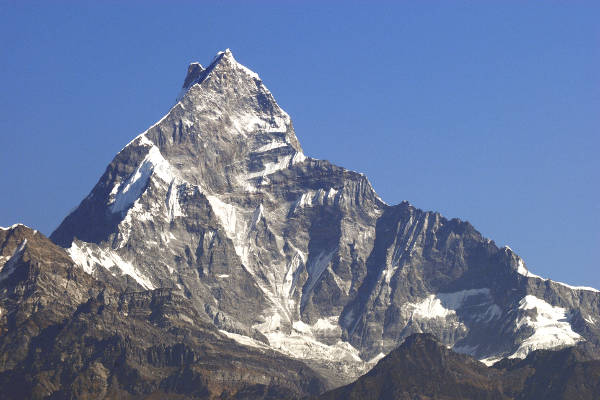
The Annapurna Circuit is one of the most popular and most epic treks in Nepal . This classic trek meanders through Himalayan foothills and over high passes, offering picturesque mountain views along the way.
Annapurna Circuit Trek
Route overview.
The Annapurna Circuit is one of the greatest treks in Nepal, if not the world.
Although road construction over the past two decades has severely impacted the trekking experience (more on this later).
Note: if you are a mountain biker, the road on the western side makes for one of the most exhilarating and scenic mountain biking experiences!
Where Does The Annapurna Circuit Start and End?
The trek begins at Besisahar (which is a 7-8 hour drive from Kathmandu) and concludes in the Kali Gandaki Gorge – the disputed highest gorge in the world that separates Dhaulagiri (8,176 meters) in the West and Annapurna (8,091 meters) in the East.
The circuit is traditionally followed on an anti-clockwise trail – for acclimatization reasons – that circumvents the Annapurna Massif. It takes trekkers through the Annapurna, Manang and Mustang region of central Nepal.
Route Details
At its pinnacle, the trek crosses the Thorung La Pass (5,416 meters) before descending down to the town of Muktinath. From here the road construction activities (2004 -2008/09) have had a measurable impact on the Annapurna Circuit trekking experience.
The Nepalese government have realized that the road on both the Western (Pokhara-Muktinath) and Eastern (Chame-Manang) side of the circuit has had a negative impact on trekking tourism. Thus, they have created a number of New Annapurna Trekking Trails (called NATT-trails).
These NATT-trails, marked blue and white or red and white, take trekkers away from the dusty and unpleasant roads. The alternative routes provide a much more pleasant trekking experience.
How Long Is The Annapurna Circuit?
The Annapurna circuit typically takes between 16-20 days to complete. This is depending if you decide to tack on a diversion to Annapurna Base Camp and the Annapurna Sanctuary ). It covers between 150-240 km depending on when you decide to end the tour or use transportation vehicles.
Scenery and Landscape
The scenery on the Annapurna Circuit is extraordinarily beautiful. Trekkers pass through rice terraced paddy fields, subtropical forests, and glacial environments.
You will see a number of major mountains including the Annapurna Massif (I-IV), three 8,000 metre peaks – Dhaulagiri (8,176 meters), Manaslu (8,156 meters) and Annapurna I (8,091 meters). There are numerous other peaks of 6,000 to 7,000 meters.
Please Note: The Annapurna Circuit is situated in the Annapurna and Mustang regions of central Nepal. It is home to the Annapurna Massif. The schematic below illustrates Nepal’s trekking regions (not to scale).
Annapurna Regional Map
The Annapurna Circuit is situated in the Annapurna and Mustang regions of central Nepal. It is home to the Annapurna Massif. The schematic illustrates Nepal’s trekking regions (not to scale)
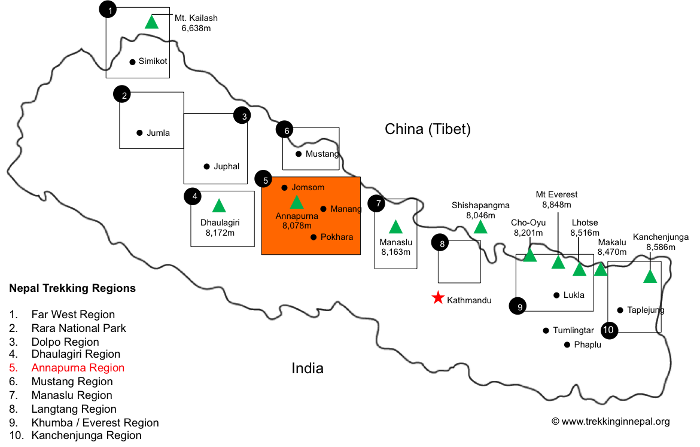
Annapurna Trek Altitude Profile
The schematic diagram below shows the route altitude profile for the Annapurna Circuit.

Annapurna Circuit Itinerary
Below is a detailed Annapurna Circuit itinerary. Where possible we have highlighted the NATT-Trails that can be used to avoid the road. Please note that this is a typical Annapurna Circuit itinerary. Some tour operators offer variations on this route.
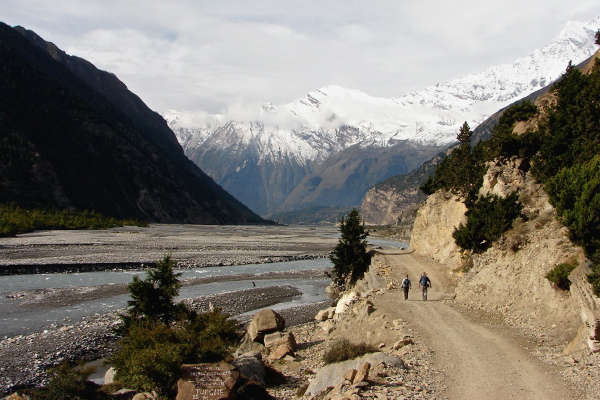
Day 1-2: Arrive Kathmandu (Drive to Besisahar / Fly to Pokhara)
Arrive in Kathmandu, usually spend a day sightseeing in the capital city.
See more in our guide on what to do in Kathmandu .
Drive from Kathmandu (1,300 meters) to Besisahar / Khudi (circa 800 meters) via bus. The trip takes between 7 and 8 hours, meandering through countryside villages.
The Annapurna Circuit typically starts at Besisahar, an hour’s trek from Khudi. Some operators may drive you to Khudi and commence the trek from there.
Day 3: Trek from Besisahar (820 meters) to Khudi and onto Bahundanda (1,310 meters)
Trek from Besisahar (820 meters) to Khudi and onto Bahundanda (1,310 meters). This traditional route has been impacted by the road construction so some operators have started using new trails that bypass the road. Instead, you go to the village of Sikrung (2,200 meters).
The latter is a fairly steep climb to a rather high altitude. But it does offer a more untainted Annapurna trekking experience. Expect to trek between 6-7 hours.
Day 4: Trek from Bahundanda (1,310 meters) / or Sirung (2,200 meters) to Jagat (1,300 meters) or potentially Chamje (1,410 meters)
Trek from Bahundanda (1,310 meters) / or Sirung (2,200 meters) to Jagat (1,300 meters) or potentially Chamje (1,410 meters). If on day 4 you followed the traditional route to Bahundanda, you will trek to Ghermu (1,130 meters) and onto Jagat. You might stay the night here or take a steep hour-long trek up to Chamje (1,410 meters).
We recommend staying the night at Chamje instead of Jagat, which is a dirty and crowded village. If on day 4 you stopped at Sikrung, you will likely follow a route via Syange (1,100 meters) to Jagat and up to Chamje.
Expect to see great rice terraced landscapes and views of the Manaslu Range during early stages of this day’s trekking.
Day 5: Trek from Jagat / Chamje (1,300 / 1,410 meters) to Dharapani (1,960 meters)
Trek from Jagat / Chamje (1,300 / 1,410 meters) to Dharapani (1,960 meters). Continuing north into the Manang region, you will trek through agricultural fields of corn and potatoes and then forests of rhododendrons.
Eventually reach the quaint village of Tal (1,700 meters). From Tal you will trek for another 6 kms (circa 3 hours) via Karte to the village of Dharapani (1,960 meters).
Day 6: Trek from Dharapani (1,960 meters) to Chame (2,710 meters) via Bagarchap and Danakyu, and then either along the lower trail or upper trail to Koto (2,640 meters)
Trek from Dharapani (1,960 meters) to Chame (2,710 meters) via Bagarchap and Danakyu, and then either along the lower trail or upper trail to Koto (2,640 meters).
From Koto you trek a further hour to the busy village of Chame. Some trekkers and operators prefer an overnight stay in the quieter village of Koto. On this rather steep trekking day you will get some great views of Annapurna II and IV, as well as Lamjung Himal.
Day 7: Trek from Chame (2,710 meters) to Pisang via Bhratang (2,850 meters) and Dhukur Pokhari (3,240 meters)
Trek from Chame (2,710 meters) to Pisang via Bhratang (2,850 meters) and Dhukur Pokhari (3,240 meters). From Dhukur Pokhari the trail splits and you may either trek to Upper Pisang (3,310 meters) or to Lower Pisang (3,250 meters) for an overnight stay.
If you take the latter to Lower Pisang we highly recommend re-joining the upper trail on day 8. This provides arguably the best views of the whole Annapurna Circuit.
Day 8: Trek using the upper trail from Pisang (3,310 meters) to Manang (3,450 meters) via Ghyaru (3,730 meters), Ngawal (3,680 meters), Humde (3,330 meters and Bhraga (3,450 meters)
Trek using the upper trail from Pisang (3,310 meters) to Manang (3,450 meters) via Ghyaru (3,730 meters), Ngawal (3,680 meters), Humde (3,330 meters and Bhraga (3,450 meters).
The mountain views on this portion of the Circuit are exceptional, as are the quaint villages along the trail. A visit to Barge monastery is worthwhile before the final stretch to Manang.
Day 9: Acclimatization day in Manang
Manang is one of the main towns on the Circuit. Many trekkers take this opportunity to spend a rest acclimatization day in the town.
Short excursions to the Gangapurna Lake and Bhojo Gompa (a Buddhist ecclesiastical fortification of learning) are common among trekkers. There are also day trips around the town. You might want to consider visiting the offices of the Himalayan Rescue Association for a talk on high altitude risks.
Day 10: Trek from Manang northwest out of the Marshyangdi Valley and up to the small village of Yak Kharka (4,110 meters)
Trek from Manang northwest out of the Marshyangdi Valley and up to the small village of Yak Kharka (4,110 meters). If you haven’t started feeling the effects of altitude yet, you might start doing so from today. Some trekkers continue onto the tiny village of Letdar (4,200 meters). Teahouse accommodation is limited in both these villages.
Day 11: Trek from Yak Kharka (4,110 meters) to High Camp (4,850 meters)
Trek from Yak Kharka (4,110 meters) to High Camp (4,850 meters). This is a fairly tough and steep day. Some tour operators will stop for the night at Thorang Phendi (4,450 meters). This is a good idea if trekkers are struggling with the altitude.
However, continuing on to High Camp is, in our opinion, preferable. This is because it makes the next day’s treks to Muktinath (3,800 meters) a lot shorter and easier. Accommodation facilities and amenities in Thorang Phendi and High Camp are both good. Please note: continuing onto High Camp means sleeping at high altitude, which is not advised if you are suffering from acute mountain sickness (AMS) symptoms .
Day 12: Trek from High Camp (4,850 meters) across the Thorung Pass (the highest point on the trek at 5,416 meters) and then back down to Muktinath (3,800 meters) via Charabu (4,230 meters)
Trek from High Camp (4,850 meters) across the Thorung Pass (the highest point on the trek at 5,416 meters). You then go back down to Muktinath (3,800 meters) via Charabu (4,230 meters). Prepare for a tough, icy-cold day of trekking. The descent from Thorung Pass is steep and trekking poles come in handy. Muktinath, although an important pilgrimage site for both Hindu’s (see the Vishnu Temple) and Buddhists (see the Monastery), is a rather characterless village. Depending on your operator, you will likely stay overnight in Muktinath. For independent trekkers, the Bob Marley Guesthouse in the center of town is a great shout!
Day 13: Trek from Muktinath (3,800 meters) to Marpha (2,665 meters) via the awesome village of Kagbeni (2,800 meters)
Trek from Muktinath (3,800 meters) to Marpha (2,665 meters) via the awesome village of Kagbeni (2,800 meters). From Kagbeni to Jomsom we recommend taking a jeep to avoid the unpleasant dusty roads.
Once you get to Jomsom you can join the ne NATT-trail (which is 2 hours longer than the road option) to Marpha. Marpha is famous for being the centre of the apple region in Nepal. Do try the apple brandy if you get a chance.
Day 14: Trek from Marpha (2,665 meters) to Kalopani (2,530 meters), via Chokhopani, and continue to Kokhethanti to avoid the road
Trek from Marpha (2,665 meters) to Kalopani (2,530 meters), via Chokhopani, and continue to Kokhethanti to avoid the road. Some trekkers grab a jeep from Marpha all the way to Tatapani (see day 15).
Day 15: Trek from Kolapani (2,530 meters) to Tatapani (1,200 meters)
Trek from Kolapani (2,530 meters) to Tatapani (1,200 meters). Using a new NATT-trail (marked in red and white), you can avoid the road and follow a trail that climbs steeply before joining a path that will take you through the towns of Kopochepani, Rupsechhahara, Dana and finally Tatapani.
Day 16: Trek up from Tatapani (1,200 meters) to Ghorepani (2,870 meters)
Trek up from Tatapani (1,200 meters) to Ghorepani (2,870 meters), via the towns of Ghara, Sikha and Chitre. You will most likely stay overnight in Ghorepani in preparation for an early start the next day.
Day 17: Trek from Ghorepani (2,870 meters) up Poon Hill (3,870 meters) and back down to Tadapani (2,710 meters)
Trek from Ghorepani (2,870 meters) up Poon Hill (3,870 meters) and back down to Tadapani (2,710 meters). You will start this days trekking early so as to get up Poon Hill for the impressive sunrise. First light illuminates surrounding rice terraces and Annapurna and Dhaulagiri massifs. The classic Annapurna Circuit trek then descends to Tadapani for an overnight stay.
Note: we have heard that instead of heading up Poon Hill, the hill opposite in the direction of Chomrong provides an equally impressive (if not better view) without any crowding issues.
Day 18: Trek from Tadapani (2,710 meters) to Naya Pul (1,070 meters) via Gandruk and then catch a short bus ride back to Pokhara
Trek from Tadapani (2,710 meters) to Naya Pul (1,070 meters) via Gandruk and then catch a short bus ride back to Pokhara. This is the end of the Annapurna Circuit and an extraordinary 18 days!
Note: It is possible to follow the old Annapurna Circuit from Ghorepani to Phedi via Landruk, although this takes an extra 2 days compared to the direct exit from Ghorepani to Naya Pul.
Please Note: From Muktinath onwards the classic Annapurna Circuit has been severely impacted by the road that joins Jomsom to Muktinath. If you choose to trek this route be prepared for an unpleasant and dusty experience, as jeeps wiz by you. Thankfully there are alternative options via the New Annapurna Trekking Trails (NATT-trails).
Suggested route options from Muktinath
If you are not on a set tour we suggest the following route:
- Trek to the charmingly wonderful town of Kagbeni (2,800 meters) for an overnight stay. We recommend taking the high trail out of Muktinath via Jhong, as this offers better mountain views
- From Kagbeni to Jomsom take a jeep as dust driven from the common winds in this region and the constant flow of vehicles on the road make for unpleasant trekking
- From Jomsom take the new NATT-trail (marked in red and white) to Marpha (2,665 meters) where you can stay overnight and then continue following the route set out from Day 13 below
Also Note: As the road starts in Muktinath, you can cheat and catch a truck all the way to Jomsom. Continue your trek or catch a flight to Kathmandu if you need to shorten your trek (we highly recommend not skipping Kagbeni though). You can also get a bus from Muktinath all the way back to Pokhara if you have run out of time. If you are a mountain biking fanatic you can rent a mountain bike to take one of the most amazing rides down and out of Muktinath – this area of Nepal is fast becoming mountain biking Mecca
Annapurna Route Variations
There are a number of route variations on the Annapurna Circuit. Here are three worth mentioning.
If you don’t have much time in the Annapurna Circuit you may want to consider the Poon Hill Trek , The Royal Trek or the Ghorepani Poon Hill Trek (also called the small Annapurna Circuit). Nepal is heaven for trekkers and has some of the best thru-hikes in the world .
- Annapurna base Camp Trek
- Naar-Pho Valley
- Tilicho Lake
It is possible to include a five day diversion to Annapurna Base Camp onto the Annapurna Circuit trek. This involves continuing north from Tadapani so as to join the old Annapurna Circuit at Landruk.
Read more about the Annapurna Base Camp Trek
A variation to the Annapurna Circuit that has been growing in popularity since opening to foreigners in 2002 is the Naar-Pho Valley.
The route begins near Koto (on day 5/6 of the classic Annapurna Circuit) and follows a trail via two distinctly Tibetan villages – Phugaon and Naar – which are both located at over 4,000 meters. After nine days trekking the route exits via the Kang La Pass (5,300 meters) to Ngawal, where you re-join the Annapurna Circuit on your way to Manang. The detour via the Naar-Pho Valley in effect adds seven days to the traditional Annapurna Circuit as you would have spent two days trekking from Koto to Ngawal and on to Manang had you stayed on the main track.
A special permit, which can only be organised through a trekking agency, is required to enter the Naar-Pho Valley. You will also need to take a guide as tourist infrastructure is poor. Most trekkers opt for the traditional camping style of trekking with porters, tents and cooks.
A 3-4 day trek to Tilicho Lake (4,920 meters), one of the highest lakes in the world, has become a relatively popular diversion on the Annapurna Circuit.
The trek starts in Manang, and follows a path on the northern side of the valley to Khangsar (note: there are maps that show a path on the southern side of the valley but we recommend avoiding this as it is in poor condition and prone to landslides).
From Khangsar there are two paths that leave the town – the lower and upper path. Take the upper path, as it is safer, until you reach Shree Kharka where you can overnight at one of the two teahouses there.
From Shree Kharka walk about 45 miuntes until you reach point where the path splits into a lower and upper trail. Make sure to take the lower trail (the upper trail is marked ‘Danger’). A further 3 hours trekking and you will arrive at Tilicho Base Camp where you can stay overnight at one of the teahouses.
Depart Tilicho Base Camp early the next morning to avoid the high winds and clouds that roll in by mid-morning. The trek up to the lake is steep and tough. It takes about 3 hours and can be very cold due to the altitude, so dress warmly. The descent follows the same path back to Base Camp (approx. an hour) or to Shree Kharka (4 hours from the lake). Overnight at Shree Kharka.
The next day take a trail (which is signposted) directly to Yak Kharka via Old Khangasar, where you re-join the Annapurna Circuit.
Recommended Guidebook

Need an up-to-date guide book with maps that include the NATT-Trails? We recommend either Andrées de Ruiter and Prem Rai’s guide, Trekking the Annapurna Circuit , or Sian Pritchard-Jones and Bob Gibbons guide, Annapurna: A Trekker’s Guide .
Annapurna Circuit FAQ
How much does it cost to hike the annapurna circuit.
The cost of an Annapurna Circuit varies depending on which route variation you take. It also depends when you trek (out of season tends to be a little cheaper) and whether to trek with a local or western trekking agency, or indeed independently.
We have provided a detailed Annapurna Circuit Cost article here but in summary you should budget for the following key expenses:
Visa, Vaccinations, Insurance etc: ~$300-$500
Equipment (buying and hiring): ~$500-$800
Flights to Kathmandu: ~$1,000
Tour Agency: ~$1000 for a cheap local agency to ~$3,000 for a pricey Western trekking agency. You could do an independent trek for ~$700 employing a local guide
check out our list of Nepal trekking companies recommendations .
Tips: ~$200-$300
Misc (additional food, unplanned travel / hotels ect): $200
Total Costs: $2,500 – $5,000
Do I need a permit for the Annapurna Circuit?
Yes. An Annapurna Conservation Area Project permit and Trekker Information Management System registration are required for the Annapurna Circuit trek.
If you are joining an organised tour, these will be arranged for you. If you are looking to go it alone you will have to bring four passport-sized photographs and go to the offices of the Nepal Tourism Board in Kathmandu to apply. We recommend bringing copies of your passport and insurance policy. The offices follow government working hours and days, and are not open on Sunday.
When is the best time to hike the Annapurna Circuit?
The best time to trek the Annapurna Circuit is either in the Spring (March to Mid May) or in the Autumn (mid / late September to December). Unfortunately these also happen to be the busiest times of the year as they are the best time for Nepal trekking ..
Towards December the weather starts getting particularly cold and the routes get distinctly quieter. If you are a hardened trekker a winter Annapurna Circuit (late December through February) can provide a very authentic Nepal trekking experience.
The main challenge of a winter trek, apart from the cold, is the snow and ice that often obstructs the higher trails and the Thorung Pass. During bad winter seasons these trails may be closed.
Unlike the Everest region that gets very wet during the rainy monsoon season, the Annapurna and Mustang regions stay relatively dry, making June through September, a relatively good time to trek as well.
Here’s a detailed article on weather on the Annapurna Circuit .
Is altitude sickness a risk on the Annapurna Circuit?
Yes, some trekkers do suffer from altitude sickness on the Annapurna Circuit as it is a high altitude trek. At its highest point, Thorung Pass, you will reach an altitude of 5,416 meters (17,769 feet).
Fortunately because of the circuits length the opportunities for appropriate acclimatisation are good. Hence, the prevalence of moderate or sever altitude sickness is low.
Nonetheless, it is important to have a detailed understanding of the risks associated with high altitude trekking and how the body acclimatises.
We recommend you read our detailed article on Altitude Sickness and Acclimatisation .
How difficult is the Annapurna Circuit hike?
The Annapurna Circuit trek is challenging. You will be trekking for 4-7 hours a day for over two weeks, so you will need to be peak physical condition. The best way to prepare is to get as many kilometres under foot on hikes in your home country.
What do I need to pack for the Annapurna Circuit trek?
Trekking in the Annapurna region requires a number of essential pieces of trekking clothing and equipment. AC is a long and tough trek. You will be exposed you to a range of altitudes where temperatures fluctuate dramatically between night and day.
Many pieces of equipment can be rented or bought in Kathmandu or Pokhara. Even so, we recommend bringing the most important pieces of gear with you.
We've written a detailed Annapurna hiking packing list .
Insurance Information
Trekking insurance is a must in Nepal. This is particularly the case in the Annapurna Region, which at stages is very remote. If an accident should occur that requires medical assistance and evacuation you will definitely want trekking insurance that can cover the costs of air ambulance and treatment.
Moreover, it is prudent to have insurance that covers you for any travel related risks. insurance should cover stolen, damaged or delayed baggage; flight delays and interruptions; and tour operators default.
This article on travel and trekking insurance in Nepal provides detailed information on what type of insurance you need.
About the author
Mark Whitman
Mark has trekked extensively in Asia, Europe, South America and Africa. He founded Mountain IQ in 2014 with the sole aim to be the best online information portal to some of the most popular mountain destinations around the world. When not writing for Mountain IQ, Mark is out exploring the outdoors with his wife!
Leave a Reply
Your email address will not be published. Required fields are marked
Thanks for the useful information. Really helpful!
Hi Mark, this is a really nice blog with very comprehensive information!!
I'd like to do the trekking on my own, as an independent trekker, but I've heard that there are some new regulations comming for this year (2023) and that a local guide or agency is mandatory to do the central part of the annapurna circuit. Also, that the TIMS can not be got by independent trekkers but only if you hire an agency. Would you have any up to day news about it?
Hi Daniel, thanks for checking in. I’m not aware of the new regulations, but it is definitely possible. Nepal authorities have been talking about this for years. Here’s the latest from the Guardian: https://www.theguardian.com/travel/2023/mar/30/nepal-imposes-ban-on-mountain-trekking-without-a-guide
We work with local guides to offer great value adventures at unbeatable prices
Himalayan Odyssey Nepal Trek
Best Himalayan Trekking Agency | 2024
Registration No: [74407/067/068]
Write a review on [Tripadvisor]
+977-(986)096-4103
[Available On: WhatsApp & Viber] Please feel free to contact us 24/7 !
Welcome Traveler's
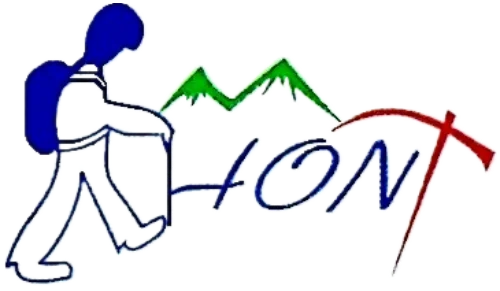
Annapurna Circuit Trek
Annapurna circuit trek | 2024.
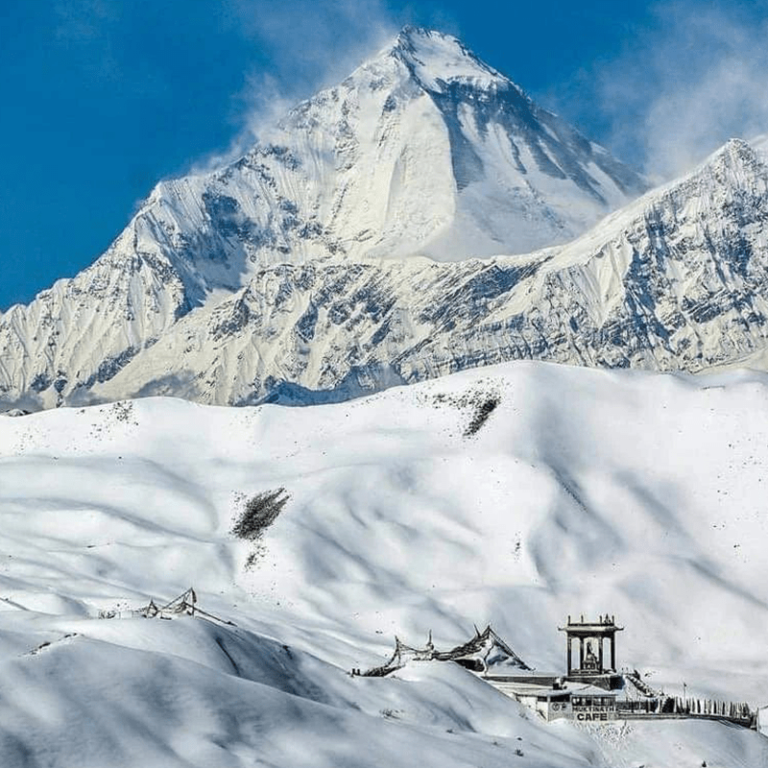
Trip Duration: 12 Days
Best time: feb-jun, sep-dec, altitude: 5,416 m, grade: challenging, group size: min. 2 pax, trek type: tea house, walking: approx. 4-6 hrs, overview of the annapurna circuit trek.
The Annapurna Circuit Trek is undoubtedly one of the most extraordinary and unparalleled experiences a trekker can avail themselves of. With an extensive length of 160–230 km that covers four distinct districts, comprising Lamjung, Myagdi, Manang, and Mustang, this trekking route stands out as the most preferred circuit through the diverse natural vegetation, cultural beliefs, landscape, altitude, trail, pristine little settlements, culturally affluent tribal groups, and religious sects.
The trek begins in Jagat. As we gain altitude, the landscape and vegetation change, and rugged alpine terrain appears. The challenge of the trek is to cross the highest pass, Thorong La (5,416 m). The splendid snow-capped Himalayan views from the peak of the Thorong La Pass are just amazing and beyond expectation. Then we follow the trail to Muktinath temple, the temple of God Vishnu, the god of preservation. And the windy Jomsom, and just ahead we pass through the deepest gorge along the Kaligandaki River between Mt. Annapurna and Dhaulagiri. We then trek to the famous Gurung village, Ghorepani, and the famous Poon Hill viewpoint.
Highlights of the Annapurna Circuit Trek
- One of the most classic and oldest treks in Nepal,
- Thorang La Pass is the highest navigable pass (5,416 m) in the world,
- Descend into one of the deepest gorges in the world, the Kali Gandaki,
- Poon Hill is a hill station,
- Traditional Gurung, Tibetan, and other ethnic villages,
- Muktinath is a holy temple of God Vishnu,
- The natural hot spring of Tatopani.
Outline Itinerary of the Annapurna Circuit Trek
KTM ) Arrival in Kathmandu city, transfer to the hotel
Day 01 ) Drive to Jagat (1,300 m) (8/9 hours)
Day 02 ) Trek to Dharapani (1,860 m) (5/6 hours)
Day 03 ) Trek to Chame (2,620 m) (6/7 hours)
Day 04 ) Trek to Pisang (3,200 m) (6/7 hours)
Day 05 ) Trek to Manang (3,540 m) (5/6 hours)
Day 06 ) Acclimatization Day
Day 07 ) Trek to Yak Kharka (4,018 m) (6/7 hours)
Day 08 ) Trek to Thorong Phedi (4,560 m) (5/6 hours)
Day 09 ) Trek to Muktinath (3,767 m) via Thorang-La Pass (5,416 m) (7/8 hours)
Day 10 ) Drive to Jomsom and Tatopani (1,190 m) (6/7 hours)
Day 11 ) Trek to Ghorepani (2,874 m) (6/7 hours)
Day 12 ) Early morning hike to Poon Hill, trek to Ulleri (2 hours) and drive to Pokhara (3 hours)
Not satisfied with this itinerary?
Annapurna Circuit Trek: Detailed Itinerary
Ktm) arrival in kathmandu city, transfer to your hotel.
- Meals: Breakfast
- Accommodation: Hotel
- Altitude: 1,400 m, Kathmandu
At Kathmandu Tribhuvan International Airport, you will be received by a Himalayan Odyssey Nepal Trek guide/staff and transferred to your hotel. Stay overnight at the hotel.
Day 01) Drive to Jagat from Kathmandu via Besisahar (1,300 m) (8/9 hours)
- Meals: Breakfast, Lunch, Dinner
- Accommodation: Lodge
- Altitude: 1,300 m, Jagat
We take a drive from Kathmandu to Besisahar by tourist bus. We have breakfast and lunch on the way. The route takes us out of the Kathmandu valley along the picturesque Trishuli River to Besisahar. As we reach Besisahar, we drive towards Jagat by Jeep, following the Marshyangdi River. We will pass several beautiful villages, green paddy fields, and forests until we reach Jagat. Stay overnight at the lodge.
Day 02) Trek to Dharapani (1,860 m) (5/6 hours)
- Altitude: 1,860 m, Dharapani
We are walking on a rocky path next to the Marsyangdi River. We see beautiful waterfalls, green plants, and animals. The path goes up to a village called Tal. We keep going up the valley, using stone stairs, until we get to Dharapani. Stay overnight at the lodge.
Day 03) Trek to Chame (2,620 m) (6/7 hours)
- Altitude: 2,620 m, Chame
The path goes up along a river called Marsyangdi, going through trees like pine and fir. We’ll get to see great views of the mountains Annapurna II (7,937 m), Mt. Manaslu (8,156 m), and other peaks before reaching Chame. Stay overnight at the lodge.
Day 04) Trek to Pisang (3,200 m) (6/7 hours)
- Altitude: 3,200 m, Pisang
After breakfast, we will follow the Marsyangdi Trail to Bharatang. We will see Annapurna II (7,937m) up close from there. Next, we will climb a steep hill where we will see many oak, fir, pine, hemlock, and maple trees. We will have a great view of the Pangida Danda. Then, we will cross a suspension bridge, go up for a while, and then down to the valley floor. We’ll see dry, grazing land and reach Dhukure Pokhari. After walking for about half an hour, we will reach Pisang. Stay overnight at the lodge.
Day 05) Trek to Manang (3,540 m) (5/6 hours)
- Altitude: 3,540 m, Manang
We will start our day by walking on a dry trail where there is little rainfall and many beautiful landscapes. Two paths will take us to Mungi. We can take either of those two. The path that goes through Ghyaru, or Hongde, Ghyaru village on the harder path is especially attractive because of its lovely stone houses surrounded by fields of wheat, barley, buckwheat, potatoes, and beans. We will continue our journey to Ngawal, a village that has an old building called a gompa and ancient juniper trees. Next, we will follow a trail that will take us down to Mungji, where we will meet the other path. From there, we will go to the famous village called Manang. Enjoy looking at the beautiful Annapurna mountain range. Stay overnight at the lodge.
Day 06) Acclimatization Day
Today is the acclimatization day for our body to cope with gaining altitude and avoid any kind of high-altitude sickness. We will take a higher-elevation hike either to the ridge near the Gangapurna glacier or walk up to the cave above Manag village. We will visit the village and native people and gain insight into their lifestyle and culture during our acclimatization day. Stay overnight at the lodge.
Day 07) Trek to Yak Kharka (4,018 m) (6/7 hours)
- Altitude: 4,018m, Yak Kharka
The day starts with an ascent to Tengki, which is the last permanent settlement below the pass. We will walk upward until we reach Gunsang. The trail then turns northwest towards Jharsang Khola Valley. We walk on scrub juniper and alpine grass, which brings us to Yak Kharka. Stay overnight at the lodge.
Day 08) Trek to Thorong Phedi (4,560 m) (5/6 hours)
- Altitude: 4,560 m, Thorong Phedi
After having breakfast, we move towards the Thorong Phedi. We walk for about an hour and reach Churi Leder. We then descend to the river and cross it over the wooden bridge. The trail then becomes challenging as you climb upstream of Jharsang Khola on the ridge of the cliff and finally reach Thorong Phedi. Stay overnight at the lodge.
Day 09) Trek to Muktinath (3,767 m) via Thorang-La Pass (5,416 m) (7/8 hours)
- Altitude: 3,767 m, Muktinath
Today, we will walk through the highest point of the entire Annapurna Circuit. We will head towards the Thorong-La Pass (5,416 m) early in the morning and begin the ascent. The trail is steep and narrow, but if we walk uphill for about 4/5 hours, we’ll get to the top, which is 5,416 m. From there, we can see beautiful mountain ranges like the Annapurna range and the Dhaulagiri range. There are also some chortens and colorful flags that celebrate our hiking success. After taking some photos and enjoying the scenery, we will walk downhill over a rocky area and then through some green fields until we reach a place called Muktinath. Stay overnight at the lodge.
Day 10) Drive to Jomsom and Tatopani (1,190 m) (6/7 hours)
- Altitude: 1,190 m, Tatopani
In the morning, we’ll go to Muktinath Temple and then take a local bus to Tatopani. The ride might be bumpy because the road goes through deep gorges. We’ll go from dry land to green forests. Tatopani is well-known for its hot springs. The hot spring water is believed to be helpful for skin problems. Stay overnight at the lodge.
Day 11) Trek to Ghorepani (2,874 m) (6/7 hours)
- Altitude: 2,874 m, Ghorepani
Today is a long day of walking to Ghorepani. After continuously descending for some days, you will climb today. The trail first crosses the bridge over the Kaligandaki River, which leads us to the junction where we can follow the trail either to Beni or Ghorepani. We will follow the trail, as our destination is Ghorepani. Ghorepani, being a popular destination for both national and international tourists, offers spectacular views of Dhaulagiri and Manaslu Himalayas and the opportunity to hike the most famous viewpoint of the entire Annapurna Region, Poon Hill. Stay overnight at the lodge.
Day 12) Early morning hike to Poon Hill, trek to Ulleri (2 hours) and drive to Pokhara (3 hours)
- Meals: Breakfast, Lunch
- Altitude: 822 m, Pokhara
Today is the last day of the trek. We will hike to Poon Hill early in the morning to have magnificent 360-degree panoramic views of the Annapurna and Dhaulagiri ranges with a splendid sunrise view. After spending some time on the hilltop, enjoying the fabulous moments, and keeping a lifetime memory, we will retrace our steps back to the lodge at Ghorepani. After having breakfast, we will head towards Nayapul, which brings the end of the Annapurna Circuit Trek. We will take a vehicle service from here to reach Pokhara, where you can hang around the lakeside area to enjoy your evening. Stay overnight at the hotel.
- Airport pickup and drop-off for arrival and departure
- A total of two nights’ accommodation in Kathmandu (Bed and breakfast) after the arrival and after the trek
- Annapurna Conservation Area Permit (ACAP) fee
- Trekkers Information Management System (TIMS) card fee
- All government, local taxes, and official expenses
- A government-licensed, experienced trek leader (guide), an assistant trekking guide for 8 or more trekkers, and porters to help trekkers with luggage ( *1 porter for two trekkers; the maximum luggage limit per trekker is 14 kg. )
- Guides and porters costs, which include meals, insurance, salary, lodging, transportation, and other necessary equipment
- One-night accommodation in Pokhara (Bed and breakfast) after the trek
- Kathmandu to Besisahar by tourist bus or microbus
- Private transportation: (From Besisahar – starting point of the trek) (From the ending point of the trek – Pokhara)
- All accommodations during the trek
- Three meals a day (Breakfast, Lunch, and Dinner) during the trek
- Arranging rescue operations in cases of complicated health conditions (funded by travel insurance)
- International flight airfare
- On Arrival Visa Fee at Entry Points: (15 days: USD 30, 30 days: USD 50, and 90 days: 125 USD)
- Extra nights’ accommodation and meals in Kathmandu and Pokhara due to early arrival, late departure, or an early return from the trek
- Lunch and dinner in Pokhara
- Personal expenses (shopping, snacks, bottled water or boiled water, hot (tea, coffee) and cold drinks, hot shower, alcohol, Wi-Fi, telephone call, battery recharge fee, extra porters, etc.)
- Personal clothing and gear
- Tips for guides and porters
- Additional costs due to delays caused by circumstances outside company control like landslides, weather conditions, itinerary modifications due to safety concerns, illness, changes in government policies, strikes, etc.
Client Inquiry Form
[natural habitats of the annapurna region].
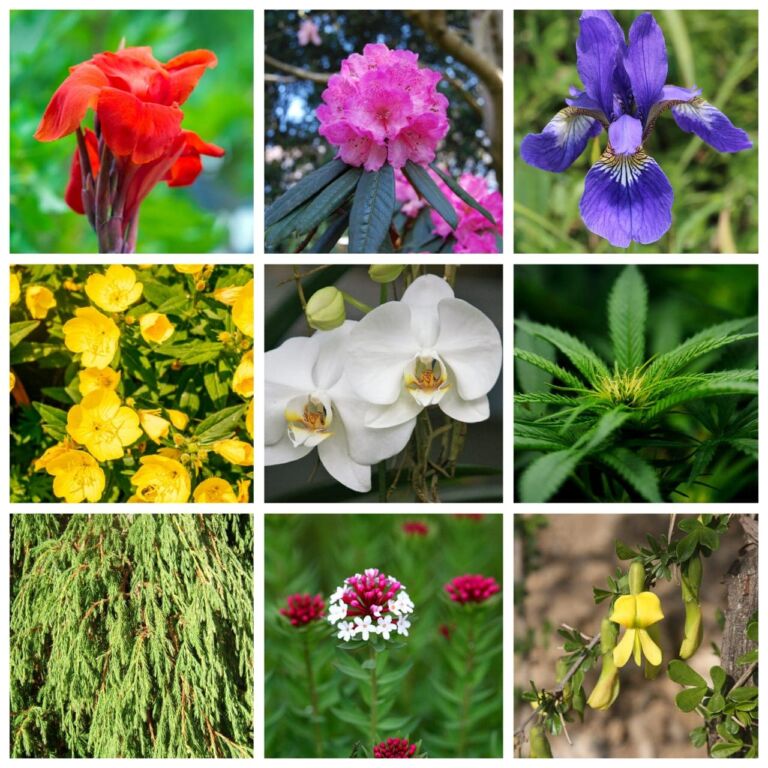
Flora found in the Annapurna region
Row 01: Canna lily, Rhododendron, Iris Row 02: Yellow primrose, White orchid, Marijuana Row 03: Juniper bush, Stellara, Caragana brevispina

Fauna found in the Annapurna region
Row 01: Bharal (Blue sheep), Snow leopard, Himalayan wolf Row 02: Gray langur, Leopard, Jungle cat Row 03: Red fox, Himalayan marmot, Red giant flying squirrel
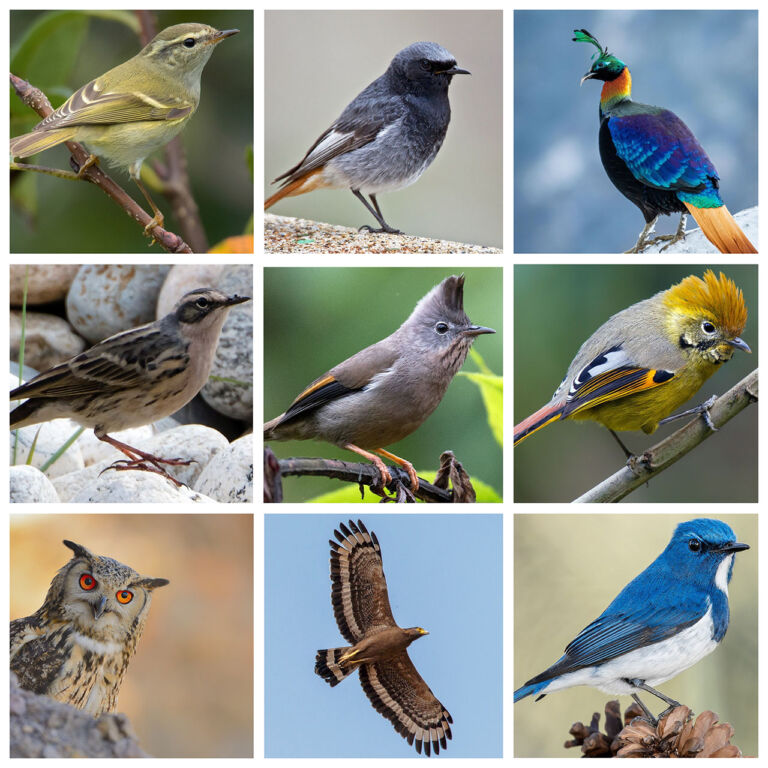
Birds found in the Annapurna region
Row 01: Hume's leaf warbler, Black redstart, Impeyan pheasant Row 02: Rosy pipit, Stripe-throated yuhina, Chestnut-tailed minla Row 03: Rock eagle owl, Crested serpent eagle, Ultramarine flycatcher
Travel Information
- All trekkers must provide a copy of their comprehensive travel insurance policy certificate to the Himalayan Odyssey Nepal Trek before starting the trek. [The policy must cover medical and emergency repatriation, including helicopter rescue and evacuation expenses at high altitudes.] Trekking permit requirements
- Two permits are required for the Annapurna Circuit Trek : 1) a TIMS (Trekkers Information Management System) card 2) an entry permit for the Annapurna Conservation Area Project permit
The difficulty of the Annapurna Circuit Trek is challenging (grade IV). While you’ll start the Thorong La Pass Trek at around 1,000 m above sea level, you’ll reach as high as 5,416 m at Thorong La Pass. That’s pretty high. There is a chance of getting altitude sickness. You should be physically and mentally ready for the trek.
Yes, drinking water is easily available during the trek. You can buy a water bottle that is 100% safe to drink. You should carry a water bottle so you can refill the water that is available in every lodge. Also, it will be better to bring purifying tablets for safe drinking during the trek.
Coughs and headaches are normal in the mountains. However, if you suffer from a high-syndrome illness, you have to make your way backward.
Yes, cellular networks can be found on the trekking trails of the Annapurna Circuit Trek. However, in some places, there might not be reception available.
The standard length of the Annapurna Circuit Trek is about 160–260 kilometers. It could take 10 to 21 days to complete the circuit, but the distance can differ depending on your itinerary or where you start and end the trek.
Ask a question ...
Trekking map of annapurna circuit trek: 12-day itinerary.

Nar Phu Valley Trek
Duration: 9 Days

Tilicho Lake Trek
Duration: 11 Days
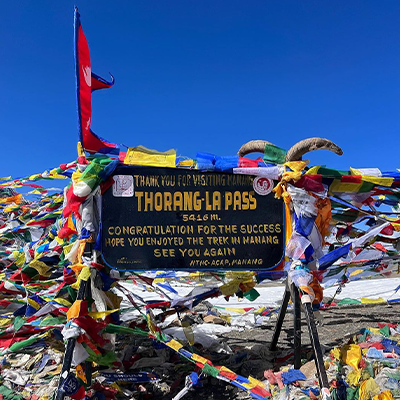
Thorong-La Pass Trek
Duration: 12 Days
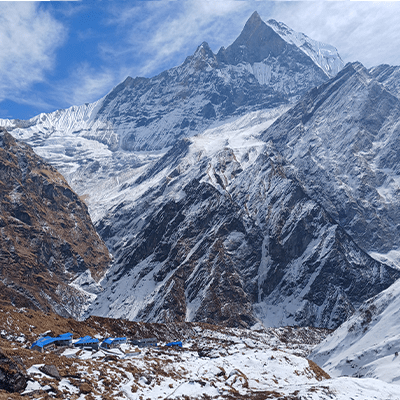
Annapurna Base Camp Trek
Duration: 7 Days
- Annapurna Circuit Trekking: The Ultimate Guide
Annapurna Circuit Trek
- 13/04/2023 15/01/2024
Suppose you’re looking for a trekking adventure that will take you through stunning landscapes and diverse cultures. In that case, the Annapurna Circuit Trek is a must-do. This guide to Annapurna Circuit Trekking will provide all the information you need to plan and prepare for your journey, including insider tips and tricks to make your experience unforgettable. So get ready to embark on the adventure of a lifetime!
The Annapurna Circuit Trek is one of Nepal’s most well-known treks. It passes through incredibly diverse landscapes, from lush green valleys to the Thorong Pass, with the majestic Annapurna massif as an utmost adventure.
It is also an excellent alternative for experienced trekkers who want to deal with an epic Nepal trek on a budget because permit costs are minimal and guides are mandatory.
The Annapurna Circuit is rich with breathtaking scenery, yet it is not without flaws. In recent years, extensive road construction has significantly changed the nature of the trip.
In this guide to Annapurna Circuit , we will cover all you need to know to plan the perfect trek, including a suggested itinerary, practical information, and more. We’ll also talk about the best Annapurna Circuit Trek side trips and add-on treks for those seeking to extend their Himalayas expedition.
Annapurna Circuit Trekking transforms us into adventurers and teaches us about the survival of the fittest and struggles for existence. As a result, it is a beautiful place to visit if you are interested in natural phenomena.
Table of contents
Annapurna circuit trek: overview, annapurna circuit trek itinerary, annapurna circuit trek map, getting required permits, trek difficulty and preparation, accommodation, altitude sickness: how to prevent getting sick, what should you bring on your trek, things to do in manang, final words.
The following is a hypothetical 21-day trek on the Annapurna Circuit. It is not a fixed itinerary, only a proposed route. Some people stay in different villages along the way or shorten the days from the start or end. This route has good scenery, attractions, and enough acclimatization opportunities on the way to Thorong La (5416 m).
- A trek around the world’s 10th tallest mountain, Annapurna I (8091 m), and within the Annapurna Conservation Area.
- Experience the most fabulous views of Annapurna massif, such as Annapurna II, Annapurna III, Annapurna IV, and the Dhaulagiri range.
- Thorong-La pass is the highest point on the Annapurna Circuit and the most strenuous phase of the trip.
- Witness the spectacular mountains and landscapes from one of the most iconic viewpoints in the Annapurna region.
- Tilicho Lake is the world’s highest lake (4,919m), and the Kali Gandaki Gorge between Dhaulagiri and Annapurna is the world’s deepest canyon.
- Muktinath Temple is one of the most significant Hindu and Buddhist temples.
- Natural Hot Springs at Tatopani to soothe your tired muscles and heal.
- Explore the diverse landscapes, from lush green forests, deep mountain valleys, and mountainous slopes to the arid alpine plateau.
Featured Trips
Annapurna sanctuary trek.
The Annapurna Circuit Trekking is a challenging but rewarding adventure that requires careful planning. With a duration of 12 to 17 days, depending on your chosen route and pace, it’s essential to plan your itinerary.
Popular starting points include Besishahar or Chame, and the trek can end in either Jomsom or Nayapul. Altitude, weather, and acclimatization are essential factors to consider when planning your route , and it’s recommended to include rest days to allow your body to adjust to the high altitude and prevent altitude sickness.
If you’re planning to include the Nar Phu Valley in your itinerary, you may want to read this article: Discovering Nepal’s Best-Kept Secret: The Captivating Nar Phu Valley Trek .
Because of a series of trekking lodges and well-marked routes, this trek is easily accessible for independent hikers and guided expeditions. If you are going to Nepal with a trekking company , they will provide you with a map as a complimentary gift, but if you are a free independent traveler, make sure you get a map in advance at the Map House Shop in Thamel.
Nepal has specific periods of the year, like many treks across the Himalayas, when the weather is ideal for trekking and mountain trips. We believe that September, October, November , or March, April, and May are the best and most favorable months and seasons of the year for trekking in the Annapurna circuit .
We recommend trekking during the post-monsoon season (late September to late November) when the weather is calm and dry and visibility to the mountains is at its best. While it may be busier during peak season, this is the best time to see Nepal at its most beautiful.
If you want to avoid the crowds, spring (March to May) is also a fantastic season, with long days and pleasant weather. However, please note that this is also the time of agricultural burn-offs, so it is possible to have a minimal view of the mountains, especially in the Kathmandu Valley and Pokhara.
Make sure you have two permits with you before you begin your adventure. You might go to the Nepal Tourism Office in Kathmandu to get these permits if traveling independently. However, if you plan your trip with your travel agency, they can get these permits on your behalf.
Because the Annapurna Circuit Trek falls within the Annapurna Conservation Area , you will require TIMS (Trekking Information Management System) and ACAP (Annapurna Conservation Area Permit). During your trek, they will check these permits at various checkpoints.
If you go through a trekking company , the entry permit cost of ACAP is US$28 per person and US$20 per person for a TIMS card.
The extremity of this Annapurna Circuit Trek is moderate to strenuous; thus, you do not require significant training when preparing for this trek.
As you prepare for the Annapurna Circuit Trek , the first step is to train for at least 2-3 months before the trip. It would help if you concentrated on cardiovascular exercises and strength training to build endurance and stamina.
To prevent altitude sickness, you must take your medication and gradually get used to the altitude. Rest days should be taken if you feel under the weather, and you must stay well-hydrated throughout the trek.
Food is of high quality, and we recommend you taste Dal Bhat. Dal Bhat comprises lentil stew with rice and curried potatoes or meat. You have boiled potatoes with chili sauce or curry with rice. Stew contains meat, potatoes, and veggies in a thick sauce. These are the essential Nepalese foods; however, every lodge will also provide a variety of Western meals.
Breakfast comprises fried or boiled eggs, omelets, toast, pancakes, Tibetan bread, muesli, porridge, tea, coffee, and chocolate.
Lunch/Dinner—Soups (tomato, garlic, vegetable, mushrooms, etc.), veg fried rice, Dal Bhat, curry w/rice, noodles (mix fried, veg, egg, w/cheese), macaroni, spring rolls (veg, egg, cheese, mixed), Momo (boiled or fried mini pasties with either veg or meat), pizza (all types), fried potatoes (w/veg or cheese), chips.
Desserts include apple pie, rice pudding, fruit cocktails, chocolate cake, and Snickers pie.
The accommodation is warm and comfortable yet highly convenient; however, when you go higher, they become basic. Rooms are twin beds with two beds per room with a shared bathroom. Unfortunately, they do not have a bathroom attached unless you buy an upgrade during the Annapurna Circuit Trek and only in certain lodges.
Mattresses, pillows, and blankets are available for use on the beds. The living room, used for dining and resting, is heated in the evenings with a pot-bellied stove. Lodges are always social locations where you can meet many other traveling enthusiasts. Many people will have books to read, while others will have phones. Almost all have hot showers, which are typically heated by gas.
This trip covers a wide range of ventures from a very low altitude to a very high elevation. So, you may become susceptible to illness and must take care of your health. Add an extra day in Manang to your itinerary to adapt to the high altitude. As you ascend from lengths of 2500 meters and above, you may experience symptoms of altitude sickness . Sometimes, you may even get symptoms below this level.
Symptoms of acute mountain sickness
- Difficulty sleeping.
- Dizziness or light-headedness.
- Loss of appetite.
- Nausea or vomiting.
- Rapid pulse (heart rate)
- Shortness of breath with exertion.
If you experience these symptoms, be calm and do not panic. First, however, you must adhere to some basics to remain fit.
To avoid altitude illness, make sure you do the following:
- Rather than taking a jeep/bus, walking through the trail allows your body to acclimate and gives it more time to acclimatize.
- Make sure you take a rest day/acclimate as you go higher
- Climb up and sleep down
- Don’t drink alcohol
- While hiking, make sure to drink lots of water.
- If you have signs of altitude sickness, stop trekking, inform your partner, and rest. Seek medical attention if the symptoms persist for more than 24 hours.
- You may take the water pill as a basic first aid kit, which can be obtained in the pharmacy as Acetazolamide, some pain reliever tablets, and an inhaler.
Make sure that you complete your shopping right before leaving Kathmandu. Many shops in the Thamel sell everything you’ll need for your trek. You may also purchase your trekking gear in Pokhara, but we recommend shopping in Kathmandu to prevent missing essential items.
- One hat or cap
- T-shirts (1 for 2 or 3 days walking): Avoid cotton, as it takes a very long time to dry.
- One sub-sweater or long-sleeved shirt.
- Hiking sticks ( a pair).
- 1-2 trekking pants, light
- Jacket (thermal and windproof)
- 1 Goretex jacket style, simple and light.
- Thermal jacket (keeping warm Nov. – Mar)
- Hiking socks
- A pair of gloves (Nov. – Mar.)
- Hiking shoes of good quality.
- A pair of sandals.
- Good quality sunglassesTelescope (based on habit)
- A water bottle (Min. 1 liter)
- Headlight and its batteries.
- Sleeping bag (4 seasons)
- One pocket knife (Swiss knife preferable).
MISCELLANEOUS:
- Toiletries: Bio-degradable products.
- Toilet paper + lighter.
- Personal medicines:
- Your regular medicines.
- Antimalarial( loperamide deviation)
- Intestinal dressing (Smetca deviation)
- Anti-inflammatory ointment.
- Painkillers (Paracetamol preferably)
- Water purification pills: Although the taste is not good, it is better than buying a plastic bottle of mineral water.
- Adhesive tape (Elastoplasts type 6 cm wide) effective prevention.
- Set of plasters + compresses disinfectant
- Treatment for colds and sore throat
- Sunblock cream (skin + lips)
Manang is a famous destination on the Annapurna Circuit Trek because this small village high in the Himalayas is ideal for acclimatization . This travel guide includes the best things to do in Manang, excellent day trips, and helpful information.
- A short Hike to the Praken Gumpa (Known as 100 Lama)
- Visit tiny Khangsar village
- Explore the Ice Lake
- Exploring the Milarepa cave and Braga Gumpa
- Visiting the Gangapurna Lake and Glacier
- Visit Cultural Museum
- Free Consultation of Acute Mountain Sickness
- Drink fresh coffee & eat fresh pastries
Some FAQs about Annapurna Circuit Trek
The route length depends on where you start and end your trek so that it might be between 170 and 230 kilometers. You can accomplish it in as few as ten days or as many as 24 days if you go on a side trip. However, it usually takes 10 or 14 days to complete the shorter route and 18-21 days to complete the journey.
The best seasons for trekking in the Annapurna region are fall (September to November) and spring (March to May). At the time, the skies are clear, and you can enjoy spectacular views of the Annapurna and Dhaulagiri peaks.
Is that hard? The Annapurna Circuit trekking (ACT) is moderately challenging. Although there is no technical climbing involved, it is helpful to have some hiking experience. The trip will take you through diverse terrain and along different routes.
Yes, Having the permits for the Annapurna Circuit Trek is compulsory. Two permits can be obtained from the Nepal Tourism Board in Kathmandu or Pokhara. If you trek through an agency, they will arrange for you on your behalf.
The Annapurna Circuit Trek is a popular trekking destination in Nepal. It offers stunning views of towering snow-capped peaks and lush valleys, taking you through some of the most beautiful mountain scenery. But it is a challenging trip. So, these 15 tips to help make your experience successful .
In conclusion, I hope you enjoyed reading this Ultimate Guide to the Annapurna Circuit Trekking. It’s the most comprehensive guide for trekkers and travelers interested in the Annapurna region of Nepal. Let me know in the comments below if you have any questions or comments. Thanks for reading!
About Author

ANNAPURNA CIRCUIT TREKKING GUIDE

Pin 535 Tweet Share WhatsApp 535 Shares
ANNAPURNA CIRCUIT TREK
The Essential Guide
In this guide to the Annapurna Circuit we’ll cover everything you need to know to plan the perfect trek, including a suggested itinerary, budget breakdown, practical details, and more. We’ll also outline the best Annapurna Circuit side trips and add-on treks for those looking to extend their Himalaya adventure.
The Annapurna Circuit is a classic Nepal trek. It traverses wonderfully varied landscapes, from lush lowlands to the high-altitude Thorong Pass, with the majestic Annapurna Massif a near constant companion. A string of trekking lodges and clearly marked trails make this an easily accessible trek for both independent hikers and guided treks. It’s also a great option for experienced trekkers looking to tackle an epic Nepal trek on a budget, as the permit fees are low and a guide is not compulsory.
Spectacular scenery abounds, but alas, the Annapurna Circuit is not without flaws. Extensive road building over the last few years has changed the nature of this trek dramatically. Few days are now spent solely on trekking trails. But, armed with the right advice and useful tips for getting ‘off-road’, this is still a standout Nepal trek.

Want to know more about the Annapurna Circuit Trek itself? Check out our day by day account . You can also watch our complete Annapurna Circuit Instagram Stories , plus our video below!
WATCH THE VIDEO
Read through the guide or jump ahead to a particular section by clicking on the links below.
ANNAPURNA CIRCUIT ITINERARY | ANNAPURNA CIRCUIT TREK MAP | WHERE TO START AND END | HOW LONG THE TREK TAKES | WHEN TO GO | ANNAPURNA CIRCUIT TREK DIFFICULTY | TREKKING INDEPENDENTLY | TREK WITH GUIDE/PORTER | CHOOSING A GUIDE/TREKKING AGENCY | TREK ON A GUIDED TOUR | ANNAPURNA CIRCUIT PERMITS | ANNAPURNA CIRCUIT BUDGET | MONEY ON ANNAPURNA CIRCUIT | ACCOMMODATION | FOOD AND DRINK | DRINKING WATER | INTERNET AND CHARGING | WHAT TO PACK | ALTITUDE AWARENESS | TRAVEL INSURANCE | ANNAPURNA CIRCUIT SIDE TRIPS | ANNAPURNA CIRCUIT ADD-ONS | HIGHLIGHTS/LOWLIGHTS | WHAT WE WOULD DO DIFFERENTLY | GETTING TO/FROM THE TRAIL | GETTING TO NEPAL | TOURIST VISAS | EXTRA RESOURCES
ANNAPURNA CIRCUIT ITINERARY ANNAPURNA CIRCUIT TREK MAP WHERE TO START AND END HOW LONG THE TREK TAKES WHEN TO TREK THE CIRCUIT TREK DIFFICULTY TREKKING INDEPENDENTLY TREK WITH GUIDE/PORTER CHOOSING A GUIDE/AGENCY TREK ON A GUIDED TOUR ANNAPURNA CIRCUIT PERMITS ANNAPURNA CIRCUIT BUDGET MONEY ON THE TRAIL ACCOMMODATION FOOD AND DRINK DRINKING WATER INTERNET AND CHARGING WHAT TO PACK ALTITUDE AWARENESS TRAVEL INSURANCE ANNAPURNA CIRCUIT SIDE TRIPS ANNAPURNA CIRCUIT ADD-ONS HIGHLIGHTS/LOWLIGHTS WHAT WE’D DO DIFFERENTLY GETTING TO/FROM THE TRAIL GETTING TO NEPAL TOURIST VISAS EXTRA RESOURCES
*Some of the links in this post are affiliate links – if you purchase a product or service via these links, we may earn a small commission at no extra cost to you . This helps offset the cost of running this blog and keeps us travelling so that we can continue to produce great content for you. We greatly appreciate your support!*
ANNAPURNA CIRCUIT TREK ITINERARY
Below is a possible Annapurna Circuit trek itinerary for a full 21 day trek. This is not set in stone, just a suggested route. Some people stay in alternative villages along the way or cut days off the start or end. We feel this route takes in the best scenery and highlights along the way and ensures ample acclimatisation opportunity on the approach to Thorong La (5416 m).
Distances and trekking times are approximate.
*Days 3-5 could be done over 2 days instead of 3 if you prefer to cover more distance in a day. Overnight at Timang, Thanchowk, Koto or Chame between Tal and Upper Pisang.
**Add 3 days here for a Tilicho Lake side trip.
ANNAPURNA CIRCUIT TREKKING MAP
Below you’ll find our Annapurna Circuit Trek map with key points marked, possible side trips, and trek practicalities. You can also download this map for offline use with Maps.me. Be sure to download the Maps.Me app first ( iOS / Android ). Tap the menu button at the top left for more details, to toggle layers on and off, and to switch between satellite and terrain view. You can save this Google map by tapping the star. This is a useful online version of a popular paper trekking map of the region, with the NATT trails shown in red.
WHERE TO START & END THE ANNAPURNA CIRCUIT
Following the construction of dirt roads at the traditional start and end points of the Annapurna Circuit, there is no definitive answer to this question. Fifteen years ago most trekkers would have started at Besisahar and ended at Beni around 3 weeks later. These days, the road extends from Besisahar to Manang and from Muktinath to Beni. That leaves a 30 km, 3 day trekking trail between Manang and Muktinath. Hardly the Annapurna Circuit Trek of yore.
But it’s not all bad news. While the roads were literally built over the original trekking trails, many New Annapurna Trekking Trail (NATT) sections were created, offering alternative ‘off-road’ routes. Combining these new trails with what’s left of the original ones makes for a different, but still largely enjoyable experience. However, it makes the simple question of where to start and end much less clear cut.

Reaching Ghyaru (3700 m) on one of the NATT trails. The old trail (now road) lies far below, and Annapurna II marks the skyline behind

One thing most people agree on is that it’s best to tackle the Annapurna Circuit in an anti-clockwise direction , as the ascent towards Thorong La is more gradual and this aids acclimatisation.
You can access the various trailheads at the start of the trek from Kathmandu or Pokhara, with Pokhara being closer. Pokhara is also much closer to the various end points of the trek and it is advisable to travel to Pokhara first before returning all the way to Kathmandu. Note that if you plan to leave excess baggage in a hotel, it may be best to start/end in the same city. For this, Pokhara is the ideal choice.
WHERE TO START THE ANNAPURNA CIRCUIT
Technically, you can start the Annapurna Circuit Trek anywhere between Besisahar and Manang. However, we wouldn’t recommend starting anywhere beyond Chame (2670m) for acclimatisation reasons.
Purists and those with no time limit will want to start at Besisahar or Bhulbhule, 7km up the busy road and accessible by public bus. If you are short on time, you could skip the first one to two days walking and start at Jagat (1300m) or Chamje/Chyamche (1430m), or skip four days walking and start at Chame (2670m). You can reach all of these points by shared jeep from Besisahar (Jagat/Chamje approx 1000 Rs/4-5 hours, Chame approx 2000 Rs/7-8 hours).
As we were linking the Annapurna Circuit Trek with Manaslu Circuit , we joined the trail at Dharapani (1860m), approx half way between Chamje and Chame.
WHERE TO END THE ANNAPURNA CIRCUIT
Technically, you can end your Annapurna Circuit Trek anywhere between Muktinath and Beni, with Jomsom and Tatopani being quite common endpoints. Nayapul, Kande and Phedi are also popular endpoints, and trekking this far is certainly more of an actual ‘circuit of the Annapurnas’.
If you have time, our suggested route is to carry on all the way to Kande or Phedi via Ghorepani (plus Poon Hill), Ghandruk and Tolka. In our opinion Kagbeni (between Muktinath and Jomsom) is an absolute must visit place, so we would suggest ending your trek no earlier than at Jomsom. Marpha (just south of Jomsom) is also very nice. Ghandruk is a beautiful Gurung village with wonderful views and distinct architecture, so if you have time we certainly recommend extending your trek as far as here.
SEE WHAT THE ANNAPURNA CIRCUIT TREK IS ALL ABOUT

READ OUR DAY BY DAY ACCOUNT
HOW MANY DAYS IS THE ANNAPURNA CIRCUIT TREK?
As you may have gathered already, the length of your Annapurna Circuit Trek will depend entirely on where you decide to start and end your journey. As a bare minimum it would take 6 days to trek from Chame to Muktinath, including 2 nights in or around Manang for acclimatisation purposes. A more standard schedule is about 16 days from Bhulbhule to Tatopani, or 18 days finishing at Nayapul. Ending at Kande would take about 20 days. Add 3 days if you want to include a side trip to Tilicho Lake. See our full trek itinerary outline above to plan your ideal route.
MINIMUM NUMBER OF DAYS FOR THE ANNAPURNA CIRCUIT TREK
6 Days : Chame to Muktinath
12 Days : Bhulbhule to Jomsom
15 Days : Bhulbhule to Tatopani
19 Days : Bhulbhule to Kande
WHEN TO TREK THE ANNAPURNA CIRCUIT?
Ultimately it depends on what you are looking for. With the best weather comes the biggest crowds, and with fewer crowds come freezing conditions or a complete lack of mountain views. Shoulder season can be a good compromise.
If it’s dry weather, clear mountain views, and little chance of snow at high altitude you want, then October it is. The downside is that the trail is at its busiest. October is considered peak trekking season on the Annapurna Circuit, but September and November can be good alternatives .

Dry weather and clear mountain views on a sunny October morning

March and April are considered to be the next best season to trek the Annapurna Circuit. The weather is generally clear although a little colder, particularly at higher altitudes. Mornings are sunny and flowers are in bloom. There is however a higher chance of rain, or snow at higher altitude, and melting ice increases the chances of landslides or avalanches – something we experienced trekking to Annapurna Base Camp in April.
In winter, from December to February , temperatures at higher altitudes can plunge to -20℃ or colder at night. Daytime temperatures are more tolerable, but you will certainly need extra warm gear, crampons for trekking in snow and ice, and extra UV protection as the sun is at its harshest. The trails are much quieter at this time of year, with December the busiest of the three months. The skies are generally clear, making for fantastic views, but deep snow could make crossing the Thorong La difficult or impossible.
May to August is to be avoided . The monsoon is responsible for warm and wet weather, with cloud and mist making visibility extremely poor. We can testify to this. Our very first trek in Nepal (Annapurna Base Camp) was in June – we got soaked through on a number of days and hardly saw a mountain. Additionally, leeches are a big problem at lower elevation and there is increased risk of landslides.
OUR RECOMMENDED TREKKING AGENCY
We partnered with Himalayan Masters for our Langtang Valley, Gosainkunda, and Everest Three Passes treks, and found them to be professional and committed to a high level of service
To enquire about booking your own trek, get in touch via email at [email protected] and mention the code HOGG5 to get a 5% discount off the cost of your trip
TREK DIFFICULTY
The Annapurna Circuit is a moderately difficult trek and is challenging for two main reasons. First, it’s a relatively long trek. Most people cover up to 230km over 14-18 days or more. Second, it’s a high altitude trek. There are a number of days spent at 3500m or higher, including a 5416m pass crossing. Trekking at altitude is more demanding than trekking at lower elevations, requiring extra time and care to ensure your body acclimatises properly.
The trails are generally in good condition and straightforward to navigate. However, some sections are trickier underfoot due to landslides or loose scree. You’ll trek for an average of 6-7 hours a day, with plenty of up and down along the way. Weather conditions can affect the difficulty of the trek, with mud, snow or ice making it more challenging.

Most trails on the Annapurna Circuit are easily manageable, although some like this landslide crossing before Thorong Phedi require extra care

Most trails on the Annapurna Circuit are easily manageable, although some like this landslide crossing before Thorong Phedi need extra care
HOW MUCH WEIGHT WILL YOU CARRY?
The difficulty of the trek will also depend on how much weight you are carrying. If you are trekking without a porter, you will need to carry all your gear. A 15 kg backpack will feel much heavier at altitude, tiring you out and slowing you down. You don’t need to carry camping or cooking gear as trekking lodges (also called teahouses) are found regularly along the way, providing food and rooms. These are generally very comfortable and the meals filling.
YOUR EXPERIENCE
For trekking newbies, the Annapurna Circuit may prove challenging due to its length and the effort required to trek at altitude. If you have experience trekking for multiple days and are moderately fit then you will likely find the trek very manageable.
For any trekker, experienced or not, altitude sickness is one of the biggest concerns on the Annapurna Circuit. Be prepared in advance with a well stocked medical kit, do your research so you know how to prevent altitude sickness, what symptoms to look out for, how best to treat them and what to do if you or someone else develops HAPE or HACE. The Himalayan Rescue Association Aid-Post in Manang holds a free talk on altitude awareness at 3pm every day and it is very informative and worthwhile attending.
SEE MORE OF NEPAL ON THE LANGTANG VALLEY TREK

PLAN YOUR LANGTANG VALLEY TREK WITH OUR COMPLETE GUIDE

DETAILED TRAIL NOTES AND OTHER INFO FOR THE LANGTANG TREK
TREKKING THE ANNAPURNA CIRCUIT INDEPENDENTLY
UPDATE – The Nepal Tourism Board announced in March 2023 that as of April 1 2023 all international trekkers in Nepal are required to hire a licenced trekking guide and obtain the TIMS card through an authorised trekking agency registered with the government of Nepal. In reality, this change doesn’t seem to be getting enforced on the ground, with independent trekkers being issued ACAP permits and passing through permit and police checkpoints along the route without a TIMS card. We suggest checking the Annapurna Circuit Trek Facebook Group for on-the-trail updates as the situation evolves.
With the correct permits in hand, you can set off on the Annapurna Circuit independently. You may be trekking solo, with a partner or friend, or group of people you already know. Trekking independently means carrying all your own gear, navigating, and route planning. You will need to sort out all the logistics like permits, transport, and accommodation by yourself. But it doesn’t mean you’ll be alone. There are many independent trekkers on the Annapurna Circuit so you’re practically guaranteed to meet people and make friends along the way, unless you’re trekking in the quieter off-season.

Resting at the end of a suspension bridge on the trail between Manang and Yak Kharka, the jagged peak of Chulu West rising behind

Resting at the end of a suspension bridge on the trail between Manang and Yak Kharka, with the jagged, icy peak of Chulu West rising behind
Below are some of the pros and cons of trekking independently, to help give you a sense of what to expect. And if you plan to organise your own trek, just keep reading this guide. We cover everything you need to know, including permits, packing lists, trail maps, money matters, transport to/from the trailheads, and more.
PROS AND CONS OF INDEPENDENT TREKKING
This is the cheapest way to trek the Annapurna Circuit. You won’t have anything extra to pay for above and beyond your daily food and accommodation costs, permit fees, and transport to/from the trailhead.
You have complete freedom and flexibility. You can choose how long to trek for each day, what route to take and where to stay. If you like somewhere, you can choose to stay an extra day without having to consult anyone else or consider their needs.
It is easier to enjoy a bit of ‘alone time’ on the trail. If you are trekking with a guide or group it can be harder or more awkward to branch out and enjoy walking alone with your thoughts.
Engage more with fellow trekkers along the way. You tend to interact more with others when not in an already established group. This can mean making more friends, having a wider variety of conversations, or exchanging a broader spectrum of thoughts and opinions.
You’ll likely have more interaction with locals. If you are trekking with a guide it is common practice for them to deal with everything at the lodge and act as a go-between. It’s normal for your guide to take your order, bring out your food, and settle up the bill on your behalf, which means you may have little interaction with the owner or staff yourself. But you’ll be doing all of that if you trek independently.
With freedom and flexibility comes the need to do more research, preparation and daily planning. You will need to spend time organising things both on and off the trail.
You are more vulnerable in an emergency situation or if you get sick. This is especially true if you are trekking solo. You should prepare as best you can with a comprehensive medical kit, emergency contact numbers at the ready and ideally an emergency communication device like the InReach Explorer .
In peak trekking season you may find it harder to get a room. Trekking lodges prefer bigger groups with organised companies and will give preference to them over solo trekkers or those in small groups. If you find this is a problem you can adjust your itinerary to stay in less busy villages or lodges along the way. Another workaround is to group together with other independent trekkers and approach lodges as a group of say 8 or more.
Carrying 15kg day in, day out for two weeks or more can take its toll. And that weight will feel even heavier at altitude. It will certainly make the trek more challenging.
You miss out on all the insights a knowledgeable, English speaking guide can offer. Your understanding of the region, and Nepal in general, may be much broader after spending 2-3 weeks in the company of a Nepali guide rather than going it alone.
TREKKING THE ANNAPURNA CIRCUIT WITH A GUIDE AND/OR PORTER
While trekking Annapurna Circuit with a guide and/or porter isn’t mandatory, many people still choose to do so, and there are plenty of good reasons to consider it. If you’re an inexperienced trekker it’s a sensible choice – an experienced guide can be invaluable when it comes to your safety. Hiring a guide can also enrich your experience on the trail, giving you the opportunity to learn much more about the history, culture, and geography of the land. Hiring a porter to carry your bag will put less strain on your body, making your trek much easier. Finally, hiring a guide and/or porter also provides jobs and supports the trekking tourism economy.

Trekking the Annapurna Circuit with a guide and/or porter can provide you and the local economy with a variety of benefits

If you want to trek the Annapurna Circuit with a guide there are a couple of approaches you can take.
Firstly, arrange a guide (and/or porter) but organise everything else yourself (transport, trekking permits, pay-as-you-go for food and lodges, etc). This allows for greater choice and flexibility along the way, but you still have the benefit of trekking with a knowledgeable and experienced guide.
Secondly, book an inclusive package with a trekking agency or tour operator. This will cost one lump sum, with local transport, trekking permits, accommodation, meals and your guide and/or porter all included. This is ideal if you want to just turn up and have everything taken care of. You won’t have to worry about any of the logistics or decision making along the way.
Next is a rundown of the various options, followed by an outline of how best to choose a guide/trekking agency.
TREKKING WITH A GUIDE
If you’re relatively fit and can keep the weight of your bag to a sensible level (around 15 kg), then you may want to trek with just a guide. You can expect them to have a good level of English, know the trail and places on it well, and be knowledgeable about the history, culture and geography of the area. Professional guides are licensed in Nepal, so be sure to check this before settling on a guide. A guide costs around $20-30 USD per day , although some individuals or trekking agencies may charge more.
TREKKING WITH A PORTER-GUIDE OR PORTER
If you don’t want to carry all your own gear then it’s possible to hire a porter-guide or porter. Generally speaking, a porter is hired as part of a trekking crew alongside a guide. If you are an experienced trekker who needs nothing more than someone to carry your bag, then hiring a porter only is possible, but can lead to complications along the way. A porter-guide rolls two jobs into one, with that person carrying less than a porter normally would, and being less experienced than a guide.
Porter-Guide
Porter-guides tend to be trainee guides who will also carry your gear, usually up to 13 or 15kg. You can expect them to have better English than a porter, although not as good as a guide (although this may vary with experience). They are likely to have poorer communication skills than a guide and limited first-aid knowledge. A porter-guide costs around $25-$30 a day .
You can expect very little from a porter other than that they carry your bag. Porters can carry up to 30 kg (maximum, but less is better), so you generally only need one porter for every two trekkers. Porters usually have very basic English skills and will often go ahead rather than trek alongside you. Porters generally cost $18-25 a day .
TREKKING WITH A GUIDE AND PORTER
If you want a knowledgeable guide with good communication skills and experience, as well as someone to carry your bag, then hiring a separate guide and porter is the best option.
This setup is most cost effective when you have a group with an even number of trekkers, as you generally only need one porter for every two trekkers. Most agencies allow up to five people per guide with the total cost shared by the group.

Porters on the trail to Yak Kharka, dwarfed by the surrounding mountains

CHOOSING A GUIDE/TREKKING AGENCY
The trekking industry in Nepal is huge and there are no shortage of registered trekking agencies and accredited guides competing for business. As such, it can seem a bit of a minefield when it comes to finding and choosing a guide, especially when looking online.
Finding a guide in Kathmandu or Pokhara
If you have a few days in Kathmandu or Pokhara and are comfortable not having anything pre-booked, it is definitely advantageous to shop around in person. It is much easier to get a sense of a trekking company and a guide when you meet them face to face. There are many trekking agencies in the Thamel area of Kathmandu, and along the main Lakeside drag in Pokhara.
Organise a guide before travelling to Nepal
If you want to organise a guide before you go, a recommendation from someone you know and trust goes a long way. Just make sure you get a guarantee of who your guide will be. We’re aware of people arranging with a particular company for a certain guide, only to arrive and discover that they have a different guide. As the guide is the person you’ll be spending all your time with, they (not the company) are the most important factor.
Guide Only (Pay-As-You-Go)
If you don’t have a recommendation but still want to organise a guide before you go, you can browse guide profiles here and here . Both sites outline the guides’ daily rate, experience and contact details so you can get in touch directly and discuss options with them.
Inclusive Package
An internet search will throw up numerous Nepal-based trekking agencies who tend to offer inclusive packages as opposed to guide only options. Do your research, compare different options, check independent reviews and ask lots of questions before finalising an agreement with one company. Be wary of any trekking agency requiring full payment up front. It should be possible to make a deposit and finalise payment when you get to Kathmandu/Pokhara.
Our Recommended Trekking Agency
Our recommended local trekking agency is Himalayan Masters , who w e’ve partnered with on two major treks in Nepal, Langtang Valley/Gosainkunda and Everest Three Passes. They can arrange a guide only service, or inclusive packages for an Annapurna Circuit trek from $1200 USD.
The company is professional, committed to a high level of service, and competitively priced. They are the third agency we’ve trekked with in Nepal, and we can honestly say that Himalayan Masters provided us with the best guided experience we’ve had. What’s more, having met numerous other Himalayan Masters guides on the trail, and getting feedback from the trekkers with them, we’re confident that our positive experience with the company is one shared by others.
To enquire about a trek with Himalayan Masters just contact them via email at [email protected] to discuss your plans, and quote our referral code ‘HOGG5’ for a 5% discount off your trip cost.
You can also browse and book inclusive package tours via Tourradar , many of which are with Nepal based operators. Some of these are group tours, some are not. You can check exactly what is and isn’t included in the tour details for each, or ask Tourradar for more info.

Trekking high above the Manang Valley on the way to Ngawal (3660 m)

Trekking above the Manang Valley on the way to Ngawal (3660 m)
Finding Trekking Partners
If you’re a solo trekker and want to hook up with others to share the costs of a guide, then take a look at this page . You can post a trip yourself, or look at existing trips and join one.
Female Guides
If you would like to hire a female guide, there are a few companies out there who can help with this. 3Sisters Adventure Trekking is an agency based out of Pokhara and comes very highly regarded.
THINGS TO CONSIDER WHEN CHOOSING A GUIDE
Whether getting organised ahead of time or finding someone in Kathmandu/Pokhara, here are the main things to keep in mind when choosing a guide or deciding on a trekking agency.
Talk to as many guides/agencies as possible to compare prices and services
Ask about the guide’s experience with the trek
Have a conversation to gauge their level of English
Ask if they have had any safety training and ask to see the certificates if they say yes. Ask how they would handle an emergency situation
Ask whether they will drink alcohol on the trek (not necessarily a deal breaker, just use your judgement)
After you’ve found someone you’re happy with, here are a few things to remember when finalising your arrangement.
Check that they are properly licensed and insured (ask to see proof)
Agree on the daily rate and number of days, or total price if booking an inclusive package (check exactly what is included/excluded)
Agree on who pays for your accommodation and food – you’ll likely pay-as-you-go yourself if hiring a guide only, whereas this will likely be included if you’re booking a full package
Confirm that the guide and/or porter covers their own food and accommodation along the way (this is usual regardless of whether you are hiring a guide only or booking a package)
Confirm whether you can choose which lodge to stay in, or if the guide will choose – if you are organising a guide only then we recommend that you agree beforehand that you make the final decision. If you are booking an inclusive package, your guide will likely choose
If you’re booking an inclusive package, check the exact inclusions and exclusions carefully. Ask about the following:
Transport : How will you be getting to and from the trail (private jeep or public bus?)
Groups : Is it a group tour with others, or only for you/the people you are booking with?
Accommodation : Will you be sharing a room, and if so with how many people? Will you have an attached bathroom where possible?
Food : Can you order what you like or are your choices limited?
Drinks : What drinks are included and how many a day?
Permits : Are all permits included in the cost and will these be organised for you?
Transport How will you be getting to and from the trail (private jeep or public bus?)
Groups Is it a group tour with others, or only for you/the people you are booking with?
Accommodation Will you be sharing a room, and if so with how many people? Will you have an attached bathroom where possible?
Food Can you order what you like or are your choices limited?
Drinks What drinks are included and how many a day?
Permits Are all permits included in the cost and will these be organised for you?
MAKE SURE YOUR GUIDE/PORTER IS WELL EQUIPPED
Make sure your guide (and porter) have everything they need prior to setting off on your trek. If you’re hiring an experienced guide through a long established agency, then chances are they will be well prepared for conditions on the trail. However, this isn’t always the case. And younger, more inexperienced guides often don’t have the equipment they need. Porters too can sometimes lack what we would consider to be basic trekking necessities. We’ve seen some young porters with trainers on their feet that were practically falling off.
Check that your guide and porters have the following:
Warm clothing for higher altitudes (down jacket, gloves, hat, etc.)
Proper boots in good condition
Suitable waterproofs
MORE TREKKING & HIKING ADVENTURES

Hiking, Bothy Stays and Wild Camping on Skye

Everest Base Camp Trek: The Essential Guide

Everest Three Passes Trekking Route Guide

Everest Three Passes Trek: The Essential Guide

Gosainkunda Helambu Trekking Route Guide

Gosainkunda Trek: The Essential Guide

Langtang Valley Trekking Route Guide

Langtang Valley Trek: The Essential Guide

What To Pack For Trekking In Nepal

Our Complete Hiking Gear: What We Use and Why

Our Backpacking Camping Gear: What We Use and Why

A Guide To The Moray Coast Trail

9 Things To Know About Trekking In Georgia

West Highland Way Route Sections: A Stage-By-Stage Guide

A Guide To Trekking In The Geghama Mountains, Armenia

West Highland Way: The Ultimate Guide

Udziro Lake Hiking Guide

A Guide to Borjomi-Kharagauli National Park

Borjomi-Kharagauli NP: Panorama Trail Hiking Guide

Hiking From Ushguli To Chvelpi Via Latpari Pass

Mestia to Ushguli: Svaneti Transcaucasian Trail Hiking Guide

Chuberi to Mestia: Svaneti Transcaucasian Trail Hiking Guide

A Guide To The Kelitsadi Lake Trek

Black Rock Lake Trek in Lagodekhi National Park

Trekking from Tusheti to Pankisi Valley

Trekking from Shatili to Omalo via Atsunta Pass

Hiking from Juta to Roshka via Chaukhi Pass

Truso Valley Hiking Guide

Hiking To Gergeti Glacier And Gergeti Trinity Church From Kazbegi

Kojori To Tbilisi Day Hike

Upper Mustang Trek: The Essential Guide

Upper Mustang Trek Itinerary: A Day By Day Account

Annapurna Circuit Trek: The Essential Guide

Annapurna Circuit Trek Itinerary: A Day By Day Account

Manaslu Circuit Trek: The Essential Guide

Manaslu Circuit Trek Itinerary: A Day By Day Account

Jeju Olle Trail: Routes 13 to 18-1

Jeju Olle Trail: Routes 7 to 12

Jeju Olle Trail: Routes 2 to 7-1

Jeju Olle Trail: Routes 18 to 1

Camping The Jeju Olle Trail: Everything You Need To Know

Wat Pha Lat: Hiking To Chiang Mai’s Hidden Temple

Fann Mountains Trekking Routes & Travel Guide

The Scottish Bothy: An Introduction

Trekking in Tajikistan’s Fann Mountains: Haft Kul (7 Lakes) to Alauddin Lake

Hiking Hallasan: South Korea’s Highest Peak

Saryangdo: The Best Day Hike in Korea
Trekking the annapurna circuit on a guided group tour.
Trekking the Annapurna Circuit as part of a guided group tour is also an option. There are a number of international companies who run fully inclusive small group tours with set departure dates. These are often guaranteed to depart as soon as one person books, which is ideal if you are limited on time or have fixed dates that you can travel.
These tours tend to include everything from your arrival in Kathmandu to your departure, meaning all of the logistics are taken care of and all you really need to do is organise your travel insurance, international flights and packing. International tour companies work with the very best local trek operators, so you can expect professional service and highly experienced guides. It certainly takes the hassle and uncertainty out of finding reliable and experienced guides or trekking agencies yourself.
You can book onto the tour as a solo traveller or with others, knowing that you’re guaranteed a group of trekking buddies to share the journey with. Naturally, all of this expertise, organisation and ease of booking comes at a price, with this option being the most expensive way to trek the Annapurna Circuit.

Porters carrying bags for an Intrepid group tour take a roadside rest near Dharapani

RECOMMENDED ANNAPURNA CIRCUIT GROUP TOURS
Two of our recommended international small group tour operators are Intrepid Travel and Exodus . Generally speaking, Exodus appeals to a slightly older market than Intrepid, with a few extra inclusions and the option to add on international flights from London.
Intrepid ’s 15 day Annapurna Circuit Trek itinerary starts in Kathmandu and ends in Pokhara, which includes about 11 days trekking between Besisahar and Jomson. It’s a good value tour, departing regularly between September and May.
Alternatively, Exodus has a 22 day Annapurna Circuit itinerary which takes the high route to Upper Pisang and Ngawal, and visits Kagbeni and Marpha, which is a definite bonus in our opinion. Departures are a few times a year, operating during the best weather windows in March – April, and October – December.
ANNAPURNA CIRCUIT PERMITS
In order to trek the Annapurna Circuit, there are two separate permits required per person. Here we’ll outline what they are, how much they cost, what you need to get them, and where to get them. If you’re booking an inclusive package or group tour, your trekking agency/tour company will likely sort these for you. If you are trekking independently, each trekker needs to go to the office in person to apply (you cannot have one trekker apply on behalf of others).
ANNAPURNA CONSERVATION AREA PROJECT PERMIT (ACAP)
This permit covers the entire Annapurna Conservation Area and is valid for one entry and one exit. It covers everywhere on the Annapurna Circuit Trek, and if you plan to carry on to Poon Hill, Annapurna Base Camp or Upper Mustang, it will also cover you for these treks (as long as you don’t exit the area in between). There is no time limit on the permit.
ACAP PERMIT COST
3000 NPR per person (payable by cash in local currency)

An example of the Annapurna Conservation Area Project Permit (ACAP)

Annapurna Conservation Area Project Permit (ACAP)
TREKKERS’ INFORMATION MANAGEMENT SYSTEM CARD (TIMS)
You’ll need to show this, along with your ACAP permit, at multiple checkpoints along the way. It is for your own safety.
TIMS PERMIT COST
2000 NPR (independent trekkers) 1000 NPR (trekking with a guide) (payable by cash in local currency)

An example of the Trekkers’ Information Management System Card (TIMS)

WHAT YOU NEED TO GET YOUR TREKKING PERMITS
Copy Of Your Passport
Passport Photos x 4
5000 NPR in cash
Completed Form x 2 (available at the office, come prepared with the following info):
Estimated Entry/Exit Dates Entry/Exit Points Trekking Route Outline Travel Insurance Policy Details Emergency Contact Details Address in Nepal
WHERE TO GET THE ACAP PERMIT AND TIMS CARD
You can apply for both at the Nepal Tourism Board in Kathmandu or Pokhara. The permits are issued on the spot. You might get your photo taken for free at the office, but take passport photos just in case.
Nepal Tourism Board Kathmandu
Pradarshani Marg, Kathmandu 44617
GPS: 27.7020, 85.3169
Open 10am – 5pm Daily
(arrive at least 1 hour before closing)
Nepal Tourism Board Pokhara
Lakeside Rd, Pokhara 33700
GPS: 28.1988, 83.9690
CHALLENGE YOURSELF ON THE EVEREST THREE PASSES TREK

PLAN YOUR TREK WITH OUR GUIDE

TRAIL NOTES AND OTHER USEFUL INFO
ANNAPURNA CIRCUIT BUDGET
The total cost of trekking the Annapurna Circuit will largely depend on how you choose to do it. The cheapest option is to trek independently, carrying all of your own gear. The most expensive option is to book a group tour with an international company. Trekking with a guide and paying-as-you-go, or booking an inclusive package with a local trekking agency will fall somewhere in between. In this section, we’ll give a ballpark figure for each approach, plus a detailed breakdown of all the costs involved so you can compare the various options.
APPROXIMATE ANNAPURNA CIRCUIT COSTS
Independent Trekker 18 Days $470-600 (solo trekker, approx. $30-35 less if sharing a room)
Trekking With A Guide 18 Days $830-$1140 (solo trekker) $650-$870 (two trekkers sharing guide)
Trekking With A Guide and Porter 18 Days $1154 – $1590 (solo trekker) $812 – $1095 (two trekkers sharing guide/porter)
Inclusive Package 14-18 Days $900 – $1400 (solo trekker)
International Group Tour 15-22 Days $1400 – $2300 (solo trekker)
PERMIT COSTS
The combined cost of the ACAP and TIMS permits are 5000 NPR (4000 NPR if trekking with a guide), approx $41 USD .
ACCOMMODATION BUDGET
The average price for a twin room is 400-500 NPR, approx $3-4 USD per night . The price is generally the same regardless of whether the room is used by one or two people.
Some lodges along the Annapurna Circuit are quite up front about offering free rooms as long as you buy 2-3 meals a day. If somewhere is freely offering this, then by all means take them up on the offer. BUT, please don’t expect this, or ask lodge owners to give you a room for free if they are not openly advertising this. Perpetuating the cycle is bad news for local lodge owners and trekkers alike, as it lowers income and results in little incentive to provide good service. On other treks in Nepal, such as the Manaslu Circuit, lodge owners have agreed a standard price for rooms and food in each community, but unfortunately this practice doesn’t seem to have taken hold along the Annapurna Circuit yet.
We spent a total of 3800 NPR (approx $31 USD) on accommodation. That was for two people sharing a room for 10 nights between Dharapani and Kagbeni.
The cheapest we paid for a room was 400 NPR (in Ngawal and Thorong High Camp), and the most expensive was 900 NPR (in Muktinath).
We got 3 free nights’ accommodation, two in Manang and one in Yak Kharka. In Manang the lodge openly had a policy of not charging for the room as long as 3 meals a day were eaten in the restaurant. In Yak Kharka we didn’t even realise until we were handed the bill that the room was free of charge.

This large room in Manang was free of charge when staying 2 nights and eating 3 meals a day

FOOD AND DRINK BUDGET
Food and drink costs can vary widely from person to person. This depends on how much you consume and how often you treat yourself to real coffee, a slice of apple pie, and so on.
We spent an average of 2700 NPR per person per day (approx $22 USD) on food and drinks, including treats like apple pie, coffee, and a couple of beers along the way. Without these treats we spent an average of 2350 NPR per person per day (approx $19 USD) .
We usually ate porridge or an omelette with Tibetan bread for breakfast, dal bhat for lunch and dinner, and had the odd shared snack in the afternoon (momos, veg pakora or such like). We splashed out on a hummus platter in Muktinath, indulged in coffee and cake in Manang, had the odd desert, and Del drank copious amounts of tea on a daily basis.

A thermos (small pot) of tea at the Windhorse Restaurant in Thorong Phedi (4525 m)

Compared to the Manaslu Circuit, we spent approx. 700 NPR/$6 USD more per person per day on food and drink. This was mostly because the option for treats like fresh coffee, cinnamon buns or apple pie were more prevalent and too good an opportunity to pass up! We also had shorter trekking days in general, so the temptation to order an extra pot of hot chocolate or an afternoon snack was greater.
We suggest a food budget of 2400 – 2700 NPR (approx $20 – 22 USD) per person per day .
MISCELLANEOUS COSTS
Most lodges, especially higher up, charge around $2-3 for a hot shower (gas or solar heated). If you want to use electricity to charge your phone, camera batteries, etc., this is usually $1-2 per item or hour .
TRANSPORT BUDGET
Transport costs vary widely depending on whether you travel by local bus or private jeep, and whether you fly from Jomsom to Pokhara or go by land from your end point. The absolute cheapest option is starting at Besisahar/Bhulbhule and ending at Nayapul/Kande/Phedi, using local transport to and from these points.
Taking a local bus to and from the main trailheads should cost no more than a total of $10 – $20 per person , depending on whether you are travelling to/from Kathmandu or Pokhara.
A local shared jeep from Besisahar to Chamje at the start of the trek should cost no more than a maximum of $30 per person , with tourists often being charged more than locals (who might pay around 1000 NPR).
This would bring total transport costs to around $50 or less per person if you are taking local buses and shared jeeps.
Private Transport Costs
A private car between Kathmandu and Besisahar would cost anywhere from $110-180 .
A private jeep all the way to Chamje could be around $300 .
A private jeep from Besisahar to Chamje is likely to be around $180 . These costs are per vehicle, not per passenger, so the cost can be shared amongst a group.
A private jeep between Jomsom and Pokhara could be $300 – $450 for the vehicle.
A flight between Jomsom and Pokhara is approx $125 per person.
A taxi from Kande/Phedi to Pokhara is around $15-20 .
GUIDE & PORTER COSTS
You can expect to pay around the following:
$20-30 per day for a guide
$18-25 per day for a porter
$25-30 per day for a porter-guide
The cost of a guide can be split between a group, usually up to 5 trekkers. A porter can carry around 20-25kg (absolutely no more than 30kg) so the cost can be divided between two. A porter-guide will carry around 13-15kg, so the cost can be shared between two trekkers if you are both travelling light or carry some of your own gear.
Tipping Guides & Porters
Tipping your trekking guides and porters isn’t compulsory, but it is recommended and is a good thing to do. You’ll need to factor the cost into your overall budget and be sure to have enough money with you to give the tip at the end of your trek. The following figures are generally accepted guidelines:
INDIVIDUAL TREKKERS
Guides – 5 USD per day
Porters – 3 USD per day
Guides – 10 USD per day
Porters – 5 USD per day
The costs are covered by everyone in the group, hence they tend to be higher when there are more people.
Additionally, if you are trekking as part of a large group tour with a head guide (and maybe an assistant guide), they are usually given 10-15% of their daily rate from the group as a whole. In these situations, it’s worth finding out the total number of guides and porters in your group beforehand, as well as the number of fellow trekkers, so you can budget accordingly. You won’t necessarily know their daily rate, but someone experienced enough to be working for an international company will likely be at the higher end of the scale. You can ask the company or head guide for advice.

Trekkers and their guide following the trail to Ngawal on the Annapurna Circuit

Trekkers, guides and porters on the trail from Manang to Yak Kharka
How good was the service?
While it is good practice and expected to tip, if you’re unhappy with the level of service then it’s entirely up to you whether you tip less, or maybe even not at all. This could be anything from poor communication to bad advice, or perhaps even drunkenness. On the other hand, if your guide or porter has gone above and beyond, then by all means tip more.
MONEY ON THE ANNAPURNA CIRCUIT
The amount of money you need to take on the Annapurna Circuit Trek will depend on whether you’re paying as you go, or on an inclusive prepaid package. If you are on an inclusive tour then you’ll just need money for any food or drinks over and above what’s included in your package. If you are paying as you go, then you’ll need to have enough cash to cover all costs: accommodation, food, drink, etc. ( see budget section ).
On the trail, everything is payable in the local currency, Nepalese Rupees (NPR) . Take plenty of small denomination notes as change isn’t always readily available, particularly at higher altitudes. If you have a few days in Kathmandu or Pokhara beforehand, pay for things in big notes to build up your supply of small ones. Also beware that ATMs have max withdrawal amounts, and your bank may have a max daily withdrawal limit, so you may not be able to withdraw the total amount that you need all in one day. Plan ahead.
There are ATMs in Besisahar, Jomsom and Nayapul, however it is best to withdraw your cash in Kathmandu/Pokhara instead of relying on these local ATMs. A few of the more expensive places to stay do accept card payments, but there is often a hefty fee. Generally speaking, you must pay in cash for everything.
ACCOMMODATION & FACILITIES ON THE ANNAPURNA CIRCUIT
Accommodation on the Annapurna Circuit is in lodges/guesthouses, sometimes called teahouses. These lodges are often clustered together in local villages, or settlements that have sprung up specifically to cater for trekkers. They are basic but comfortable, and provide all your meals. Accommodation is similar to what you find on other teahouse treks, although the standard is generally a bit higher than on something like the Manaslu Circuit, for example. Places do vary in size, decor and state of repair, but most things are pretty standard.

Guesthouses clustered around the trekking trail in Yak Kharka (4050 m)

Rooms usually have two single beds and a small window. Sometimes there’s a table, too. Some places will have rooms with extra beds which can be handy if you’re travelling as a trio or quad. Pillows and blankets are always provided but a sleeping bag is recommended (don’t expect the blankets to be particularly fresh or clean). Think of the blanket as supplementary to your sleeping bag when it gets cold.
It’s best to assume that you will have shared bathroom facilities, although many lodges do have some rooms with attached bathrooms. These usually cost around 200-300 NPR more than a standard room.
Shared bathrooms may be inside the main building or in an outhouse. They can have a western style flushing toilet or a squat. They usually have a sink for washing your hands, cleaning your teeth, etc. Things tend to become more basic in places at higher altitude. You’ll need to have your own toilet paper and soap isn’t always provided so make sure you have hand sanitiser too. Generally speaking, used toilet paper goes in a bin (battered old metal can or such like) next to the toilet. You flush the squat toilet by scooping water out of the nearby bucket with whatever receptacle is provided.
Showers, if available, are usually in a separate room to the shared toilet. If you have an attached bathroom it will likely have a shower head, too. The shower head may or may not actually attach to the wall. While many places advertise ‘hot showers’, the chances of it actually being hot depend on whether it is gas or solar heated. Gas showers are more reliably hot, but of course that gas bottle has to be brought from somewhere and it is often more important for cooking or heating. For a hot solar heated shower you need to time it just right in the late morning/early afternoon, and of course it needs to be a sunny day.
Either way, there is often a shower charge of $2-3, and chances for a hot shower dwindle the higher you go. Water pressure isn’t always great and you might need to hold the shower head low to the ground for the best results. Between Manang and Muktinath it can be so cold that the thought of getting undressed in a freezing cold room to stand under a lukewarm piddle of water isn’t too appealing anyway. Best to be prepared to keep yourself clean with wet wipes.
DINING ROOM
There’s always a dining room where meals are served, and it’s a good place to hang out and get to know your fellow trekkers. The higher you go, there will usually be a fire in the central stove around dinner time, although this is by no means guaranteed. Take advantage of it when you can.

Getting the fire started early on a cold afternoon at the Kamala Hotel in Dhukur Pokhari (3200 m)

COURTYARD/GARDEN
Many guesthouses have a courtyard or garden. These can be big or small, full of static wooden benches and tables or moveable plastic ones. These usually make for a nice place to eat lunch in the sun.

Sunny gardens like this one at Thanchowk (2700 m) are popular places for lunch

Gardens like this one at Thanchowk (2700 m) are popular places for an outdoor lunch
BUSY TREKKING SEASON
In the busy trekking season you may find it harder to get a room if you are trekking solo or in a small group. Lodge owners tend to prefer large groups trekking with guides as this means lots of business and less hassle dealing with individual trekkers (guides often act as go-betweens and sort out all the bills, food orders, etc). If you find this to be an issue, opt for less popular overnight stops along the way, or group together with other independent trekkers and approach lodges as one large group.
During the busiest of trekking periods it is also possible that lodges (especially in smaller settlements) may be full and it isn’t unheard of for trekkers to have to sleep in the dining room. Saying that, this isn’t a problem we encountered while trekking in October.
‘FREE ROOMS’ ON THE ANNAPURNA CIRCUIT
As previously mentioned in the budget section, there is a practice of offering free rooms in return for eating all your meals at certain lodges on the Annapurna Circuit. It is normal (and an expectation) for trekkers to eat their meals at their chosen guesthouse anyway, so there really isn’t a need for lodge owners to offer this. But, some do. By all means, take them up on the offer if they are freely advertising this. But please don’t use this as an excuse to demand free rooms everywhere you stay. It does little to encourage good service and denies locals much needed income.
On other popular treks in Nepal, lodge owners have made a stand against this and introduced standardised pricings across all lodges in each village. Unfortunately, this is yet to happen on the Annapurna Circuit.
FOOD & DRINK ON THE ANNAPURNA CIRCUIT
Food and drink on the Annapurna Circuit is similar to what you find on Nepal’s other popular treks, however options are definitely more varied compared to treks like the Manaslu Circuit or Upper Mustang. ‘World cuisine’ like pizza, pasta, fried rice, noodles, burritos, tacos, pakora or burgers are commonly on offer alongside Nepali staples like dal bhat, soups and momos. That’s not to say the standard of said ‘world cuisine’ is up to much, but if you are fed up with eating the same thing day in, day out, there are choices to be had. Prices rise and fall depending on the altitude and ease of supply, and food is always more expensive than in Pokhara or Kathmandu.
POINTS TO NOTE
You’re expected to eat dinner and breakfast at your guesthouse. Lunch will generally be at a different place somewhere along the trail unless it’s a short day and you arrive at your destination earlier
Try to order the same as the people you’re trekking with. Your food will usually arrive more quickly and less fuel will be needed to cook it
Think carefully before ordering meat. Refrigeration, storage and kitchen standards mean that eating veggie is the safest option. Yak meat is likely the freshest
Dal Bhat is the classic trekking dish. A combination of dal (lentils), rice, veg curry, pickle and vegetables, this staple of the Nepali diet is a great option. It comes with a guaranteed refill of rice and curry, and usually some extra dal too. The fresh vegetable component varies, and pretty much disappears at high altitude until after the Thorong La.
It’s usually ready pretty quickly – great if you’re stopping for lunch and don’t want to wait an hour. Dal Bhat is what all guides and porters eat so it’s constantly being prepared, unlike more western style dishes which always have to be made to order. And as the whole cooking process requires less energy, this means that it’s better for the environment too.

Although it sometimes seems a more expensive choice, the option for free refills makes it worth it, and this meal will give you all the energy you need. Dal Bhat ranges from about 450 – 800 NPR on the Annapurna Circuit. We eat it twice a day every day when trekking in Nepal, and love it.
Note that while free refills are totally normal and acceptable, it’s not OK to order one dal bhat to share between two people. The thought had never even occurred to us until we saw some lodges with signs up stating this, so clearly some trekkers had attempted to save money by doing this…
Breakfast options range in price from about 300 – 500 NPR and include porridge, muesli, pancakes, omelettes, boiled/fried eggs, and various breads (fried Tibetan bread, buckwheat bread, chapatis, and so on). Often you can get them with jam or honey, sometimes with apples. You can order these dishes any time of day, and it’s common to place your breakfast order the night before.
LUNCH & DINNER
Besides the ubiquitous dal bhat, lunch and dinner dishes include soups, pasta, fried rice, momos (a kind of dumpling), pizzas, spring rolls, and plenty more. The variations usually revolve around veg, cheese, tuna, tomato, or ‘mixed’, with most of these ingredients coming out of a can. Pasta dishes usually come fried rather than boiled.

A bowl of vegetable noodle soup, not too heavy but filling enough for a light meal

Bigger settlements like Manang or Muktinath have greater variety, including yak burgers and steaks, Tex-Mex or Israeli dishes. The quality and interpretation of meals can vary greatly when it comes to non-Nepali dishes. Have a subtle nosey around the dining room to see what looks good before ordering to avoid any nasty surprises!
Prices range from 350 – 800 NPR for a main meal, depending on what you get and the altitude you’re at.
Sweet treats on offer include the likes of pancakes, rice pudding, custard pudding, apple pie, apple fritters and Mars or Snickers Spring Rolls (deep fried chocolate bars). Thought you could only get that in Scotland, didn’t you? Prices range from around 250 – 500 NPR.
Hot drinks are on the menu at every guesthouse, with an often huge range of options stretching from regular black tea and instant coffee to masala tea, lemon ginger honey tea, and hot chocolate. Prices range from 50 – 150 NPR per cup, depending on altitude and the drink ordered. ‘Pots’ (thermal flasks) of various sizes are also always available, which is sometimes good value and sometimes not – one guesthouse’s medium pot is another one’s small. Take a look at the size of the pots before ordering if you want to make sure! You can also order just hot water.
Chocolate bars, packets of biscuits and other snacks are usually available to buy from lodges, and shops in bigger places like Chame, Manang, Muktinath and Jomsom are well stocked. If you want things like granola bars, trail mix or such like, it’s better to stock up in Kathmandu or Pokhara.
DRINKING WATER ON THE ANNAPURNA CIRCUIT
The Annapurna Circuit is physically demanding and drinking plenty of water is a must. The first few days at lower altitudes can be hot, so expect to need a lot of water. At colder, higher altitudes you might feel less thirsty, but drinking lots of water helps you acclimatise. Planning to have at least 3-4 litres of water a day is a good place to start.
WHERE TO GET WATER
Filling up water is easy. Taps in, at or outside guesthouses mean there are plenty of places to fill up your bottles and/or water bladders. This can be at the place you’re staying, a lunch stop, or a communal tap used by locals. If you find yourself empty on the trail, there are often streams of cold, clear water that do the job nicely.
It’s a good idea to fill up water bladders and bottles before bed. This is handy for two reasons: one, it will save you time in the morning; and two, water sources can sometimes be frozen first thing in the morning, especially at higher altitudes.

Probably the fanciest water taps on the trail, right next to the apple farm and equally fancy coffee shop at Bhratang

STERILISATION
Use an effective sterilisation method to make sure your water is safe to drink. Our preferred method is the Steripen Ultra . It uses ultraviolet light to kill bacteria and treats one litre of water in 90 seconds. The bulb has a lifetime of around 8,000 treatments, making the initial cost (about $100 USD) seem cheap when you realise how many litres of water that is. If you happen to use up the bulb, the company will replace it for free. We use our Steripen in conjunction with a filter to keep any weird floaty bits out. It’s quick and hassle free, especially when compared to using purification tablets, and the Ultra model is rechargeable via USB.
Other popular means of sterilisation are Lifestraw , Grayl , Water-To Go , a squeeze filter system , and of course water purification tablets (we always have a few strips of these as a backup). Personally, we like the versatility of the Steripen . It allows us to sterilise water in 1L Nalgene bottles before filling up our water bladders for use with our backpacks.
BOTTLE OR WATER BLADDER?
A combination of both works well for us, but it’s totally down to personal preference.
We’ve used water bladders/reservoirs for many years. Having 2-3 litres in your backpack at the start of the day makes drinking water on the go easy. No stopping to get your bottle out, just drink from the handy tube. These days we use the excellent Hydrapak Shape-Shift Reservoir .
We always have our Nalgene Tritan Wide Mouth 1L bottles with us too. They’re great for using at the guesthouses or when wandering around the villages, and for sterilising 1L of water at a time for the bladders. They work well in conjunction with Steripen’s wide mouth bottle filter , perfect for getting rid of any particulates in the water.
BOTTLED WATER
Bottled water is not as widely available to buy along the Annapurna Circuit as it once was, a positive step in the right direction. Where it is available, we encourage you not to buy it for a number of reasons:
First | With the sterilisation methods outlined above, there is absolutely no need to buy bottled water, in the mountains of Nepal or virtually anywhere
Second | All plastic waste is supposed to be carried out of the mountains, but in reality, this doesn’t always happen. Instead, the environment is polluted either by burning plastic or unsustainable waste disposal
Third | As if those reasons aren’t enough, think about your wallet. As well as creating a huge amount of unnecessary waste, you’ll also spend a fortune if you buy bottled water each day (one bottle can cost over 300 rupees at altitude)
First With the sterilisation methods outlined above, there is absolutely no need to buy bottled water, in the mountains of Nepal or virtually anywhere
Second All plastic waste is supposed to be carried out of the mountains, but in reality, this doesn’t always happen. Instead, the environment is polluted either by burning plastic or unsustainable waste disposal
Third As if those reasons aren’t enough, think about your wallet. As well as creating a huge amount of unnecessary waste, you’ll also spend a fortune if you buy bottled water each day (one bottle can cost over 300 rupees at altitude)
WIFI, SIM CARDS AND STAYING CHARGED
The Annapurna Circuit is fairly well connected, especially when compared to neighbouring Manaslu Circuit, but don’t rely on speedy WiFi or 3G throughout.
WiFi is available at the majority of guesthouses. There is normally a charge once you reach higher altitude lodges – around 200 NPR or more. It can be pretty slow though, especially if it’s peak season and loads of people are trying to connect. If you need to check a couple of things it usually does the job, but don’t expect to be sitting on your phone browsing freely. Besides, you’re surrounded by epic mountain scenery, why would you want to?!
NEPAL SIM CARDS
4G sim cards and packages can be bought at the airport, or from numerous vendors in the Thamel area of Kathmandu, or from shops in Pokhara. Data connection works very well in the city but as soon as you leave the coverage is patchy.
Some recommend Nepal Telecom for 3G/4G coverage, while others recommend Ncell. It’s safe to say that in the mountains, neither are really any good. We had Ncell sim cards during our Annapurna Circuit Trek and managed to connect to 3G or E occasionally, particularly in Manang, but again it was so slow that we didn’t bother using it.
Heads up – we bought a 60 day SIM card package from a tourist shop in Kathmandu to cover our 40 day trek. We paid what we later realised was a ridiculously inflated price. After 30 days, our data allowance ran out. We later discovered that Ncell don’t sell packages for longer than 30 days and we had been conned. Returning to the shop in Kathmandu, we got our money back after threatening to involve the police. Something to bear in mind if you’re going to be in Nepal for longer than a month.

You’ll probably have some kind of wifi connection at your guesthouse in Manang but there’s also plenty to see out and about

STAYING CHARGED
Access to electrical sockets for charging phones, camera batteries, etc. is pretty widely available and usually free of charge until you reach Thorong Phedi/High Camp. You’ll likely have sockets in your room, otherwise you can charge stuff in the dining room.
For cameras in particular, it’s always advisable to have a spare battery or two. And if like us you’re toting around multiple cameras, video cameras, and other electrical items, then a power bank never goes amiss. Keep your phone on flight mode to conserve battery, and beware that freezing temperatures and high altitude can really affect the longevity of your batteries. They will drain super fast, so try to keep them warm with your body heat. Rubbing your dead camera batteries might bring them back to life for a bit.
Another option is to pack a lightweight solar panel . We’ve been using one for a few years now, and in sunny conditions, it really is amazing how quickly it can charge things.
WHAT TO PACK FOR THE ANNAPURNA CIRCUIT
There are two things to keep in mind when packing for your trek: one, only take what you really need, and two, make your bag as light as possible.
Beyond that the season will also play a part. You can expect to need extra warm clothes in the colder months. Also, crampons may be needed if there’s ice and snow at higher altitude and on the Thorong La. You can likely buy these in Manang if you don’t want to carry them all the way or get caught out with unexpected snowfall, but there are no guarantees.
Note that it’s very common to leave excess baggage for free at hotels and guesthouses in Kathmandu or Pokhara.

Try to keep your bag as small and light as possible (more like the 50 litre one on the right). Your body will thank you for it on the trail!

Attempt to keep your bag as small and light as possible (more like the 50 litre one on the right). Your body will be thankful for it on the trail!
PACKING LISTS
Below you’ll find our packing lists for the Annapurna Circuit Trek. The first outlines the clothing you should take and the second is a list of equipment we recommend for the trek. Not everything is essential but all of it is useful.
You need to be prepared for all weather conditions and eventualities. Quality gear and the right materials will make a big difference to your enjoyment and how much/little you need to pack.
Layers are important – you need a baselayer (like this ), a mid-layer (like this ), an insulating layer (like this ), plus a top shell (like this ).
Merino Wool
Avoid cotton clothing as it will quickly become smelly and be very difficult to dry when wet – particularly at higher altitudes. Opt for merino wool instead. It keeps you cool when it’s hot and warm when it’s cool, and amazingly won’t stink even after days of wearing it. It will dry relatively fast too. When trekking we wear merino wool underwear, socks, t-shirts, thermals, buffs, everything! Icebreaker do a great range.
Separate Evening Clothes
Make sure you have a separate change of clothes for the evening/sleeping in and get out of those sweaty clothes as soon as you arrive at your guesthouse. Changing your clothes, including your socks, will keep you much warmer.
Hiking Boots
Break in your hiking boots before you trek! Blisters and hot spots can ruin your hike. Pack Compeed just in case. And yes, you do need proper hiking footwear for this trek. No trainers/sneakers. Waterproof Gore-Tex boots with a decent amount of ankle support are ideal. We both wear Salomon Quest 4D 3 GTX boots ( his / hers ) these days and love them.
Getting an insole specific to your foot shape is also a worthwhile investment. It will help keep your foot in place, in turn reducing the chance of blisters or hot spots developing.They also reduce foot fatigue, improve shock absorption and will stop you pronating, which can lead to knee or hip ache over the course of a multi-day hike. We really love our superfeet insoles and wish we’d started using them earlier.
CLOTHING LIST
Merino T-Shirts x 3 His / Hers
Merino Thermal Baselayer His / Hers
Merino Thermal Leggings His / Hers
Merino Underwear x 3 His/ Hers
Sports Bra x 2
Fleece His / Hers
Down Jacket His / Hers
Rain Jacket/Shell His / Hers
Waterproof Trousers His / Hers
Quick Drying Hiking Trousers (preferably with zip-off shorts) His / Hers
Trousers to wear in the evening (Lightweight, similar to above)
Trekking Socks x 3 His / Hers
Warm Socks to wear at night x 1
Gloves Liner & Waterproof Outer
Sunglasses (plus a spare pair)
Hiking Boots His / Hers
Waterproof sandals / Crocs (for evening)
Belt You might lose weight on the trek!
EQUIPMENT, GEAR & MISCELLANEOUS ITEMS
As the Annapurna Circuit is a ‘teahouse trek’, you don’t need much in the way of specialist gear or equipment. There are however a few items which are essential.
Most obviously you’ll need a good backpack. Osprey backpacks with their Anti-Gravity (AG) back system are the most comfortable and easy to carry we’ve ever used. We highly recommend them. Look for a backpack capacity between 40-70L, depending on how much you plan to carry and how long you’ll trek for. If you’re joining an inclusive tour or trekking with a porter, you’ll need a comfortable day pack for your water, snacks, camera, warm layers, etc.
Sleeping Bag
There are always blankets but we recommend taking your own sleeping bag. We used these 3 season Rab down sleeping bags on our Nepal treks along with these silk liners . Down sleeping bags offer the best warmth to weight ratio, and can really pack down small. Using a compression sack will save even more space in your backpack.
Hiking Poles
Hiking poles are a huge help on the Annapurna Circuit, particularly if you’re carrying your own bag. There is a fair bit of ascending and descending over gravelly landslide areas, where hiking poles make a big difference. Cork handles are by far the best when it comes to hot sweaty palms and carbon fibre will help you keep the weight down. These poles have done us proud on countless treks.
Everything Else
For a comprehensive list of everything else you might need or want for the trek, click on the drop down menu below.
EQUIPMENT, GEAR & MISCELLANEOUS LIST
Backpack His / Hers
Day Pack (if you have a porter)
Eye Mask & Earplugs
Travel Towel
Water Bottle / Bladder
Scrubba & Suds (portable washing machine)
Washing Line
Travel Adapter
Solar Panel
First Aid Kit
Sunscreen (lips)
Lightweight Padlock (just in case your room has no lock)
Hand Sanitiser
Toilet Paper
Toiletries (soap, toothpaste, etc.)

WHAT TO PACK FOR TREKKING IN NEPAL
ALTITUDE AWARENESS
The Annapurna Circuit is a high altitude trek, taking you to a max height of 5416 m at the Thorong La. Trekking at this kind of elevation is no easy feat and you must allow your body time to fully acclimatise before attempting the crossing.
ALTITUDE SICKNESS
Altitude sickness becomes a concern at altitudes of around 2500 m and above. It can affect anyone and everyone, regardless of age, sex or physical fitness. Just because you’ve been unaffected at altitude in the past, does not mean you’ll be unaffected every time. On the other hand, if you have a history of suffering from altitude sickness, chances are you’ll be affected again. The higher you go, the higher the risk. Ignored, or left untreated, Acute Mountain Sickness (AMS) can progress into HAPE or HACE, both life threatening conditions.
ASCEND SLOWLY
The best approach when trekking at altitude is to ascend slowly. The general rule of thumb at higher altitudes is not to sleep more than 300 – 500 metres higher than the previous night. It’s a good idea to ‘climb high, sleep low’ to help your body acclimatise better. This means you should ascend to higher altitude, but return to sleep at an altitude that is no more than 300 – 500 metres higher than where you slept the previous night. Doing a day hike to the Ice Lake (4600 m) from Braka or Manang (3540 m) and back is a good example of ‘climb high, sleep low’.

Beginning the descent from Thorong La, the highest point of the trek at 5416 m

RESEARCH AND PREPARATION
You will encounter many opinions in Nepal about how best to deal with altitude acclimatisation, or what the best cures are for symptoms of altitude sickness. The best approach? Do your own research beforehand. Consult your doctor if you’re considering taking preventative medication like Diamox, and have a clear understanding of the correct way to take it. Don’t rely on guides or porters to know the facts, no matter how confident they sound. And don’t believe any nonsense about garlic soup or other supposed remedies. Stock your medical kit with plenty of paracetamol and ibuprofen in advance.
The Himalayan Rescue Association Aid-Post in Manang holds a free talk on altitude awareness at 3pm every day and it is very informative and worthwhile attending. You can also speak to a doctor and buy medication here should you need to.
As we said, the best way to be confident at altitude is to know the score before getting there. There’s a lot of misinformation and contradictory advice flying around the trail, so knowing the facts will ensure you react smartly to any symptoms instead of potentially endangering yourself.
TRAVEL INSURANCE
Getting the right travel insurance cover is essential preparation for your Annapurna Circuit Trek. It’s important to check exactly what is and isn’t covered under the policy.
TREKKING AT ALTITUDE
Not all policies will cover trekking at altitude. You will need cover for trekking above 4500m. This isn’t usually covered as standard, but many travel insurance policy providers will have activity pack add-ons that you can pay extra for to be covered for trekking at this height. It’s also wise to ensure you have Search and Rescue and Medical Evacuation cover included. Always check the exclusions of your policy carefully.
TREKKING IN NEPAL
Some travel insurance companies have specific exclusions or conditions when it comes to trekking in Nepal. The excess for helicopter evacuation, for example, may be considerably higher for Nepal than elsewhere. This is due in part to a scam in recent years whereby trekkers who become ill are pressured or encouraged into flying out of the mountains by helicopter for medical attention. Unscrupulous guides, doctors and even some trekkers have profited from this. The result has been more expensive insurance policies, with some insurers threatening to no longer provide cover unless the government takes action.
TRAVEL INSURANCE PROVIDERS
Whether you are already travelling or not, two travel insurance policy providers that you can get cover with for trekking in Nepal are World Nomads and True Traveller (UK/EEA residents only). Both have activity pack add-ons to cover you for trekking up to the required altitude, and can cover you for search and rescue. Get a quote and see what suits you best. Having used World Nomads for a while, we opted for True Traveller for our last Nepal trip as they were significantly cheaper when factoring in the adventure activities we needed cover for.
For the full lowdown on choosing a travel insurance policy check out this post .
GET A QUOTE
ANNAPURNA CIRCUIT SIDE TRIPS
The best Annapurna Circuit side trip is to Tilicho Lake , a brilliant blue lake sitting at 4920 m (one of the highest in the world). You’ll need to factor in an extra 3 days to your overall itinerary to make the side trip safely and without rushing. Not only is it a stunning side trip to take, but great for acclimatisation before heading over the Thorong La. Another great acclimatisation side trip is to the Ice Lake (Kicho Tal) at 4600 m, a day hike from Braka or Manang.
SIDE TRIP TO TILICHO LAKE
A side trip to Tilicho lake starts from Manang and you can walk straight to Yak Kharka on the final day, there’s no need to return to Manang. You retrace your steps between Shree Kharka, Tilicho Base Camp and Tilicho Lake.
TILICHO LAKE ROUTE
Manang (3540 m) → Lower Khangsar (3734 m) → Shree Kharka (3900 m) → Tilicho Base Camp (4150 m) → Tilicho Lake (4920 m) → Tilicho BC (4150 m) → Shree Kharka (3900 m) → Upper Khangsar (4130 m) → Yak Kharka (4050m)
Manang (3540 m) → Lower Khangsar (3734 m) → Shree Kharka (3900 m) → Tilicho BC (4150 m) → Tilicho Lake (4920 m) → Tilicho BC (4150 m) → Shree Kharka (3900 m) → Upper Khangsar (4130 m) → Yak Kharka (4050m)
There is a section between Shree Kharka and Tilicho Base Camp that involves walking across a landslide area for around 45 minutes. This section can be dangerous. The trail cuts across a sloping rock face, with loose rocks falling from above, and a drop down to the river below. It is strongly advisable to cross this section early in the morning . As the day goes on, the wind picks up and the sun heats the rocks, increasing the chances of falling rocks. Walk across this section with a significant gap between people (it is easier to move out of the way of falling rocks if you have space in front/behind) and keep a careful eye on rocks falling from above.
From Tilicho Base Camp you make a return trip to Tilicho Lake and back (approx 4 hours 30 minutes). The weather is much more likely to be better in the early morning than the afternoon.
TILICHO LAKE SIDE TRIP ITINERARY
For the above reasons, the safest and most rewarding approach is to follow this itinerary:
Day 1 : Manang – Khangsar (6 km / 2 hours) – Shree Kharka (3 km / 1 hour)
Day 2 : Shree Kharka – Tilicho BC (6 km / 2.5 hours)
Day 3 : Tilicho BC – Tilicho Lake – Tilicho BC (11 km / 4.5 hours return)
Day 4 : Tilicho BC – Shree Kharka (6 km / 2.5 hours) – Yak Kharka (10 km / 2.5 hours)
This way, you will cross the landslide section early in the morning on the way to/from Tilicho BC, and you can visit Tilicho Lake in the morning also
If you have less time but are still keen to make the trip, you can follow this itinerary:
Day 1 : Manang – Khangsar (6 km / 2 hours) – Shree Kharka (3 km / 1 hour)
Day 2 : Shree Kharka – Tilicho BC (6 km / 2.5 hours) – Tilicho Lake – Tilicho BC (11 km / 4.5 hours return)
Day 3 : Tilicho BC – Shree Kharka (6 km / 2.5 hours) – Yak Kharka (10 km / 2.5 hours)
This shortened side trip itinerary still allows you to cross the landslide section early in the morning, however you will visit Tilicho Lake in the afternoon, when the weather may not be good
This shortened side trip itinerary still lets you cross the landslide section early in the morning, however you will visit Tilicho Lake in the afternoon, when the weather may not be good
Outside of the peak trekking season it is advisable to ask around in Manang or Khangsar to check that the lodges at Shree Kharka/Tilicho BC are open. Tilicho Lake itself is likely to be frozen over December – January, and icy until April/May. It’s not advisable to attempt this side trip in poor weather or snowy/icy conditions.
SIDE TRIP TO ICE LAKE
This is a popular day hike from Braka or Manang that is great for acclimatisation before crossing the Thorong La. The lake (not usually icy outside of winter!) sits at 4600 m, meaning it’s a 1100 m climb from the Manang valley. It takes around 4-6 hours return (approx 16km from Manang/12 km from Braka) so make sure you have plenty of water and a packed lunch. You’ll reach a smaller lake first but be sure to carry on another 10-15 minutes to the actual Ice Lake. If you’re staying in Manang, retrace your steps back to Braka to start the climb.

Looking down on the Marsyangdi River from above Manang

Looking down on the Marsyangdi River from the trail above Manang
OTHER SIDE TRIPS FROM MANANG/BRAKA
There are a number of shorter hikes you can do around Manang, all of which are good for acclimatising. Praken Gompa is perched above Manang at 3945 m, a 2 hour return hike. You can get a blessing for 100 rupees from the daughter of former monk Tashi Lama. Gangapurna Lake is a short 1 hour return hike from Manang, or climb higher to Chongkor Viewpoint , a steep 1 hour climb above the lake. Milarepa’s Cave is around 4 hours return hike from Braka and sits at 4000 m. It is said to have been home to a 11th Century Buddhist monk, who meditated here and survived on stinging nettles which supposedly turned him green. You can visit the cave and there is a small gompa, too.
ANNAPURNA CIRCUIT ADD-ON TREKS
If you are looking to extend the Annapurna Circuit into a longer trek, there are numerous add-on treks that will have you traversing the Himalaya for a month or more. Some you can do independently, others require restricted area permits and a compulsory guide.
ANNAPURNA CIRCUIT EXTENSIONS FOR INDEPENDENT OR GUIDED TREKS
Extensions for independent or guided treks, annapurna circuit + poon hill.
This is a popular addition to the Annapurna Circuit trek for those already carrying on to Tatopani. It adds an extra 2-3 days onto your itinerary. Doing a sunrise hike from Ghorepani to Poon Hill is a classic experience, offering wonderful views over the Annapurna Massif.
POON HILL SUGGESTED ROUTE
Tatopani → Ghorepani → Poon Hill (sunrise ascent) → Nayapul
POON HILL ROUTE
Tatopani → Ghorepani → Poon Hill → Nayapul
Annapurna Circuit + Annapurna Base Camp (ABC)
This is a great option for extending your Annapurna Circuit trek by an extra 8 days or so. After circling the Annapurna range, you’ll ascend into what feels like the very heart of the mountains, with 360 degree mountain views from within the Annapurna Sanctuary (Annapurna Base Camp).
ANNAPURNA BASE CAMP (ABC) SUGGESTED ROUTE
Tatopani → Ghorepani → Poon Hill (sunrise ascent) → Tadapani → Sinuwa → Deurali → Annapurna Base Camp → Dovan/Bamboo → Ghandruk → Pitam Deurali → Kande
Tatopani → Ghorepani → Poon Hill → Tadapani → Sinuwa → Deurali → Base Camp → Dovan/Bamboo → Ghandruk → Pitam Deurali → Kande
Annapurna Circuit + Mardi Himal
This short ridge trek runs roughly parallel to the ABC trek. It offers wonderful views over Machhapuchhre (Fishtail) Peak and Base Camp, Annapurna Base Camp and the entire Annapurna Range. It adds on an extra 4 days from Landruk to Mardi Himal Base Camp, back to Landruk, ideal for those planning to finish the AC at Nayapul, Kande or Phedi.
MARDI HIMAL SUGGESTED ROUTE
Tatopani → Ghorepani → Poon Hill (sunrise ascent) → Tadapani → Ghandruk → Forest Camp → High Camp → Mardi Himal BC → High Camp → Landruk → Pitam Deurali → Kande
MARDI HIMAL ROUTE
Tatopani → Ghorepani → Poon Hill → Tadapani → Ghandruk → Forest Camp → High Camp → Mardi Himal BC → High Camp → Landruk → Pitam Deurali → Kande
ANNAPURNA CIRCUIT EXTENSIONS FOR GUIDED TREKS ONLY (RESTRICTED AREAS)
Extensions for guided treks only (restricted areas), annapurna circuit + nar phu valley.
The Nar Phu valley is a remote area northeast of Pisang/Ngawal, home to medieval Tibetan villages, monasteries and the 5320 m Kang Pass. It sees relatively few trekkers and offers a completely different trekking experience to the Annapurna Circuit (AC) alone. You leave the AC at Koto (2 km before Chame), trekking for 6-8 days before rejoining the AC at Ngawal. As this is a restricted area, special permits are required ($90) and you must trek with a guide.
NAR PHU VALLEY SUGGESTED ROUTE
(leaves AC) Koto → Meta → Phu → Nar Phedi → Nar → Ngawal (rejoins AC)
NAR PHU SUGGESTED ROUTE
Koto → Meta → Phu → Nar Phedi → Nar → Ngawal (AC)
Manaslu Circuit + Annapurna Circuit
Combining the Manaslu Circuit and the Annapurna Circuit creates a trek of 25 – 30 days. The Manaslu Circuit trek starts at Soti Khola, best accessed from Kathmandu, and joins the AC at Dharapani around 12 days later. The scenery is fantastic and extremely varied.

Trekkers beginning the descent from Larke La; the pass is the highest point on the Manaslu Circuit Trek

Trekkers beginning the descent from Larke La; the pass is the highest point on the Manaslu Circuit
It follows a steep sided valley along the mighty Budhi Gandaki river, climbing to high altitude Tibetan influenced villages before eventually crossing the stunning Larke Pass (5106 m). It’s one of our favourite treks in Nepal and an excellent addition to an AC trek. The restricted area permit costs up to $100 and you must trek with a guide.
MANASLU CIRCUIT SUGGESTED ROUTE
Soti Khola → Machhakhola → Jagat → Dyang → Namrung → Lho → Samagaun → Samdo → Dharamsala → Bimthang → Dharapani (joins AC here)
MANASLU CIRCUIT ROUTE
Soti Khola → Machhakhola → Jagat → Dyang → Namrung → Lho → Samagaun → Samdo → Dharamsala → Bimthang → Dharapani (joins AC here)
FIND OUT MORE

DAY BY DAY ACCOUNT

THE ESSENTIAL GUIDE
Annapurna Circuit + Upper Mustang
Dropping down to Muktinath after crossing the Thorong La, you’ll notice a distinct change in landscape. The Mustang region is dry, dusty and utterly beautiful. Bizarrely shaped mountains shot through with red, orange and grey form a unique backdrop to this once ‘hidden kingdom’.

The otherworldly mountainous landscape of Upper Mustang

The otherworldly landscape of Upper Mustang
From Kagbeni it’s possible to add on a 10 – 11 day trek north to Lo Manthang and back , visiting historic villages, caves and monasteries. You’ll stay in traditional Mustang homes, far more characterful than the trekking lodges of the AC. The restricted area permit for Upper Mustang is $500(!) and you must trek with a guide.
UPPER MUSTANG SUGGESTED ROUTE
Muktinath → Kagbeni via Jhong → Chele → Syangboche → Ghemi → Tsarang → Lo Manthang → Yara → Tangge → Chuksang → Muktinath via Gyu Pass → Jomsom via Lupra
UPPER MUSTANG ROUTE
Muktinath via Jhong → Kagbeni → Chele → Syangboche → Ghemi → Tsarang → Lo Manthang → Yara → Tangge → Chuksang via Gyu Pass → Muktinath via Lupra → Jomsom
ANNAPURNA CIRCUIT TREK HIGHLIGHTS & LOWLIGHTS
Highlights of the annapurna circuit.
A couple of last minute route changes (after speaking to fellow trekkers) happily resulted in two of our favourite days on the Annapurna Circuit. We also really liked the small-town community vibe of Manang, and the atmospheric medieval town of Kagbeni. In addition to the below, we should also mention that the entire walk from Manang to Muktinath is very impressive, and the Thakali village of Marpha is also a must-see if continuing beyond Jomsom.
The High Route To Manang
The first of our favourite days was trekking the high route trail from Dhukur Pokhari to Manang via Upper Pisang, Ghyaru, Ngawal and Julu . Actually, we trekked this over two days, staying in Ngawal in between. The whole journey was almost entirely on trail (not road!), which genuinely restored our faith in the AC after a couple of road-heavy days. The scenery along this route is spectacular and the villages are full of attractive stone houses complete with countless colourful flags fluttering in the wind. Be sure to take the scenic high route between Ngawal and Manang, via the Lhopelling Monastery and Julu village, instead of descending directly to the road on the valley floor.

Amazing sunrise views of Annapurna III (left) and Gangapurna (right) from Ngawal (3660 m)

Muktinath to Kagbeni via Jhong
The second of our favourite days was walking from Muktinath to Kagbeni via the villages of Chongur, Jhong and Puthak . These villages were completely different to any others we had encountered on the Annapurna Circuit (although very similar to those awaiting us in Upper Mustang!). Walls are painted with white, grey and red/orange stripes, a common sight in the Sakya Buddhist villages of Upper Mustang. There is an old fortress in Jhong and wonderful open views up the Kali Gandaki gorge as you make your way to magical Kagbeni. Our guide had planned on taking us down the busy road to Kagbeni. Thank goodness some fellow trekkers advised us otherwise!

The village of Puthak clinging to the hillside among autumn leaves, while far above, Thorong La is still seen through the haze

While some trekkers will consider Manang to be far too ‘touristy’ and opt to stay in quieter Braka or Khangsar, we really enjoyed our two days here. After trekking for nearly 3 weeks (we started on the Manaslu Circuit), we really appreciated having a rest day where we could hang out in coffee shops selling REAL coffee and homemade cakes, catch up with friends we’d made along the trail, and watch a film at one of the quirky projector halls.

Wandering the backstreets of Manang early in the morning

Wandering the backstreets of Manang
The town has a real community feel, with trekking lodges sitting alongside local homes, plus shops, cafes and the HRA Aid-Post. We enjoyed wandering the streets and simply people watching. Manang feels a bit like a frontier town, and we could get a sense of what trekking the Annapurna Circuit 20 years ago would have been like, with some of the original lodges still standing and old signs dotted around.
It’s easy to assume that all the villages, towns and settlements along the Annapurna Circuit will be much the same. And for the large part, they kind of are. Which is why entering the streets of Kagbeni is such a surprise and delight.

A traditional courtyard among mud brick houses in the heart of Kagbeni

This medieval village, picturesquely situated at the confluence of the Jhong and Kali Gandaki rivers, once sat at the crossroads of four vital trade routes coming from Tibet, Manang, Dolpo and India. Dark, narrow lanes wind their way past ancient mud and stone houses, some still with barns for animals on the ground floor and living quarters at the top of rickety wooden stairs. Cows, goats and sheep parade through the streets on their way to and from pasture, residents fetch water from shared courtyard taps, and a striking 15th Century Tibetan-style monastery rises high above the Kali Gandaki.

The rich colours and textures of the Kag Chode Thupten Samphel Ling Gompa in Kagbeni

Rich colours and textures of the Kag Chode Thupten Samphel Ling Gompa in Kagbeni
Ghost Eaters (quite obviously male and female statues) guard the original entry and exit gates of the town. The whole place is utterly beguiling and your one night stay may easily turn into two or three.
LOWLIGHTS OF THE ANNAPURNA CIRCUIT
There’s no denying that the road sections of the Annapurna Circuit are the lowlight of the trek. It possibly hit us extra hard having come from 10 days trekking purely on trail on the Manaslu Circuit. Plus, we certainly had an outdated vision of what the AC trek was like (we had done zero up-to-date research and all our knowledge was based on pre-2010 experiences). If you are mentally prepared and fully aware of what to expect (which you will be as you are clearly doing research) then you will likely deal with the road situation better than we did.
The (Anti-Climatic) Big Day
Crossing the Thorong La is THE big day everyone is working up to on the Annapurna Circuit. But in all honesty, we found it pretty anti-climatic. The trek up to the pass was not as scenic as what we experienced crossing the Larke La (Manaslu Circuit), and it was so bitterly cold that we struggled to enjoy it. But mostly, the main buzz-kill was descending to Muktinath and finding ourselves in the middle of a bustling metropolis (as far as remote Himalayan mountain towns go).

We found the scenery to be a bit colourless compared to the lichen covered orange and white rocks of the Larke Pass

We found the scenery to be a little bit colourless compared to the lichen covered orange and white rocks of the Larke Pass
Muktinath is tourist central. Not just trekking tourists but a large number of pilgrims who come by road to descend on the sacred temple of Muktinath (actually, the town isn’t even officially called Muktinath, but Ranipauwa). Having spent a week building up to crossing one of the highest mountain passes in the world, being spat out in a town buzzing with motorbikes, horses, and street vendors was quite jarring. The multiple construction sites featuring concrete highrise hotels didn’t help either. The jarring effect was compounded when we compared it to our tranquil two day descent from the Larke La to Dharapani, a journey and destination of a different kind.
I believe we arrived during a busy holiday period, but even so the big hotels and road access are there to stay and it seems a terribly disjointed end to what should be a memorable day. If you feel the same about Muktinath, you may prefer to carry on to a guesthouse in Jharkot or across the river in Jhong.
THINGS WE WOULD DO DIFFERENTLY
Tilicho lake side trip.
First and foremost, we would have made absolutely sure that we had enough time to include the side trip to Tilicho Lake. In the end, we couldn’t go because we didn’t have enough time to comfortably and safely make the trip, while still making it to Kagbeni in time for our fixed entry date into Upper Mustang. We’d been under the impression that we did have time when setting the overall itinerary with our guide/agency, but when the specific details came to be sorted, it became clear that we didn’t. So, make sure you factor in 3-4 days for Tilicho Lake if you want to make the side trip.
Day Hikes From Manang
We really enjoyed Manang and if we did the trek again we would spend an extra day there and hike to the Ice Lake.
Leave Thorong High Camp Later
It seems like it’s a bit of a thing, like an unwritten rule, to leave at 4-5am (in the dark) to trek up and over the Thorong La. It was the same when we crossed the Larke La on the Manaslu Circuit. The reasons are somewhat sensible – the weather is usually best in the early morning so you want to ensure you reach the pass and start the descent as early as possible. You also want to allow plenty of time in case of complications or delays given that you are trekking at such high altitude. This absolutely paid off for us when I got sick on the Larke La and it took us 12 hours instead of 8-10 hours like expected.

Leaving so early meant we had to wait quite a while for those mountain views to reveal themselves

Leaving so early meant we had to wait a while for those mountain views to reveal themselves
However, it is also bitterly cold at this time of the morning, usually well below freezing, and this in itself can be dangerous. It is also dark, meaning you have to trek with a head torch and completely miss the views until daybreak. If you have an accurate weather forecast, are well acclimatised and confident in your own capabilities and speed, you likely don’t need to leave this early. We certainly could have left Thorong High Camp 1-2 hours later (being well acclimatised already) and perhaps would have enjoyed the whole experience more.
TRANSPORT TO/FROM & ON THE ANNAPURNA CIRCUIT
Most people start their journey in Kathmandu or Pokhara and end in Pokhara, returning to Kathmandu after a few days of well deserved feasting and rest.
BUS TO/FROM KATHMANDU
Local buses for Besisahar leave from Kathmandu Gongabu Bus Park (27.7330, 85.3083 ). You’ll probably want to take a taxi from your accommodation in Thamel to get here (10 – 15 mins / 400 – 500 Rs). Tourist buses between Kathmandu and Pokhara arrive/depart from Sorhakhutte Bus Stop , just outside Thamel (27.7190, 85.3095) .
BUS TO/FROM POKHARA
Local buses from Pokhara to Besisahar leave from the Old Bus Park (28.2078, 83.9864) . Buses between Pokhara and Phedi/Kande/Nayapul/Beni run to/from the Pokhara Baglung Bus Park (28.2319, 83.9830) . Tourist buses between Kathmandu and Pokhara arrive/depart from the Tourist Bus Park (28.2010, 83.9725) . You can take a taxi from your accommodation at Lakeside in Pokhara to/from any of the bus parks.
ANNAPURNA CIRCUIT TRANSPORT
The below transport options are all based on taking local buses, unless stated otherwise. Prices and journey times given are approximations. Tourists are often charged more than locals so these prices can vary, and road conditions on any given day can affect journey times significantly.
Kathmandu – Besisahar 500 Rs / 8+ hours Pokhara – Besisahar 270 Rs / 4+ hours
Besisahar – Bhulbhule 200 Rs / 30+ minutes Besisahar – Chamje (jeep only) 1000 Rs / 3+ hours
Muktinath – Jomsom 350 Rs / 2+ hours Muktinath – Tatopani 1200 Rs / 7+ hours Muktinath – Pokhara 1500 Rs / 12+ hours
Jomsom – Tatopani 900 Rs / 4+ hours Jomsom – Pokhara 1300 Rs / 10+ hours Jomsom – Pokhara (flight) $142 / 20-30 minutes Jomsom – Kathmandu 1700 Rs / 18+ hours
Tatopani – Beni 350 Rs / 2+ hours Beni – Pokhara 400 Rs / 5+ hours
Nayapul – Pokhara 300 Rs / 2+ hours Kande – Pokhara 200 Rs / 1.5+ hours Phedi – Pokhara 100 Rs / 1+ hours
Taxi from Phedi/Kande/Nayapul to Pokhara $15-25 / 30 mins – 1.5 hours
Kathmandu – Pokhara (Tourist Bus) 800 Rs / 7+ hours Kathmandu – Pokhara (flight) $125 / 1 hour
THINGS TO KNOW ABOUT ANNAPURNA CIRCUIT TRANSPORT
Buses, shared jeeps & taxis.
Public buses and shared jeeps usually depart when full, rather than sticking to a schedule, so you may need to wait a while before you leave.
For long distance buses, it’s best to leave early in the morning (7-8am) as departures tend to dwindle as the day goes on. It is not advisable to travel in the dark and overnight buses are not common.
At the start of the Annapurna Circuit trek you can reach as far as Ngadi by local bus. You must take a shared or private jeep beyond here (possible as far as Manang). The road is rough.
The road between Muktinath/Jomsom/Tatopani and Beni is also rough. Journey times can be delayed significantly if the road is muddy or damaged by landslides. Travelling by jeep is more comfortable than bus, and somewhat safer. Beni is a common transfer point on route to/from Pokhara.
Beni, Nayapul, Kande and Phedi are all on the same main road route running west from Pokhara. Local buses are regular on this route, and run throughout the day until mid-late afternoon. There are also taxi stands at each of these trailheads.
Private Transport
Hiring a private car or jeep to travel to/from the trailheads is significantly more expensive, but is quicker and offers more flexibility to travel when you like. The total cost can be shared amongst a group. For current prices and bookings, ask at your accommodation or at travel agencies in Thamel (Kathmandu) or Lakeside (Pokhara). We’ve added some approx costs for various routes in the budget section.
Flights between Pokhara and Jomsom are subject to weather conditions and only ever operate in the morning. All scheduled flights stop around 11am as it gets too windy. Cancellations are common. Baggage is limited to 15 kg. You can check fares and book flights through Skyscanner , or through a local travel agency. You usually get a full refund if the flight is cancelled.
GETTING TO NEPAL
The easiest way to get to Nepal is by flying and this is how the vast majority of people arrive. A number of different airlines operate flights out of the country’s only international airport, Tribhuvan International Airport on the outskirts of Kathmandu. However, there are very few long distance flights so you can expect to stop and transfer somewhere in Asia or the Middle East, depending on your direction of travel.
Get your flights organised at the earliest possible opportunity. During busy times, such as the peak trekking season from September – November, flights are often fully booked.
CHECK OUT FLIGHT OPTIONS HERE AND NOW
The other option is to arrive overland from India, crossing the border at Sunauli. Take a look at this post on Seat 61 to learn how to go about it.
NEPAL VISAS
Tourist visas are available on arrival at Tribhuvan International Airport and at all land border crossings that are open to foreign travellers.
In order to get a visa on arrival you’ll need four things:
- A passport valid for at least six months
- At least one blank page in your passport
- The visa fee in cash (US Dollars is best)
There are three different visa options and prices:
- 15 Days – 30 USD
- 30 Days – 50 USD
- 90 Days – 125 USD
While this is available for most foreigners, citizens of some countries are required to get a visa prior to arrival, while those from SAARC countries can get their visa free of charge. See this for more details.
MAPS & GUIDEBOOKS
There are plenty of shops in Kathmandu and Pokhara selling detailed trekking maps of the Annapurna Circuit. You can easily buy one on arrival.
For planning in advance, this online version of the Himalayan Map House map is a great resource. And if you want to dive a little deeper, Cicerone’s Trekking Annapurna and this Annapurna Circuit NATT Trails guidebook are ideal. For a more general guide book check out Lonely Planet’s Nepal Guide .
Using a mapping app on the trail is a great way to get an appreciation of where you are, distances travelled, elevation gained, etc.
Maps.me ( iOS / Android ) is particularly good for this. You can download maps for the area beforehand and use it offline with the GPS on your phone. It also has lots of useful information marked and includes the hiking trails too.
You can download our bookmarks for the Annapurna Circuit Trek here , with the main villages, sights, permit offices, etc., marked along the way. Just be sure to download the app first.
Save any online resources you find useful (like this guide!) for offline reading so that you can reference them any time, even without the internet. You can also take screenshots.
THANKS FOR READING!
If you’ve found this guide helpful, please consider leaving us a small tip. Your support is greatly appreciated and helps cover the costs of running this blog.
Kim and Del Hogg
If you’ve found this guide helpful, please consider leaving us a small tip.
Your support is greatly appreciated and helps cover the costs of running this blog.
That’s it for our essential guide to the Annnapurna Circuit Trek. We hope you found it useful.
Don’t forget to check out our Annapurna Circuit itinerary and day by day account .
Have you trekked in Nepal before? If not does this sound like something you’d love to do? Share your thoughts in the comments below.
ORGANISE YOUR TRIP
Liked This Guide? Pin It For Later!
See more from asia.

The Essential Ayutthaya Guide

Images Of Tajikistan

The Curious Case of the Soviet Bus Stop

What To See & Do In Tainan


Finding Frunze: Soviet-era Art & Architecture In Bishkek

Where To Eat & Drink In Tainan

The Essential Pamir Highway Guide

Pamir Highway Road Trip: An Alternative 15 Day Itinerary

The Best Beaches On Jeju Island

A Quick Guide To Dadaocheng: Taipei’s Oldest District

A Taste Of Northern Thailand: The Best Lanna Cuisine in Chiang Mai

3 Great Local Markets Around Chiang Mai

Songkran Festival In Chiang Mai

Veniks and Hot Pots: A Morning at Almaty’s Arasan Baths

Hidden Alma-Ata: Soviet-era Art and Architecture in Almaty

World Nomad Games 2018

Our Favourite Places To Eat And Drink In Bishkek

7 Days In The Gobi

A Guide to Hahoe: Korea’s Most Charming Folk Village

How To Visit The Tsaatan Reindeer Herders, Mongolia

A Guide to Kurokawa: A Japanese Onsen Town

True Gobi Welcome

The Essential Guide to a Budget Gobi Desert Tour

The Essential Tongyeong Guide

Diving Jeju Island South Korea

The Essential Seoul City Guide

A Week On The Olle: A Video From Jeju’s Island Walking Trail

Longshan: Impressions of Taipei’s Oldest Temple

Teaching English in Korea: Work, Travel & Save

Korean Food: Kimchi Jjigae

7 Best Things To Do In Taipei

Yokjido: A Korean Island Guide

Taipei Night Market Culture: A Quick Guide

A Day Trip From Taipei: Jiufen, Shifen & Pingxi

The Essential Busan City Guide

Bijindo: A Guide to Korea’s Sleepy Island Getaway

10 Leave a Reply
Wow, great article.
A complete information on the amazing trekking routes of Nepal. Honestly a helpful blog for travel planners. Thanks
Great!!! what a deep and detail information about Annapurna circuit Nepal.Thank you for sharing such great information and Articles about Nepal. I enjoyed to read so much.
Amazing information with including most popular trekking trails in Nepal. Thank you very much for promoting Nepal.
thank you for the informative post, will definitely comeback for more.
You’re very welcome. Glad you found it useful.
A comprehensive and detailed guide to Annapurna circuit trek guide. Thank you for promoting Nepal
Thanks for reading and appreciating our work. Cheers! Kim
Thanks for informative guide. I believe that you have spent a lot of time to write this post. However, I think it will be better to break this post to many shorter posts.
Thanks for your feedback!

WORK WITH US
We use cookies to ensure we give you the best possible user experience on Going the Whole Hogg. By continuing to browse this site, we assume you're happy with this.
Cookie and Privacy Settings
We may request cookies to be set on your device. We use cookies to let us know when you visit our websites, how you interact with us, to enrich your user experience, and to customize your relationship with our website.
Click on the different category headings to find out more. You can also change some of your preferences. Note that blocking some types of cookies may impact your experience on our websites and the services we are able to offer.
These cookies are strictly necessary to provide you with services available through our website and to use some of its features.
Because these cookies are strictly necessary to deliver the website, refusing them will have impact how our site functions. You always can block or delete cookies by changing your browser settings and force blocking all cookies on this website. But this will always prompt you to accept/refuse cookies when revisiting our site.
We fully respect if you want to refuse cookies but to avoid asking you again and again kindly allow us to store a cookie for that. You are free to opt out any time or opt in for other cookies to get a better experience. If you refuse cookies we will remove all set cookies in our domain.
We provide you with a list of stored cookies on your computer in our domain so you can check what we stored. Due to security reasons we are not able to show or modify cookies from other domains. You can check these in your browser security settings.
We also use different external services like Google Webfonts, Google Maps, and external Video providers. Since these providers may collect personal data like your IP address we allow you to block them here. Please be aware that this might heavily reduce the functionality and appearance of our site. Changes will take effect once you reload the page.
Google Webfont Settings:
Google Map Settings:
Google reCaptcha Settings:
Vimeo and Youtube video embeds:
You can read about our cookies and privacy settings in detail on our Privacy Policy Page.

The World on my Necklace
A Travel Blog by Katie Chavez
Everything You Need To Know Before Trekking the Annapurna Circuit
This post may contain affiliate links. If you make a purchase through an affiliate link, I will earn a commission at no extra cost to you. Thanks for your support.

Use this detailed Annapurna Circuit trek guide to help plan your trekking Annapurna Circuit adventure. I hiked the Annapurna Circuit in March 2023 and it was one of the best things I have ever done. Happy trekking!
The Annapurna Circuit is one of the most well-known, and most beautiful, multi-day treks in the world. It takes you around the Annapurna Massif and through two mountain valleys high into the Himalayas in Nepal.
You will pass through colorful Tibetan and Nepalese villages, across raging rivers on suspension bridges, past prayer wheels and temples, and over mountain passes covered in snow.
You will see some of the most epic and incredible mountain scenery anywhere in the world, and it will be tough, but it also may be one of the best experiences of your life, I know it was for me.
I had wanted to do the Annapurna Circuit Trek for as long as I could remember and I had tried to do it twice before, but my attempts were thwarted both times due to differing circumstances. I finally hiked the circuit in March 2023 and it was well and truly worth the wait.
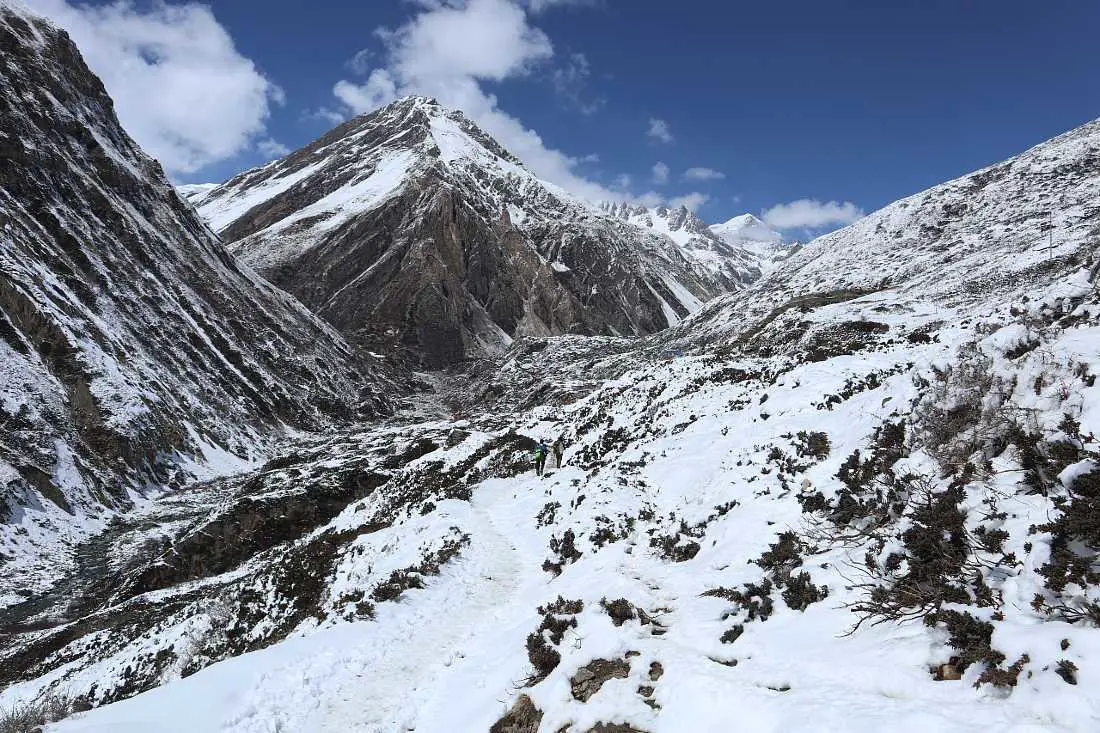
In fact, it is one of my absolute favorite travel experiences after traveling the world for nearly 20 years through 67 countries. Seriously.
I put together this Annapurna Circuit Trek guide to help you decide how you are going to do the trek and all the info you need to know when planning for it. I hope it’s helpful.
My Ultimate Trekking Annapurna Circuit Guide: All the Info
The full original Annapurna Circuit trek starts in Besisahar and ends in Nayapul. It is 260km/161 miles and it takes around two to three weeks to hike, depending on your pace. Basic roads have since been built from Besisahar to Manang, and Muktinath to Nayapul so there are now only three days of walking where there are no roads at all.
The highest point is Thorong La Pass at 5,416 meters (17,769 feet), and the starting point in Besisahar is 760 meters (2,490 feet). Due to the large change in elevation, the scenery is diverse and slowly changes as you ascend and then descend after summiting the pass.
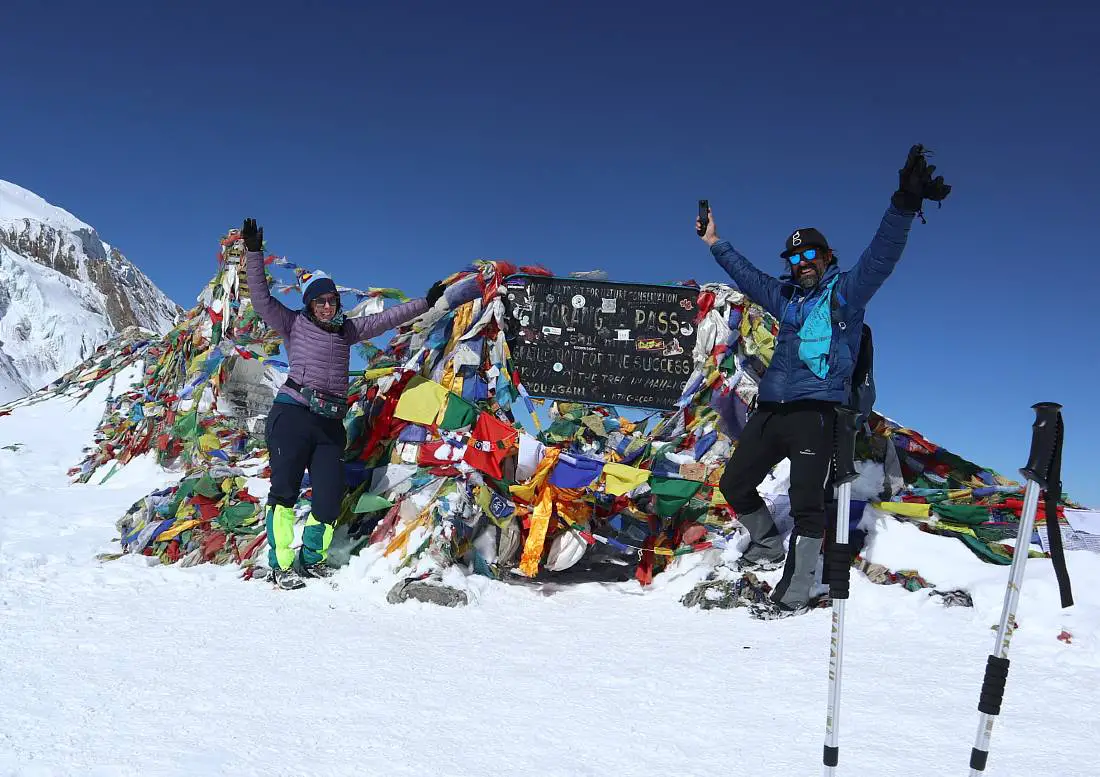
Do You Need a Guide?
As of April 1 2023, you officially do need to hire a guide for trekking the Annapurna Circuit but from what I have been hearing in the Annapurna Circuit Trek Facebook group , a lot of people have been hiking independently and haven’t had any issues doing so.
We hiked the Annapurna Circuit independently and it was a good option for us although our friends had a guide and there are a lot of benefits for that too.
Pros of Trekking the Annapurna Circuit Independently: Less expensive, more freedom to plan your trek as you go, and it’s more likely you will end up meeting and hiking with other hikers.
Cons of Trekking the Annapurna Circuit Independently: If something goes wrong it’ll be harder to get help, it can be very stressful route planning and doing everything yourself, it’s more likely you could get lost, and you won’t get all the background, history, etc of where you are hiking.
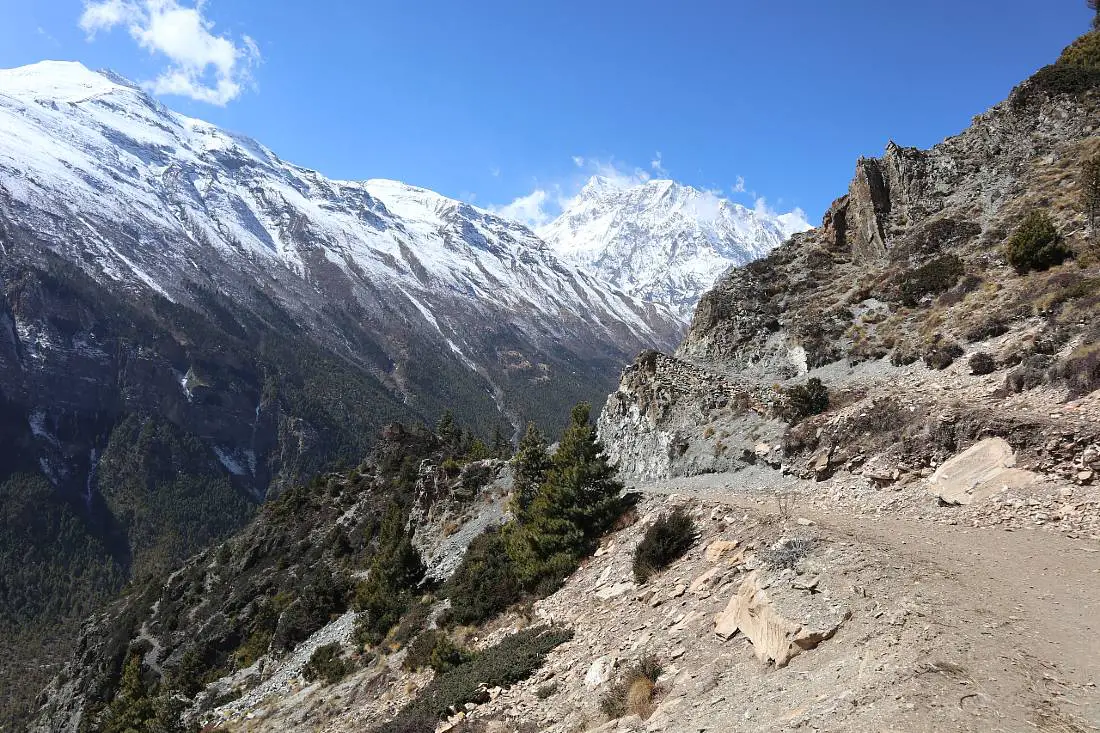
In comparison, here are the pros and cons of hiking with a guide or on a group tour:
Pros of Trekking the Annapurna Circuit With a Guide: Gain knowledge of the places you are hiking, supporting the local community, no stressful route planning, guides know the best guesthouses for lunch and to stay at, your guide will keep you safe, and if something happens they will know how to contact help.
Cons of Trekking the Annapurna Circuit With a Guide: More expensive, isn’t always conducive to meeting independent trekkers, could be a bad experience if you don’t end up liking or trusting your guide or group, a more rigid schedule.
If you are hiking solo or don’t have a lot of high-altitude hiking or any hiking experience, I highly recommend you hire a guide or join a group package for your Annapurna Circuit trek . This trek is no joke and many people have died over the years from bad weather, altitude sickness, falls, and more. Don’t be one of them.
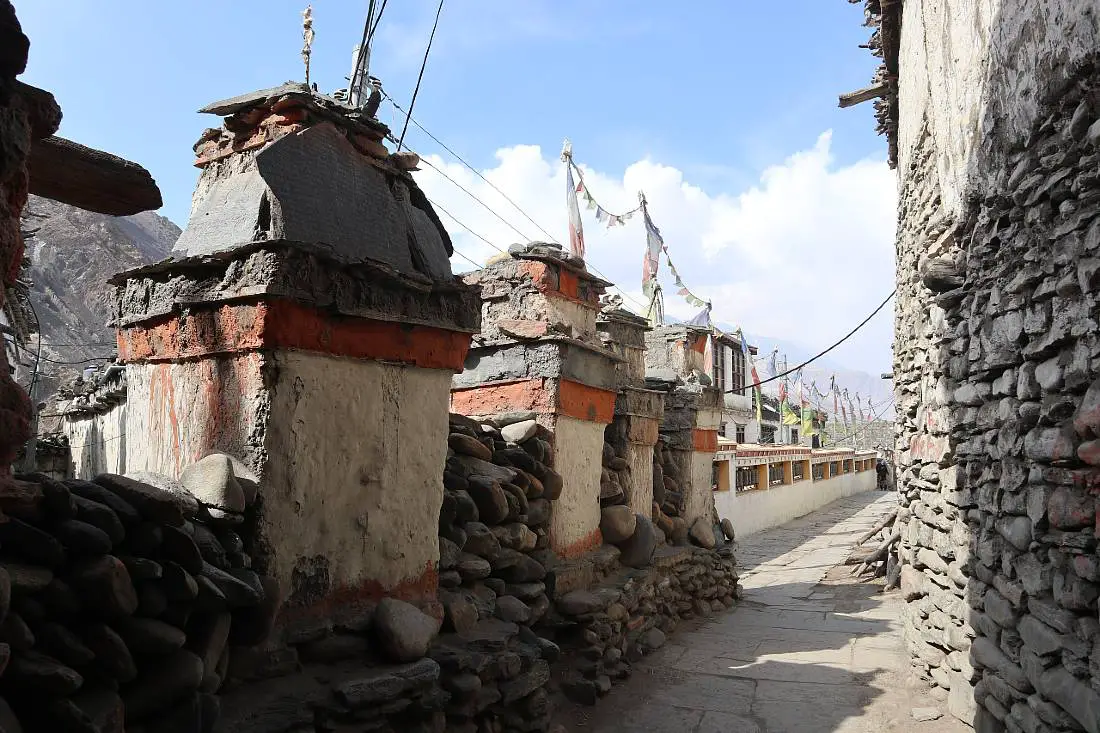
Is it Still Worth Trekking the Annapurna Circuit?
Some people who trekked the Annapurna Circuit years ago before the road was built say that it isn’t worth hiking it anymore, but I disagree. I can’t compare what it was like hiking it then to now but I thoroughly enjoyed my experience and it is definitely worth hiking.
It is relatively easy to avoid the road for a lot of the time as alternative walking trails have been built. We also found the road from Besisahar to Manang had hardly any vehicles on it when we trekked in early March, although this could be completely different in the busiest months of April, November, and December.

The Best Time To Trek the Annapurna Circuit
There are two trekking windows where it is the best time to hike the Annapurna Circuit – mid-March to the beginning of May, and October and November. The autumn months of October and November are the most popular due to the skies being clearer at lower elevations and the weather generally being more stable.
You can technically hike the Annapurna Circuit all year round but it would be bitterly cold in winter (December – February) and the pass is more likely to close due to too much snow and dangerous storms. In the hot summer months of June – August, it is very hot and wet at lower elevations of the hike and there is a serious risk of landslides so it is also not recommended to hike the circuit then.
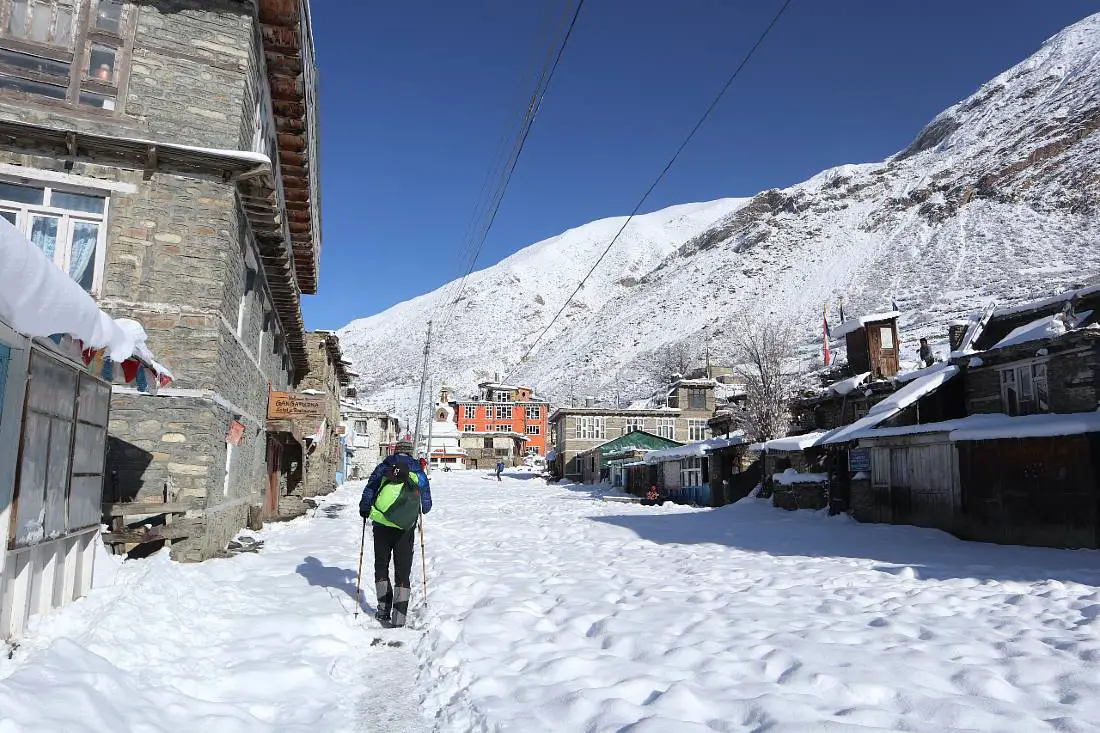
We started hiking a couple of weeks before the spring season officially started, from March 1st-13th. We did have one day when we were snowed in at Manang (luckily it was our scheduled rest day!) and then quite thick snow the next day and from Thorong Phedi up to Thorong La Pass but we generally had beautiful weather. It was colder at higher altitudes than it would have been a month or so later though.
It was also a little hazy for the first three days until we reached higher altitudes and we had a few afternoon storms but we were done hiking for the day once they hit. The plus of starting in early March is that the crowds are much thinner, and it is much more comfortable hiking at lower temperatures – it can get very hot and sticky by April.
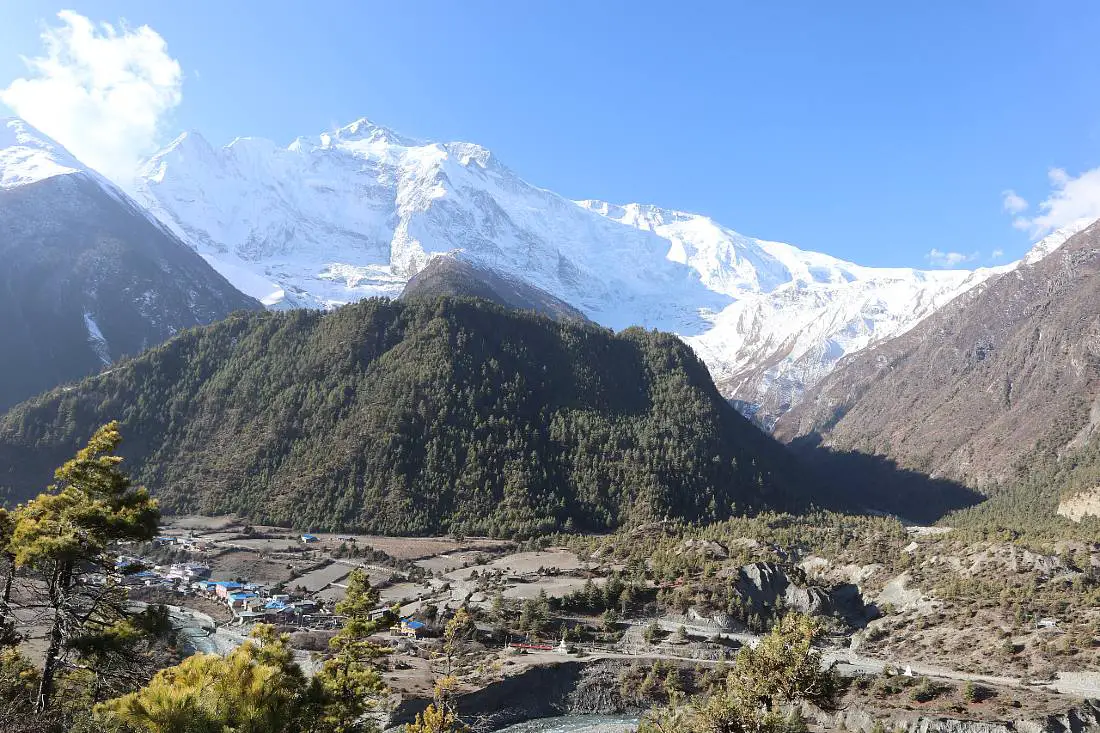
Annapurna Trek Permits
Pre-April 1st 2023, you needed to apply for both TIMS (Trekker’s Information Management Systems) and ACAP ( Annapurna Conservation Management Project ) before trekking if you were hiking independently.
From everything I have been reading recently, you no longer need to apply for a TIMS card, just ACAP if you are hiking without a guide. You can get your ACAP at the Nepal Tourism Board Office in Kathmandu or Pokhara, the office in Besisahar has just recently closed.
I have also read that you can get it in Khudi which is a village close to Besisahar but I’m not sure exactly where the office is.
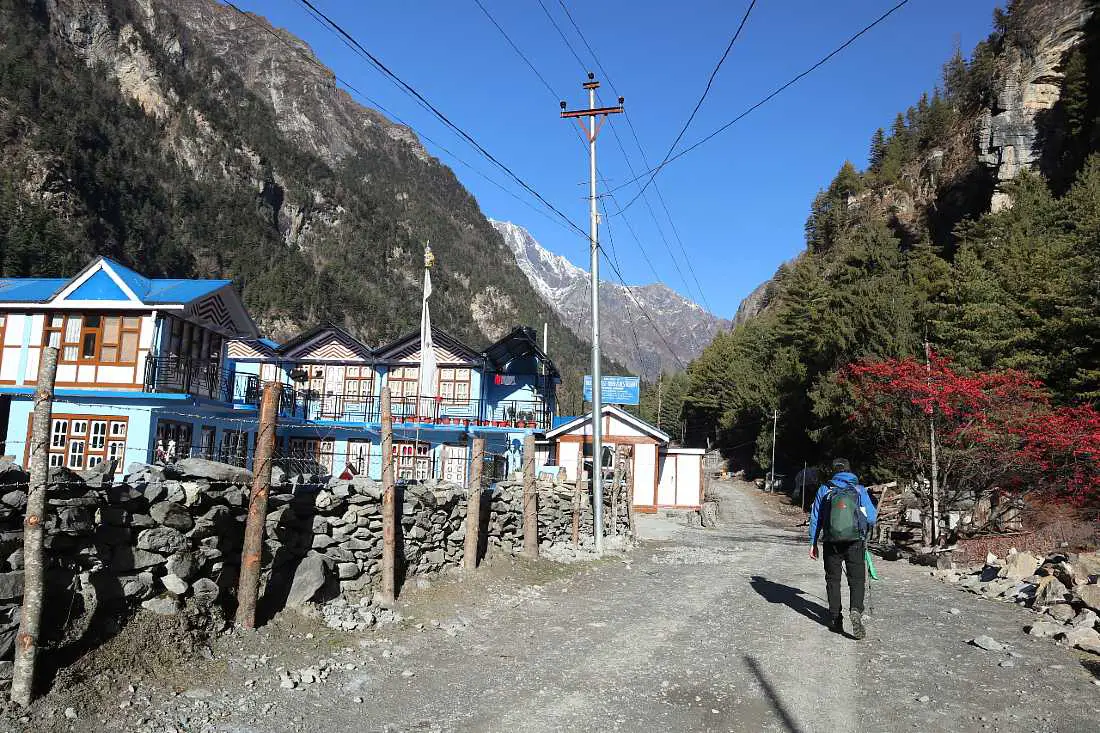
It costs 3,000 rupees (around $23) and you need to take your passport, two passport photos (I believe you can get photos taken for free there but I took my own), proof of your insurance, and the fee in Nepalese rupees. Check opening times for the office you plan to go to to ensure you don’t turn up when it is closed.
If you have hired a guide or are on a group tour, they will organize the ACAP for you, they’ll just need the above items to do this.
My Annapurna Circuit Trek Itinerary: Besisahar To Marpha
There are so many ways you can do this trek depending on how much time you have, what your fitness level is, how many hours you want to hike each day, and your budget – the options are endless.
I did a lot of research before we did the hike to decide what Annapurna Circuit Trek itinerary would best fit with what I wanted out of the experience and I was really happy with how everything turned out.
I spent thirteen days trekking from Besisahar to Marpha including a rest day in Manang. We also cut out the 10km dusty road section between Kagbeni and Jomsom by taking a bus.
My goal was to hike for 5-7 hours per day and then have the late afternoon/evenings to socialize and relax in the teahouses. Experiencing the teahouses is a big part of what makes the Annapurna Circuit special. We could have pushed ourselves more and hiked more miles per day but I’m really happy with how we did it.
Here is the basic outline of our Annapurna Circuit Trek Itinerary:
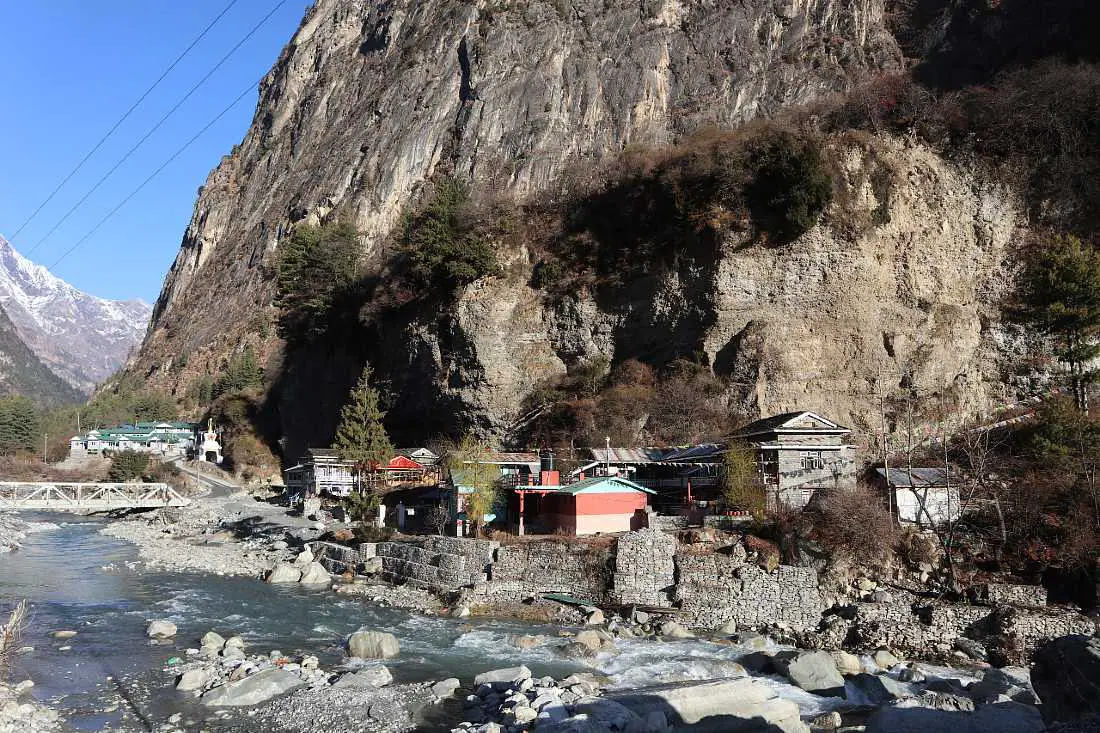
Day 1: Bus from Pokhara to Besisahar – 5 hours. Besisahar to Bhulbhule – 9km/5.6 miles.
Day 2: Bhulbhule to Jagat – 19km/11.8 miles.
Day 3: Jagat to Dharapani – 17km/10.5 miles.
Day 4: Dharapani to Chame – 17km/10.5 miles.
Day 5: Chame to Upper Pisang – 16km/10 miles.
Day 6: Upper Pisang to Ngawal – 10km/6.2 miles.
Day 7: Ngawal to Manang – 10km/6.2 miles
Day 8: Rest day in Manang.
Day 9: Manang to Yak Kharka – 11km/6.8 miles.
Day 10: Yak Kharka to Thorong Phedi – 6.5km/4 miles.
Day 11: Thorong Phedi to Muktinath – 16km/10 miles.
Day 12: Muktinath to Kagbeni – 16km/10 miles.
Day 13: Bus from Kagbeni to Jomsom – 1 hour. Hike Jomsom to Marpha – 9km/5.6 miles.
Day 14: Bus from Marpha to Tatopani – 3 hours. Soak in the hot springs.
Day 15: Bus from Tatopani to Pokhara – 5.5 hours.
We had originally planned to hike from Tatopani to Poon Hill and then finish in Ngawal but Toby’s shoulder was really hurting him (he broke his collarbone a few years ago) and the weather was turning so we decided to head back to Pokhara via Tatopani from Marpha.
As it was early in the season, we decided not to do the side trip to Tilicho Lake because the lake was frozen, everything was completely covered in snow, and it was so cold at high elevations. If I hiked it in a month where it wasn’t frozen, I would have likely added it to my Annapurna Circuit Trek Itinerary.
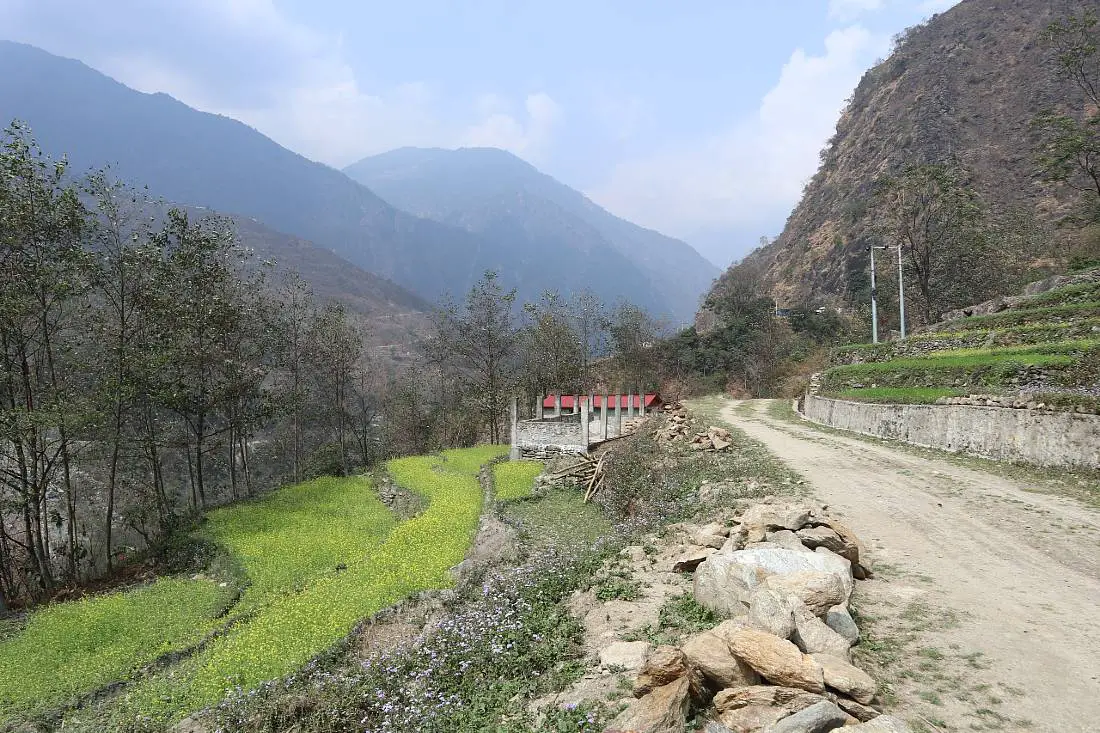
What To Pack For the Annapurna Circuit Trek
What you should pack for the Annapurna Circuit varies depending on what time of year you are going. I hiked the circuit in early March so I needed to bring warmer clothes than I would have needed for September, October, April, or May.

Thermals, a fleece, a puffer jacket, warm socks, gloves, and a wooly hat are all important for the colder months. And definitely bring toilet paper – there is none provided at any of the tea houses.
I have an extremely detailed packing list where you can see exactly what I packed, what I wish I had packed, and what I didn’t end up needing.
Insurance For the Annapurna Circuit Trek
You are required to have insurance for your trek (you will need to show it to get your ACAP). As many people suffer from altitude sickness while hiking and there have been a lot of helicopter rescues over the years, make sure you have insurance that will cover you for hiking up to 5,500 meters.
I went with a World Nomads Standard Plan which covers you for hiking up to 6,000 meters. I didn’t have to use it (luckily) so I can’t comment on how good they are but I have read mixed reviews.
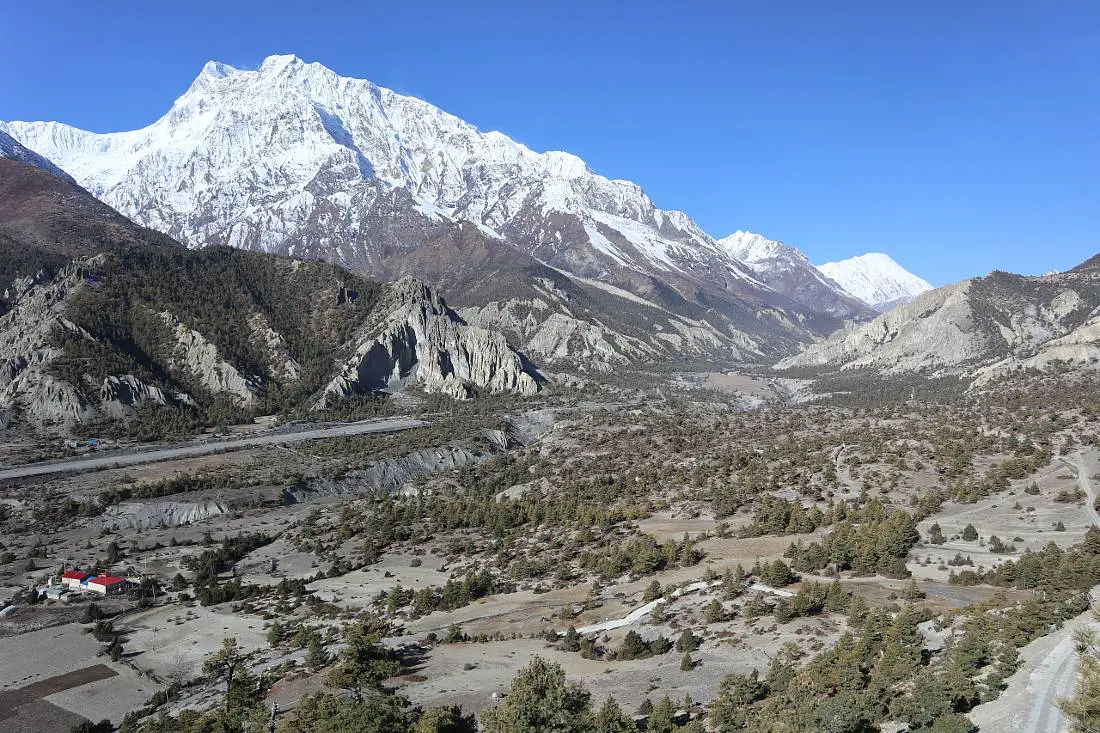
How To Get To the Start of the Annapurna Circuit Trek
The Annapurna Circuit Trek officially begins in Besisahar, where buses from Kathmandu and Pokhara arrive. The bus takes approximately 5 hours from Pokhara and about 8 hours from Kathmandu.
These times are approximate because the roads in Nepal are terrible and it can be really slow going, especially with the ongoing road works.
If you are taking the bus from Pokhara, it costs around 700-800 rupees (we paid 750 rupees each = $5.50), and you can either purchase it from a travel agent or from your accommodation.
The bus departs at 6.30am from the tourist bus park (named as such on Google Maps) off Rastra Bank Road. We were staying at the northern end of Lakeside and a taxi to the bus station cost 400 rupees.
If you are taking a bus from Kathmandu, you can also purchase your ticket from your accommodation or from a travel agent. The ticket costs around 1000-1500 rupees and buses leave at 7am. This is for a direct tourist bus of which there are multiple companies.
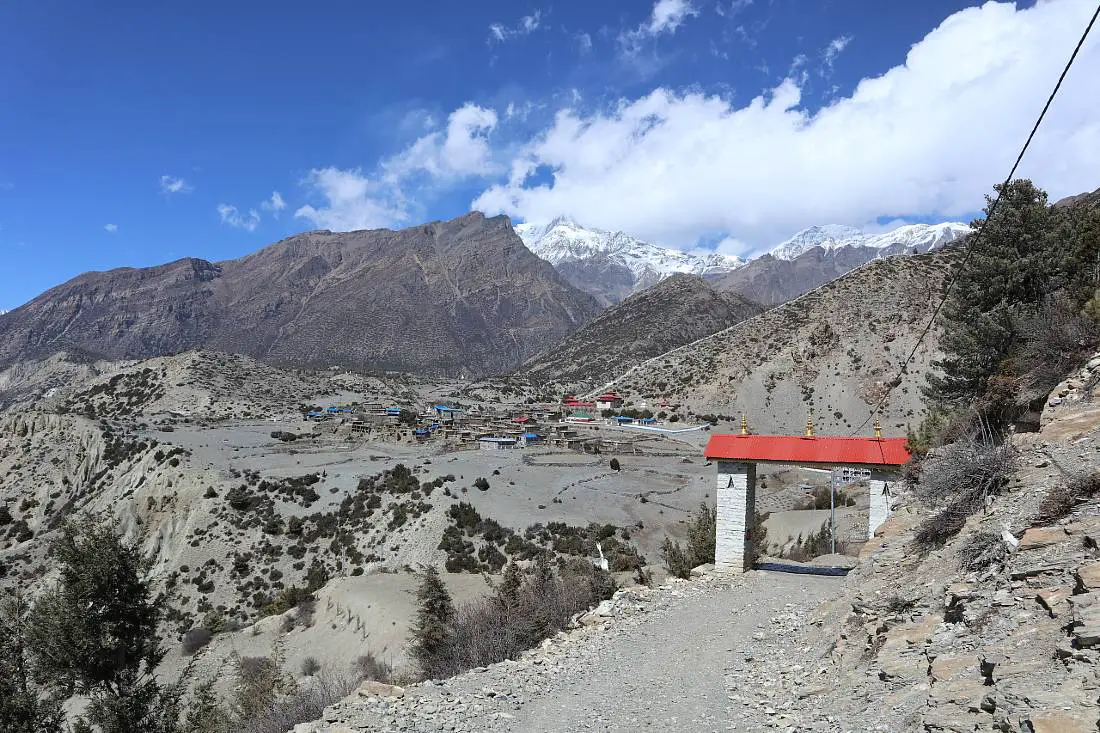
You will have to put your larger bags on the roof of the bus (it is then covered and roped up) so I advise you to keep your valuables and anything you need for the bus trip in a small bag on your person.
Also, put a waterproof bag cover on your larger bag in case it rains because the bags aren’t generally completely covered up on top.
If you are short on time and don’t want to start hiking from Besisahar, you could take a local bus another 7 km or so from Besisahar to Bhulbhule or a bit further to Ngadi (usually easy to do on the same day unless your bus from Kathmandu is really late) or hire a jeep (ask around in town) to take you as far as Manang.
I don’t recommend starting in Manang. The road to get there is rough going and you will spend a full day getting there by jeep. It is also essential to acclimate slowly.
Starting in Jagat or Dharapani are good options if you want to shave some time off and not miss too much beautiful scenery. If I did it again I would have taken the bus to Bhulbhule and hiked from there because the first day wasn’t super interesting.
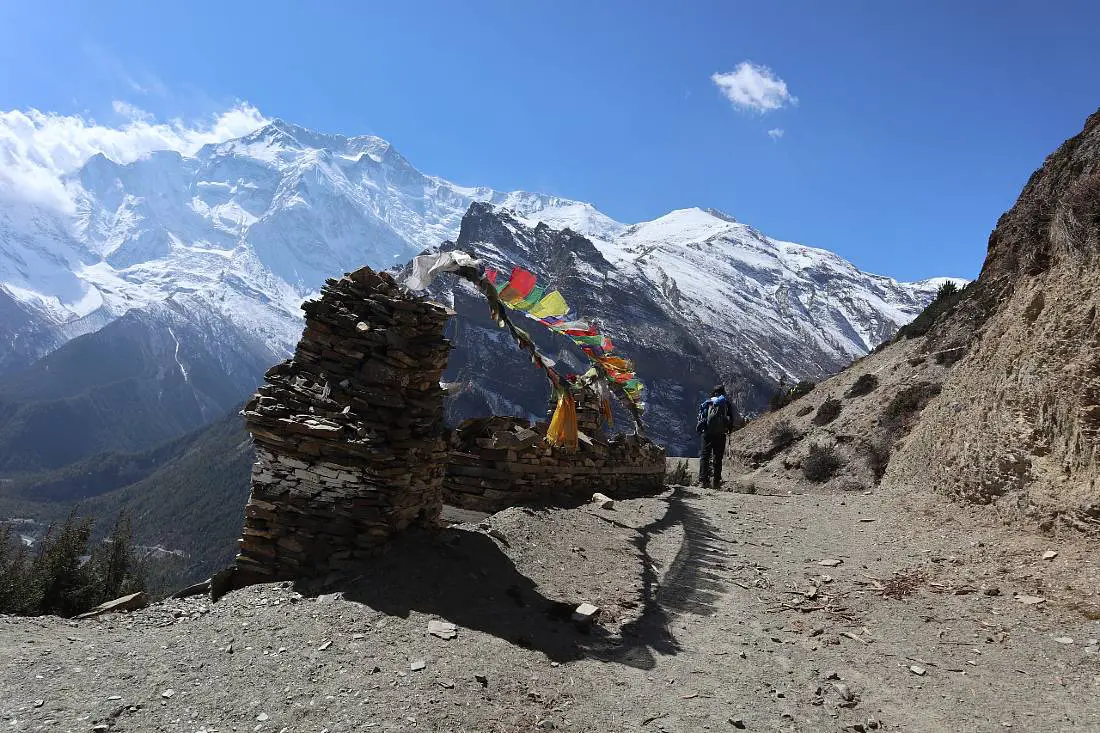
The cheapest way to back to Pokhara or Kathmandu when you finish hiking is by taking buses. We caught buses from Kagbeni to Jomsom, Marpha to Tatopani, and Tatopani to Pokhara without any issues.
Speak to your accommodation about how to purchase a bus ticket and where to catch the bus.
Alternatively, you could hire a jeep and driver but you are looking at $200+ depending on how far you are going. You can also enquire about getting a ride in a jeep at your accommodation.
Navigating When Trekking the Annapurna Circuit
We downloaded and used Maps.me for navigating on the Annapurna Circuit and it mostly steered us well. I also used detailed day-by-day descriptions of the trail from a couple of different blogs including this one and this one .
There are actually a lot of options for trails and you can also choose to hike on the road. Sometimes you don’t have a choice. We tried to avoid the road as much as we could without adding lots of extra miles onto our day.
Sometimes it can be hard to choose which trail to take and it can be a bit of a crapshoot because sometimes the trail may be closed at a point or it’s longer or harder than you think it’ll be. We ended up hiking an extra 3 km on an already long day on day two which wasn’t ideal, and we had to backtrack for about 20 minutes when we were hiking to Marpha because a bridge was washed out.
There are landslides often in the wet season so sometimes trails are closed and that won’t be updated on Maps.me so it’s important to speak to your hosts at the teahouses to see if they have any information about any trail closures ahead.
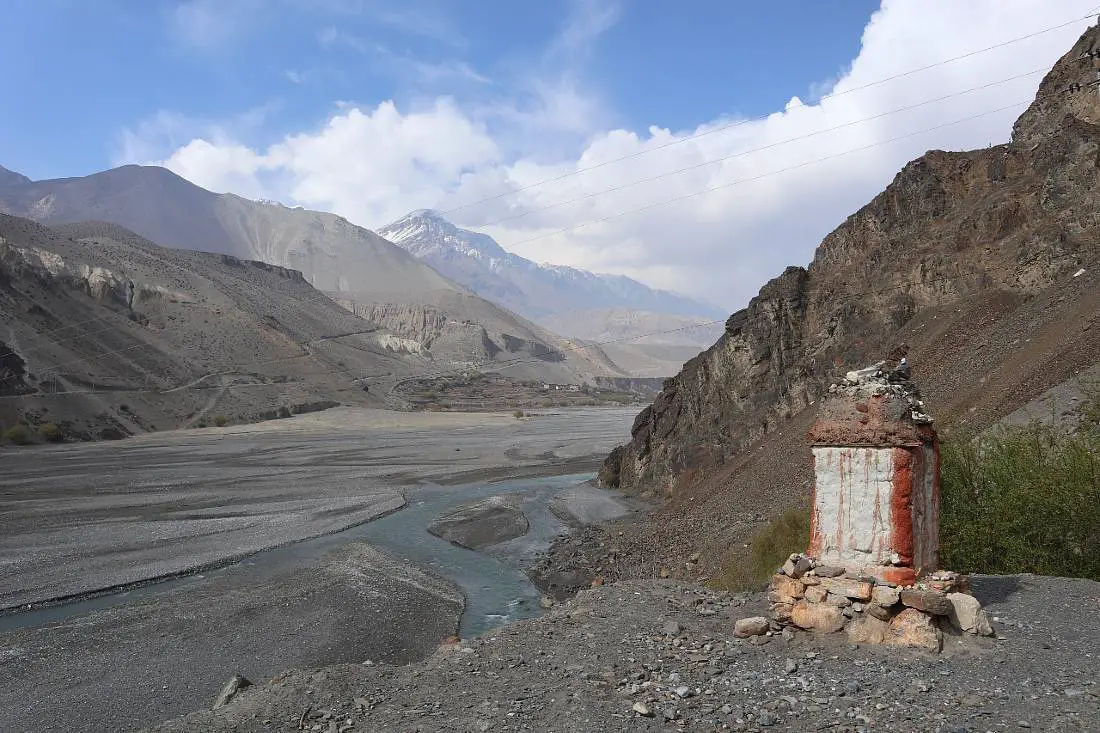
Sometimes there will be signs saying the trail is closed ahead before you even start hiking that way, and other times you may get an hour down a trail to then have to turn around and backtrack because the trail is closed.
This is when it is handy to have a guide with you because they hike these trails often and have a lot more firsthand information about whether a certain trail is closed or not.
I recommend reading posts on the Annapurna Circuit Trek Facebook group , there are lots of helpful posts from people who have just finished hiking (or are currently hiking) the circuit including what sections of trails are closed.
You can also purchase detailed guidebooks and topography maps. We purchased a topography map but didn’t end up using it.
Where To Stay on the Annapurna Circuit
The Annapurna Circuit is a teahouse trek and you will be staying in teahouses in the small villages along the Annapurna Circuit. If you are traveling with a guide, these guesthouses will be picked out for you but if you are traveling independently, you will just turn up in a town, find one that looks good, and enquire if they have any rooms.
At the beginning of our trek, we mostly negotiated a free room if we purchased dinner and breakfast at the teahouse and this was usually not an issue. We always made sure to get tea and apple pie on arrival too and to purchase some snacks.

Negotiating a free room if you are eating meals there is the norm on the Annapurna Circuit but I changed my view about this practice as time went on. The meals are very cheap, especially at lower elevations, and I don’t think it is fair to not pay for the room if you are eating your meals there.
The room prices are usually only a few dollars (this gets more expensive the higher you hike) which is not a lot for a Western traveler but goes a lot further for the locals so I encourage you to pay it as well as eating there.
Teahouse accommodation is pretty simple with no heating in the rooms, but these days you usually get free WiFi and some teahouses even have hot showers! If it’s really cold, you can ask for extra blankets. Some teahouses have rooms with private bathrooms but most of the ones we stayed in had shared bathrooms outside the rooms.
Most of the teahouse rooms we stayed in had twin beds rather than double beds, so I wasn’t able to utilize Toby’s body heat, unfortunately.
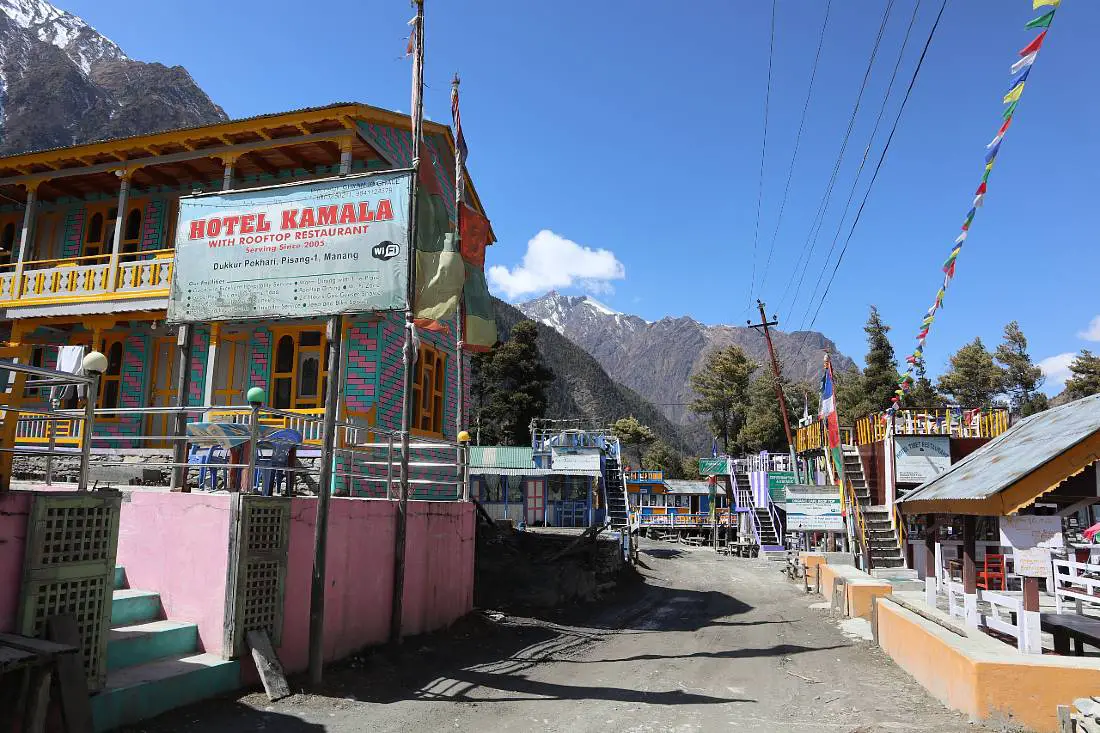
To stay warm in the evenings, you can hang out and meet other hikers in the dining room area as there is usually a potbellied stove that is lit for the evening and morning when it is cold. From Chame onwards, our room was too cold to stay in there longer than necessary.
We were lucky that in most places we stayed at there were Western-style toilets but it’s pretty much inevitable that you will come across squat toilets at some stage of the hike, especially between Manang and Muktinath.
Food on the Annapurna Circuit
While you will still find Dal Baht everywhere (Dal Bhat power 24-hour!), you can actually find a lot of other food options along the trail.
For lunch and dinner, Dal Baht is usually the cheapest option and is delicious so we ate that a lot. Dal Bhat consists of lentil curry, rice, curried potatoes, and pickled vegetables with a papadum, and you get unlimited free refills (except for papadums unfortunately).
We also had Thukpa (noodle soup), vegetable soups, pasta dishes, fried noodles, fried rice, vegetarian and chicken momos, yak burgers, sandwiches, and even pizza along the Annapurna Circuit.
For breakfast, I usually had porridge or a pancake with apples or bananas, Tibetan bread with honey, and boiled eggs. Boiled eggs are great to put in your bag for a snack later on and I did this often.

I also had almost daily apple pies – the Annapurna Circuit is known as the apple pie trail so it had to be done. We also found a few delicious bakeries that had apple donuts, cake, and cinnamon rolls.
For drinks, you can find bottled water, soda, beer, and even spirits and wine at some guest houses. Masala tea is everywhere and I loved the hot lemon and honey drinks and hot chocolate. Unfortunately, at most teahouses the coffee is instant but you’ll find real coffee at a couple of places along the way.
If I had been coming from New Zealand I would have packed some Jed’s coffee bean bags so I could make my own coffee because I really don’t like instant. Next time!
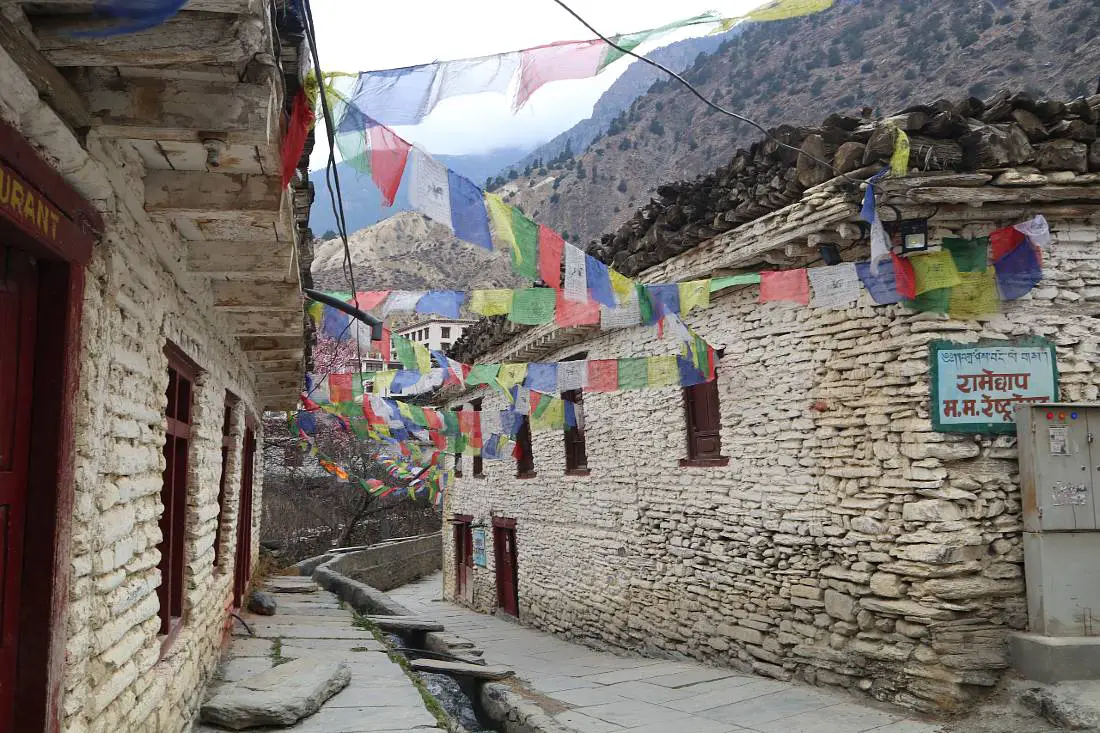
The food at the Tilicho Hotel in Manang- especially the cinnamon rolls, apple crumble, coffee, and vegetarian lasagne – was the best I had on the trail.
I also loved the apple donut and real coffee I had from the little glass pyramid cafe in Bhratang (after Chame), shakshuka and real coffee from Hotel Bob Marley in Muktinath, the yak burger happy meal from Yak Donald’s in Kagbeni, and the Dal Bhat and apple and custard pie from Hotel Sonam in Marpha.
If you are vegan or gluten-free, Dal Bhat will be your best friend (double check it’s vegan because some may have traces of dairy).
Annapurna Circuit Trek Cost
Your Annapurna Trek cost can obviously differ depending on how spendy you are. Toby and I are mid to high-end budget travelers these days so we wanted to have enough money to get occasional Western meals, daily apple pie, lots of tea, occasional beers, as well as having an emergency stash.
Our big unexpected splurge was hiring a porter for the Thorong La Pass day and we had to purchase some gear in Manang.
I tracked all of my Annapurna Circuit Trek costs during my 13 days of hiking (and the 1.5 days spent traveling back to Pokhara after) and I spent a total of $389. This works out to $27 per day. I didn’t include the cost of the porter for one day ($45 for my half) or the gear we bought in Manang, but this includes the ACAP permit and the bus to and from Pokhara.
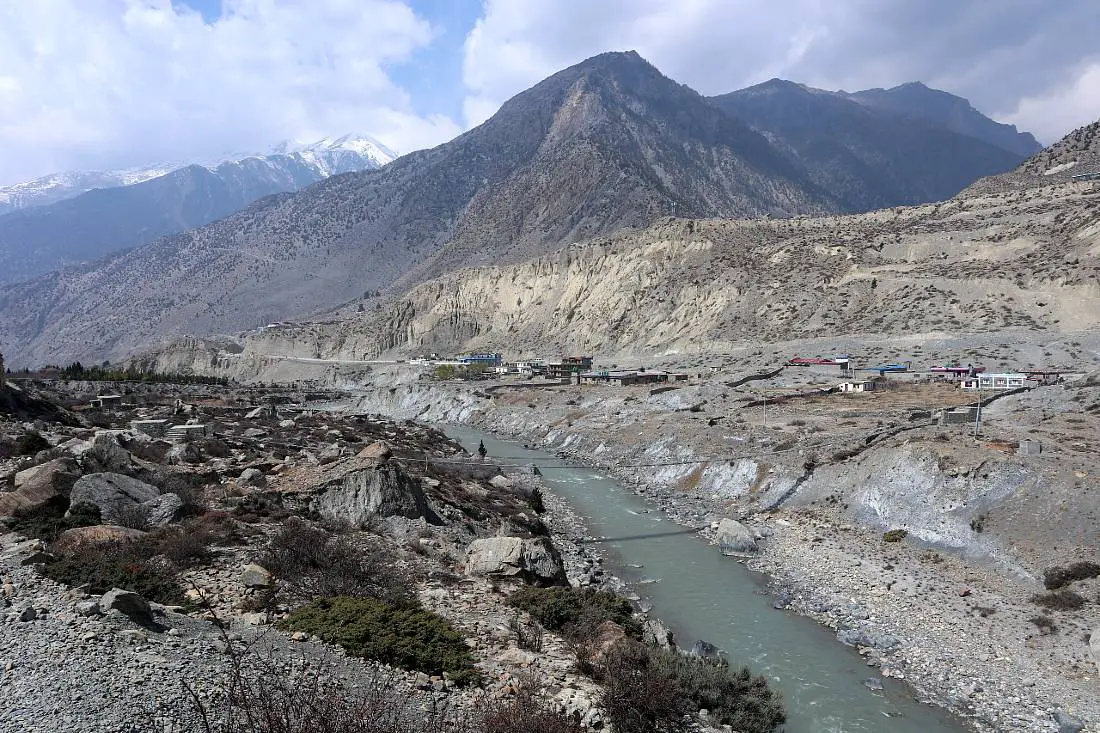
This is what we spent as independent trekkers. If you are going to hire a guide the going rate is usually $25-$35 per day (per guide, not per person) and a tip of around 10-20% is the norm. If you are hiring a porter to carry your bag, this is generally $15-$25 per day.
Also keep in mind that for most of our trek, we didn’t pay for accommodation, except in Manang, Yak Kharka, Kagbeni, and Marpha, so if you are paying for accommodation every night that is a few more dollars per day.
These are some of the costs for when I trekked the Annapurna Circuit in March 2023:
- Bus from Pokhara to Besisahar 750 rupees
- Chocolate bar 200 rupees
- Plate of vegetable momos 550 rupees
- Room with attached bathroom 300-1200 rupees
- Local bus from Kagbeni to Jomsom 250 rupees
- Hot springs entry in Tatopani 150 rupees
- Local bus from Marpha to Tatopani 1000 rupees
- Local bus from Tatopani to Pokhara 900 rupees
Important Tips For Your Trek
- Get out enough cash to last you for the full trek as there are only a couple of places to get cash along the way (Manang is one of the main ones) and the ATMs aren’t always working. I recommend $30-$35 per day for the Annapurna Circuit Trek cost to be on the safe side.
- Download Maps.me for the full Annapurna Circuit Trek
- Download any blog posts with information that you want to read when you are offline (hint, hint)
- Have a printed copy of your insurance details, you’ll need this for the ACAP but it’s good to have in case something happens on the trek.
- Purchase some snacks and something to eat for lunch on the first day. You may be stuck on a bus for most of the day and you want to hit the ground running when you arrive in Besisihar.
- Purchase a Nepalese SIM card. It’s good to have this for coverage when you are staying at a teahouse with no WiFi and in case you need to call emergency services or your insurance provider.
- If you do hire a guide, or a porter, or go with an organized group tour, make sure to take cash for tipping. I believe $5 per person per day is customary.
- For cold nights, fill up your Nalgene with boiling water and sleep with it in your sleeping bag. It will warm you up a lot. We didn’t have a Nalgene with us so we purchased large plastic water bottles, put the water in our water bladders then asked them to fill the bottles with boiling water. They do lose their shape from the heat but we didn’t have any issues with leaking.
- Consider if you want to use Diamox to avoid altitude sickness. Read up on the side effects and maybe try it out at lower altitudes first to make sure you don’t have a bad reaction. We used it because I got altitude sickness on the Inca Trail and it was horrendous. The only side effects we got were occasional pins and needles in our feet and on my chin, weirdly enough. Neither of us had any symptoms of altitude sickness for the whole trek, not even a headache. You can get it prescribed by your doctor or get it over the counter once you get to Nepal.
- You may be trying to decide whether you want to hire a porter to carry your bag. If you can pack light I don’t think it’s necessary BUT you can find porters along the trail to hire for even just a day. We ended up doing this for the summit day because Toby was worried about his bad knee on the 1,600 meters downhill after getting over the pass and I was worried about my asthmatic breathing at high altitude. We spoke to staff at the lodge in Thorong Phedi and they found someone for us. It won’t be cheap if you do this (it costs us $90!) but for us, it was so worth it and made our summit day so much more pleasant.
- You can also hire a mule to take you over the pass, we saw an older woman on a mule being led by a guide. It took her from High Camp to just before the pass.
- If you are hiking in the shoulder season like us and aren’t sure if you need some items like microspikes, there are a couple of gear shops in Manang that aren’t ridiculously priced. You can get trekking clothing, trekking poles, gaiters, microspikes, snacks and more. We even paid to get our laundry done in Manang.
- Don’t ascend more than 300-400 meters per day over 3,000 meters. If you follow this rule you are less likely to get altitude sickness. If you can, after dropping your bags at your teahouse home for the night, do an acclimatization hike 100-200 meters further up and back. This will further help with acclimatizing to the high altitude.
- Before deciding your route outline, take into account what you want from this experience. For me, I enjoyed starting early, hiking for 4-7 hours, and then spending the afternoon and evening relaxing, chatting with other trekkers, and reading at the teahouse. We met a guy who was hiking 30km a day because he found hanging out in the teahouses boring, and that suited him. To each their own.
- If hiking out of the four main hiking months (March, April, October, and November), be aware that not all teahouses and shops, etc will be open yet. As we hiked at the beginning of March, a couple of weeks before the spring season started, we did see that a few places were closed. The clinic that does the free acclimatization talk and the movie theater weren’t open in Manang when we were there which was a bummer.
- For checking the weather on the Annapurna Circuit, I used this website . It seemed to be pretty accurate when I was hiking and it also has temperatures for different altitudes which was really helpful.
I hope this Trekking Annapurna Circuit guide was helpful. Let me know if you have any questions or feedback.
If you enjoyed this post, check out my other multi-day hiking posts:
- Ultimate Lightweight Annapurna Circuit Packing List
- Hike From Aspen to Crested Butte: The Best Hike in Colorado
- Hiking the Tongariro Northern Circuit: One of New Zealand’s Great Walks
- Trekking Kalaw to Inle Lake: The Best Trek I Have Ever Done
- Pushing Myself to the Limit on the Kepler Track Great Walk
- The Best Kauai Hiking Adventures
- Hiking to Abbot Pass Hut in the Canadian Rockies
- Hiking the Hillary Trail on Auckland’s Wild West Coast
- Hiking Between the Pueblos Mancomunados Villages in Mexico
- Dealing with Altitude Sickness on the World-Famous Inca Trail in Peru

Leave a Reply Cancel reply
Your email address will not be published. Required fields are marked *
This site uses Akismet to reduce spam. Learn how your comment data is processed .
10 things I wish I knew before hiking the Annapurna Circuit
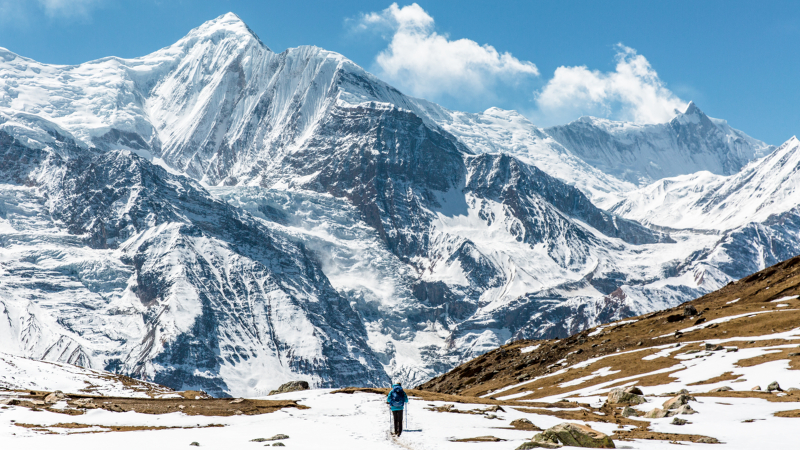
It’s one of the world’s classic long-distance hiking trails, and still one of Nepal’s most popular treks.
The Annapurna Circuit , a 12 to 21-day route that begins in the lush green villages of the Himalayan foothills. Taking trekkers over the 5,416m Thorong La Pass and down to the Tibetan-influenced temples and communities of the Mustang Valley.
If you want to experience a little bit of everything Nepal has to offer, this is perhaps the best trek to set off on, but it’s certainly no easy feat. The circuit is very tough at times, and the high altitude and unpredictable weather of the Annapurna mountain range can make crossing the Thorong La Pass a dangerous task – particularly if you’re not prepared.
Thankfully, I’ve got your back! So, here are ten things you should really know in order to complete the amazing Annapurna Circuit safely and with a smile on your face.
Check out Intrepid's Annapurna treks
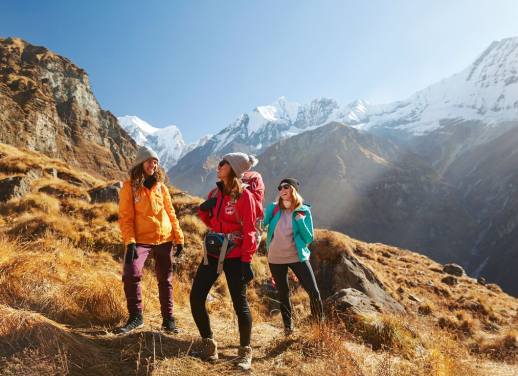
1. Plan the time of year right
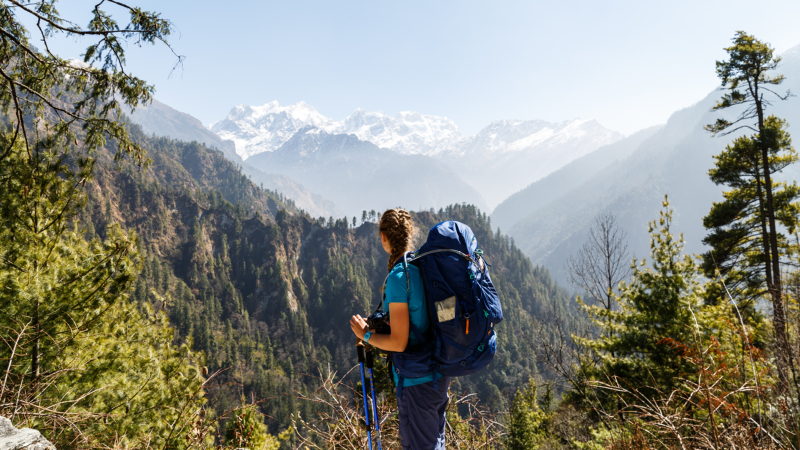
Photo captured by Annapurna Mellor
Like with many of the treks in Nepal, there are certain times of year when the weather conditions are ideal. For the Annapurna Circuit, October and November or April and May are widely considered to be the best times for trekking. The weather during these two seasons is generally clear and dry, and so it’s not too cold when heading into high altitudes. These two seasons are also the busiest times to be on the trail, with many other trekkers from across the world heading into the Himalayas.
You can also trek at other times of the year, but you will need to be a little more prepared for adverse weather conditions. The winter season, December to March, can also have clear skies and spectacular views. But it can be incredibly cold at higher altitudes, with thick snow on the ground that can often cause the Thorong La Pass to close at short notice. If you decide to trek during the winter season, make sure you have extra layers, a thick sleeping bag suited to temperatures of at least -20°C and crampons, which can be bought in Kathmandu and Pokhara.
GO NOW: EXPERIENCE THE BEAUTY OF THE ANNAPURNA CIRCUIT ON THIS 16-DAY ADVENTURE
2. Bring only what you need, leave the rest behind
When trekking on the Annapurna Circuit with Intrepid, Nepalese porters will carry 10kg of your gear. Anything extra will need to be carried on your own back, so packing as lightly as possible is essential. There are some things you need, such as a good quality sleeping bag, warm jackets, medicines, thermal layers and a head torch. But leave your jeans, laptop and makeup back in Kathmandu. You really don’t need them on the trail, and your back will thank you for it!
SUBSCRIBE TO OUR NEWSLETTER FOR THE LATEST TREKKING NEWS, OFFERS AND COMPETITIONS
3. The altitude should not be underestimated
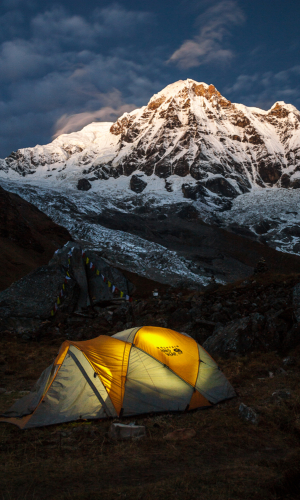
Altitude sickness can happen anytime above 2,500m. It doesn’t matter how fit you are, it can affect anyone and does so randomly. You can stay prepared by taking Diamox, an altitude medication, but aside from that just take it slow, drink lots of water and listen to your body. Before you set off on the trail, read up on the symptoms of altitude sickness so you’re aware of them if you start to feel the effects. Your guides will also be very knowledgeable about altitude and can be an essential source of help if you aren’t feeling well. The Annapurna Circuit reaches over 5,000m, that’s seriously high, and almost everyone will experience some mild symptoms like headaches or difficulty sleeping.
RELATED: ANNAPURNA OR EVEREST? YOUR DEFINITIVE TREKKING GUIDE
4. Be prepared for all weathers, whatever the time of year
While certain times of the year have much more suitable trekking weather (see point one), it is vital to be prepared for all possible conditions, no matter when you decide to go. High in the Himalayas, the weather is unpredictable, and snow, rain or storms can happen at any time. Climate change also means that weather patterns have become even more erratic over the last few years. Even if you’re trekking in October, be prepared for snow or storms on the trail. Pack enough warm clothing, make sure your boots are waterproof and don’t forget your sun cream or a sunhat.
GO NOW: DISCOVER THE HIGHLIGHTS OF THE ANNAPURNA CIRCUIT ON THIS 16-DAY ESCAPE
5. Eat well and look after your body
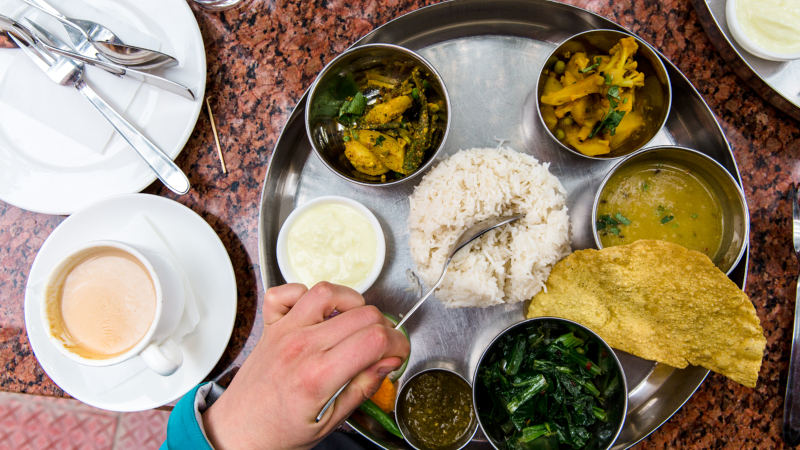
One of the best things about the Annapurna Circuit is the food and hospitality you will receive in the teahouses. Each evening, after a long day of trekking, you will be delighted to sit down in front of a roaring fire and tuck into a plate of dal bhat (a traditional Nepali meal of rice, lentils, vegetable curry and pickle). The food is delicious and very filling, and your body will be grateful for it the next day when you feel revived and ready to head out on the trail again. Other common offerings in guesthouses include garlic soup, a local remedy for altitude sickness and much better than it sounds. As well as, fried potatoes, spaghetti with local vegetables and of course apple pie – which is the Annapurna Circuit’s desert of choice due to the apple orchards growing in many of the villages along the trail. For snacking, I recommend stocking up in Kathmandu, as the cost of items like chocolate bars can get very high on the circuit.
RELATED: 8 NEPALI DISHES YOU HAVE TO TRY
6. It’s good to have a way to purify water
Plastic is a big problem on trekking routes across Nepal, as most of these small villages have no waste disposal system. This is leaving mountainsides cluttered with discarded plastic bottles, which is really not how we want to be treating these areas of striking natural beauty! You can’t drink the tap water in Nepal, and you really do need to be drinking a lot on the trail as you are walking long distances at high altitudes.
I recommend getting a steel reusable water bottle in Kathmandu. Along the trail, there are many villages with purified drinking water stations. Here you can refill your bottle and it actually works out much cheaper than buying bottled water. You can also use water purification tablets or buy a steripen. During the evenings, we would often order pots of hot water or tea and drink that, you can also fill up your bottle with any remaining in the pot and it’ll still be good to drink the next day.
TAKE ME THERE: EXPLORE OUR FULL RANGE OF ANNAPURNA CIRCUIT BREAKS
7. Learn some cultural respect
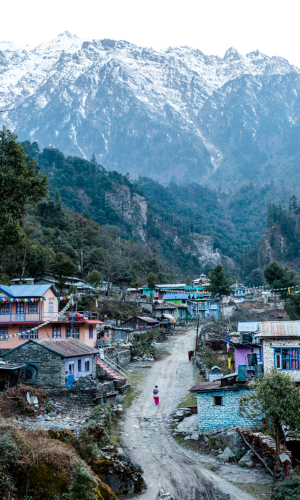
For many people, trekking in Nepal is about mountain views and hiking. But this is also a cultural trail, and it’s important to respect the people that call these villages their home. I recommend learning a little more about the cultures you are passing through. Speak to the families running the teahouses and go visit local gompas or temples. Opening your eyes to the cultures, religions and heritage of the trail will make it a much more enjoyable and meaningful experience, and it also means a lot to the local people when trekkers take an interest in their lives.
RELATED: MY INCREDIBLE MEETING WITH A HERMIT ON A NEPAL MOUNTAIN TREK
8. Don’t run out of cash
Once you leave Besisahar, there are no cash machines on the Annapurna Trail until you reach Jomsom after the Thorong La Pass. So, you need to be prepared and carry all the money you will need for the journey. While food and drinks in the teahouses can be cheap in the lowlands, they increase significantly as you increase in altitude and the road disappears. In Kathmandu, dal bhat is likely to cost you around 200 rupees, but this can grow to around 800 when you get above 3,500m. Western food such as burgers, pasta and burritos (yes, all food you can get on the trail), also tends to be very expensive as you get higher. I would recommend taking at least $20 per day for the trek, and if you’re a big eater or want to drink alcohol, $30-$40 per day is better.
GO NOW: TACKLE ANNAPURNA AND EVEREST ON THIS 31-DAY EPIC
9. Prepare yourself for the Thorong La Pass
Crossing the Thorong La Pass was probably the hardest day of my life! Waking up before sunrise and heading over narrow ridges in thick snow. Then climbing continuously for hours before finally reaching the prayer flags on the pass, breathless and completely relieved. Ok, maybe I’m not selling it so well. But it is essential to be prepared for this day, which will really push even the fittest hiker to the limits.
As long as you’re prepared, wearing enough warm clothes and have acclimatised enough to ensure your body comfortably makes the journey, then reaching the Thorong La Pass is going to be one of the most joyous moments of your trekking trip! Plus, once you’ve reached the top, you get to descend 1,600m to Muktinath, where the air is thick in oxygen and there are even hot showers to look forward to.
GO NOW: LIMITED ON TIME? OUR 5-DAY WALKING TOUR THROUGH THE ANNAPURNA RANGE
10. Be positive, take it slow and enjoy the journey!
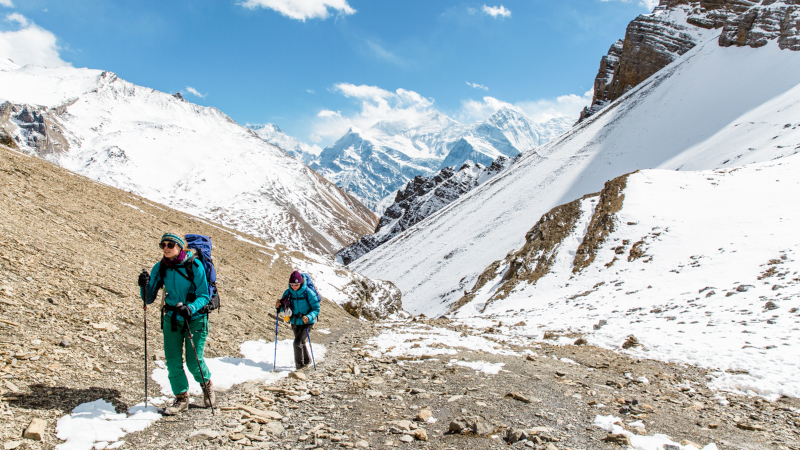
Travelling is meant to push you and challenge you in so many ways and trekking the Annapurna Circuit in Nepal will certainly do just that. While this is a difficult trek at times, it is also an incredibly enjoyable journey and one that can be completed by people of all ages and all fitness levels. The most important thing throughout the trek is to stay positive. Even when your body aches and you’re craving a hot shower, positivity will drive you on and it won’t be long before a breath-taking Himalayan panorama makes you remember why you’re here pushing yourself to the limit. It’s these incredible views, the wonderful hospitality of the local people and the company of your trekking buddies, which really make this a journey you will remember for the rest of your life!
RELATED: WHY CHALLENGING YOURSELF IS SUCH AN IMPORTANT PART OF TRAVELLING
Think you’re ready to take on the Annapurna Circuit? Take a look at our selection of trekking tours that’ll take you there . Already tackled it and looking for a new challenge? Check out our range of walking and trekking holidays from around the world.
Annapurna Mellor
Annapurna Mellor is a photographer, writer and storyteller. Her travels have taken her across Asia, Northern Africa, along the Trans-Siberian Railway and around Europe - always taking the road less travelled and always aiming to go a little deeper into the heart of local culture and people. Her photography work has been featured in National Geographic Traveller Magazine, Lonely Planet Guide Books and in campaigns for many travel brands around the world. Although she is usually dreaming about adventures afar, she is based, most of the time, in Manchester, England.
You might also like
5 reasons to visit sri lanka in the..., why 2024 is the best year to see..., 6 unique experiences you can have in el..., from delhi to udaipur, here are the five..., cinque terre vs amalfi coast: which destination to..., love at first bite: 10 famous sandwiches from..., galapagos or madagascar which unique destination should be..., central vs south america: how to plan your..., why road-tripping is the best way to see..., lessons learned on intrepid’s sabah adventure, travelling to chile here’s the best time to....
Manaslu Circuit
Himalaya Trail
Facts About Mt. Everest
Trek to Everest Base Camp
Best Time to Visit
Weather & Climate
Kathmandu Airport Guide
Top Destinations in Nepal
One Week in Nepal
Tipping Guide
Getting Around
Top Things to Do in Nepal
Complete Guide to Kathmandu
Top Things to Do in Kathmandu
Top Things to Do in Pokhara
Sacred Sites
Amazing Festivals
Top National Parks
Must-Try Food
Annapurna Circuit
How to Trek Nepal's Annapurna Circuit
Hike the most beautiful route in Nepal
:max_bytes(150000):strip_icc():format(webp)/Becker1-5b734a56c9e77c0025caddbd.jpg)
DANNY HU/Getty Images
Although small in stature geographically speaking, Nepal is a county that is blessed with an overabundance of adventure travel opportunities. Whether you're hiking or climbing in the mountains, spotting wildlife in Chitwan National Park , or whitewater rafting on a raging river, there are numerous activities that are guaranteed to get your heart pumping. Of course, most travelers that visit the Himalayan country come for the amazing trekking, with the hike to Everest Base Camp standing out as a true bucket-list achievement amongst veteran adventurers. But as iconic as that journey is, it may take a backseat to another Nepali trekking route that is even longer, more challenging, and more beautiful.
Stretching for up to 145 miles through the snow-capped Himalaya, the Annapurna Circuit is the standard by which most other trekking routes around the world are measured. It is easily amongst the best hiking routes in the world, but before you commit to exploring it yourself, here's what you need to know.
What Is the Annapurna Circuit?
Located in central Nepal, the Annapurna Circuit is a long-distance trekking route that begins in the town of Besisahar and ends in Birethanti, encircling much of the Annapurna Massif along the way. The trail's namesake mountain is amongst the tallest in the world, standing some 8091 meters (26,545 ft) in height. This beautiful and majestic peak looms large over numerous sections of the trail, providing a spectacular backdrop for a hike that is already well known for its natural beauty.
The trail first opened to hikers back in the late 1970s, but truly gained its legendary status amongst adventure travelers in the '80s. It was around that time that development in the area started to take off, making it easier to travel to and from the Annapurna region. The city of Pokhara also blossomed into a mecca for backpackers, serving as a gathering point for those looking to hike the Himalayan route.
Today, the Annapurna Circuit is amongst Nepal's most popular trekking trails, drawing thousands of hikers on an annual basis. Most come for the spectacular beauty that can be found along the route, which includes small villages spaced out every few hours with accommodating tea houses offering good food, thirst quenching drinks, and a warm, cozy place to spend the night.
Location & Orientation
As with all adventures that take place in Nepal, the journey begins and ends in the country's capital –– Kathmandu. The city is noisy, chaotic, and colorful, with plenty of attractions to keep visitors busy in its own right. The historic temples, famous markets, and eclectic restaurants are certainly worth a look.
Once trekkers are ready to hit the trail however, they'll most likely fly to the city of Pokhara in central Nepal, which is located close to the start of the Annapurna Circuit. From there, they need to book ground transportation to nearby Besisahar to begin the trek. Alternatively, travelers can take a bus directly to Besisahar from Kathmandu, skipping Pokhara altogether. The ride is about seven hours in length, but offers some great views of the Nepali countryside while en route.
Best Time to Go
There are two distinct hiking seasons in Nepal, with one coming in the spring and the other in the fall. The absolute best time to hike in the Himalaya is in October and November, shortly after the annual monsoons have subsided. Typically, the weather is warm, with clear skies, and few rain showers at that time of the year, although evenings can be on the chillier side. Because of this however, it is also the busiest time of the year too. That means the trail can get crowded and tea houses will sell out quickly. If you're visiting during the peaks season, be sure to book your guide and accommodations well in advance.
The second best time to hike the Annapurna Circuit is in April and May. By that time of the year, spring has typically arrived, ushering in warmer temperatures and less snowfall. It is a quieter time on the trail, but the weather conditions can be a bit less predictable with a higher chance of rain or clouds. Still, it is generally a lovely time to be in the Himalaya, with good visibility and excellent hiking on most days.
From June to September, Nepal finds itself in the midst of monsoon season, which brings torrential rain to many parts of the country. But most of the Annapurna Circuit falls in a rain shadow and isn't often hit with heavy downpours. This makes the summer months a surprisingly good time to hike the route, as there are generally very few people traveling in Nepal during that time of year. The downside is that it can be quite warm and muggy on certain segments of the trail, making it an uncomfortable time to be in the mountains.
Some adventurous hikers will trek the route in the winter, as the trail is usually all-but deserted at that time of the year. The trade-off is that snowstorms can strike at any time, temperatures can get quite cold, and there is a higher chance of avalanches closing the trail. Only the most experienced backpackers should hike in the Himalaya at that time of the year, as conditions can actually become life-threatening, particularly if you're unaccustomed to the winter conditions.
How Long Does It Take to Hike the Annapurna Circuit?
Hiking the classic Annapurna route through the Himalaya generally requires about 18 days to complete end-to-end. Some trekkers are able to travel a bit faster, shaving a few days off of that time, while others will move at a slower pace or make side trips, extending the journey a bit longer. The majority of guided treks will stick closely to the 18 day schedule however, which doesn't include travel time to and from Nepal. Add on a few days in Kathmandu at the beginning and/or end, and an Annapurna trek will likely take the better part of three weeks to finish.
What Should I Expect on the Trail?
The Annapurna Circuit is a well marked and maintained trekking route that is easy to follow. It passes through numerous small villages along its length, giving hikers plenty of options to grab a bite to eat, relax with a drink, or find accommodations for the night. Tea houses are plentiful and small restaurants and shops are not uncommon either.
The trail itself features plenty of altitude gain and loss along the way, with a starting point located at 2690 feet in Besisahar and reaching its highest point at Thorung Pass, which tops out at nearly 17,770 feet. It is a slow, but steady climb up to that point, with some — steep, but manageable — ascents at various points throughout the hike. Go slowly and allow yourself to acclimate to the altitude, particularly in the early days of the trek.
There are also quite a few river crossings along the route, most of which are accomplished with the help of a suspension bridges. This adds to the sense of adventure, as some of those bridges are built high above the water, making for some very scenic views and photos. But those who aren't particularly fond of heights will want to keep their eyes focused ahead while moving at a steady pace. While completely safe and well maintained, the bridges can be a bit unnerving on the first crossing or two.
One of the reasons why the Annapurna Circuit is much-loved by trekkers is that it seems to only get better with each passing day. The beautiful and dramatic scenery can be incredibly breathtaking, and just when you think it can't get any better, the next day completely surpasses the one before. If you're looking for a hike that will provide plenty of sights to see, it's difficult to find a route that will tops this one.
As mentioned, the traditional Annapurna Circuit begins in Besisahar and ends in Birethanti. In between, the trail wanders through Khudi, Jagat, Manang, Marpha, Tatopani, and numerous other villages and towns, providing a real sense of what it is like to live in the Himalaya. This is part of its appeal as well, giving trekkers a chance to immerse themselves in the mountain culture that has existed there for centuries.
There have been some travelers who have lamented the fact that a busy road now runs through much of the Annapurna region, with cynics saying that it has ruined the trekking route forever. While it is true that a road now exists there, much of the path still stays well away from it and some portions have been rerouted to avoid the traffic as well. At the end of the day, this is still one of the best hikes in the world and most adventure travelers won't come away disappointed.
Do I Need a Guide?
Whether or not you hire a guide for your Annapurna Circuit excursion comes down to personal preference. If you are an experienced backpacker who enjoys going it alone, and are looking to save a bit of money, then a guide isn't really necessary. The trail is easy to follow, it's hard to get lost, and there are plenty of places to resupply along the way. For those that know what they are doing, it is a fairly straight forward trek.
On the other hand, if you're looking to get the full experience, a guide can come in very handy. Not only will he or she ensure that you stay safe on the trail, they'll also be able to answer questions for you along the way. They can also help translate conversations with locals, offer insights into the best places to stay and eat, and help you to avoid potentially sticky situations. From time to time trekkers can meet less-then scrupulous individuals along the trail and a good guide can help smooth over those encounters.
What to Pack
A long trek through the Himalaya can require plenty of gear to keep you warm, dry, and comfortable throughout the trip. If you've booked the hike with a guide service, be sure to ask them for a packing list before setting out to ensure that you have everything you'll need. During the two most popular trekking periods –– October through November and April through May –– the days are typically warm, while the nights can be quite cool. That means you'll want to dress in layers, bring a warm sleeping bag, and pack versatile gear that can be used in a variety of environments.
If you're trekking independently, you'll find a number of Annapurna Circuit gear lists online. Use these as guide for knowing what to pack for the trip and what to leave at home. Keep in mind however, you'll be carrying your backpack at high altitude, so packing light may be of benefit.
Do I Need a Permit?
The Nepali government requires that all trekkers hiking the Annapurna Circuit carry two permits with them at all times. Those permits are required to even enter the Annapurna Conservation Area and there are multiple checkpoints along the route where authorities will request to see them again.
Both the Annapurna Conservation Area Permit (ACAP) and the Trekkers Information Management System (TIMS) card can be obtained in Kathmandu or Pokhara prior to the start of the hike. The ACAP costs about $18/person, while the Green TIMS card, which is for independent travelers, is priced at $20/person. A Blue TIMS card for group travelers sells for $10/person.
If you hire a guide they will typically handle all of the paperwork and obtain the permits for you.
Do I Need Travel Insurance?
Nepali regulations require all travelers who are climbing or trekking within the country to have travel insurance prior to setting out on their adventure. Hiking and mountaineering at high altitude comes with some inherent risk, and it is not uncommon for travelers to have to be evacuated or receive medical treatment. Having the proper insurance can help alleviate those costs and can help organize an evacuation or medical transfer should the need arise.
Beyond that regulation however, it is just a smart idea to purchase travel insurance when undertaking any adventurous itinerary. You never know when a situation might arise where you might need it, including covering the expenses of lost bags, cancelled flights, unexpected medical expenses, or evacuations. Those are all things you hope to never have to deal with, but the right insurance will limit the impact it has on your trip and wallet should anything unexpected happen.
How Fit Do I Need to Be?
The Annapurna Circuit can be a challenging hike, even for those who are already quite fit. In order to enjoy the trek to its fullest, travelers are encouraged to be as physically prepared as possible prior to starting out. Some days are more strenuous than others and altitude is always a concern of course, but the trek will be a more enjoyable one if you have trained a bit prior to traveling to Nepal.
Who Should I Travel With?
As mentioned, you can hike the Annapurna Circuit completely on your own, or hire a guide when you arrive in Nepal. But if you'd rather have all of the logistics taken care of for you and book a guide service prior to your departure, there a plenty of companies that offer treks along the route. Here are a few that we recommend:
- G Adventure 18-Day Annapurna Circuit Trek
- Trekking the Annapurna Circuit Region with Intrepid Travel
- Annapurna Circuit by Exodus Travel
- Annapurna Circuit From World Expeditions
- Annapurna Sanctuary Trek by REI Adventures
Five Amazing Hiking Routes Among the High Mountains of the Himalayas
The World's Highest Places and Attractions That You Can Visit
How to Trek Nepal's Manaslu Circuit
How to Go Teahouse Trekking in Nepal
The Best 12 Hikes in Nepal
The 15 Best Hiking Destinations in Asia
The Best Countries in the World for Adventurous Travelers
The Best Time to Visit Nepal
The Complete Guide to Climbing Morocco's Mount Toubkal
The Top 20 Things to Do in Nepal
The Top 15 Destinations in Nepal
10 Tips for Hiking California's Lost Coast Trail
Nepal's Great Himalaya Trail: The Complete Guide
How to Go Hiking With Your Kids
15 of the Most Beautiful Sacred Sites in Nepal
The 10 Best Hiking Trails Found Inside America's National Parks
Annapurna Circuit Trek: An In-Depth Guide
- September 11, 2022
- Annapurna Circuit
Have you ever dreamt of hiking through the world’s most majestic mountain ranges? If so, the Annapurna Circuit trek is certainly worth considering. This breathtaking hike winds its way around the Annapurna Massif in the heart of Nepal, providing trekkers with unparalleled views of some of the world’s most impressive peaks. With diverse landscapes and an abundance of cultural experiences along the way, the Annapurna Circuit is no doubt a trekker’s paradise.
This blog post will take a closer look at what the Annapurna Circuit offers. So if you’re looking for an unforgettable trekking experience, read on!
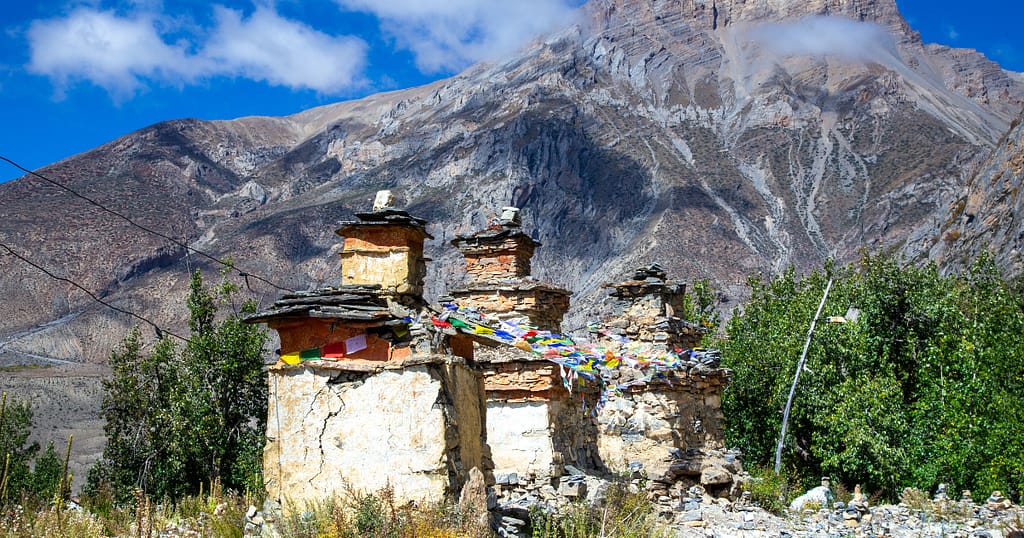
What is the Annapurna Circuit, and what makes it so special?
The Annapurna Circuit is a world-renowned trekking route that encircles the Annapurna Massif in Nepal. The trail reaches a maximum altitude of 5416m at Thorung La Pass, making it one of the highest treks in the world. This popular hike attracts trekkers from all over, drawn in by the promise of stunning mountain views, diverse landscapes, and rich Nepalese culture.
Major highlights of Annapurna Circuit Trek
- Enjoy views of Mt. Annapurna I, II, III, IV, Dhaulagiri, Machhapuchhre, and more.
- Cross the Thorong La pass (5416 m) – one of the world’s highest passes.
- Discover the oldest Buddhist monastery in the world at Manang.
- Hike through a variety of landscapes, from subtropical forests to alpine meadows.
- Visit the world-famous Hindu temple at Muktinath.
- Experience the vibrant Nepalese culture firsthand.
- Soak in the local natural hot springs.
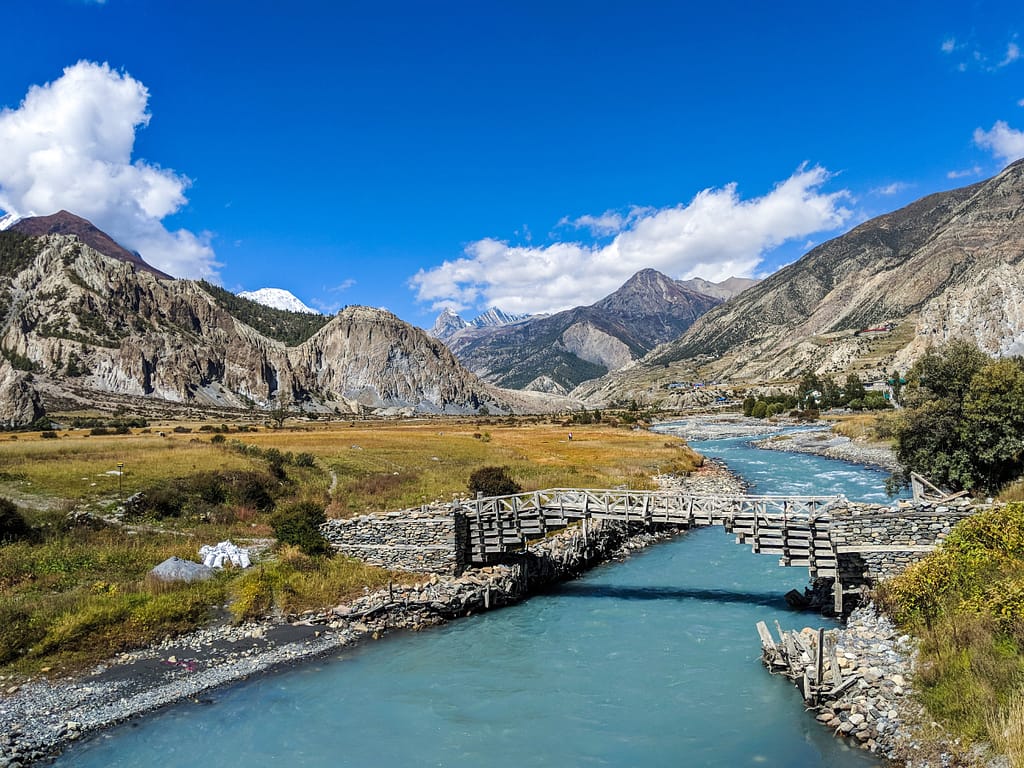
Where is the Annapurna Circuit located?
The Annapurna Circuit is a trekking route in Nepal that circles the Annapurna Massif, located in the northwestern Himalayas of Nepal. The total length of the circuit is approximately 160–230 kilometers (99-143 mi), depending on where motor transportation is used and whether the side trip is included.
The trek begins at either Bagarchhap or Besisahar, both located in Lamjung District and follows the Marshyangdi River upstream to Manang. From there, the trail crosses the Thorung La pass (at an altitude of 5416m/17,765ft) and descends into the Kali Gandaki gorge before ending at Muktinath.
Annapurna Circuit trekking elevation
The trekkers pass through four regions: Lamjung, Manang, Mustang, and Myagdi. The highest point of the entire circuit is Thorung La Pass, which sits at an elevation of 5416m (17,765ft). However, most of the trekking is done below 4000m, making it a relatively accessible hike for those with limited high-altitude experience.
The graph below shows the elevation profile of the Annapurna Circuit Trek. As you can see, the trail gradually gains altitude until it reaches Thorung La pass, which descends sharply into the Kali Gandaki gorge.

Trekking Route to Annapurna Circuit
The majority of trekkers complete the Annapurna Circuit in a counterclockwise direction. This minimizes altitude gain and reduces the incidence of altitude sickness among visitors. The trek length can vary from 12-21 days, depending on side trips like poon hill. Trekkers are now shortening the trek and completing the trek within less than 2 weeks.
Most notably, jeep tracks now connect most of the villages on the circuit, allowing visitors to bypass sections of the trail. In addition, lodging and guesthouses have become more widespread and better developed in recent years.
Detailed Trekking Itinerary
Day 1: arrive in kathmandu.
On the first day, you will arrive in Kathmandu. You will need to get a visa if you don’t have one already. You will also need to get your passport stamped. After that, you will take a taxi to your hotel.
Check into your hotel and get some rest. You will need it for the trek ahead. In the evening, you can explore the city if you like. There are plenty of restaurants and bars to choose from.
Day 2: Sightseeing in Kathmandu
Kathmandu is a vibrant and fascinating place with a rich culture that is well worth exploring. Be sure to visit some of the city’s many temples and shrines, and don’t miss Durbar Square – a UNESCO World Heritage Site.
If you need to buy any last-minute supplies for the trek, this is the time to do it. There are plenty of gear shops in Kathmandu, so you should have no trouble finding what you need.
Day 3: Drive from Kathmandu to Ngadi
The drive from Kathmandu to Ngadi takes about eight to nine hours. Ngadi village is 890 m above sea level and is the starting point for the trek.
On the way to Ngadi, you’ll pass through the towns of Besisahar and Bahundanda. Besisahar is the district headquarters of Lamjung, and is a popular starting point for the Annapurna Circuit Trek.
Bahundanda, on the other hand, is a small village located on a high ridge with sweeping views of the valley below.
Day 4: Drive to Bagarchhap, trek to Chame
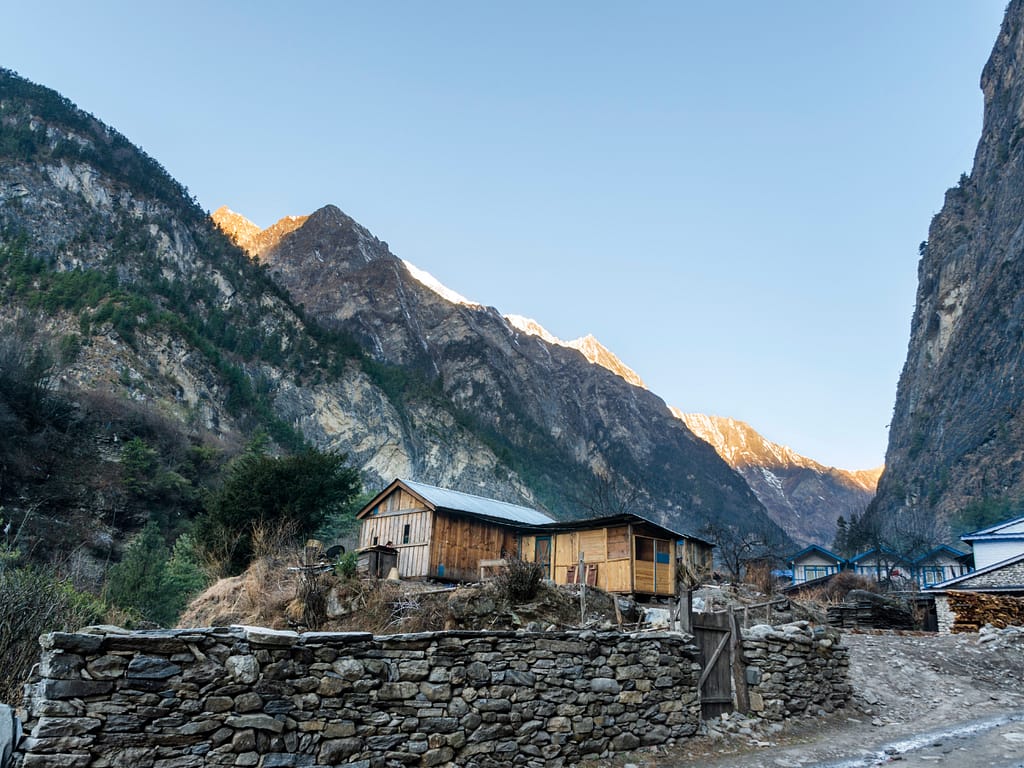
After breakfast in Ngadi, you’ll drive to Bagarchhap, which is the starting point of the trek. The drive takes about two hours.
From Bagarchhap, it’s a relatively easy five to six-hour hike to Chame(2659m). This section of the trail is well-traveled and well-marked, so you shouldn’t have any trouble finding your way.
Chame is the capital of the Manang district and is a good place to stock up on supplies for the rest of the trek. There are several guesthouses and lodges in Chame, so you should have no trouble finding a place to stay for the night.
Day 5: Trek to Manang
The hike from Chame to Manang is a relatively easy six to seven hours.
The trek begins with a journey to the idyllic village of Upper Pisang. As you make your way along the carved, copper prayer wheels, you’ll feel a sense of accomplishment. Then, make your way to the Upper Pisang Viewpoint(3,800m) for an incredible view of the surrounding mountains.
Day 6: Acclimatixation Hike to Kicho Tal and back (gangapurna)
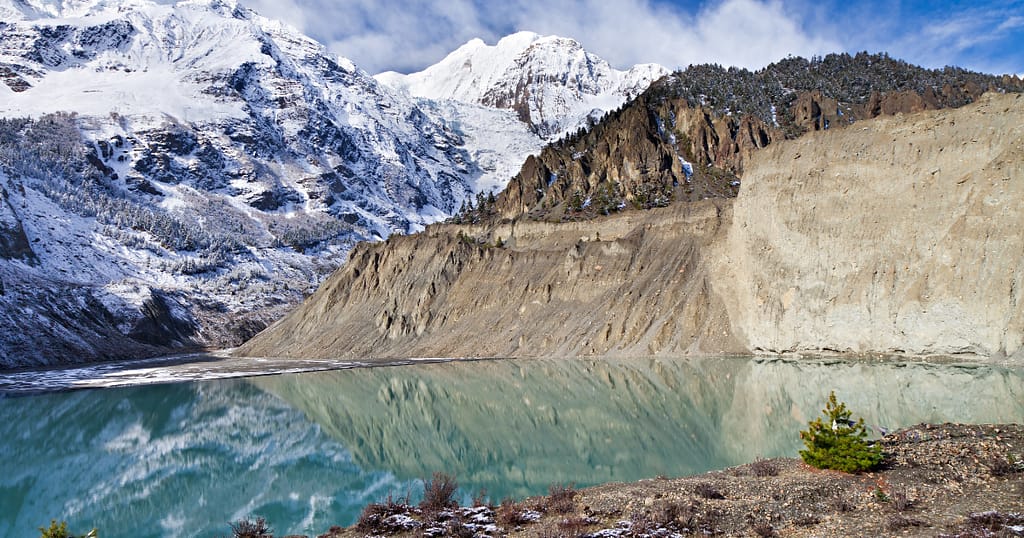
After breakfast in Manang, you’ll hike to Kicho Tal(3950m), a beautiful lake just outside town. The hike takes about three hours and is a great opportunity to acclimate to the higher altitude.
In the afternoon, you can explore Manang village. Be sure to visit the Tibetan Buddhist Gompa, one of the oldest in Nepal.
Kicho Tal is a beautiful glacial lake located in Nepal’s Annapurna Circuit Trekking region. The word ‘tal’ translates to mean ‘lake’, while ‘kicho’ refers to meaning either ‘frozen’ or ice’.
The lake is situated at an altitude of approximately 4642 meters, making it one of the highest lakes in Nepal.
Day 7: Trek to Yak Kharka
After breakfast in Manang, you’ll trek to Yak Kharka(4018m). The trail leaves the village and follows the river bank northwards before turning west and climbing a small ridge. You’ll cross a stream before descending to another riverbank and continuing on towards Yak Kharka.
As you get higher, the air gets thinner, and the vegetation changes from forest to scrub.
You’ll pass through some of the most stunning scenery in Nepal. The mountains loom large on either side of you, and the river flows swiftly below. You may even see some yaks grazing on the hillside.
When you arrive at Yak Kharka, you’ll set up camp and relax for the rest of the day. Tomorrow you’ll trek to Thorung Phedi, where you’ll begin your ascent of Thorung La pass.
Day 8: Trek to Thorung Phedi
In the morning, you’ll trek to Thorung Phedi(4450m). The trail starts off easy enough, following the river upstream. But soon enough, you’ll begin the steep ascent towards Thorung Phedi.
The last few hours of the hike are particularly strenuous, as you gain over 1000 meters in elevation. When you finally arrive at Thorung Phedi, you’ll be rewarded with stunning views of the surrounding mountains.
Thorung Phedi is a small village located at the base of Thorung La Pass. There are several guesthouses and lodges, so you should have no trouble finding a place to stay for the night. Be sure to get an early start tomorrow, as the hike over Thorung La is a long and difficult one.
Day 9: Cross Thorung La pass (5416m) and drive to Muktinath
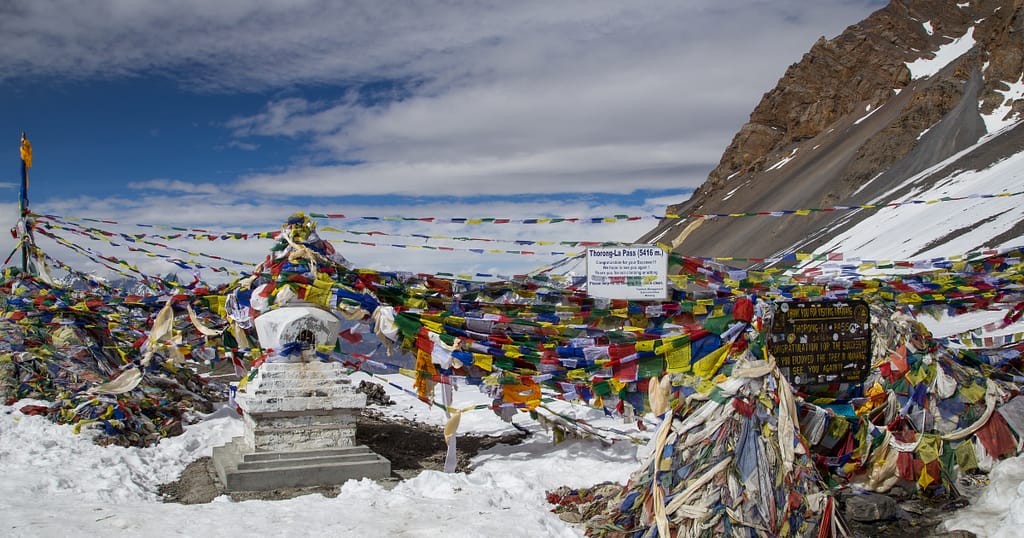
After an early breakfast, you’ll begin your ascent of Thorung La Pass (5416m).
The first part of the hike is relatively easy, as you follow a well-defined trail toward the base of the pass. But soon enough, the trail becomes steeper and more difficult. You’ll need to use your hands to scramble over rocks and pull yourself up steep inclines.
As you get higher, the air gets thinner, and it becomes more difficult to breathe. But eventually, you’ll reach the top of the pass.
From Thorung La, you’ll have incredible views of the surrounding mountains. You may even see some of the world’s highest peaks, such as Dhaulagiri and Annapurna.
After taking some time to enjoy the view, you’ll begin your descent toward Muktinath. The hike down is much easier than the hike up, and you should reach Muktinath in a few hours.
Muktinath is a holy town for both Hindus and Buddhists. There are several temples and shrines, as well as a beautiful waterfall.
Drive to Jomson
If you’re feeling a bit shaky after coming down from 1.5 kilometers, you can always take a jeep from Muktinath to Jomsom.
It’s about an hour’s drive, and the ride will give you time to rest your legs and enjoy the scenery. You’ll pass through some of Nepal’s most remote and beautiful landscapes.
Day 10: Fly back to Pokhara
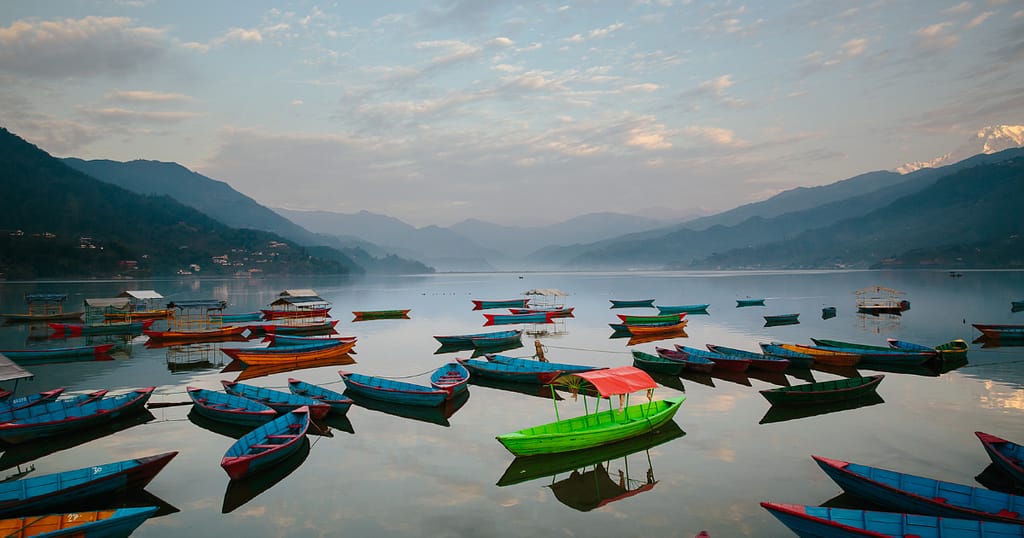
In the morning, you’ll take a short flight back to Pokhara. The flight takes about 30 minutes, and it’s a great way to see the mountains from above.
Once you’re back in Pokhara, you can relax and enjoy all these beautiful city offers. There are plenty of restaurants, cafes, and bars to choose from. You can also go shopping or take a boat ride on Phewa Lake.
Day 11: Drive back to Kathmandu
In the morning, you’ll drive back to Kathmandu. The drive takes about six hours, and it’s a great opportunity to see more of the Nepali countryside.
You’ll arrive in Kathmandu in the afternoon and spend the rest of the day exploring the city. There are plenty of sights to see and things to do in Kathmandu. You can visit some of the city’s famous temples, go shopping, or simply wander through the streets and take in the sights and sounds of this vibrant city.
Day 12:Deparature
After a wonderful trip, it’s time to say goodbye to Nepal. You’ll be transferred to the airport for your flight home.
When is the best time to go on an Annapurna Circuit trek?
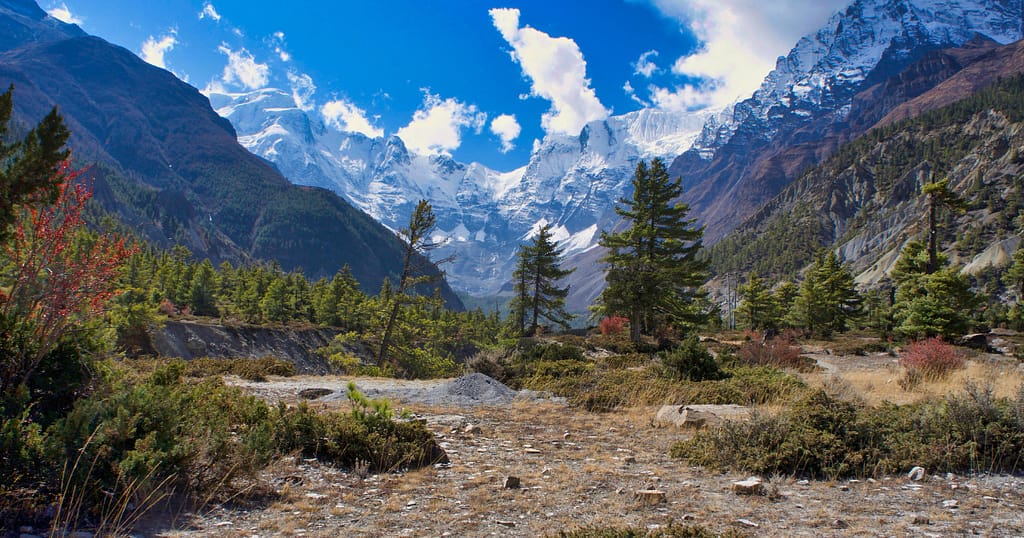
The best time to go on an Annapurna Circuit trek is from March to May, and from October to November. These are the months when the weather is most stable and the temperatures are mild. June to September is the monsoon season so the trails can be slippery and dangerous. December to February is winter, and while the views can be stunning, the cold can be extreme. So if you’re planning on trekking the Annapurna Circuit, make sure to do it during the best months!
How difficult is the Annapurna Circuit trek?
The Annapurna Circuit is considered to be one of the most difficult treks in Nepal. It takes anywhere from 12 days to 3 weeks to complete, and the highest elevation reached is 5416 meters. There are many steep climbs and descents, and the trail can be very slippery in places.
The first few days of the trek are relatively easy. You will be trekking through forested areas and will have plenty of opportunities to take breaks. As you get higher into the mountains, the trek becomes more challenging.
You will be dealing with altitude, cold temperatures, and potentially dangerous weather conditions.
Despite the challenges, the Annapurna Circuit is an amazing trek that should not be missed. The views are breathtaking, and the sense of accomplishment you will feel at the end is priceless.
How to prepare for the Annapurna Circuit trek?

If you’re planning on trekking the Annapurna Circuit, there are a few things you should do to prepare .
First, make sure you have the proper gear. This includes good hiking boots, warm clothing, rain jackets, and headlamps.
Second, start exercising and build up your stamina. The Annapurna Circuit is a long and difficult trek, so you need to make sure you’re physically prepared.
Third, familiarize yourself with the route. You can take many different routes on the Annapurna Circuit, so it’s important to know which one you’re taking and what to expect.
Fourth, get travel insurance. This is a must for any trek in Nepal.
Finally, make sure you have all the necessary permits. You will need a TIMS card, and an Annapurna Conservation Area Project permits to trek the Annapurna Circuit.
What to expect on the trek?
Trekkers on the Annapurna Circuit can expect to see some of the most stunning scenery in Nepal, including snow-capped mountains, green valleys, and terraced rice fields. The trek is relatively challenging, but the rewards are more than worth it. Trekkers will need to be prepared for long days of walking, as well as cold nights at high altitudes. But the effort is sure to pay off, with memories that will last a lifetime. So what are you waiting for? Start planning your Annapurna Circuit trek today!
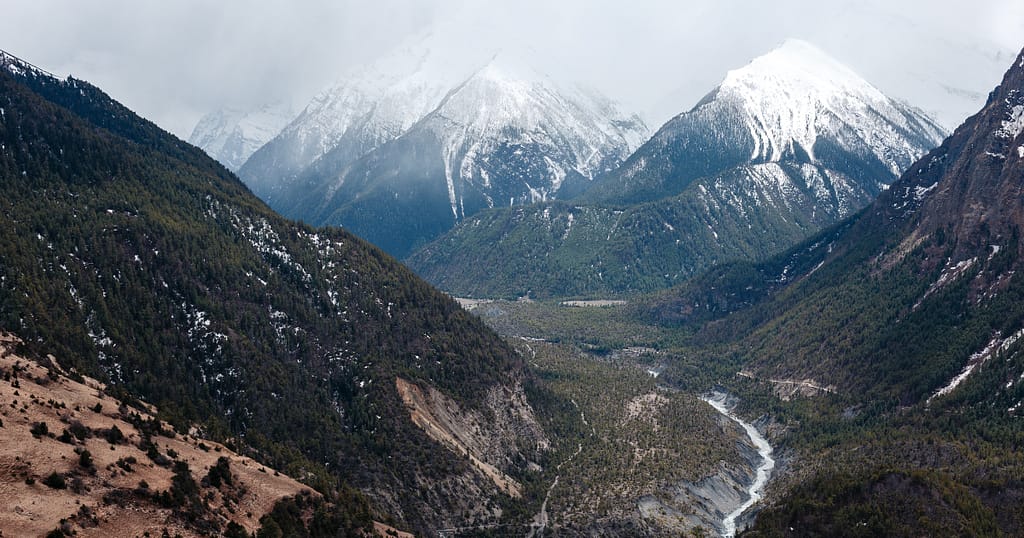
The first few days of the trek are relatively easy, as you make your way through lush green valleys and terraced rice fields. The scenery is simply stunning, and you’ll have plenty of time to stop and take photos. As you get higher, the landscape changes to one of snow-capped mountains and glaciers. The going gets tougher at this point, but the views are even more incredible. Finally, you’ll reach Thorung La pass, the highest point on the trek. From here, it’s all downhill to the finish line.
How much does it cost to do the trek?
The cost of the Annapurna Circuit trek will vary depending on a number of factors, such as the length of the trek, the time of year, and whether you hire a guide or go it alone.
In general, you can expect to pay anywhere from $1000 to $2000 for the entire trek. This includes the cost of permits, gear, food , and lodging.
Hiring a guide will add to the cost, but it is generally worth it. A good guide will be familiar with the route and can help you navigate the difficult parts.
What are the risks associated with the trek?
The Annapurna Circuit trek is considered a relatively safe trek, but any adventure has always associated risks.
The biggest risk is altitude sickness, which can occur when you are hiking at high altitudes. Symptoms include headache, nausea, and fatigue. If you start to experience these symptoms, it’s important to descend to a lower altitude as soon as possible.
Another risk is the weather. The Annapurna region is known for its volatile weather, and trekkers can face snowstorms, high winds, and even avalanches. It’s important to be prepared for these conditions and to listen to your guide’s advice on when to turn back.
Despite the risks, the Annapurna Circuit trek is an incredible adventure that should not be missed.
What gear do I need for the trek?
The first thing you need to do is get the appropriate gear for the trek. This includes clothing, footwear, and equipment. Make sure you have everything you need before setting out on the trek. The last thing you want is to be unprepared and have to turn back because you didn’t bring the right gear.Here are some of the essential items you’ll need:-
Hiking boots: A good pair of hiking boots is a must. They should be comfortable and provide good support.
Trekking poles: Trekking poles are a great help when trekking through mountainous terrain. They take some of the strain off your legs and help you keep your balance.
A backpack: A backpack is essential for carrying all your gear. Make sure it’s comfortable and has enough space for everything you need. -Clothing: Pack clothes that are appropriate for the weather conditions you’ll be trekking in. Layering is a good idea so you can add or remove layers as needed.
Equipment : Don’t forget to pack any essential equipment such as a map, compass, and first-aid kit.
This are just some of the things you’ll need for the trek. For comeplete list, check out our website or ask one of our experts.
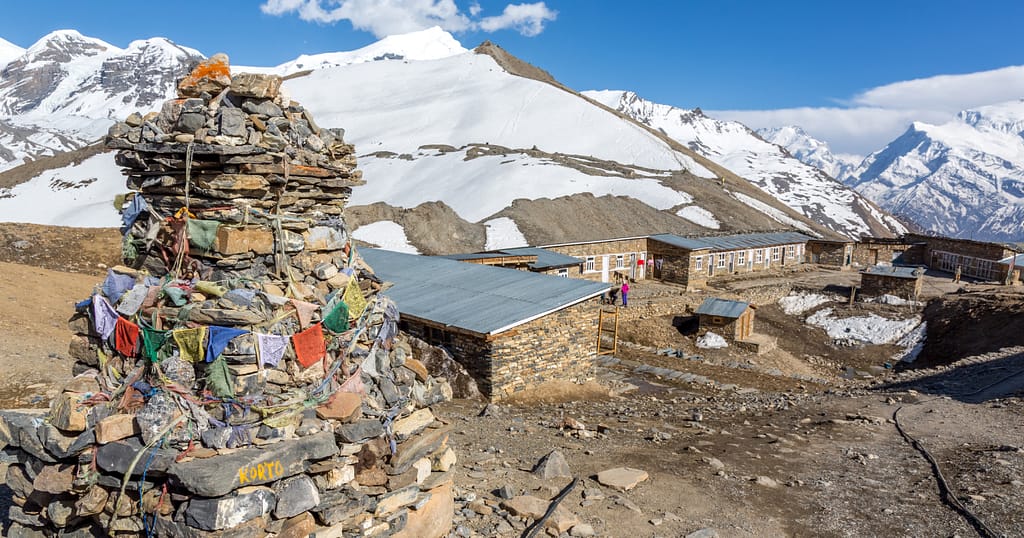
Tips for making the most out of your experience
The key to making the most out of your Annapurna Circuit trekking experience is to be prepared. Here are a few tips to help you make the most of your time on the trail:
- Start by getting in shape . The better shape you’re in, the more enjoyable the trek will be. Trekking through Nepal can be challenging, so it’s important to be physically prepared.
- Pack light, but smart . You’ll want to bring all the essentials, but don’t overdo it. Remember, you’ll be carrying everything on your back, so make sure you pack accordingly.
- Make sure you have the proper gear. This includes things like proper footwear, clothing and rain gear.
- Be prepared for the elements. Nepal can be unpredictable, so it’s important to be prepared for anything. Make sure you have a good map and know your route before setting out.
- Hire a guide . A guide can be incredibly helpful, especially if you’re not familiar with the area. They can help you find the best routes and ensure you don’t miss anything.
- Plan your route before you go. This will help you avoid getting lost and make the most efficient use of your time.
- Be flexible. Things will inevitably go wrong, so it’s important to be flexible and roll with the punches.
- Have fun! This is supposed to be an enjoyable experience, so make sure you take time to enjoy it.
By following these tips, you’ll be sure to have an amazing trekking experience on the Annapurna Circuit
Annapurna Circuit trekking solo or with a group?
Note: The Nepal Tourism Board has passed a law, effective as of April 1st, 2023, prohibiting all solo foreign trekkers from trekking in the Annapurna Region of Nepal. All solo trekkers must hire a registered guide in order to trek in the Annapurna Region.
When it comes to trekking the Annapurna Circuit, you have two options: go solo or join a group. There are pros and cons to both, so it’s important to weigh your options before making a decision.
If you’re thinking about going solo, you should keep a few things in mind. First, it’s important to be experienced and comfortable with backpacking and trekking. The Annapurna Circuit is not for beginners. Second, you’ll need to be prepared to deal with everything on your own. This includes things like navigation, planning and finding accommodation. Finally, solo trekking can be more expensive since you’ll have to pay for all your own gear and supplies.
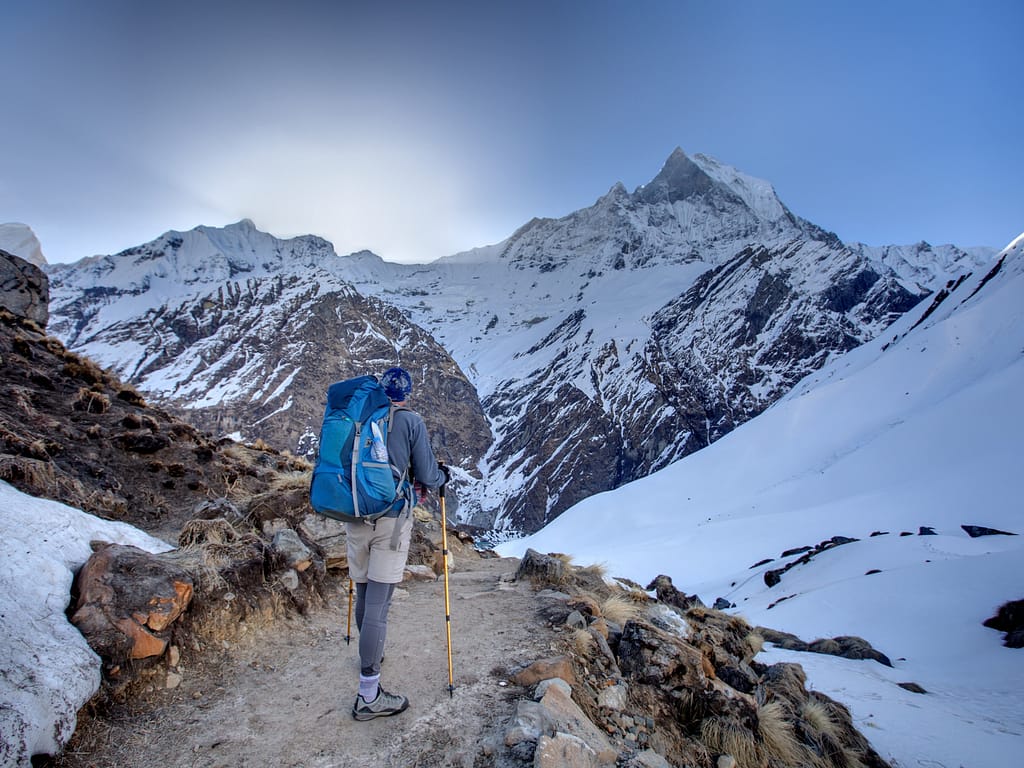
If you decide to join a group, you’ll need to find one that’s reputable and experienced. A good guide can make all the difference on the trail. You’ll also be able to share costs, which can save you money in the long run. The downside of group trekking is that you’ll need to be comfortable with other people, as you’ll be spending a lot of time together.
No matter which option you choose, make sure you’re prepared and have realistic expectations.
Is the Annapurna Circuit safe?
The Annapurna Circuit is generally safe, but there are always risks when trekking in remote areas. Make sure you’re familiar with the route and have a good map before setting out. It’s also important to be aware of the current conditions, as the weather can change quickly in Nepal.
How long does it take to trek the Annapurna Circuit?
The length of time it takes to complete the Annapurna Circuit depends on your fitness level and how many breaks you take along the way. Most people take between two and three weeks to complete the trek.
What is the best time of year to trek the Annapurna Circuit?
The best time to trek the Annapurna Circuit is between October and November. This is when the weather is typically stable and there’s less risk of rain or snow.
Is it possible to do the Annapurna Circuit without a guide?
No, it is not possible to do the Annapurna Circuit without a guide from April 1st 2023. According to the law passed by Nepal Tourism Board, all solo foreign trekkers must hire a registered guide to trek in the Annapurna region.
What insurance do I need?
When trekking the Annapurna Circuit, it’s important to have comprehensive travel insurance that covers medical expenses and evacuation. Make sure you read the fine print and understand what your policy covers before you buy it.
Do I need a permit to trek the Annapurna Circuit?
Trekkers need Annapurna Conservation Area Entry Permit (ACAP) to trek in the area, costing NPR 3000 (approx. USD 30). The permit can be obtained from Nepal Tourism Board office in Kathmandu or Pokhara or from the entry point of the trekking trail.
The Annapurna Circuit is an unforgettable trek that offers something for everyone. From the challenging hike up to Thorung La Pass to the stunning views of the Annapurnas and Dhaulagiri, this route has something for every level of hiker. Experiencing the culture and hospitality of the Nepali people along the way makes this a trip you will never forget.
Trekking the Annapurna Circuit is an amazing experience, but there are always risks involved so it’s important to stay informed and take precautions.
Have you done the Annapurna Circuit? What was your favorite part?
Being a travel and trekking guide for over a decade, I decided to expand my passion for a travel to be a tour organizer and build my team of travel experts. What's best about my passion is that I get to spend a considerable amount of time every single day with the legendary climbers and mountain lovers from all around the worlds. There's no greater achievement for me than having a set of regular friends around who always have stories of their great feat or their special encounters with the locals in the mountains to share.
Related Posts
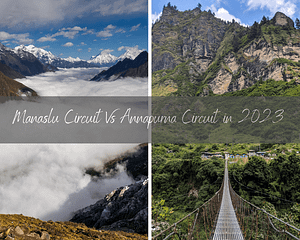
Manaslu Circuit vs Annapurna Circuit-Which Trek is Right For you in 2023
- January 22, 2023

Annapurna Circuit Trek Cost: A Detailed Breakdown
- December 19, 2022
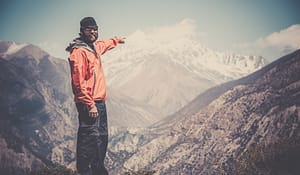
Annapurna Circuit Trek Without a Guide: Is a Solo Trek Possible?
- December 11, 2022
Leave a Reply Cancel Reply
Your email address will not be published. Required fields are marked *
Name *
Email *
Add Comment
Save my name, email, and website in this browser for the next time I comment.

Destinations
Trekking type, annapurna circuit trek: how to hike around the annapurnas, by jan bakker.
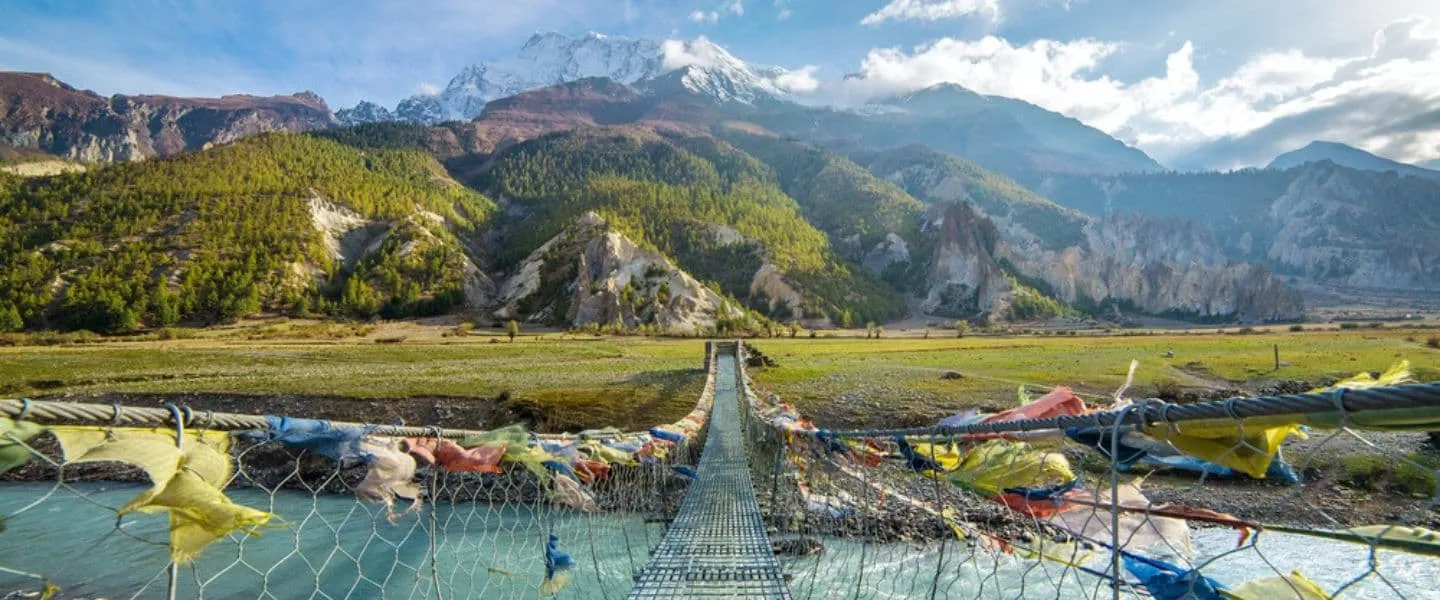
The Annapurna Circuit Trek is the most famous trekking circuit in Nepal. With some of the tallest mountains on Earth, tumbling glaciers and an incredible variety of landscapes, this trek represents everything what trekking in Nepal is about. It takes more than two weeks to circumnavigate the Annapurna Massif while staying in cozy tea houses. Over the last few years, we at Bookatrekking.com have helped hundreds of people to find their way in the Nepali Himalayas and now it's your turn.
My name is Jan and I’ve been lucky enough to hike some of the most spectacular trekking routes in Asia, including the K2 Base Camp trek in Pakistan and the Pamir Trail in Central Asia. In terms of mountain landscapes the Annapurna Circuit remains high up there as one of my favorites. Why is this classic trek so special? Let us tell you why!
Annapurna Circuit Trekking: The Ultimate Trek in Nepal
How difficult is the annapurna circuit trek, the best time to hike annapurna circuit, the dynamics of the annapurna circuit route, annapurna circuit itinerary, how to cross the thorung la, annapurna circuit map, what permits do i need for the annapurna circuit trek, staying in tea houses on the annapurna circuit, how to identify and prevent ams on the annapurna circuit trek, packing list for the annapurna circuit trek, where can i book the annapurna circuit trek.
Let me first tell you a little bit about my own experience. Over the past 20 years I have worked in the mountain tourism industry in various roles. I have written trekking guide books for Tajikistan and Tunisia, I train local hiking guides in Uganda and as a trekking guide I have led groups in the Indian Himalayas, the Karakoram Range in Pakistan, the Pamir mountains in Tajikistan and the Annapurna Circuit in Nepal. First-hand experience is invaluable and for you, as a trekking enthusiast, it’s essential to get advice from someone who has actually done it!
Jan on top of the Thorung La

Annapurna Circuit Trek Accelerated
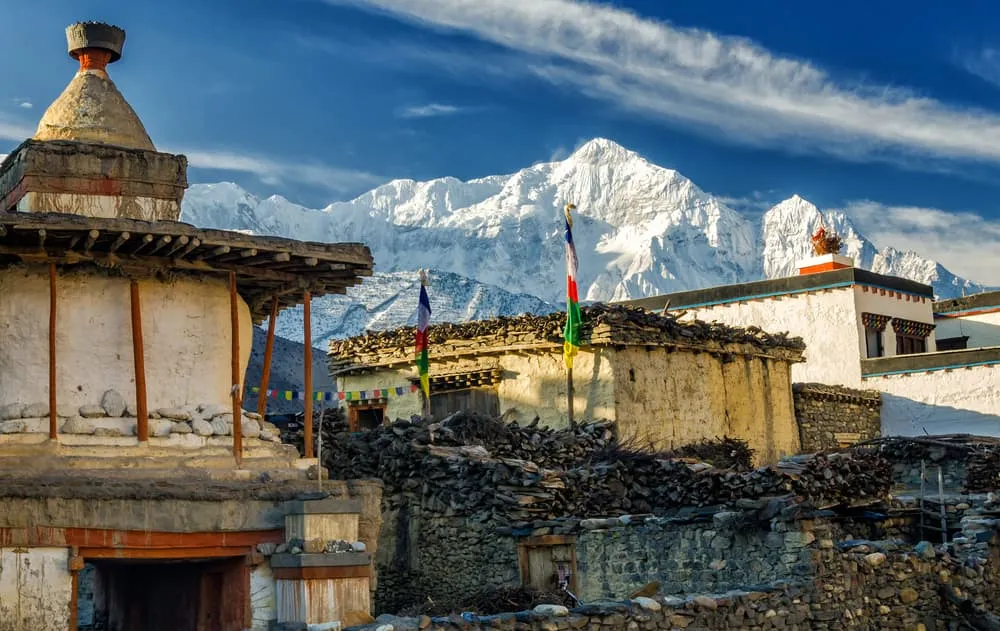
Annapurna Circuit Short
In the late 1970’s, when people started venturing into the Nepali Himalayas, the Annapurna Circuit was one of the first trekking routes to open for foreigners. In those days it took 23 days to hike around the Annapurna Massif. Fast forward to the present day, lots has changed. We’ll talk later about how trekking routes have changed in the past two decades, but one thing is for sure. The mountains of the Annapurna Massif are as stunning as they were 50 years ago.
The Annapurnas are close to Pokhara, about 6 hours west of Nepal’s capital Kathmandu. The small city, located on the shores of the stunning Phewa Lake, is the gateway to the Annapurna Massif. The Annapurna Circuit itself is a tea house trek, which means you stay in local guesthouses on the entire route. From the forested valleys at an elevation of 900 meters you’ll ascend to the Thorung La, the highest point of the trek at a whopping 5416 meter above sea level. The landscape gradually changes as you climb higher up the valley. Each day the giants of the Annapurna Massif reveal themselves a little bit more and your surroundings transform into a rugged alpine environment. The villages counter balance the mountains’ wild character. The tea houses are cozy and warm and you’ll be served endless cups of tea.
After scaling the Thorung La the route drops down into Lower Mustang, a high altitude desert with a completely different landscape. After the town of Jomsom the route continues to the hot springs of Tatopani, where you can soak and relax with fellow trekkers and locals alike. The final highlight of Annapurna Circuit is the climb up Poon Hill from Ghorepani. This is one of the most majestic viewpoints in Nepal, looking out over the entire Annapurna chain and spectacular mountains like Machapuchare and the 8167m high Dhaulagiri.
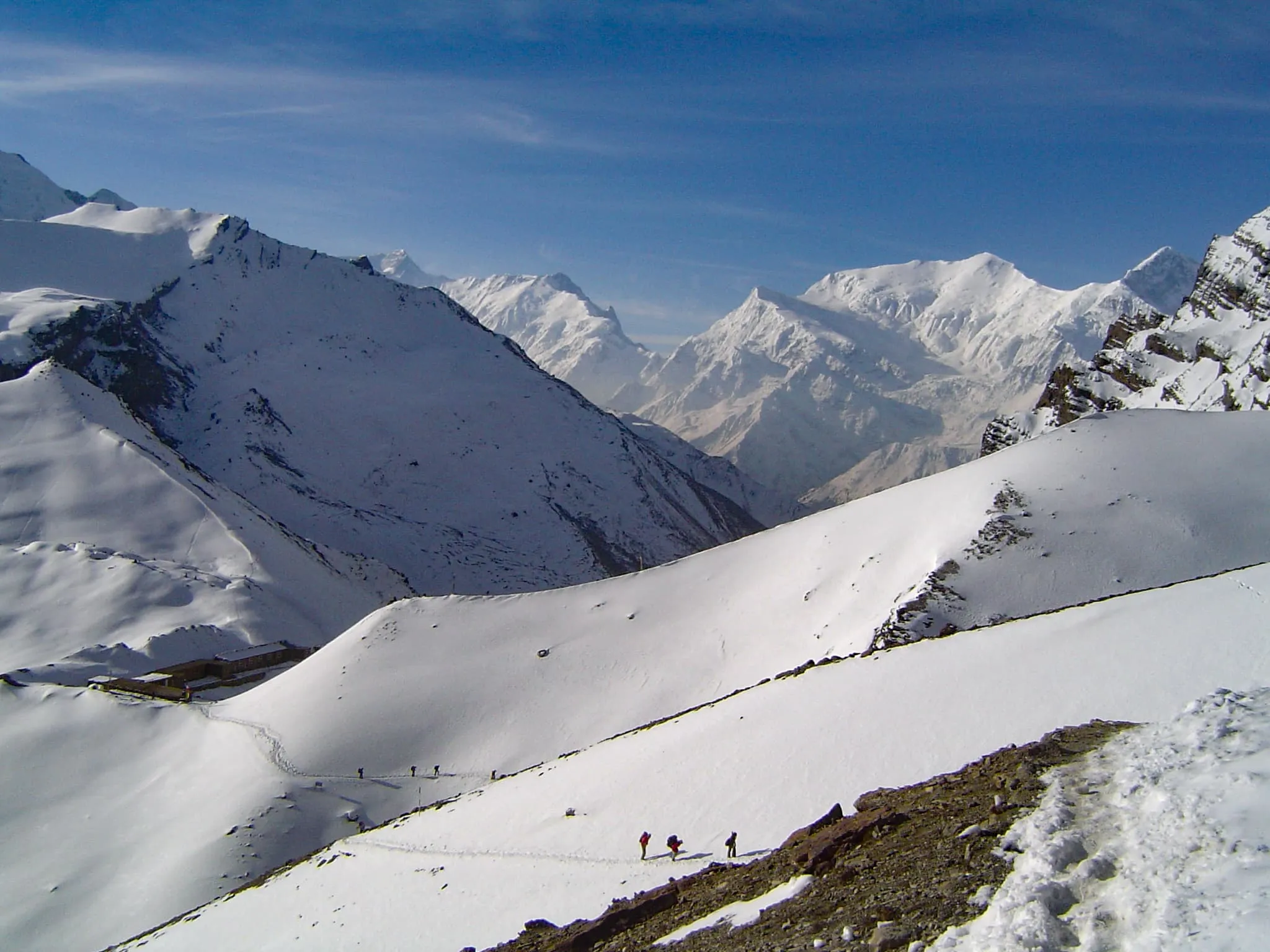
The Annapurna Circuit difficulty is quite low from a technical perspective. It's only walking and I found the path in good condition in most places. It also helps that you stay in a guesthouse each night rather than a tent. You can get a proper rest without having to worry about logistics or getting cold. It really is the Annapurna Circuit altitude that makes the going tough sometimes. After all, it is a trek at high altitude, culminating to an elevation of 5416 meters on the Thorung La. In my experience, the Annapurna Circuit length also adds to the strenuous nature of the trek. The shortest version we offer involves 170 kilometers of trekking. On some days the distances are more than 20 kilometers. Those factors make the trek hard, whether you’re a novice or a seasoned hiker. You feel your body getting tired after a prolonged time on the trail. But maybe because of that, it feels like a true sense of achievement finishing the route from start to end. I am convinced when you do some training for the Annapurna Circuit and set off with the right mindset it is doable for most trekkers.
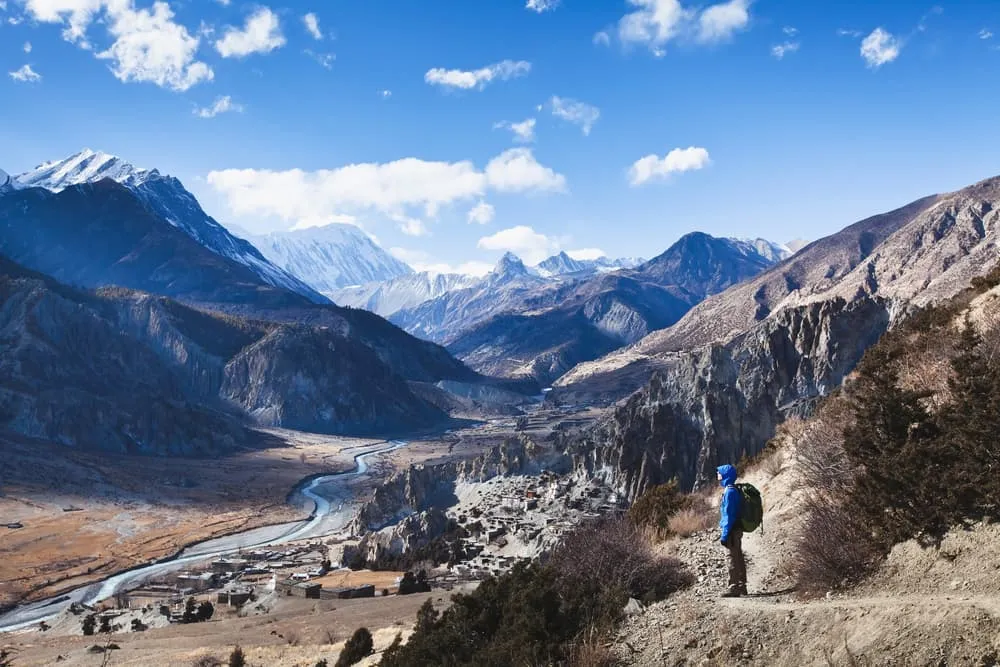
The Annapurna Region, along with most of the other trekking areas in Nepal, has four distinct seasons. Spring, summer, autumn and winter. The months from March to May, pre-monsoon, and from October to early December, post-monsoon, are the most popular for hiking the Annapurna Circuit. Every season offers its own excitement and atmosphere and in principle, you can go trekking year-round. There are good reasons why spring and autumn are considered the trekking season. Below we’ll give you a run-down of what each of the seasons are like.
Spring (March-May) is the high season and trekkers from around the globe come to the Annapurna Region in large numbers. In springtime, the temperature is pleasant, the precipitation is low and the hiking conditions are great. On the trail there’s a lot of excitement and anticipation to cross one of the highest mountain passes in the world for trekking, the Thorung La. It does get busy, but therefore it’s a great time to connect with like-minded adventurers. While temperatures in daytime along the trek are balmy, the temperature around the Thorung La can be very cold in the early morning, when you cross the pass. Check our complete Annapurna Circuit packing list further below in this blog post.
Summer season falls in the months of June, July and August. Summer is the month with higher temperatures and in that sense it is quite pleasant. However, this is also the monsoon season, and it rains a lot. The chance of seeing the mountains around you is smaller as it is cloudy most of the time. The trail will be wet and slippery and there is an increased risk of landslides. And leeches are very active during these months. On the flipside, it’s not very busy on the route and the traditional villages feel more serene.
Autumn in the Annapurna Region (September, October, November) is, like springtime, prime trekking season with similar trekking conditions. There is one difference. The air in spring is sometimes a little hazy due to the dust in the atmosphere. Post-monsoon the air is very clear, allowing for stunning views of the mountains.
Winter season runs from December to February. This period is the toughest time to trek on the Annapurna Circuit. With the Thorung La elevation exceeding the 5000 meters mark, it gets extremely cold. Night temperatures drop to -20 degrees Celsius. Add wind and snowfall and you’ve got yourself a proper winter expedition. Why do we still run the Annapurna Circuit trek in winter? We work with some of the best trekking companies in Nepal. Besides trekking trips they also organize climbing expeditions to some of the highest peaks in the Himalayas. Our partners can keep you safe and comfortable, even in these cold conditions. And you will probably have the entire trail to yourself!
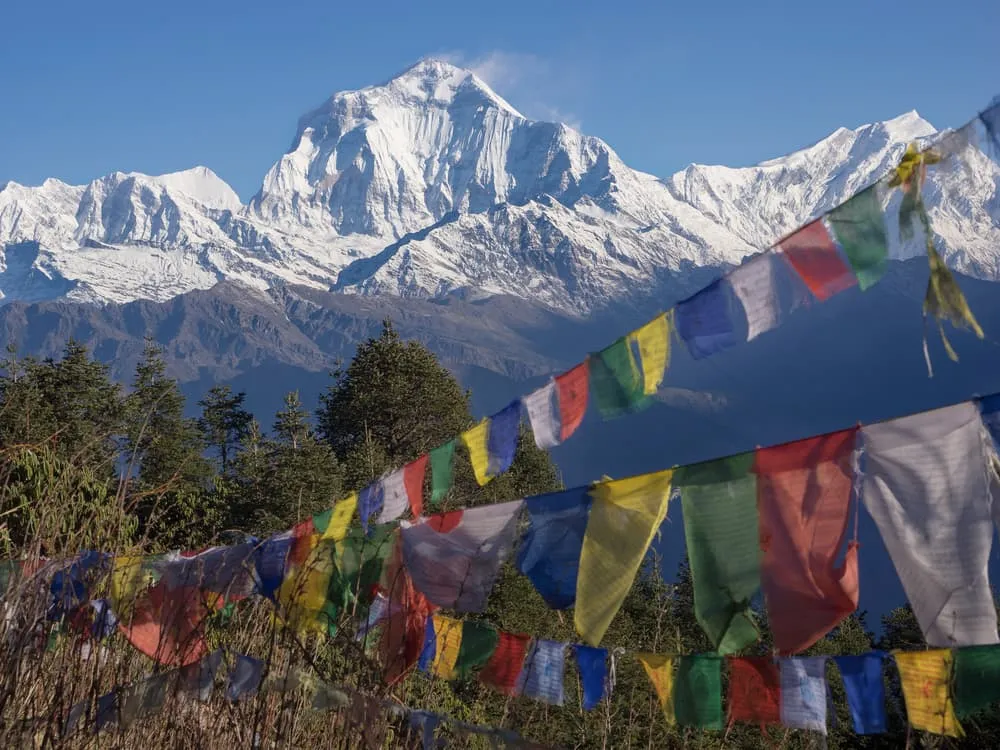
During the last 20 years a lot has changed in the Annapurna Region. In the name of progress, the lower parts of the Marshyangdi Valley have been made more accessible by building. Originally, the Annapurna Circuit route always started in Besisahar. Nowadays some tour operators opt for a start deeper into the valley as a dirt road has been built all the way to the mountain village of Manang. Bhulbhule is our choice to start the trek. From here you can avoid the road and hike on walking paths rather than the road. The biggest change however is the road development on the western side of the route. In recent years, a road has been constructed from Pokhara to Jomsom and extended even to the village of Muktinath. Some parts of the road are tarmac, some are gravel. Regardless, it has had a big impact on the original Annapurna Circuit itinerary. Especially between Jomsom and Tatopani most tour operators cover this section by car, as the alternative would be walking on a relatively busy road. From Tatopani trekkers can follow the original route again towards Ghorepani, Poon Hill and beyond. Having said all this, the Annapurna Circuit remains one of the most spectacular treks in Nepal, simply because the actual landscape and culture hasn’t changed much.
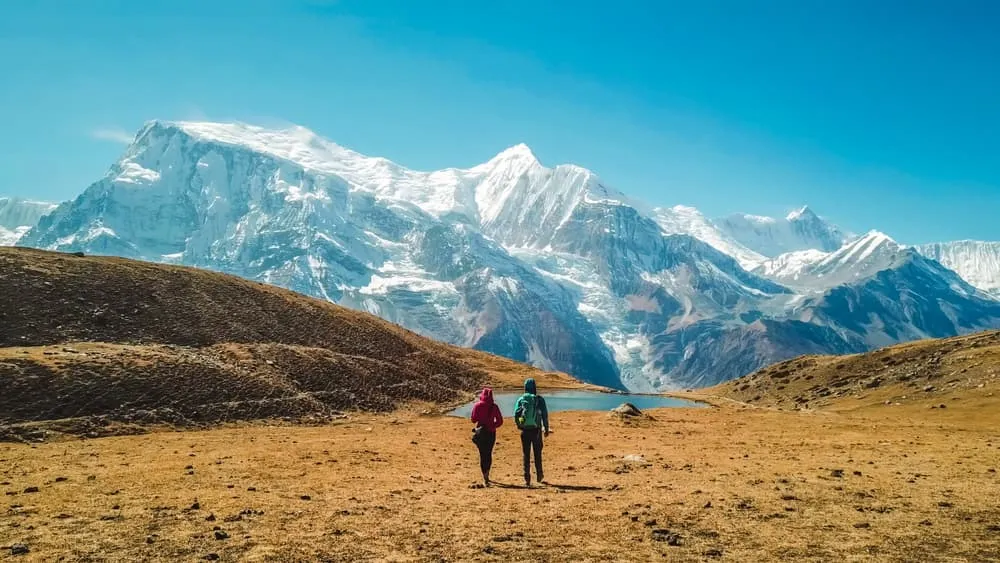
Not sure yet or want to discuss your plans for the Annapurna Circuit Trek with one of our trekking experts? Get in touch today and turn your dreams into memories!
It is best to do the circuit in 15 or 18 days. The 18-day version is old school and only follows the oldest trails. However, more and more people are choosing to do the 15-day version. If you choose the 15-day trek, you are sure to have a short break halfway and can enjoy all the attractions that the Annapurna Circuit has to offer.
Drive to Bhulbhule

Trek to Chamje
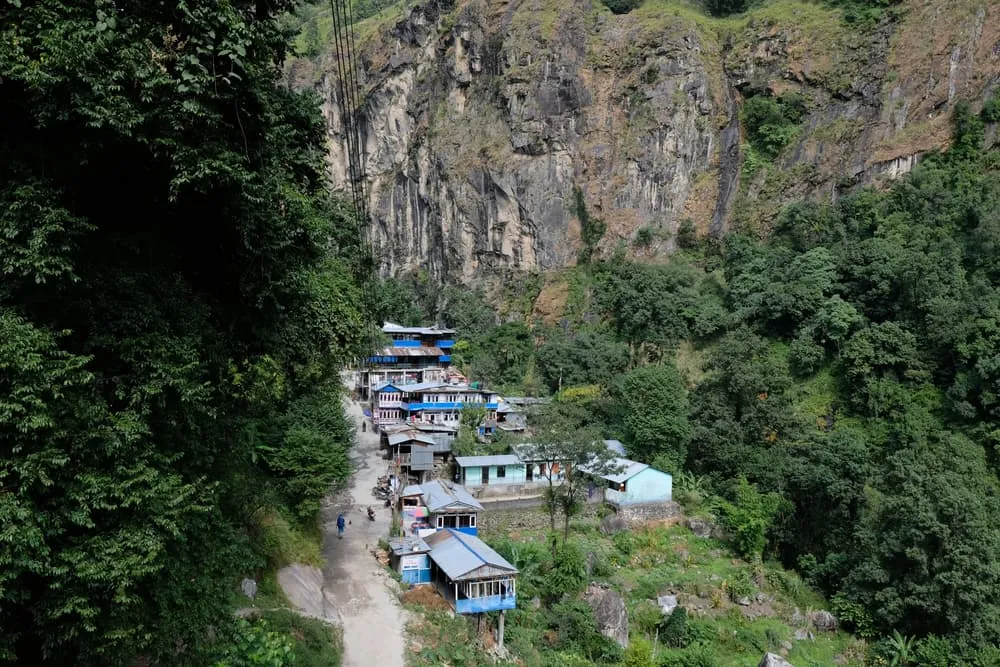
Trek to Bagarchhap
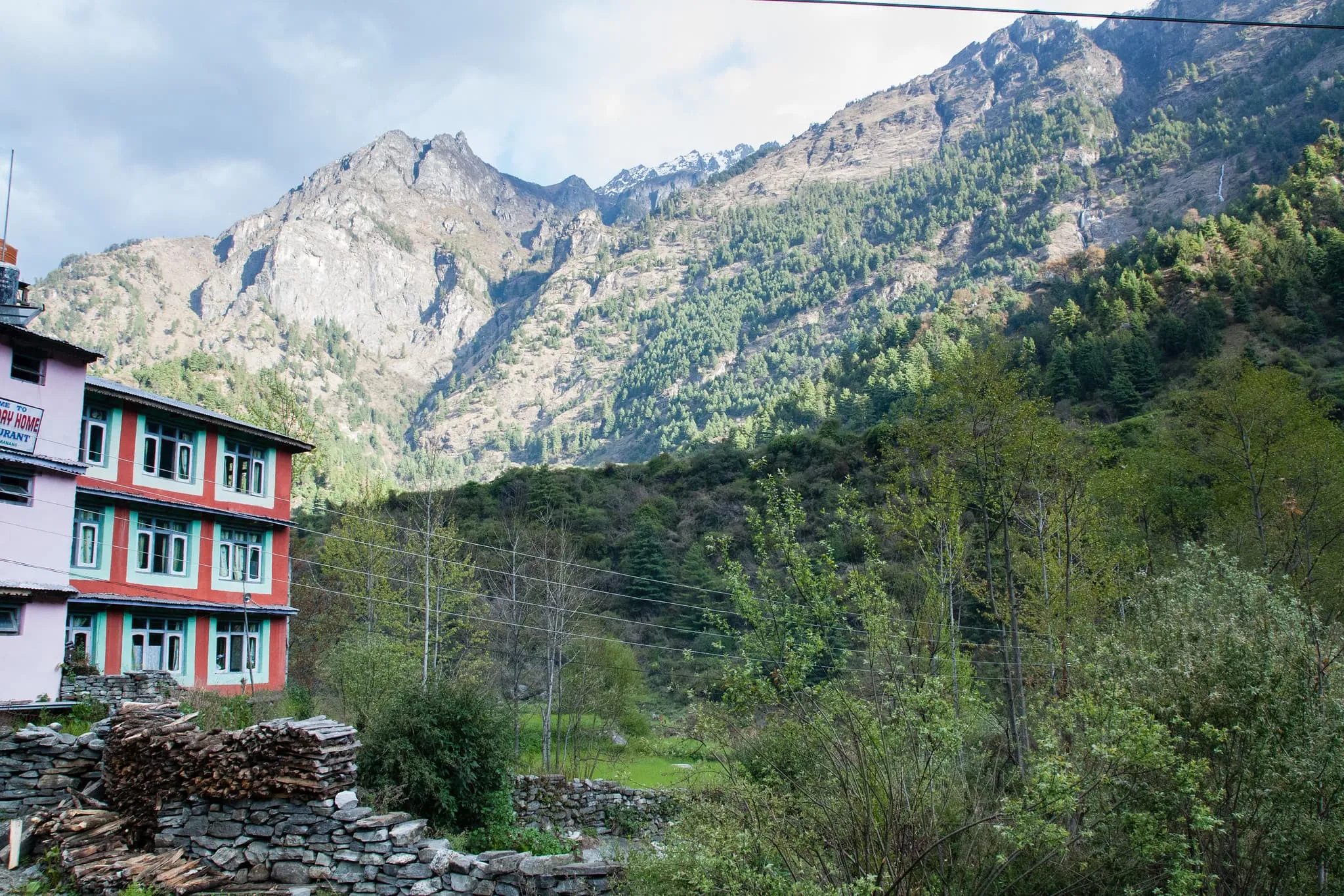
Trek to Chame
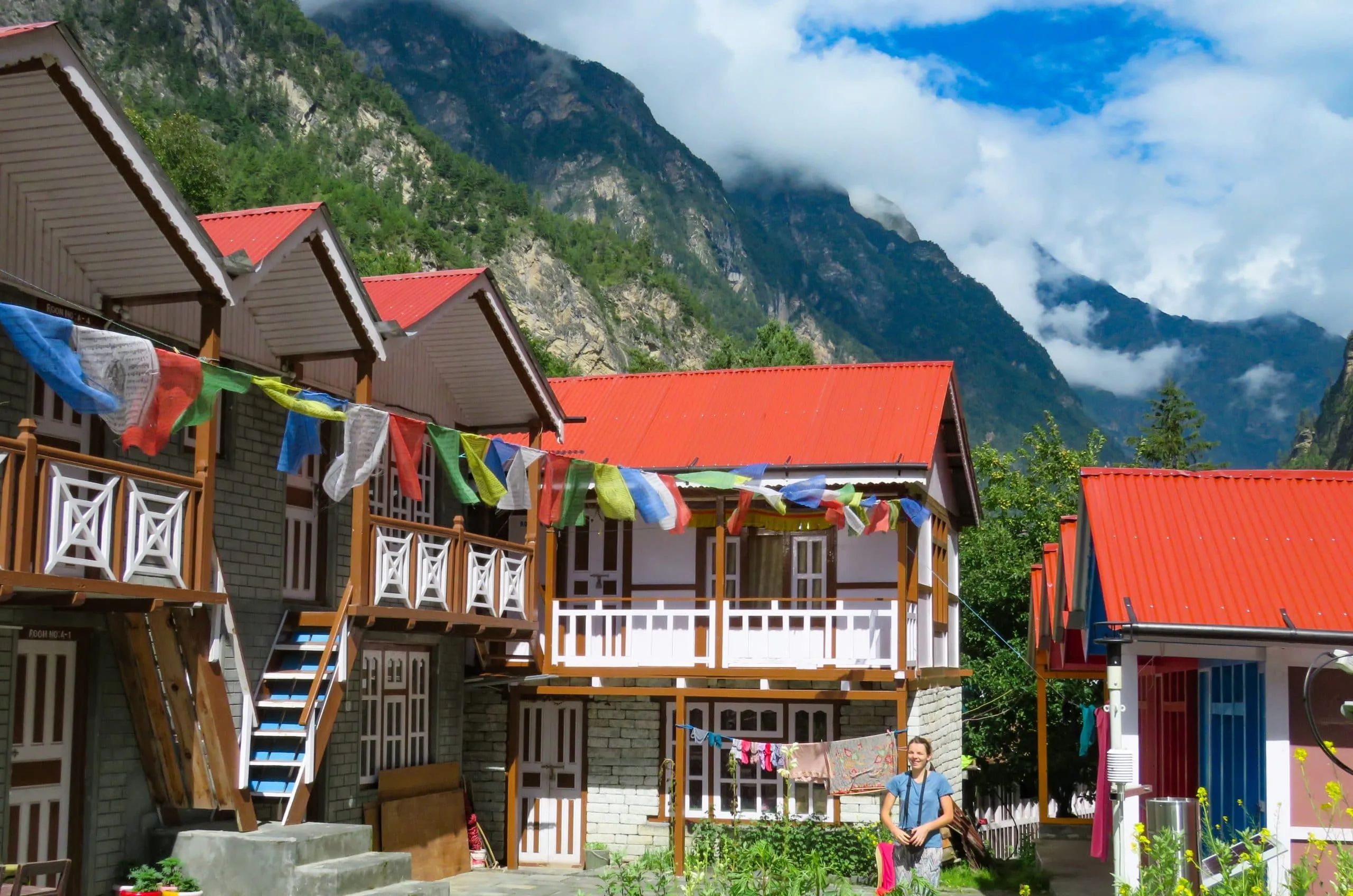
Trek to Pisang
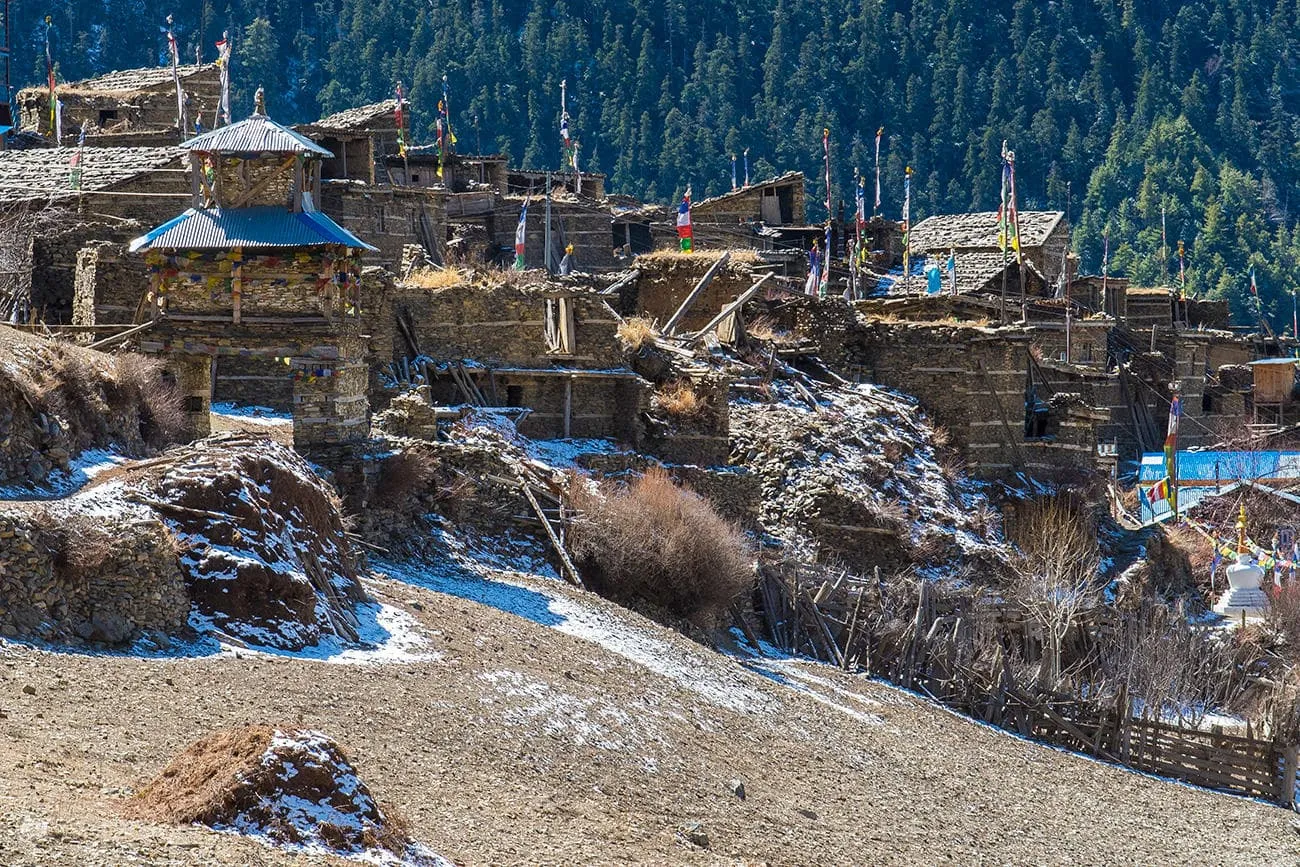
Trek to Manang
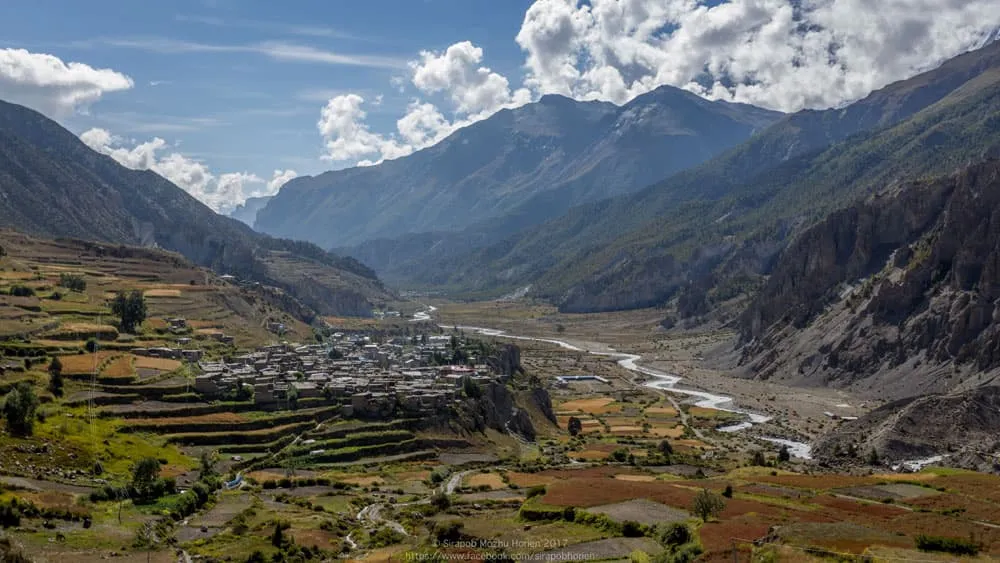
Acclimatisation in Manang
Trek to yak kharka.

Trek to Thorung Pedi
Thorung phedi.
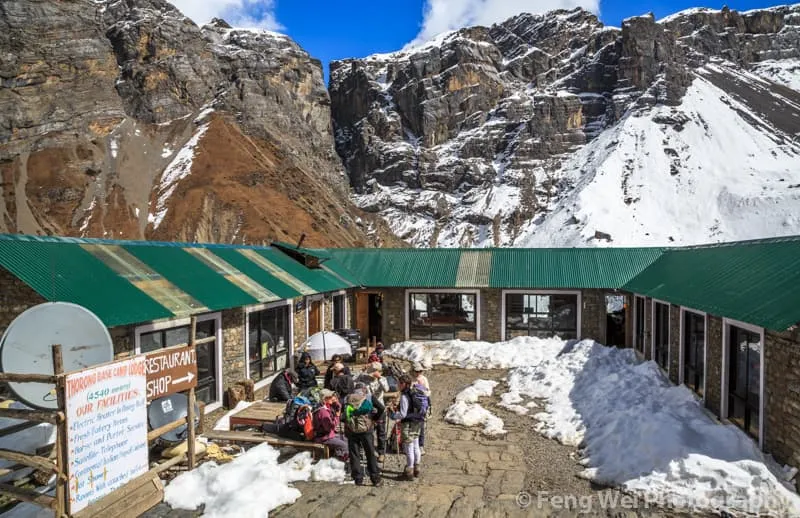
Trek to Muktinath via Thorung La Pass

Trek to Jomsom
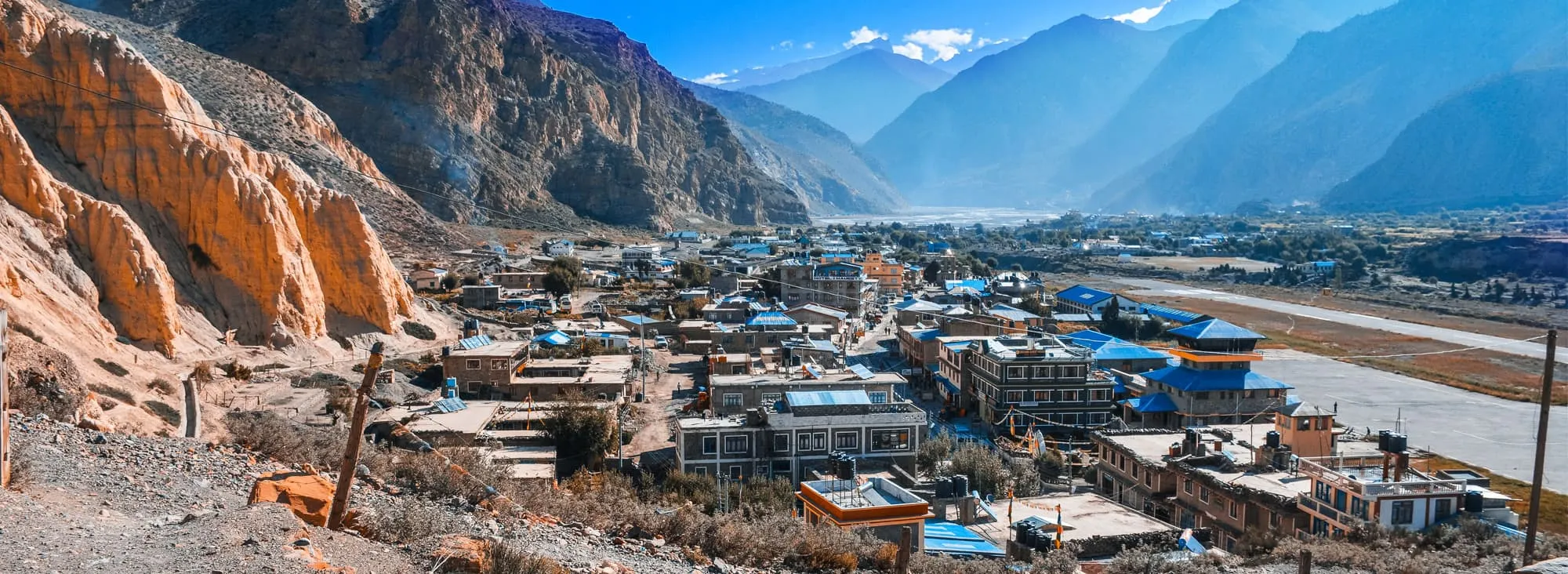
Drive to Tatopani
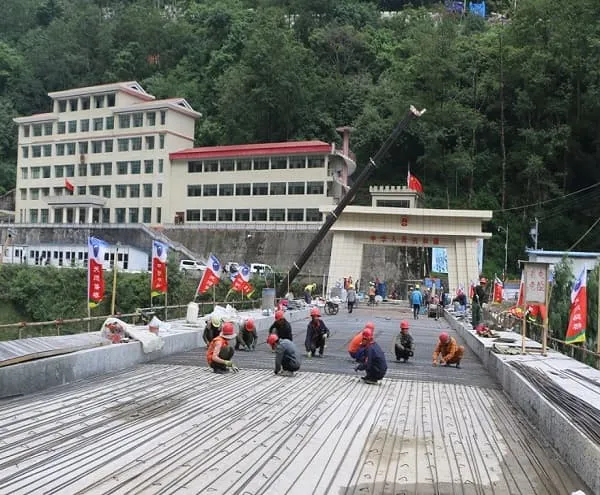
Trek to Ghorepani

Ghorepani – Poonhill – Nayapul
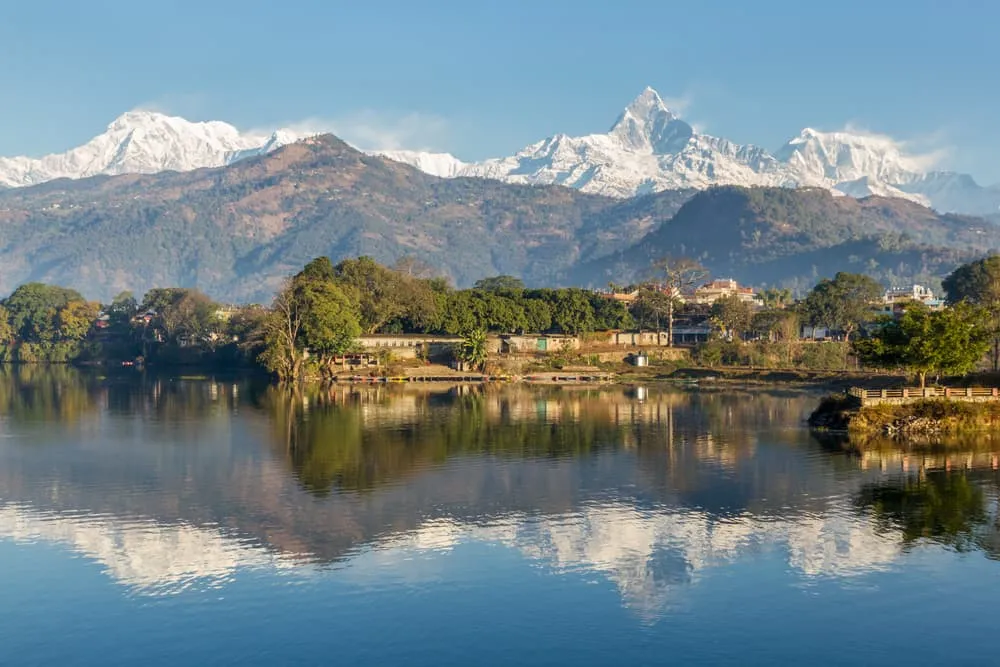
Drive from Pokhara to Kathmandu
The Thorung La is no doubt the crux of the trek. Here, the Annapurna Circuit elevation reaches its absolute max at 5416 meters above sea level. It is an old trading route and connects with Tibet. The altitude of this mountain pass is higher than any mountain in the European Alps including Mont Blanc. In height it is comparable to a big mountain like Mount Elbrus in the Russian Caucasus. Do you need to acclimatize to avoid altitude sickness ? For sure! Do you need special skills to cross the Thorung La? The answer is no. You just need to be fit!
It is a bit like scaling a mountain, but you are walking up rather than climbing. The day starts very early and you basically hit the trail before sunrise. The guides are doing the pacing to make sure you don’t head up too quickly. The path itself is not that steep, but you will feel the thin air at this altitude. From around 5000 meters we were walking on snow, with a good track carved out by the people who had gone before us. The snow really adds to the adventurous feeling of scaling a mountain pass this high. Looking back you can see all the big peaks of the Annapurnas as if you are at the same level with them. Perhaps my most magical moment on the entire trek was just before sunrise while going up the Thorung La. Alpenglow lit all the Annapurna peaks bright pink, with a steel blue sky as a background.
Reaching the Thorung La pass was an incredible, rewarding experience. As a guide I was very proud that each group member made it to the top, although it wasn’t easy. And there was still 1600 vertical meters of descent to go to the village of Muktinath. Despite that, I believe that everybody with willpower, stamina and a sense of adventure can do it.

For trekking on the Annapurna Circuit, you need the following permits:
TIMS (Trekkers Information Management System):
Annapurna Conservation Area Project (ACAP) Permit
An ACAP Permit is obligatory for individuals who wish to explore the trekking routes within the Annapurna region. It is overseen by the National Trust for Nature with the primary goal of safeguarding and preserving the region's wildlife and natural environment. The funds gathered through this permit are dedicated to conservation efforts.
For each individual embarking on a single-entry trek, the cost of an ACAP Permit is Rs. 3000 (roughly USD25), regardless of the duration of the stay. These permits can be acquired in either Kathmandu or Pokhara, and there are designated checkpoints along the trail to maintain your trekking records.
Tea houses are small hotels known as Bhatti. These are small hotels and you can expect a certain level of comfort. However comfort in this high, remote region is relative. Tea houses are comfortable to the extent that you have a roof above your head and that you can enjoy warm, home-cooked meals. They are run by local families who have opened their houses to trekkers passing by.
Trekking in Nepal has become very popular in recent years, and more and more tea houses have popped up along Nepal’s trekking routes. The more popular your route, the better the quality of your tea house is. Hence, the tea houses on the Annapurna Circuit Trek are good value for money. You can expect flush toilets, hot showers and in some cases even wireless internet. The use of these amenities is usually at an additional charge.
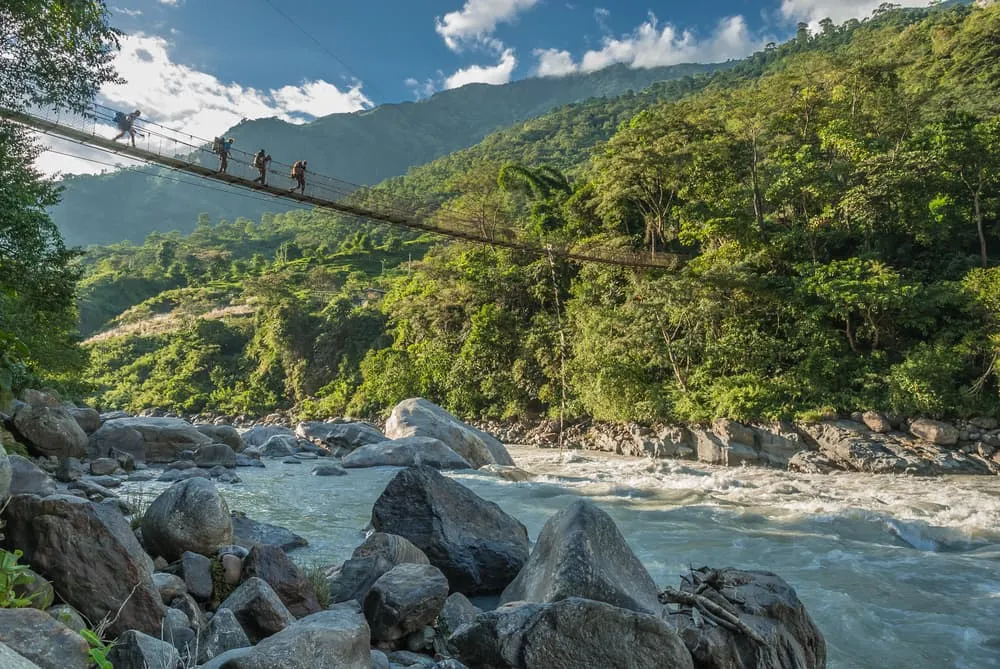
It's essential to understand that altitude sickness can affect anyone, regardless of age, fitness level, or previous high-altitude experience. These days there are several tools to monitor your health at altitude. A widely-used (analog) method is the Lake Louise score card. It ticks the altitude symptoms while keeping the severity in mind. It’s a common tool used by guides. Nowadays, most trekking and mountain guides bring a blood oxygen saturation meter, which also measures the heart rate. These are key indicators whether a person adapts to altitude well or not. AMS can occur when trekking the Annapurna Circuit Trek. Below you can find everything you need to know about altitude sickness.
Acute Mountain Sickness (AMS)
Altitude sickness, also known as Acute Mountain Sickness (AMS) is a health condition that occurs when someone is exposed to low levels of oxygen at higher altitudes. AMS is a serious condition and as the name suggests acute. It needs to be dealt with immediately, as it is potentially life-threatening. Most people will experience some mild symptoms of altitude sickness. It’s important to be aware of these symptoms and act before symptoms become more severe. Below we break down the different forms of AMS and how you can reduce the risk of getting it.
AMS symptoms
It is key to know how to identify altitude illness. You may experience the following symptoms due to the jump in altitude: headache, lack of appetite, breathing difficulties, insomnia, nausea and vomiting. The intensity and severity of these symptoms may increase with altitude and an overall feeling of fatigue will take all your joy away. This may further deteriorate to one of these life-threatening conditions.
High Altitude Pulmonary Edema (HAPE) : HAPE is a condition in which fluid accumulates in the lungs, making it difficult to breathe. Symptoms may include shortness of breath, a persistent cough, chest tightness, and an increased heart rate. It can be a life-threatening condition and requires immediate descent to lower altitudes and, in severe cases, medical treatment.
High Altitude Cerebral Edema (HACE) : HACE is a more serious condition in which fluid accumulates in the brain. Symptoms may include severe headaches, confusion, loss of coordination, and altered mental status. HACE is also a medical emergency and requires immediate descent and medical attention. Below 7 ways of minimizing the risk of AMS:
1. Gradual Ascent
One of the most effective ways to prevent AMS is to ascend gradually. When traveling to high altitudes, try to take several days to acclimatize before going higher. This allows your body to adapt to the reduced oxygen levels. All our treks in Nepal keep sufficient acclimatization into account.
2. Stay Hydrated
Dehydration can increase the risk of AMS, so drink plenty of fluids. Avoid excessive alcohol and caffeine consumption, as they can contribute to dehydration.
Consume a balanced diet with adequate carbohydrates and avoid heavy, fatty meals. Carbohydrates can help your body utilize oxygen more efficiently at high altitudes.
4. Medication
Some individuals may consider taking medication, such as acetazolamide (Diamox), to help prevent AMS. Consult with a healthcare professional before using any medication, and be aware of potential side effects.
Ensure you get enough sleep and rest during your ascent. Fatigue can increase the risk of AMS.
6. Avoid Overexertion
Pace yourself and avoid overexertion. Listen to your body, and if you experience symptoms of AMS, rest or descend to a lower altitude.
7. Descend if Symptoms Persist
If you experience symptoms of AMS, such as headache, nausea, dizziness, or difficulty breathing, it's crucial to descend to a lower altitude. Symptoms should not be ignored or dismissed.
Trekking in Nepal requires good quality and appropriate equipment. Especially the essentials like a good pair of hiking boots and breathable hardshell rain jacket. We highly recommend that you read our suggested packing list to hike the Annapurna Circuit Trek.
Technical Clothing
Accessories.
At Bookatrekking.com you can book this trek and many others. Our guided options come with experts on the ground, and offer you a convenient, stress-free, safe, and educational way to explore the outdoors. Find our offers here . Our easy-to-use platform allows you to browse and compare different trekking options and find the perfect fit for your interests, abilities, and budget.
If you have any questions about a specific trek or need help choosing the right one for you, our team of trekking experts is here to assist you. Simply reach out to us and we will be happy to provide you with personalized recommendations and advice to help you plan the trekking adventure of a lifetime.
Is this not your cup of tea and are you looking for other epic adventures? Check out one of our blog posts:
Summit climbs
- Climbing Kilimanjaro
- Climbing Triglav
- Climbing Island Peak in Nepal
- Climbing Mount Kenya
- Climbing Mount Elbrus
- Climbing Mount Kinabalu
- Climbing Toubkal
- Climbing Rinjani
- Everest Base Camp Trek
- Annapurna Circuit Trek
- Nepal Travel Guide
- Salkantay Trek
- Peru Travel Guide
Kilimanjaro
- Machame Route
- Lemosho Route
- Kili Travel Guide
Self-guided treks
- Tour du Mont Blanc
- West Highland Way
- Camino de Santiago

Also Interesting
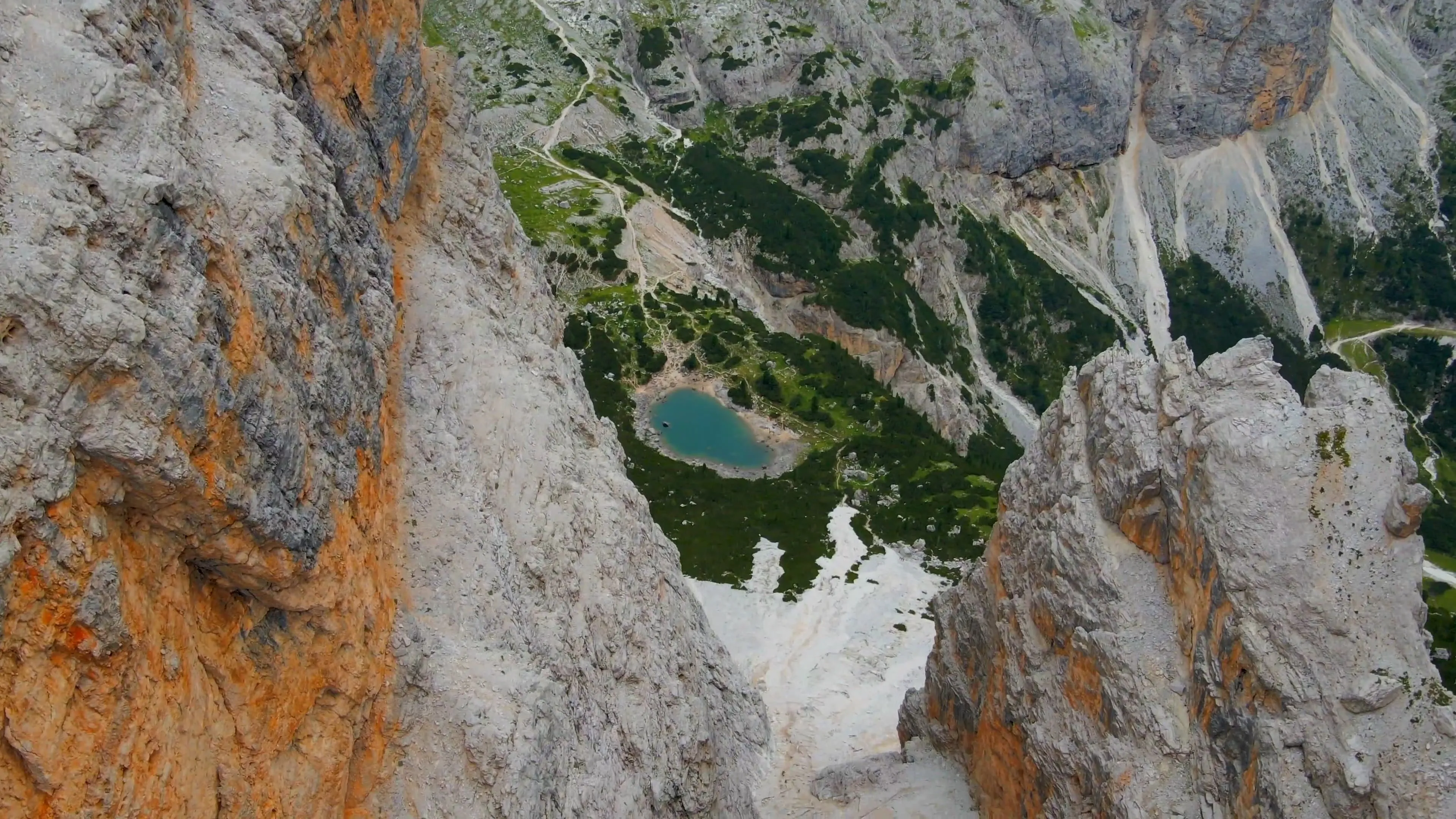
Alta Via 1: Map, Difficulty, and Route on the Italian Dolomites
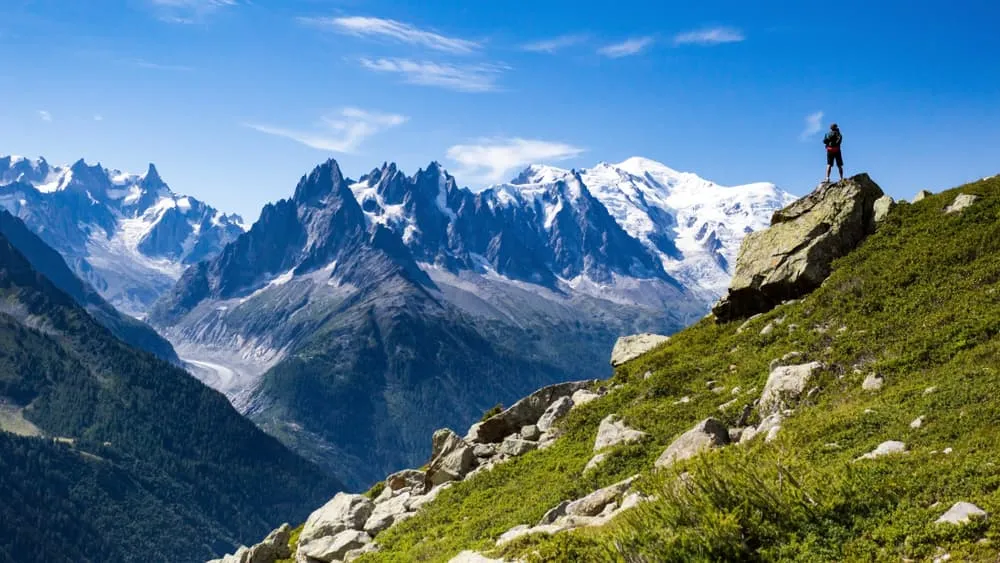
Tour du Mont Blanc: All You Need To Know
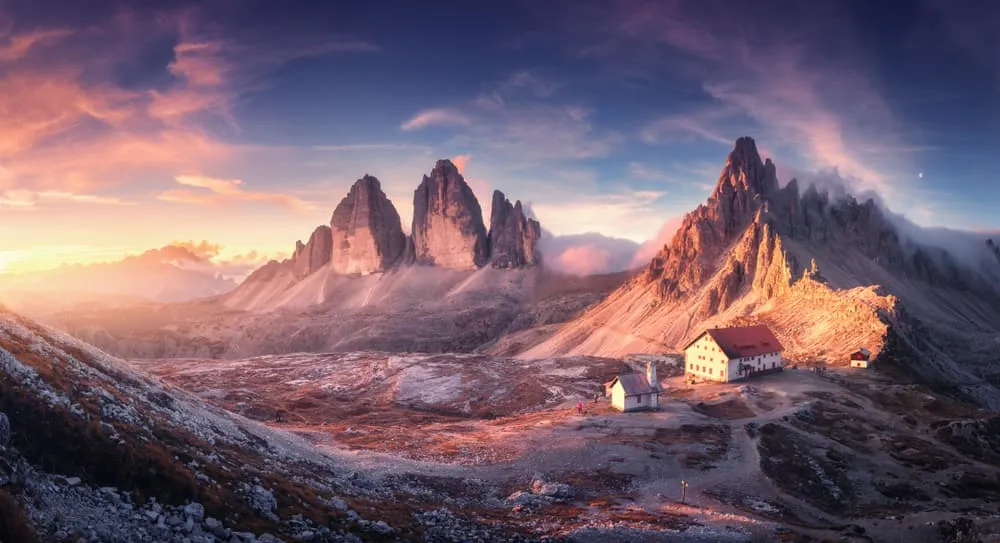
Dolomites Hiking: The 8 Best Options for Hiking Hut-to-Hut in Italy
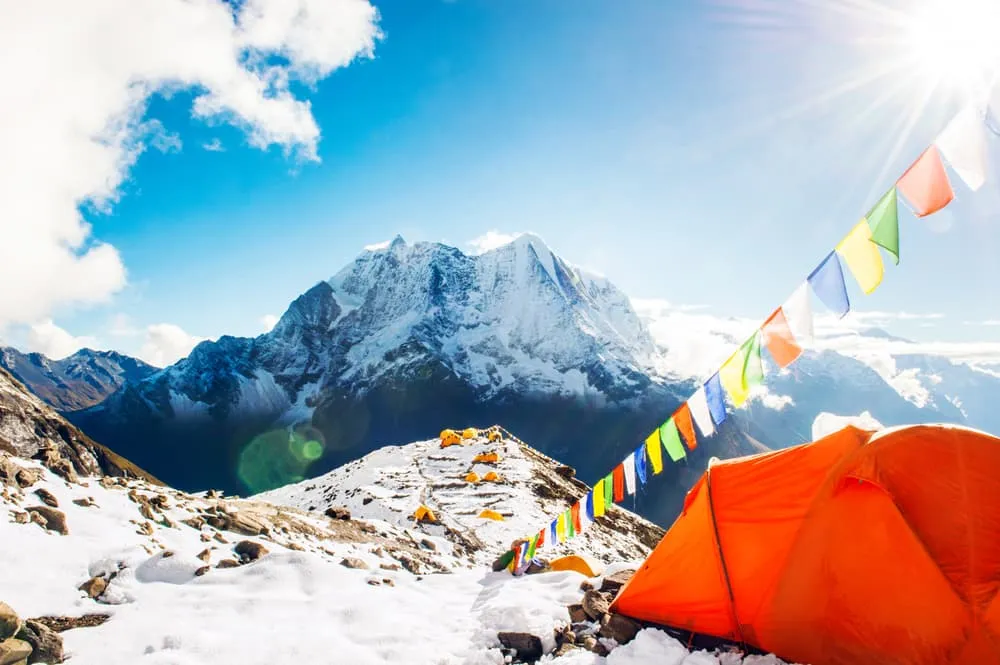
Everest Base Camp: A Trek to The Roof of The World
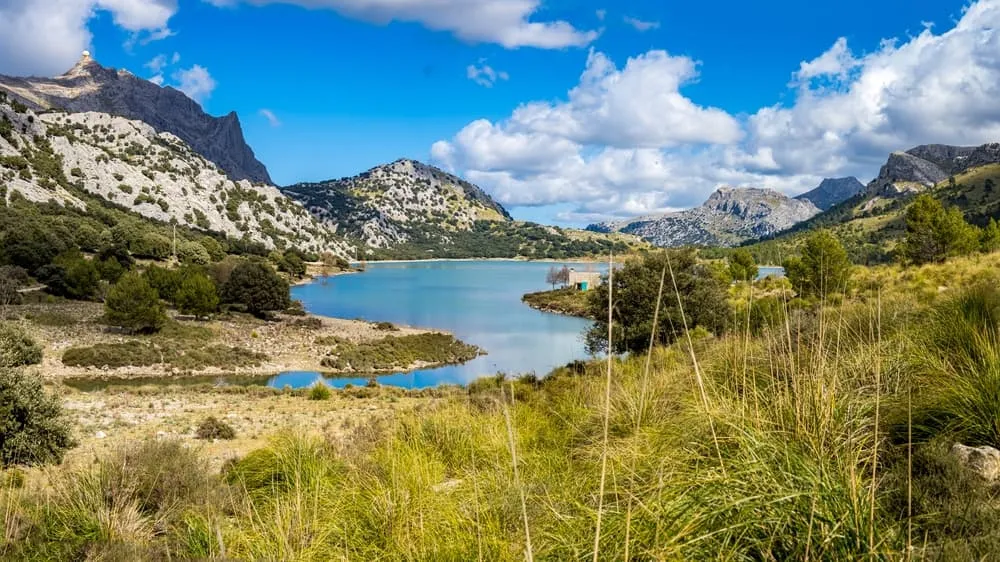
Hiking the GR221 in Mallorca: Everything You Need to Know
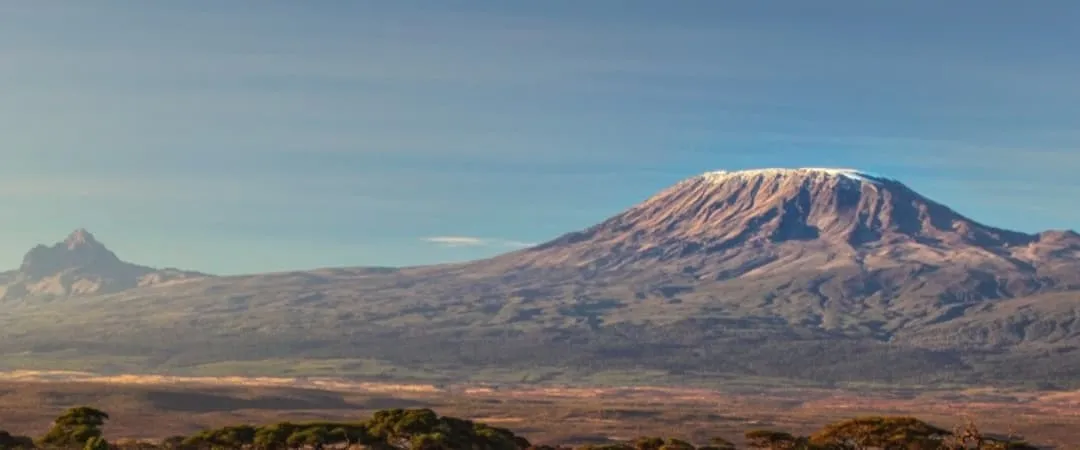
Climbing Kilimanjaro: All You Need To Know For Your Climb
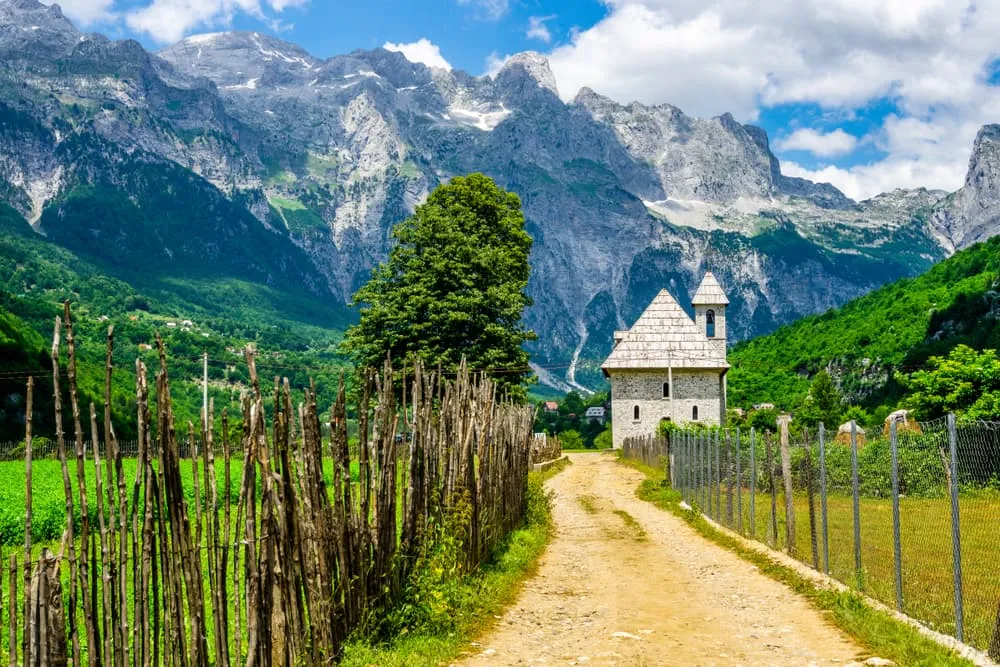
Peaks of the Balkans Trail: All You Need to Know

Hut-to-Hut Hiking in the Pyrenees: The 4 Best Walks
Get weekly inspiration with the best treks.


Annapurna Circuit Trek; All you Need to Know
- You are here:
Annapurna Circuit Trek- Everything you Need to Know
- Jan 12, 2022
- Alpine Ramble Treks
Table of Contents
The Annapurna Circuit Trek is one of Nepal’s most admiring classic treks. It traverses magnificently varied landscapes, farmlands, from lush lowlands forests to the high-altitude Thorong Pass, the highest point of the trek as it stands at an elevation of 5416 meters above sea level.
Throng- La is said to be the highest trekking pass in the world with the imposing Annapurna Massif a near invariable companion. In recent years, this trekking has become one of the most popular and crowded trekking trails in the Nepal Himalayas.
Every year, thousands of travelers traverse enthralls on the beauty of this place while trekking from all around the world.
The Annapurna Circuit route was a string of trekking tea houses and clearly marked trails make this an easily accessible, a normal trek that anyone of us can be part of this fascinating journey with reasonable fitness level where we do not need to climb any technical mountains to cross the whole journey.
Annapurna circuit trek is said to be more than just a trek for many reasons, one can experience the beautify culture and nature from the starting phase of the journey to end, it is a complete journey in the Himalayas where you will not only explore the majestic some of the world’s highest mountains but you will also get an opportunity and appreciate with fascinating culture of the peoples in the mountains as well as their unique lifestyle.
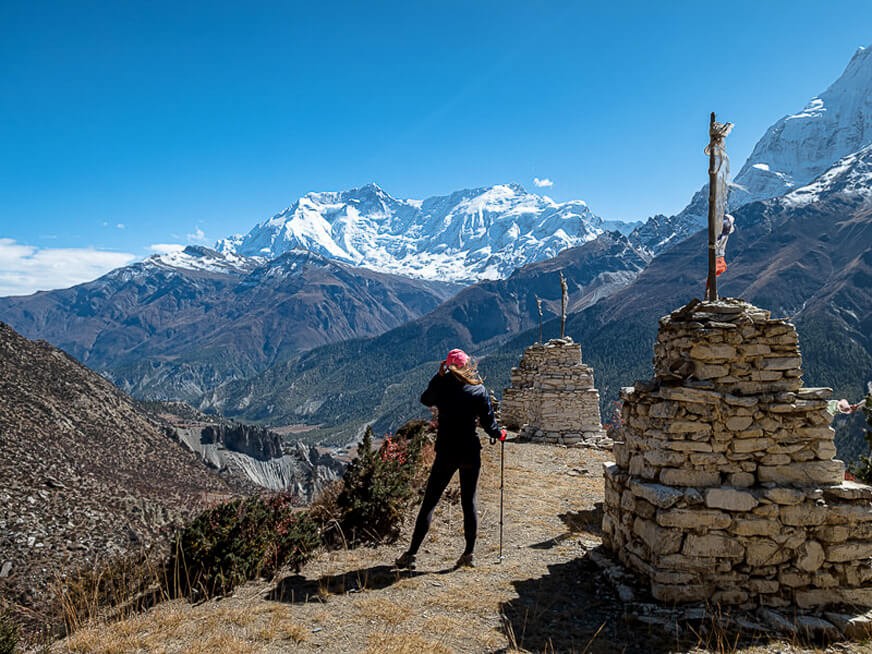
Tranquil Annapurna trek (ACT) will take you through a variety of different landscapes, lush terraces, to the forests, and then into those beautiful high-altitude views of the magnificent mountains therefore this trek is more than just a trek with a complete package.
As we hike constantly day by day, we’ll get exposed to the daily life of the native mountain’s Nepalese people who live in the remotest part of Nepal for a long century.
Embark on this journey to immerse yourself in the beauty of majestic Himalayas and also be engrossed in the small traditional villages’ culture and agriculture.
If you are one of the adventure enthusiasts and want to experience a little bit of everything about Nepal that it has to offer, this is the piece of cake for you to set off on, but bear in mind this trek is certainly no easy feat like Annapurna Base Camp Trek or Langtang Valley Trek . However, in this article, here are the things you should really know in order to complete the amazing Annapurna Circuit safely and with a smile on your face.
Best Time to go on Annapurna Circuit Trek
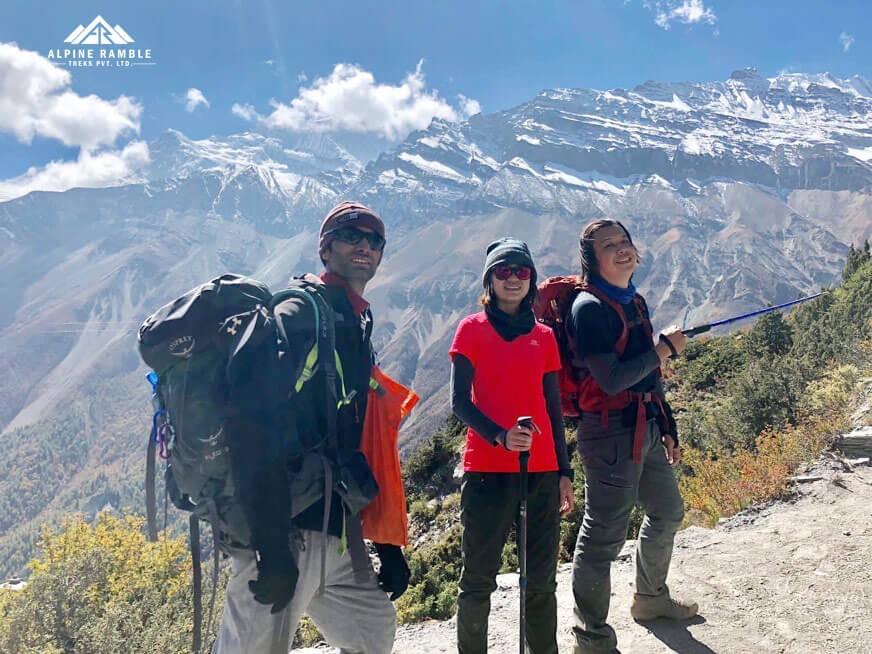
Like with many of the treks in the Himalayas in Nepal, there are certain times of the year when the weather conditions are ideal for trekking and mountaineering activities.
In fact, the months of September, October, and November or March, April, and May are widely considered to be the best and favorable months or times of the year from the Annapurna Circuit Trekking in Nepal.
The weather and temperatures during these two (autumn and spring) seasons are generally clear and dry where views are always nice with clean blue sky, and the weather is stable However it’s not too cold when heading into altitudes and not too hot in the lower areas of the trek.
These two seasons are the peak and also crowded season’s times to be on the trail including Annapurna, and Everest region of Nepal where the trails and tea houses on the routes are generally covered by full of travelers.
Trekking into the Annapurna circuit at this time of the year with many other trekkers from across the world heading into the same destination with the same goal and determinations makes your journey more fun and enjoyable.
If you are looking for the Annapurna circuit trek at different times of the year, you can also do a trek at other times, but be prepared with certain weather conditions.
The winter season involves the months of December, January, and February, trekking in the Annapurna circuit is not an impossible way to complete, it is still good to enjoy, which offers clear skies and spectacular views.
But it can be incredibly cold at higher altitudes, with the possibility of the thick snow on the ground that can often cause the Thorong La Pass to close at short notice or even hard to cross the pass by solely.
If you are still happy to take a challenge on this trek in the winter season then make sure to have enough nice clothing gear for trekking with the extra layers, a thick down jacket, warms socks, sleeping bag suited to temperatures of at least -25°C and crampons, which can be bought in Kathmandu at any local trekking stores with the variety of options in terms of the quality.
Trekking Equipment for the Annapurna Circuit trek
.jpg)
Equipment is one of the important factors in order to complete the journey. Having the right equipment is extremely important for trekking to the Himalayas;
For the Annapurna circuit trek, make sure to carry a proper pair of hiking boots that are comfortable and worn-in is a good place to start! Because of the variable temperatures – from night today and as you gain altitude – layering is very helpful and adds extra warmth, we would recommend purchasing some good layers made out of breathable fibers, some spare hiking t-shirts with quick-dry access.
Bringing some windbreaker or fleece as a mid-weight layer is a good idea and then a warm thicker down jacket is the best option for a top layer.
Umbrella is not recommended to rain at altitude but carries a good rain jacket or poncho which can be brought along the way for the temporary, this is essential, take a comfortable day backpack, normally 40l or above.
Make sure to bring your own first aid box with Diamox, a medication for high altitude sickness as well as toiletries. For more about essential gears please click HERE.
Pick the Right Everest Base Camp Itinerary
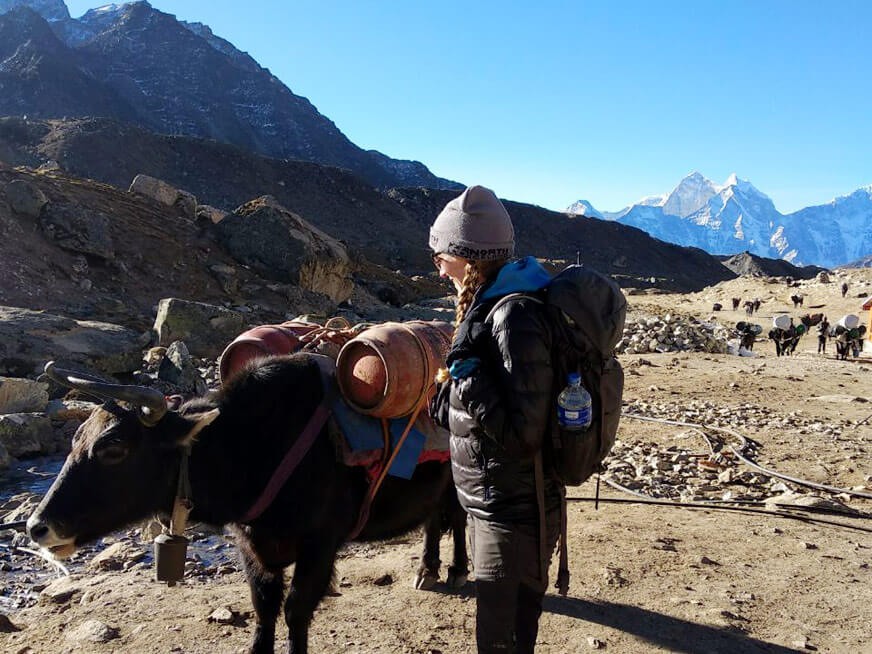
Most importantly the first thing that you need to think about is picking the right itinerary; hence, there is no one size fits all. One key factor to consider is that you need to have as much acclimatization possible in the critical points of the trek.
Therefore, take a proper trekking itinerary for your next trek to the Annapurna circuit, at least 2 nights acclimatization in Manang village one the way up the trail is recommended.
The crucial part of the trek is altitude without having proper acclimatization along the way up may cause your hiking difficulties in the climb.
There are some people who do this trek within a week but it is only for those of us who are trained well in the altitude and used to trek a lot before.
Having some extra day for the trek is vital to a safe, enjoyable, and successful experience in a low oxygen environment higher up the trail. Make sure to acclimatize well lower down, and then you will run out of the risk of getting altitude sickness higher up.
However, the Annapurna circuit trek has various trekking itineraries including a minimum of 8 days to the maximum day's itinerary of 20-day.
In order to avoid the high altitude sickness, we would recommend you take a 12- day Annapurna circuit or 16 –Day Annapurna circuit trek , or you may choose for an 18-20 day Annapurna circuit trek if your holiday permits.
Annapurna Circuit Trekking Map
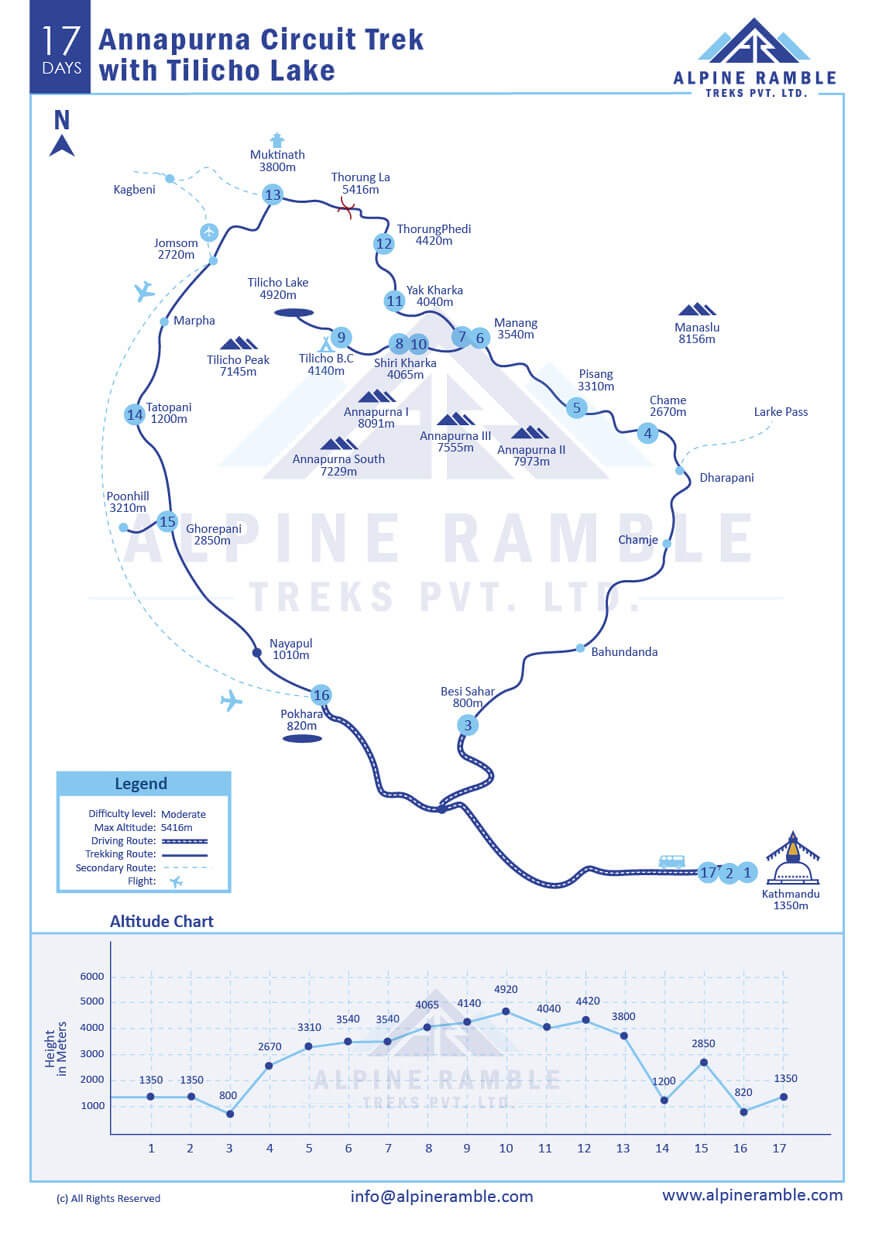
Accommodation while on the Annapurna Circuit trekking:
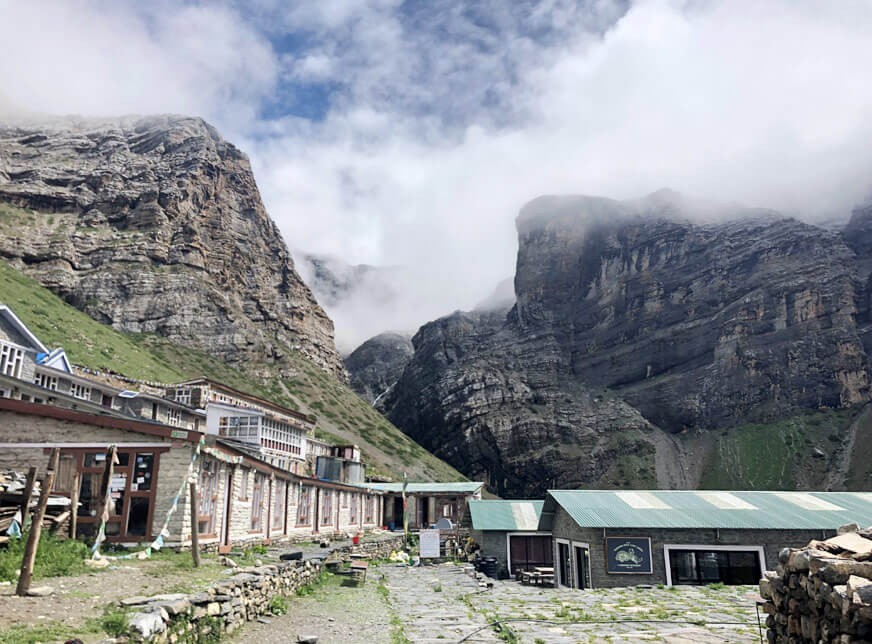
The Annapurna Circuit trek is one of the well-established trekking routes of Nepal, it's been very well set up with plenty of comfortable lodges, so we do not need to carry the tent to set up our camp to spend a night in the tiny tent.
However, the accommodation at the local is simple but convenient where we can spend a night comfortably. The good thing is some of the tea houses have an attached bathroom where you do not need to go outside of the room for the toilet, but in most of the places in this route, the toilet and washing facilities are outside of your room.
The room in the tea house is a twin sharing room with twin beds, a mattress, and a pillow where you can share the room with some of the genders or if you are a couple then it is good to fit for you.
Bear in mind, during the peak seasons in Spring (March to May) and autumn (September to November) the rooms are usually packed and covered by full of trekkers, in this case, the advance booking through your guide or company will help you to find the room easily since this route has limited tea house in the places.
Tea houses provide you with food, hot water for showers, and WiFi at a little extra cost.
Trekking Permits and TIMS car Cost
Travelers are required to register the trekking permit or Annapurna Conservation Area Permit (ACAP) and TIMs (Trekking Information Management System) cards to do this trek in the Annapurna region of Nepal. See the following fees details for the foreigners to buy the permits and TIMS card,
- Annapurna Conservation Area Project Try permit fee for tourists: NPR 3000 ($30 approx.)
- Annapurna Conservation Area Project entry permit fee for SAARC nationals: NPR 200
- Trekkers’ Information Management Systems permit fee: NPR 1000 ($10 approx.) – (TIMS)
Food and Drinking Water On Annapurna Circuit Trek
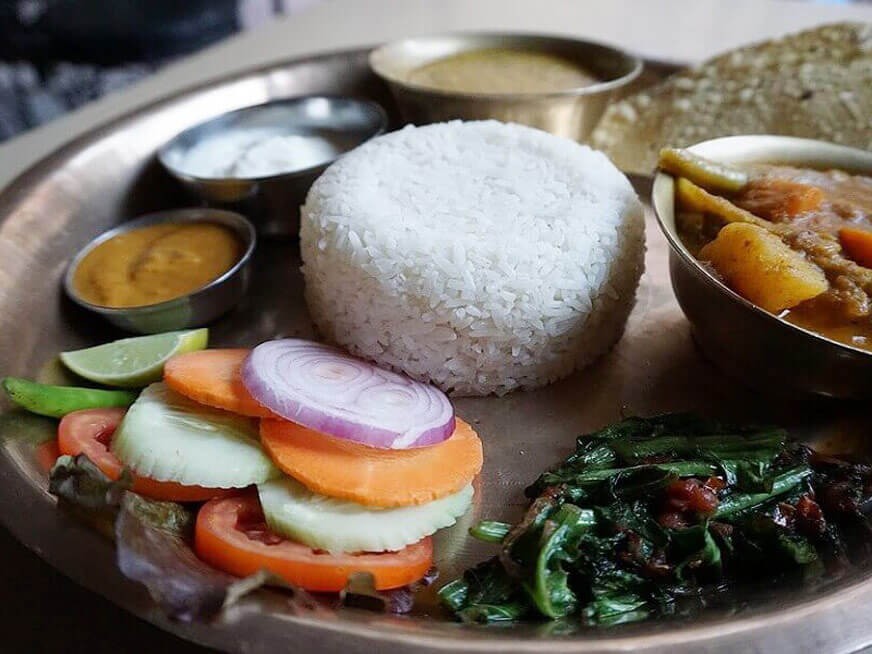
The drinking water is available everywhere in this region, most of the tea houses or small coffee shops sell the water at a little cost but as an option, you may carry a proper water bottle filling the water all the time as it is drunk out, refilling the water from the tap is free of cost but make sure to purify it before drinking.
Buying water is the best option because most of us are not used to the water from mountains and it may cause problems so spending a few dollars on good foods and water means we are treating ourselves in a better way, as we all know that we cannot deal with life at any amount of cost. Good food is a good life and healthy life is a happy life.
Hope it makes sense to us!
Remember, the water costs 0.5- 2 USD/ bottle of water.
Getting there & away
To trek in the Annapurna Circuit, we have to first drive to Besisher from Kathmandu which is a 6- hour long drive by local bus (we can also take a private jeep as an option- it costs way more than a local bus transfer), and next day again, we take another scenic mountain drive to Chame by a local jeep to start the trek (remember, if we do a trek longer version then we can start to trek from Besisahar but it has to be at least 16-20 days in a row if we start the trek from Besisahar and the most of walk would be in the local jeep road but the view is still spectacular).
Annapurna Circuit Trail Length
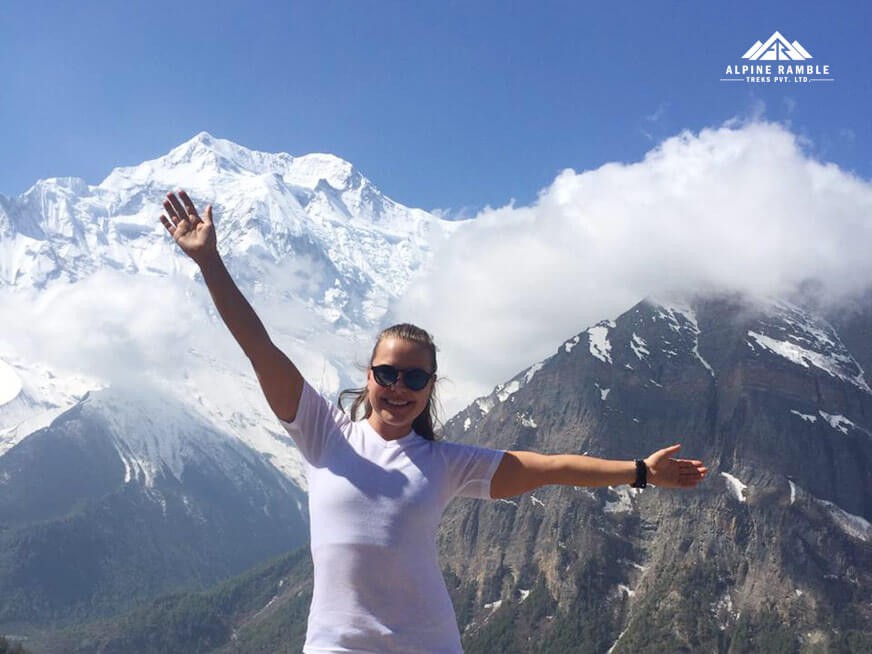
The total length covered by the Annapurna Circuit is somewhere between 225- 230 KM/100-145 miles). It depends where we are starting the trek; the length of the Annapurna Circuit will be shorter than this if we transfer to the Chame and start to trek from here, but as mentioned length above is based on the starting point from Besisahar.
Trek with the Expert
Support a company that has invested in the local communities and society in the remotest mountain parts of Nepal.
We helped set up the Khading village for the school kids and helpless women in the mountain region of Nepal after the 2015 earthquake and this trek will be led by our decades of professional experienced local guides who have been leading thousands of groups in the Himalayas for over the last 19 years in the field!
We believed in the quality services on all our trekking and mountaineering itineraries, we guaranteed your safety, satisfaction, and happiness throughout the trek with us. CONTACT US for more information and we can explain and help you on your next trip to Nepal. Look at our quieter Langtang Valley and Annapurna trek itineraries as well!
Send Inquiry
Recent posts.
- Everest Base Camp Trek cost for Indian trekkers
- A Complete Guide to the Kanchenjunga Trek
- A Complete Guide to Trekking in the Dolpo Region
- Unveiling the Untouched Beauty of Nepal: Langtang Valley Trek in 7 Days
- Travelers’ Choice Best of the Best & Bookmundi Certificate 2023
Related Posts
- The Everest Base Camp Trek: A Comprehensive Guide
- Wilderness treks in Nepal
- Manaslu Trek: All You Need to Know
- Things to do in Kathmandu in One Day
- Visit Garden of Dream in Nepal
- Annapurna trekking
- Everest Trek
- Langtang Trekking
- News and Updates
- Trekking in Nepal
- Visit Nepal
Share and Bookmark It
Nepal Trek Booking Open for 2024/25 (Note: From March, the Lukla flights will be from Ramechhap)
0 RESULTS FOUND!
A Detailed Guide for Annapurna Circuit Trek
The Annapurna Circuit circles the Annapurna massif in central Nepal. The highest mountain in the Annapurna massif is Annapurna (8,091m) - the tenth highest peak in the world, and there are thirteen peaks over 7,000m and numerous ranges over 6,000m.
The length of the Annapurna circuit route is between 160-230km. This length varies based on your choice of trek startpoint and endpoint and how much you use road transport.
The Annapurna region opened for tourists only in 1977, after a dispute settlement between Khampa guerrillas that operated from this region into Tibet, locals residing in this region, and the Nepal army. Back then, the Annapurna circuit trek started from Dumre - a town along the Kathmandu - Pokhara highway, and ended at Pokhara. It took 23 days to complete this trek.
Nowadays, you can choose to complete the Annapurna Circuit Trek anywhere between 10 to 27 days, depending upon the side trips you take, acclimatization, and how frequently you use motor transport.
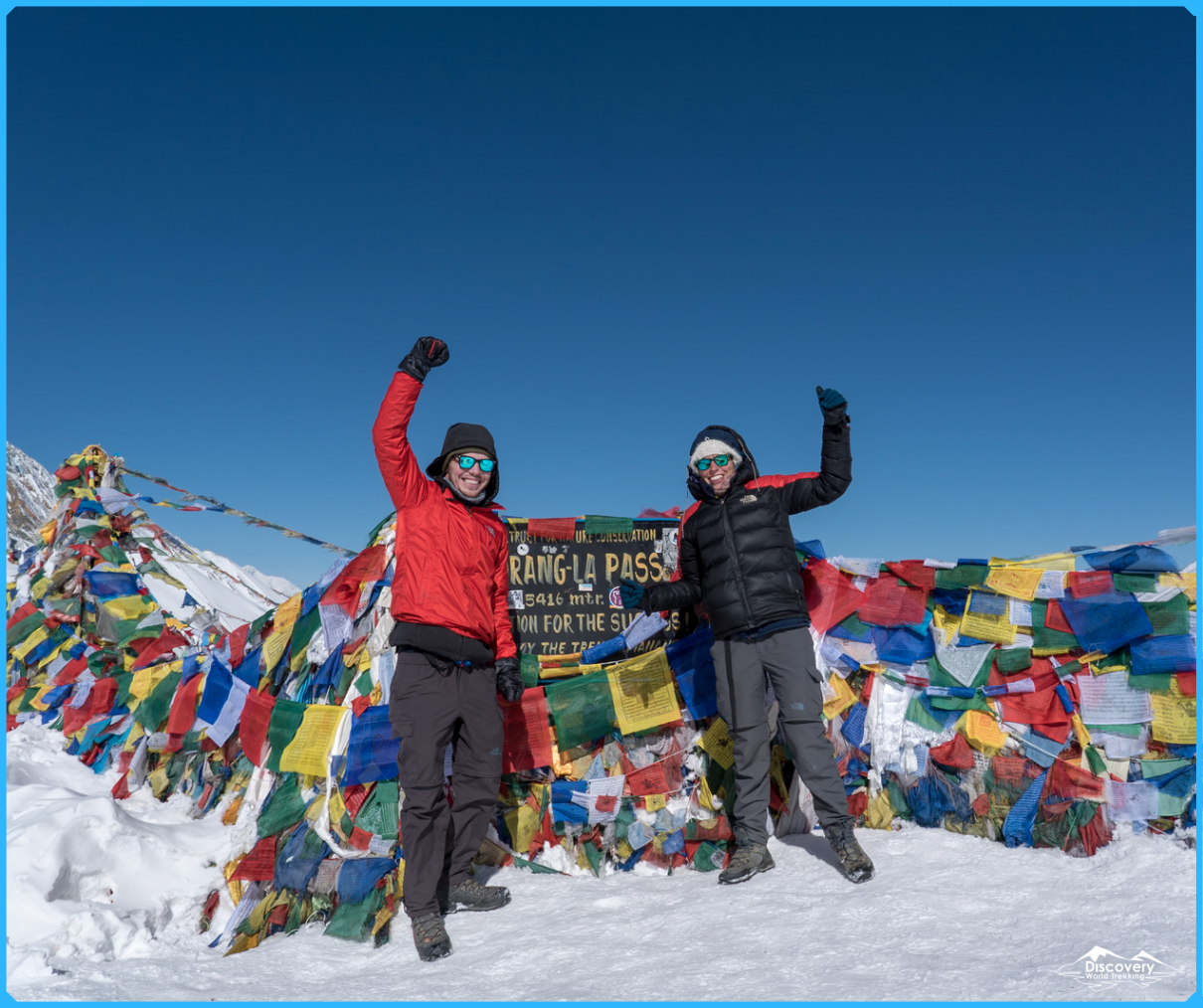
Thorong La Pass - 5,416 m
Annapurna Region
Annapurna Circuit trek lies in the Annapurna Conservation Area Project (ACAP) and is the largest conservation area in Nepal, covering 7,629 square kilometers. The elevations in the Annapurna Conservation Area range from 790m to 8,091m.
This region is home to around a hundred thousand residents of various ethnicity. Gurungs and Magars live in the south of the ACAP, while Thakalis, Manange, and Loba inhabit the northern regions. Most of these residents are either Buddhists or Hindus.
You can find 1,226 species of flowering plants, 5,18 types of birds, and 105 mammal species in this conservation area.
The northern area that lies behind the high peaks, is the rain shadow area, comprising some of the most iconic landscapes - mainly in the Upper Mustang region - in Nepal.
The highest point of Annapurna Circuit Trek is Thorong La Pass at 5,416m. And, you will also be reaching Muktinath Temple - a common holy site for Hindus and Buddhists. Muktinath Temple is also known for its 108 sprouts and an eternal flame that has been burning at temple premises for thousands of years.
Finally, you will also visit Pokhara - the tourist capital of Nepal, known for its incredible beauty due to the snow caps surrounding it and the reflection of those snow peaks in several of its lakes.
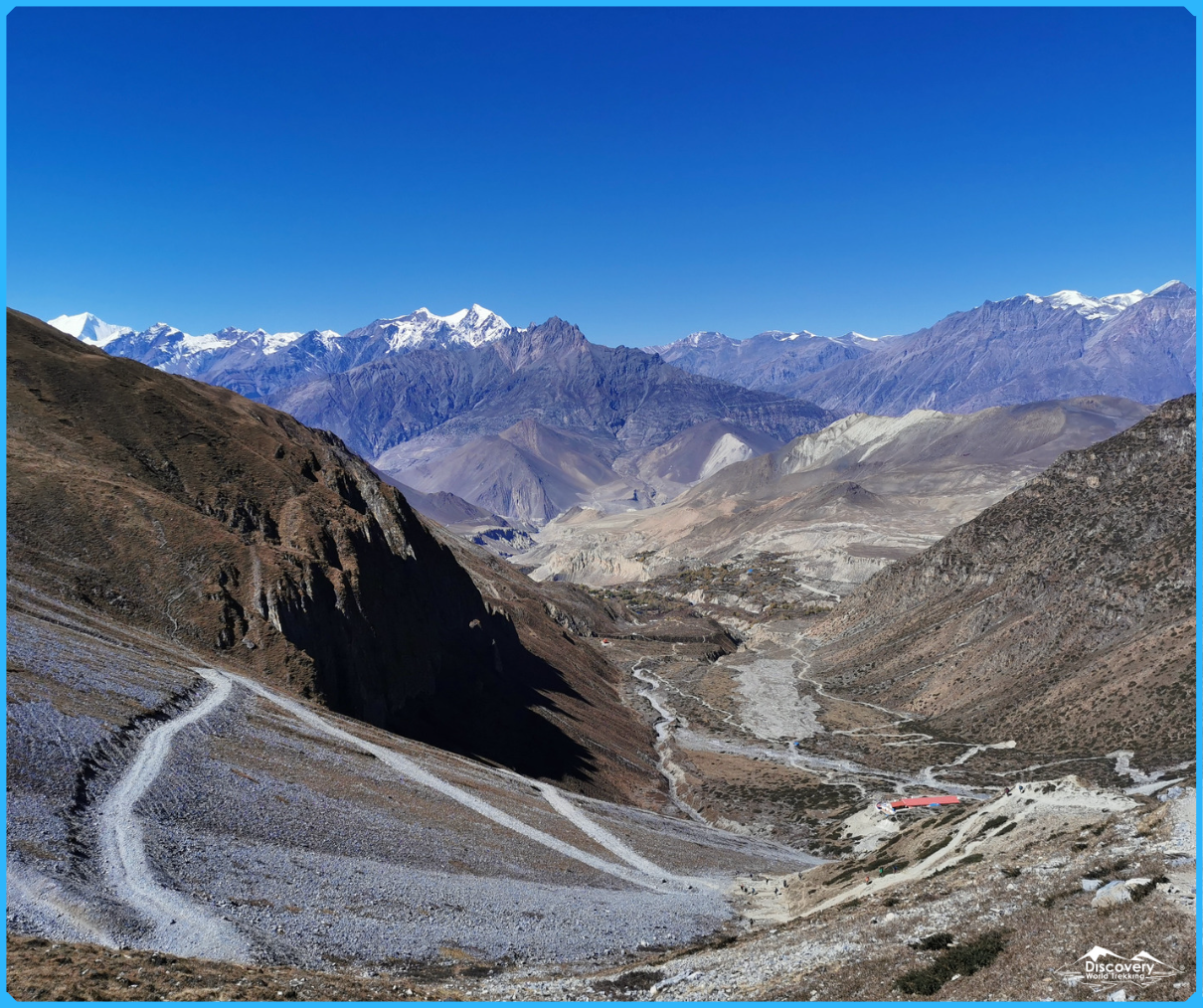
Annapurna Ranges
Best time for Annapurna Circuit trek
Though Annapurna Circuit treks are possible throughout the year, weather influences the Annapurna Circuit trek experience heavily. Here is a brief month-by-month description of the weather conditions- mainly at the highest trek elevations.
In January, high-altitude paths are covered with heavy snowfall. The path crossing the Thorong La Pass gets treacherous and may even be blocked.
During February, March, and April, the days are warm, the skies are clear, and the trekking paths are in perfect condition, which lets you enjoy your trek to the fullest. Multi-colored blossoms of rhododendrons enhance your trek experience. In May, the temperatures are pleasant, but there are chances of pre-monsoon rainfall.
Monsoon becomes active during June, July, and August, which means there is heavy rainfall in trek regions, making the trail paths wet and slippery. The rivers and waterfalls become fierce because of torrential rain, but the vegetation becomes lush and green due to rainfall.
September, October, and November form autumn in Nepal, and this is the perfect season for Annapurna Circuit Treks. By September, the monsoon will have retreated, providing clear rainwashed views of the great mountains. Two of the biggest festivals of Nepal - Dashain & Tihar - also fall during this month, adding a festive mood to the whole trek region.
From late November and continuing to December, the temperatures at high trek elevations dips, making days cold and nights colder. However, you will get to enjoy the uncrowded treks that often provide thrill due to snow.
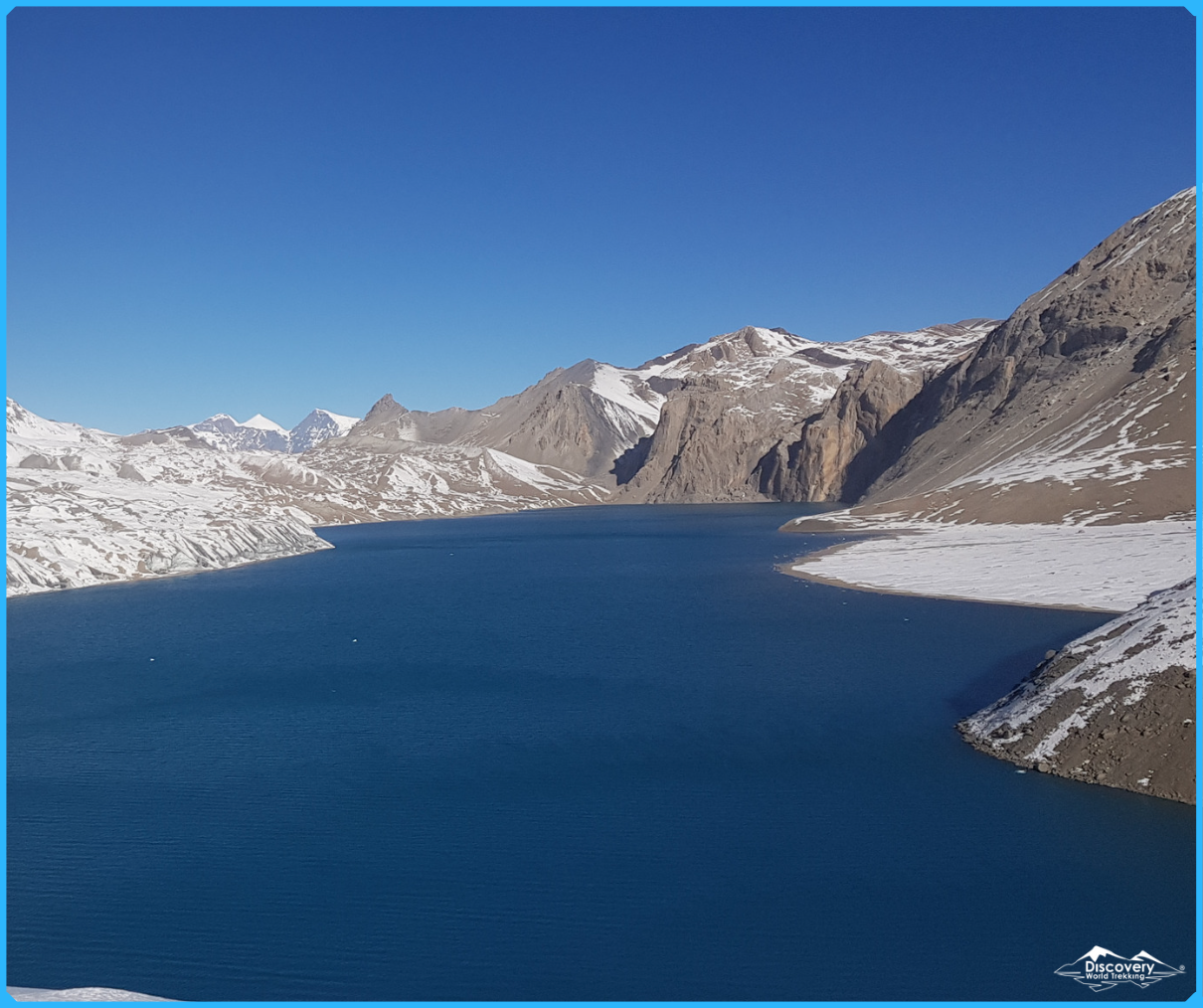
Tilicho Lake - 4,919 m
Annapurna Region Trek Highlights
- Marshyangdi and Kali Gandaki River Valley
- Pass yaks and their pastures
- Natural hot springs at Tatopani where you can choose to take a dip
- Jomsom - the headquarter of Mustang
- Tourist hub Pokhara
- Spectacular views of Mt. Annapurna (8,091m), Thorung Peak, Nilgiri, Chulu West, and Chulu East, Tukuche Peak, Dhaulagiri, Lamjung Himal, Annapurna II, and Annapurna IV
- Magnificent lakes, glaciers, deep gorges, and stunning waterfalls
- Visit Muktinath (a sacred temple for both Hindus and Buddhists) known for 108 stone faucets, and an eternal flame
- Tilicho Lake (4,949m) - one of the highest lakes in the world
- Blue sheep at Yak Kharka
- Visit the beautiful Manang district
- Visit Barge Monastery, the largest monastery in the Manang district
- Cross Thorong La Pass at 5,416 meters
- Poon Hill Viewpoint (3,210 m)
- Annapurna Base Camp (4,130m)
- Macchapuchare Base Camp (4,130m)
Trekking Grade
Annapurna Circuit Trek is a challenging trek, where you will reach an altitude of 5,416m/17,769ft at Thorong La Pass. The paths themselves are often rocky, steep, or even slippery at times. You will also be passing through several stairways, which are physically more demanding. Please note that the shorter Annapurna Circuit treks are more intensive due to the more distance to cover each day compared to longer ones.
Possible treks
There are several ways to experience the Annapurna Circuit treks . The duration of these trek range from 10 days to 27 days. Longer treks have fewer walking hours and more trails to cover. The shorter treks have more distance to cover and include longing bus rides.
1. Annapurna Circuit Short Trek - 10 Days
It is the shortest Annapurna Circuit Trek, without days allocated for acclimatization. You will be traveling by bus to Chame, where the trek trails start, and from Tatopani (trek endpoint), you will take a bus to return to Kathmandu.
2. Annapurna Circuit Trek - 14 Days
A moderate trek package with a day allocated for acclimatization. The trek trails start from Bhulbhule and end at Birethanti.
3. Annapurna Circuit Trek with Tilicho Lake - 16 Days
This is another moderate Annapurna Circuit trek. The trails start from Jagat and end at Birethanti. There is one day for acclimatization at Manang. This trek includes a short side trek to the Tilicho Lake - one of the world's highest lakes while on the way.
4. Annapurna Trek - 20 Days
Comparatively, this is a long Annapurna Circuit Trek, but it includes sightseeing in Kathmandu before the trek start. The trails start from Bhulbhule and end at Birethanti. There is a day allocated for acclimatization at Manang.
5. Annapurna Circuit Trek with Annapurna Base Camp - 27 Days
It is a comprehensive trek that goes far beyond the introduction to the Annapurna region. This intensive trek will let you experience almost all of the Annapurna Conservation Area. In addition to the Annapurna circuit, you will reach Annapurna Base Camp and Machhapuchare Base Camp.
Preparing yourself
If you are normally fit, you can complete Annapurna Circuit Treks. However, the fitter you are, the more you will enjoy your trek. So, it is wise to engage in stamina-building exercises a few weeks before your Annapurna Circuit Trek. You have several options, such as jogging, cycling, or swimming. You can also take part in treks that last for six-seven hours while carrying a regular backpack.
Since you will be trekking through some of the most stunning and inaccessible landscapes, it is a good idea to bring with you a great camera to capture the incredible scenery. Of course, you can use your mobile, but the pictures captured may not turn out to be perfect.
Though you will be trekking during the day, at night, before going to bed, you will have plenty of free time. So, you can plan how you want to spend the evenings. You might bring books to read, or fun game paraphernalia such as chess, cards, or monopoly.
Annapurna Circuit Trek is a challenging trek deep inside the remote high Himalayas, so it comes with risks associated with high-altitude treks. Hence, adequate trek insurance is compulsory, and in addition to medical treatment, it should cover helicopter rescue and repatriation at the highest trek elevation - Thorong La Pass at 5,416m.
Heli-rescue is important because of the lack of good road infrastructure and health facilities in trek regions. In case of emergencies, we arrange heli-rescue using your insurance policy copy and other documents that you submitted to us before starting the trek. We consider keeping trekkers safe as a part of our duty.
Please be very careful while buying your insurance and call the insurance company and specifically ask, in addition to health treatment cost, if they cover heli-rescue up to 5,500m. Do not just rely on what insurance companies say on their website.
It is always a good idea to travel light. We assign porters to carry your main luggage, but the luggage weight limit is 9-kg per trekker. Two trekkers will share a porter, and the combined weight of a porter should not exceed 18-kg. However, if you want one porter for yourself, we can arrange this. You can store your extra luggage for free at the Discovery World Trekking for the duration of your trip.
The exact luggage you need varies on the trek duration, the time of the year you are trekking, and your preferences. In addition to clothing items, we advise you to bring toiletries, essential gear, and personal accessories.
Spending money
Our trek packages cover most costs at trek regions, but they do not meet all the expenses. So you will need to carry personal spending money with you.
Most packages do not cover accommodations and meals in Kathmandu before and after the trek. Kathmandu has a range of hotels/lodges/restaurants that suit all budgets, tastes, and preferences, and you can book many of these hotels/lodges online.
Moreover, you will need money for visa application, travel insurance purchase, souvenirs, tips, snacks, drinks, gear, etc.
We advise you to bring cash (major currencies) and exchange them for Nepalese Rupees in legal money exchanges in Kathmandu and all-over Thamel. Currently, 1 USD is almost equal to NPR.120.
You can choose to bring a traveler's cheque. However, if you bring a traveler's cheque, you need to go through lengthy processes to cash it. You can exchange currencies at banks and other financial institutions, but they will impose a charge of 4% or more as commission.
You can also bring your credit/debit card and withdraw Nepalese Rupees from ATMs all-over Kathmandu. Several of these ATMs are open 24/7. However, you can only withdraw a maximum of Rs.35,000 with a service charge of Rs.500.
Please note that you must exchange your currency in Kathmandu, as the trek regions do not have any financial institutions, and trek regions only honor Nepali Rupees.
We estimate that you will need about USD 10 to 20, per day as spending money in trek regions for various things such as internet access, drinks, snacks, water, etc.
If you are an Indian citizen, you do not need a visa to enter Nepal.
Citizens from most countries receive an on-arrival visa at Tribhuvan International Airport in Kathmandu or along the immigration check posts located at Nepal borders. Children under the age of 10 get free visas to enter Nepal.
For an on-arrival visa, you need a passport with at least six months of validity, a passport-size photo, and a visa application fee. The current rate is USD 50 for a 30-day stay.
Chinese and SAARC (Bangladesh, Bhutan, Maldives, Sri Lanka, and Pakistan) will get a free visa. However, the free visa is limited to 30 days for SAARC citizens per visa year.
Citizens from certain countries - Ethiopia, Iraq, Palestine, Nigeria, Ghana, Zimbabwe, Swaziland, Cameroon, Somalia, Liberia, and Afghanistan - may not receive an on-arrival visa. So, if you are a citizen of any of these countries, you need to contact your local embassy.
Nepal government can change visa rules without notice, so to get the latest information, visit https://www.immigration.gov.np/ .
Getting there
As soon as booking your trek, we urge you to email your flight details to us. Once we get your flight details, we will send our company representative to Kathmandu Airport to receive you. When you arrive at the airport reception, you will find our representative holding a pamphlet with your name on it. They will present you with a marigold garland as a welcome gesture and take you to your hotel in a private vehicle. It will ensure you will not have difficulties navigating in a new country.
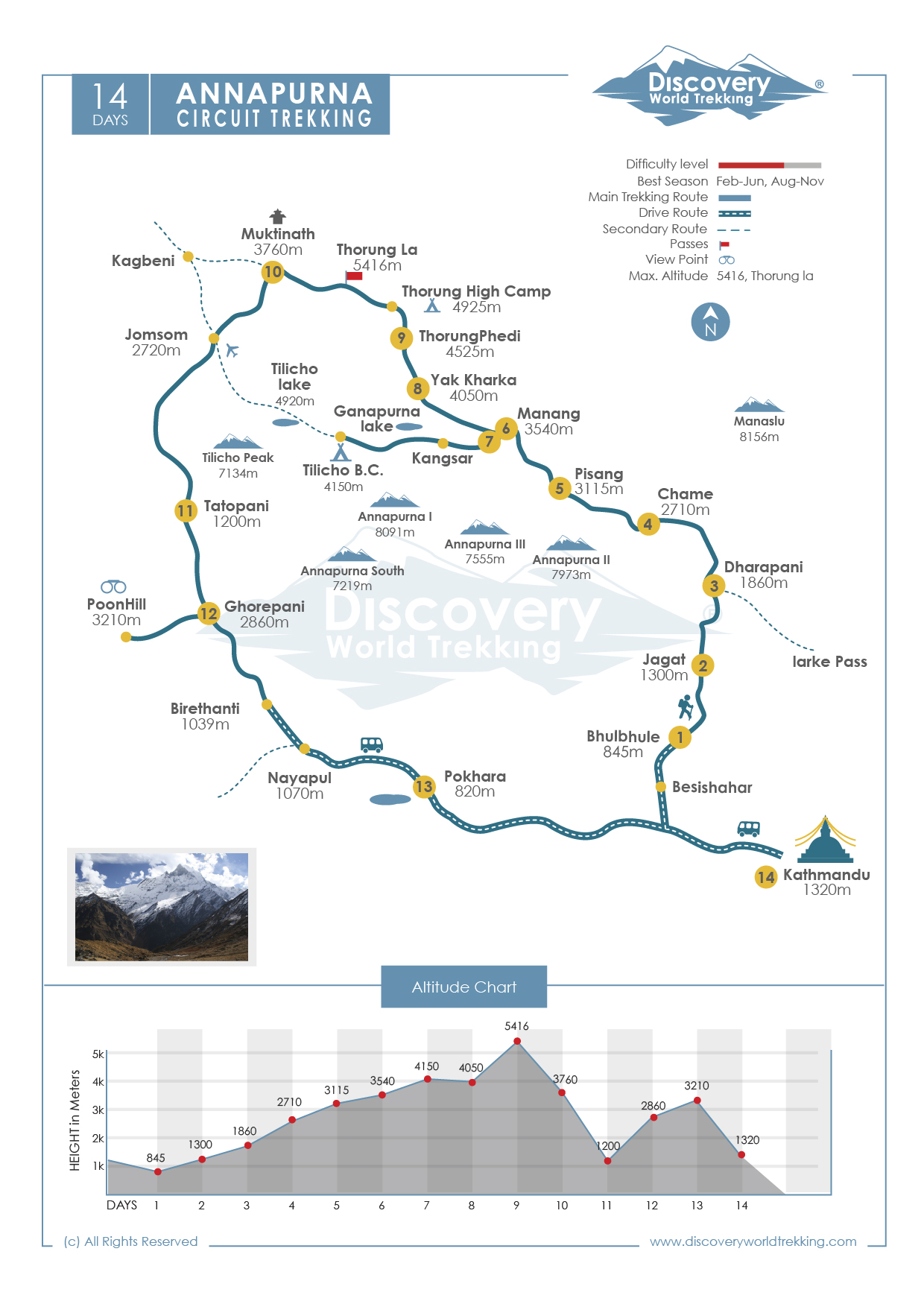
We provide free airport pickup and drop-off service for all trekkers who have booked trek packages with us.
We request all our trekking guests to arrive by 3 pm, at least one day earlier than the departure date. It will provide you with time to take part in the trip briefing, where we will go through your luggage to ensure you have packed all the essential things for the trek. The trip briefing also provides time for introduction, and we will also give you vital information about the hike.
Annapurna Circuit treks are very accessible. On your departure date, we will drive to the trek start point . The trek start point varies according to the trek package you choose.
Permits & fees
Annapurna Circuit Treks take place inside the Annapurna Conservation Area, so you require Annapurna Conservation Area Project (ACAP) permit for the trek. The cost of an ACAP permit for foreigners (except SAARC citizens) is Rupees 3,000 (~USD 30), and you can acquire this permit from Nepal Tourism Board Office at Pradarshani Marg, Kathmandu, or Tourism Board Service Center at Damside, Pokhara, or from the ACAP permit counter at Besishar. For SAARC (India, Sri Lanka, Pakistan, Maldives, Bhutan, Bangladesh) citizens, the cost of an ACAP permit is Rupees 200 (~USD 2).
In addition to the ACAP permit, trekkers also need a Trekkers' Information Management System (TIMS) card , which costs Rs. 1,000 (~10 USD). You can also get a TIMS card from Nepal Tourism Board Office at Pradarshani Marg, Kathmandu.
However, as a responsible trek operator, Discovery World Trekking will get these permits for you.
You do not need to worry about the language barrier while trekking in Nepal. There are around 122 dialects spoken in Nepal, but the lingua franca is Nepali. However, a sizeable population, mainly in the cities, speaks English. Discovery World Trekking has guides/Sherpas fluent in English, Japanese, and Spanish.
Remaining in contact
You will have no problem connecting with your friends and family from cities and towns in Nepal. Most lodges/restaurants in trek regions where you will be staying have internet access. However, you might need to pay a service fee to use it.
Discovery World Trekking remains in contact with each of its trek teams at least once a day through the trek lead. In high elevations, we communicate through mobile/cell phones. You also have the option to buy a local sim card in Kathmandu. However, we cannot guarantee that the signals will be strong enough.
Food & water
Annapurna Circuit Treks are long treks that involve trekking at higher elevations. Hence, you will need enough nutritious food. Discovery World Trekking selects the best lodges/tea houses/hotels to arrange plenty of nutrient-rich and tasty food for its valuable clients. The food choices are mainly traditional, Asian, or western.
However, in trek regions, you cannot expect to get all the food choices big cities provide. As your trek elevates, your food choices get narrower, and food gets expensive. Most Discovery World Trekking trek packages include standard meals -(breakfast, lunch, and dinner).
We suggest you to buy snacks and extra dietary food from big cities because they become expensive in trek regions.
You can buy packed mineral water from en route shops and tea houses during the trek. However, some trek regions do not allow plastic bottles. So, we advise you to bring a water bottle and fill it with boiled/filtered water from the lodges/teahouses. We strongly advise you against drinking water from rivers, taps, or wells in trek regions because the water may not be potable.
Similarly, it is best to avoid non-veg items, dairy products, and alcoholic drinks. Instead, you can take lots of fresh vegetables and liquids such as lemon tea, ginger tea, or garlic soup (must).
Accommodations
You can choose your own accommodations in Kathmandu. Kathmandu has all kinds of hotels/lodges that suit every taste and budget, and you can book several of these lodges/hotels online. Most Annapurna Circuit packages do not include accommodations at Kathmandu.
The trek infrastructure in Annapurna Circuit Treks is basic, but there is no need to camp outside. We select the best accommodations at trek regions to keep you warm and comfortable. In the trek regions, we will arrange lodges, having rooms with attached bathrooms as far as possible. In other places, you will be staying in standard rooms. All rooms are on a twin-sharing basis.
All the lodges you will be staying in will have electricity, running water, and internet. By paying a small fee, you can enjoy hot showers as well.
Staying safe
Our trek guides have completed intensive wilderness first aid training. They are government licensed and come from the remote high Himalayas. Our team carries first aid kits and the necessary equipment to face any situation during the trek. We trek together to ensure group safety.
High altitude treks come with a chance of catching altitude sickness. To remain on the safe side, our team carries an oximeter to monitor blood oxygen saturation levels. It allows us to detect the impending altitude sickness pretty early and take precautions.
There are ways to avoid altitude sickness. You must not skip acclimatization, drink plenty of water, and walk at your own pace. If you become aware of altitude sickness signs, tell your guide immediately. Look for the following signs:
- Tiredness and dizziness
- Nausea and vomiting
- Headache
- Difficulty in sleeping
- Appetite loss
- Increased heart rate and shortness of breath
Here are ways to decrease the chances of altitude sickness.
- Do not skip acclimatization days
- Walk at your own pace
- Drink at least 4 liters of water every day
- Drink garlic soup
- Take enough food during trekking
- Keep your body warm
- Take plenty of rest after a daily hike
- Avoid alcoholic and caffeinated drinks.
Severe altitude sickness can be life-threatening, so in such cases, we will deploy a helicopter to bring the affected person back to safety and transfer them to medical facilities. For this reason, adequate trek insurance with heli-rescue is crucial for Annapurna Circuit Treks.
If someone falls ill, the trek leader decides whether to continue the trek or descend immediately after analyzing the situation. In any case, we will make sure you are safe and comfortable.
Being cared
You might think that it will be hard for you to fly to a foreign country and trek on some of the most remote trails on Earth. However, you need not worry.
We will take care of you from the moment you land at the Tribhuvan International Airport in Kathmandu, and until you depart to your own country. We offer free airport pickup and drop-off service for all our trek guests. If you need help at any point during your stay in Nepal, you can contact us.
Discovery World Trekking believes in universal brotherhood, and we treat each of our valuable clients as our family members.
You now have enough information about the Annapurna Circuit treks. We believe that you now know the geography around the trails, places to visit, things to see, and the trek options you have.
However, if you need more information or want to customize your Annapurna Circuit trek, feel free to call/Viber/WhatsApp Paul at +977 - 9840055491 or email at [email protected] - anytime.
A Detailed Guide for Annapurna Base Camp trek
A detailed guide for manaslu circuit trek, annapurna iv: exploring nepal's alpine wonder, annapurna iii: the third highest annapurna mountain, annapurna ii: exploring nepal's enigmatic peak, our history in service excellence, we are associated with:.
Discovery World Trekking is the trademark name of Discovery World Trekking Pvt. Ltd. Our name, logo, and slogan are registered in Nepal. Our Nepal Tourism Board trekking and travel company license number is 1495.
We’ll Plan You a Custom-Made Trip
This site uses cookies to optimize your user experience. By using this site, you are consenting to our use of these cookies. Check out our Privacy policy .

Annapurna Circuit Trek
One of the world’s great trekking routes is threatened but alive (and recovering).
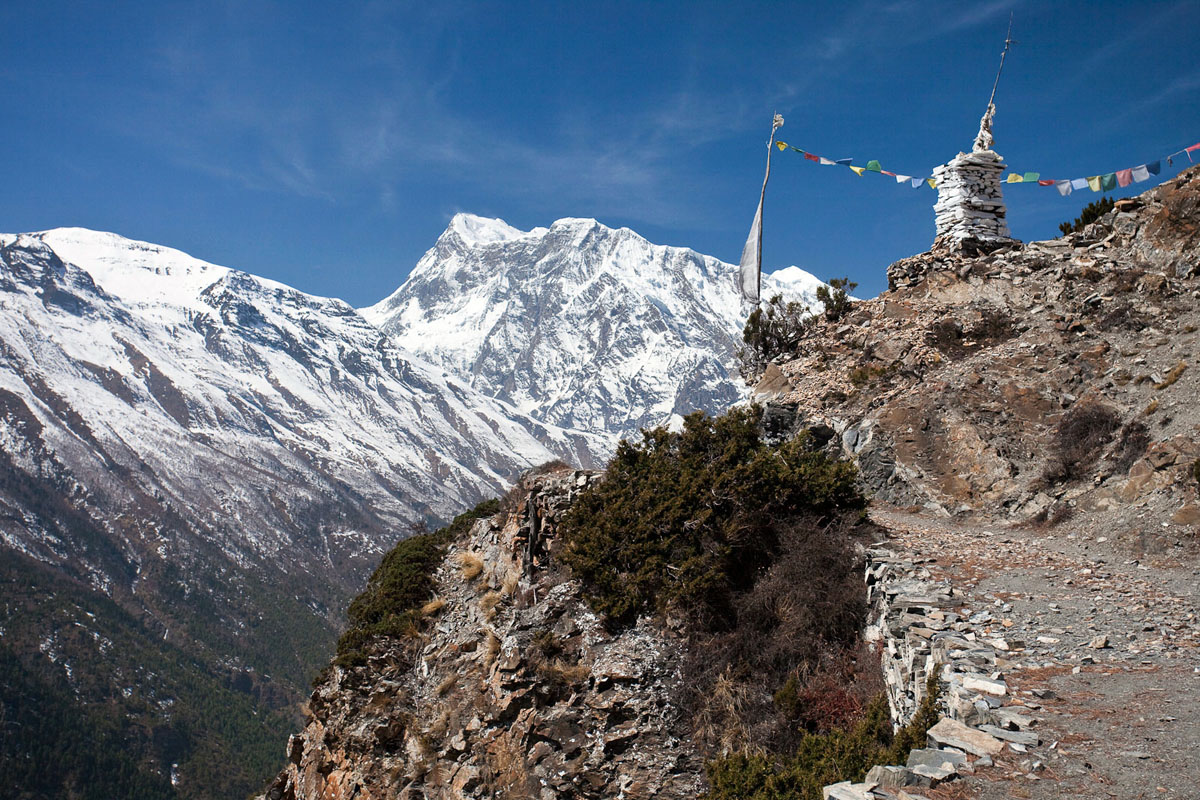
Greg Willis
The Annapurna Circuit once was a three-week journey through the pristine valleys and villages of the Annapurna range, but the construction of two roads encroaching up both sides has shrunken the route significantly. When the final road is complete, the date of which is unknown and consistently delayed, the roadless section of the Annapurna Circuit may be reduced to as few as five days. What does this all mean?
First, the Annapurna Circuit isn’t lost yet. Depending on how far up the roads you decide to start and finishing walking, the abbreviated version can now be completed 8–17 days. As of 2015, on the Besisahar side (east) the road up the Marsyangdi Valley reaches Manang at 3,540 meters. On the west side of the Circuit the road extends up the Kali Gandaki Valley to Jomsom and jeeps and flights are available from there. There still remains a number of roadless days (approximately 8) but they are decreasing.
Annapurna Circuit Trek Facts
Length: 8–21 days (the grand loop from Besishar to Pokhara takes approximately 17–21 days). Difficulty: Moderate to challenging. Starting elevation: 760 meters (2,493 feet) at Besisahar up to 3,450 meters (11,319 feet) at Manang, depending on your starting point. Peak elevation: 5,416 meters (17,769 feet) at Thorong La Pass. Elevation profile: via Adventure Alternative . Guiding: Recommended but not required. Accommodations: Teahouse. When to Go: Fall peak trekking season is from October to early December; spring trekking season is in March and April. Access: Pokhara, a 30-minute flight from Kathmandu or full day by ground transportation. Paperwork: The Annapurna Conservation Area Permit (ACAP) and TIMS card can be purchased from the Nepal Tourism Board in Kathmandu or Pohkara or through a registered guide; each requires two passport photos.
Trek Summary
Trekkers on the Annapurna Circuit now must decide where to begin. Most start on the Besisahar side and traditionalists walk from Besisahar to Chamje (2 days) along the dirt road. This stretch is beautiful—it meanders up the Marsyangdi River valley with the big mountains lurking behind—but trekkers compete with a stream of jeeps and busses. On the other side, the road starts around Jomsom and the walk from Jomsom to Pokhara takes 4–6 days. Most people add days to the Besisahar side of the Circuit because it’s more scenic and the road is less intrusive.
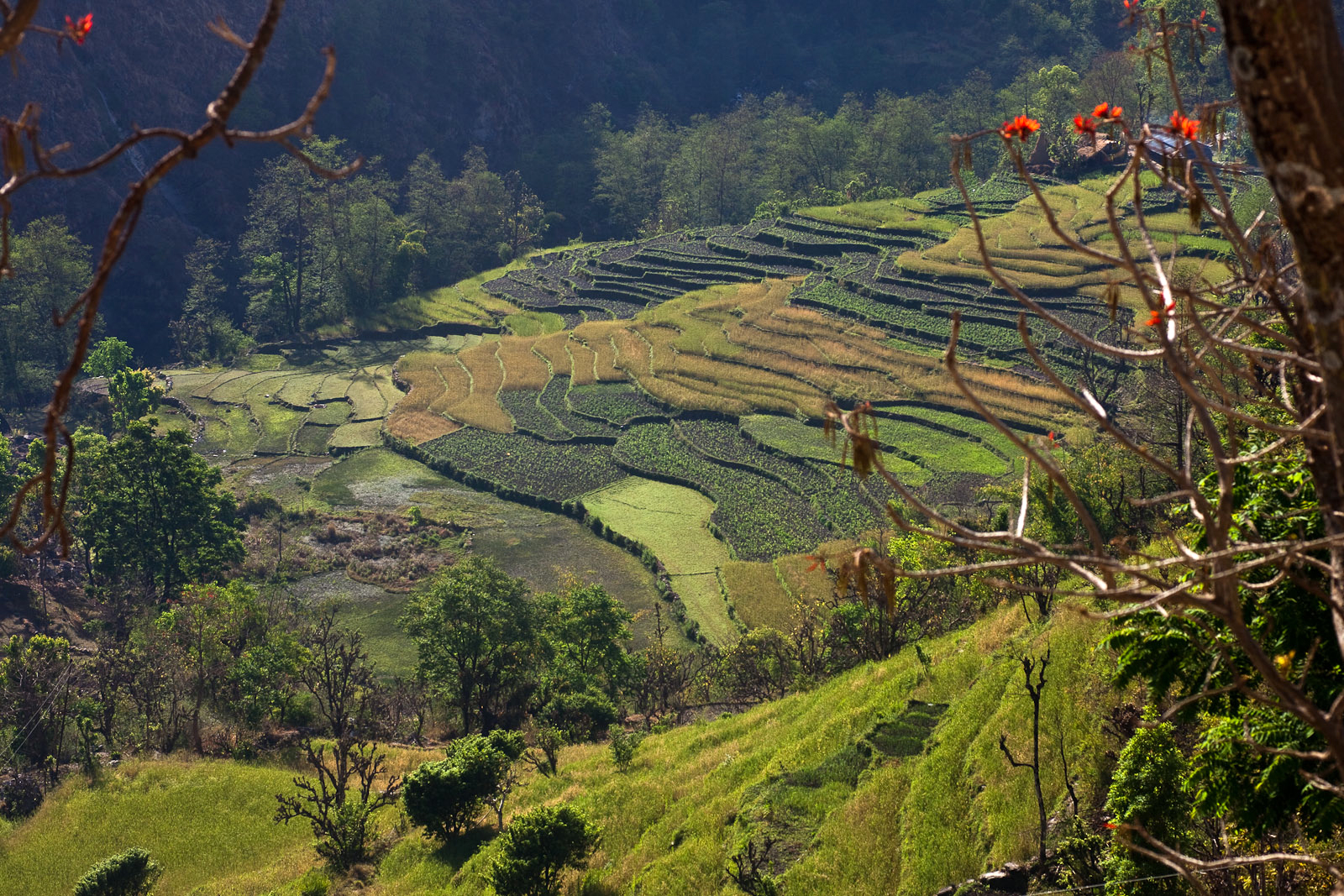
A great way to increase the number of roadless hiking days is the side trip to Tilicho Lake, one of the world's highest lakes at 4,919 meters (16,138 feet). From Manang it’s one day to Tilicho Base Camp and a few more hours to the lake itself. A rough, challenging trail cuts directly from Tilicho Lake to Jomsom but requires at least one night of self-sufficient camping (and it reaches an altitude above 5,000 meters). A guide is highly recommended in this area: the trails are rough and there is a small military base near the pass to Jomosom that must be avoided.
When assessing the Annapurna Circuit as it stands today, It's important to remember that development along the Annapurna Circuit occurred long before the roads were built. The influx of trekkers over the last thirty years led to significant infrastructure, teahouses, and small communities supported by trekking. Other treks in Nepal offer more of a wilderness experience, but the teahouses on the Annapurna Circuit are a luxury that facilitate weeks of trekking while carrying only a fraction of the supplies.
For trekkers, it’s likely that if you would have enjoyed the Circuit ten years ago, you will enjoy it today. The roadless stretch is still one of the most magnificent alpine trails in the world and the mountains themselves remain untouched. If this is the trek you choose, bask in the majesty of the Annapurna Range and don’t allow anything to detract from your experience.
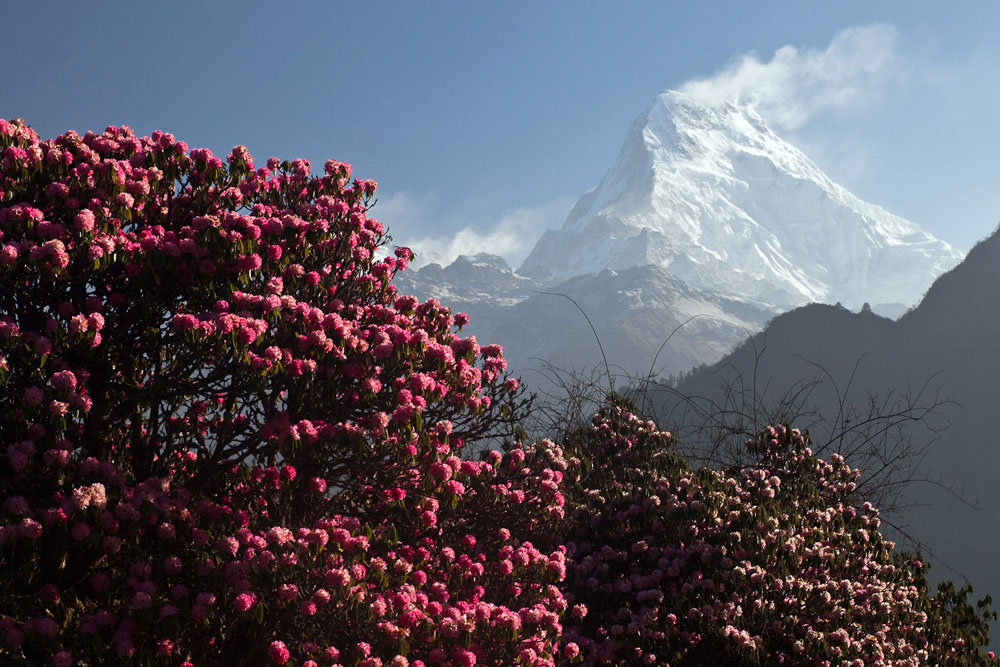
NATTs (Natural Annapurna Trekking Trails)
With the encroachment of roads up the Annapurna Circuit, we have heard references for years about trekkers making their own way in certain sections. This appears to have formalized with waymarked routes called Natural Annapurna Trekking Trails (NATT). According to the British Mountaineering Council , “They cover the traditional circuit of the Annapurnas massif, from Besisahar to the hot springs of Tatopani, and a plethora of diversions and additional options, to the likes of 4900-metre Tilicho Lake and Dhaulagiri’s incredible icefall.”
We have not yet had the opportunity to hike the Annapurna Circuit since the new NATT system was established, but there is a handy online guide that outlines the process. From our research, trekkers returning from the Annapurna Circuit using NATTs have been happy with the results and they have given new life to the route. Of course, this kind of trekking requires due diligence, attention to maps, and great care in making sure you follow the route and stay safe.
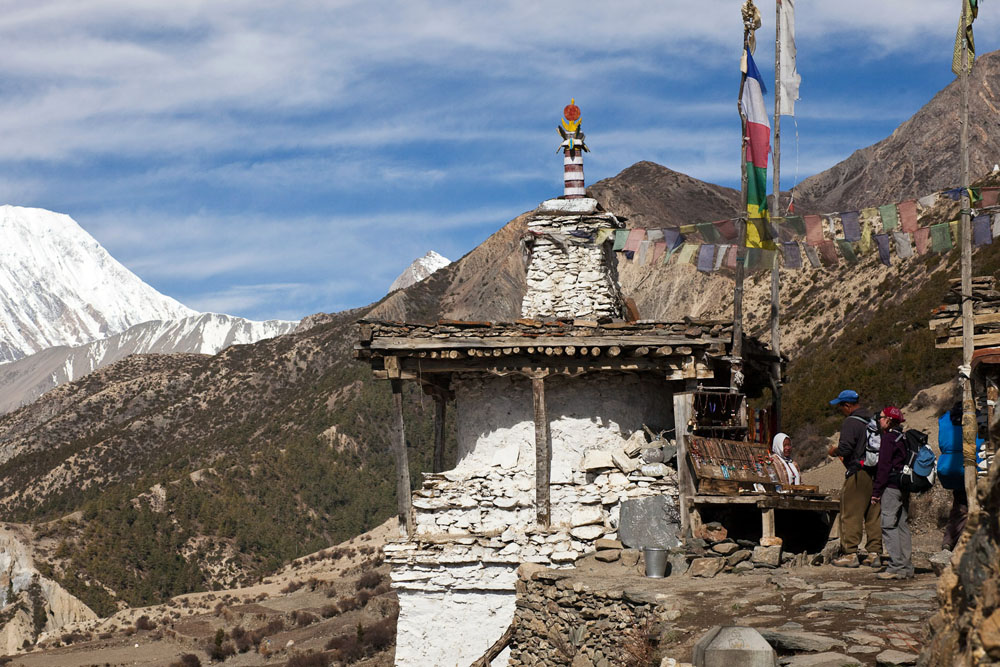
The Annapurna Circuit after the 2015 Earthquake
Fortunately, the Annapurna Trek was largely spared from serious damage during Nepal’s devastating 2015 earthquake. According to Reuters , less than 1 percent of the route and 3 percent of buildings were affected. Similar to the Everest Base Camp Trek, Miyamoto International, a California-based structural and earthquake engineering firm, was hired after the quake to provide risk assessment of the region (you can read the full July 2015 report here ). They concluded that damage was “very limited.” From all indications on the ground, the trek is open for business and operating normally. The nearby Manaslu Circuit Trek was not so lucky and saw much more extensive damage.
Learn More About Nepal
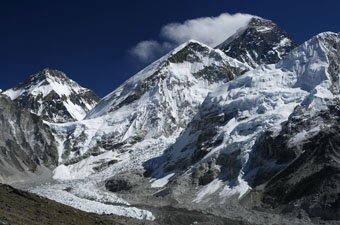
Everest Base Camp Trek
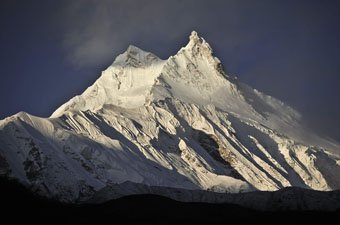
Manaslu Circuit Trek
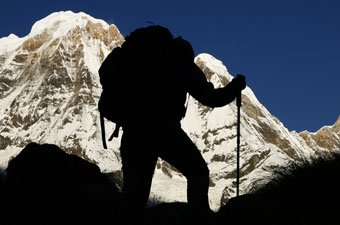
How to Prevent Altitude Sickness for Trekkers
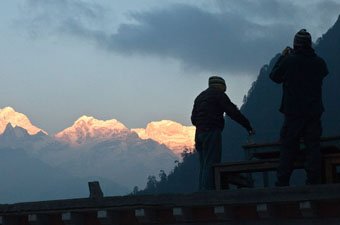
Trekking Seasons in Nepal
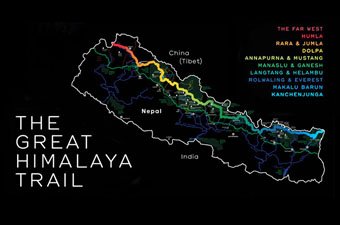
Great Himalaya Trail: One Trail to Rule Them All
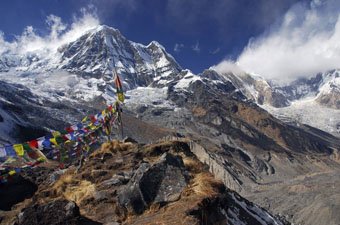
Annapurna Sanctuary Trek
Get geared up.
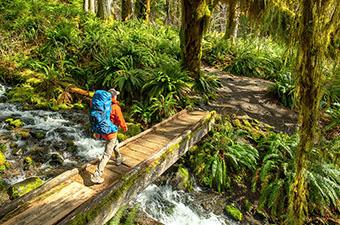
Best Backpacking Backpacks of 2024
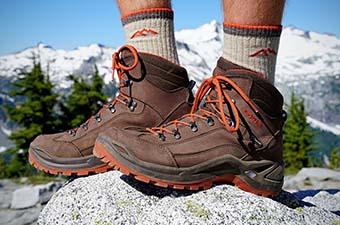
Best Hiking Boots of 2024
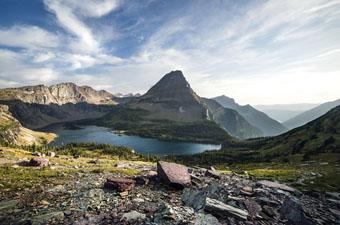
Best Cameras for Hiking and Backpacking
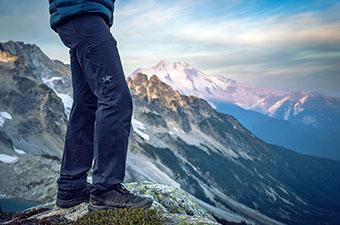
Best Hiking Pants of 2024
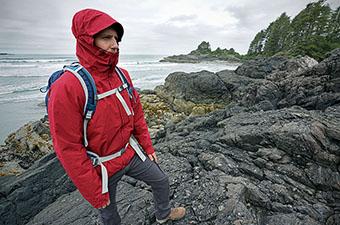
Best Rain Jackets of 2024
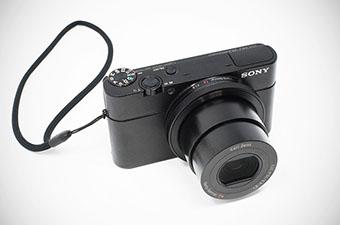
Best Point-and-Shoot Cameras of 2020

Mobile Menu
Megamenu - desktop hamburger menu.
- Hiking Gear
- Backpacking Gear
- Biking Gear
- Camping Gear
- Footwear Reviews
- Climbing Gear
- Skiing Gear
- Winter Gear Reviews
- In-Depth Gear Reviews
- Hiking Shoes
- Hiking Boots
- Trail Running Shoes
- Mountain Bike Shoes
- Approach Shoes
- Climbing Shoes
- Beginner Climbing Shoes
- Mountaineering Boots
- Winter Boots
- Rain Jackets
- Down Jackets
- Synthetic Jackets
- Fleece Jackets
- Hardshell Jackets
- Softshell Jackets
- Windbreaker Jackets
- Ski Jackets
- Winter Jackets
- Hiking Pants
- Hiking Socks
- Trekking Poles
- Baby Carriers
- Running Vests
- Backpacking Tents
- Backpacking Packs
- Backpacking Sleeping Bags
- Backpacking Sleeping Pads
- Backpacking Stoves
- Backpacking Food
- Water Filters
- Altimeter Watches
- Handheld GPS
- Mountain Bike Helmets
- Mountain Bikes
- Mountain Bikes Under $1,000
- Mountain Bikes Under $2,000
- Gravel Bikes
- Bike Brands
- Kids' Bikes
- Hitch Bike Racks
- Camping Tents
- Rooftop Tents
- Camping Sleeping Bags
- Camping Mattresses
- Camping Chairs
- Camping Stoves
- Duffel Bags
- Rock Climbing Shoes
- Climbing Helmets
- Climbing Harnesses
- Climbing Quickdraws
- Belay Devices
- Climbing Ropes
- Climbing Backpacks
- Winter Gloves
- 4-Season Tents
- Ski Helmets
- Ski Goggles
- Ski Backpacks
- All-Mountain Skis
- Ski Bindings
- Backcountry Skis
- Backcountry Ski Boots
- Skis for Beginners
- Hardpack Skis
- Mirrorless Cameras
- Full-Frame Cameras
- DSLR Cameras
- Point-and-Shoot Cameras
- Travel Cameras
- DSLR Lenses
- Mirrorless Lenses
- Lofoten Islands
- Lofoten Hiking
- Hardangervidda
- Jotunheimen
- 10 Great Norway Hikes
- Public Huts
- Torres del Paine
- Chalten and Glaciares
- Lake District
- Patagonia National Park
- Milford Sound
- Abel Tasman
- Marlborough
- Great Walks
- Adventure Towns
Add adventure to your inbox
- Privacy Policy
- Terms of Use
© 2024 Switchback Travel. All Rights Reserved. No part of this site may be reproduced without our written permission.
- How long is the Annapurna Circuit Trek
- Annapurna Trek Guide
- Jan 31, 2020
- Index Adventure
The Annapurna circuit trek is one of the most loved treks in the world. Trekking the natural landscapes of the pristine Annapurna region is every avid trekker's fantasy. The trails of the scenic trek passes through the stunning landscapes of the region and provides incredible views of the majestic Himalayas.
Annapurna Circuit trek is famous for the geographical diversity that ranges from lush green forests to barren, desert-like landscapes. The cultural exploration of the Tibetan Buddhist influenced settlements of the Gurung, Thakali, and Magar community is the prime attraction of the trek.
But how long is the Annapurna Circuit Trek? You might wonder. The length of the Annapurna Circuit trek depends upon the use of transportation and the starting point of the trek. Moreover, the Annapurna Circuit Trek has a total length between 160-230 Kilometres and takes around 14 to 18 days to complete.
For beginners, the Annapurna Circuit Trek is an excellent introduction to the natural landscapes of the Annapurna region. For avid trekkers, the trek is an exceptional trekking experience. Overall, the Annapurna circuit trek is an adventure of a lifetime for all. Read further to know how long is the Annapurna circuit and other important details regarding the trek.
Related Trips:
- Annapurna Circuit Trek
- Tilicho Lake with Annapurna Circuit Trek
We have Annapurna Circuit Trek package which will cost you less. For price contact us .
Annapurna Circuit Trek Route and Total Distance
Table of contents.
The total length of the Annapurna Circuit Trek ranges between 160-230 Kilometres and the trek route takes around 14 to 18 days to finish. Annapurna Circuit trek starts with a drive from Kathmandu to Besisahar. From Besisahar, we continue our ascend to Manang, passing through the settlements of Syange, Chame, and Pisang.
The trails pass through the Marshyangdi valley and the meadows of Yak Kharka to finally arrive at the majestic Thorung La Pass. The Thorung La Pass is the highest point of the trek situated at an altitude of 5,416m. From Thorung-La pass, we arrive at the settlements of Mustang in the upper Kali Gandaki Valley.
We also pay our pilgrimage to the sacred temple of Muktinath. Muktinath temple is highly revered by both Buddhists and Hindus community. The temple features holy 108 showers and according to popular beliefs, bathing in them cleanses the sins committed in the mortal life.
We then pass through the settlements of Marpha and Tatopani to arrive at the viewpoint of Poonhill. From the Poonhill viewpoint, we observe the spectacular sunrise and then drive back to Pokhara. Besides that, we are also blessed with majestic views of the entire Annapurna Massif from various points of the trek.
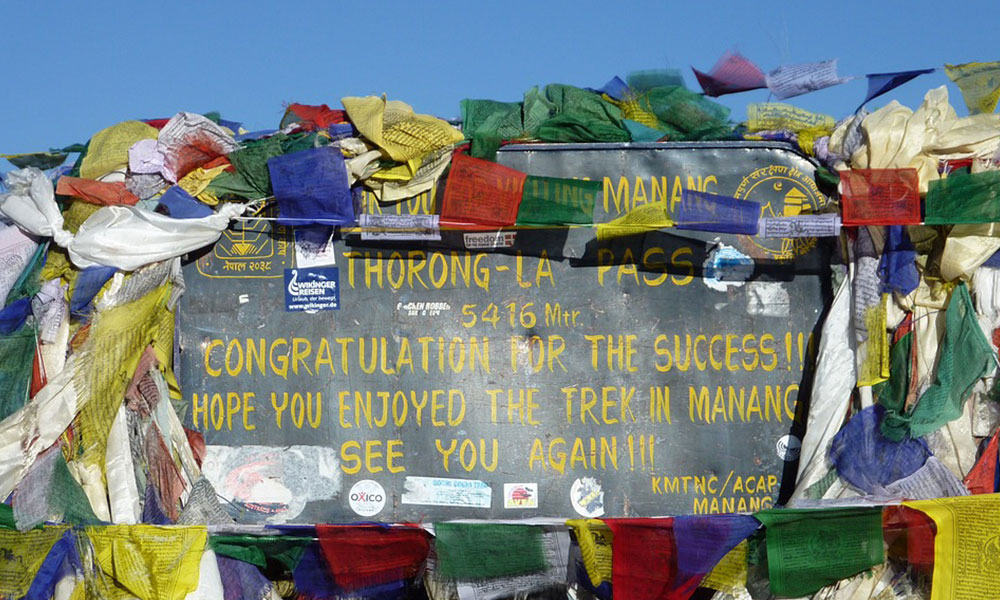
Annapurna Circuit Trek Itinerary and Distances
Kathmandu - besisahar.
Maximum altitude: 760m
Total distance: 184 km
Drive duration: 6-7 hours
Besisahar is the starting point of the Annapurna Circuit trek. A 6-7 hour scenic drive from Kathmandu will take you to Besisahar. The journey passes along the banks of Trishuli river, and provides you with the incredible views of the hilly landscapes, terrace farms, and snow-capped mountains.
The road then separates from the junction in Mugling. We cover the total distance of 184 km along the journey from Kathmandu to Besisahar. It takes around 6-7 hours on a winding hilly road to arrive at our destination.
Besisahar - Syange - Chame
Maximum altitude: 2,650m
Total distance: 65 km
Drive duration: 4 hours drive
We start our drive early in the morning from Besisahar to Chame via Syange. The jeep ride passes through the winding roads along the highway. Moreover, the off-road experience on the rough and rugged road is quite an adventure.
Furthermore, the 4 hours drive covers a total distance of 65 km. The awe-inspiring views of the mountains from Chame including Annapurna II, Mount Lamjung, and Mount Machhapuchhre, will enchant you.
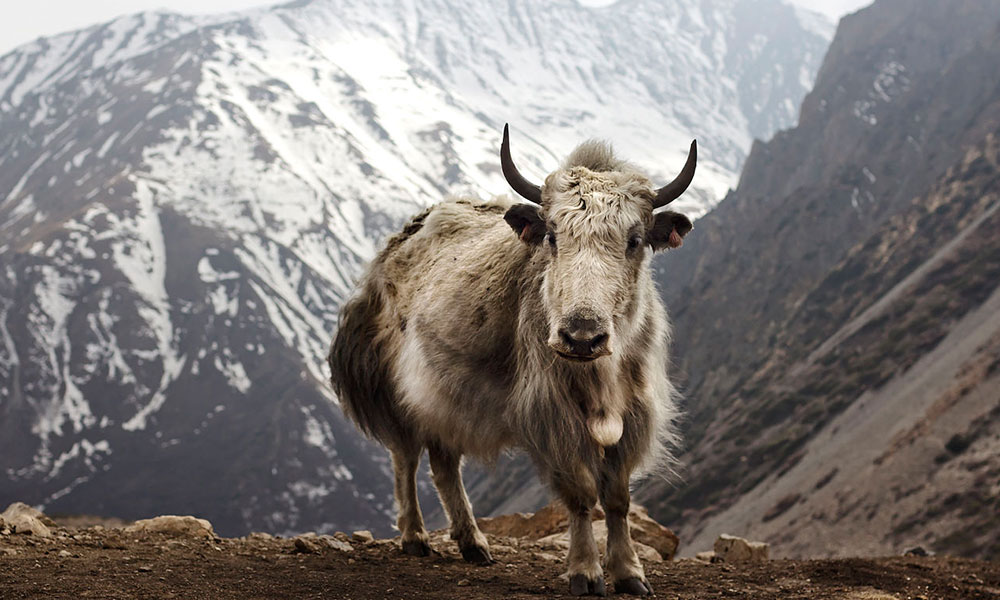
Chame - Pisang
Maximum altitude: 3,250m
Total distance: 13 km
Trek duration : 5-6 hours
The 13 km trek from Chame to Pisang takes around 5-6 hours to complete. The trek is mostly uphill and passes through the lush green forests until we arrive at the settlement of Pisang. Moreover, the trails pass through the settlements of Bhratang and Dhukur Pokhari.
The path is simple for the first two hours and then gets challenging. Overall, the total distance covered is 13 km, with a maximum elevation of 3250m, which can be quite hard for first-time trekkers.
Pisang - Manang
Maximum altitude: 3,540m
Total distance: 16 km
Time duration: 6-7 hours
The trek from Pisang to the famous village of Manang is 16 km long and takes around 6-7 hours to complete. As the trek moves above 3,000m in altitude with the maximum elevation of 3,540m, there is a high chance of altitude sickness among trekkers.
It takes around 4-5 hours to reach Ngawal and further 2-3 hours to arrive at Manang via Manang airstrip and Braga monastery. The vegetation is scarce in Manang, and the whole landscapes will remind you of a desert. Manang is also an excellent acclimatization spot for trekkers as you have lots of exploration points in Manang.
Manang - Yak Kharka
Maximum altitude: 4,018m
Total distance: 10 km
Time duration: 5-6 hours
The Manang to Yak Kharka trek is around 10 km long and takes 5-6 hours to complete. The high altitude trek is relatively easy, with some steep climbs in between. You will get the incredible views of the snow-capped mountains as we achieve the maximum elevation of 4,018m.
Yak Kharka - Thorong Phedi - High Camp
Maximum altitude: 4,540m
Total distance: 6km
Time duration: 4-5 hours
This section of the trek is one of the most challenging during the entire trek. The 6 km trek takes around 4-5 hours to complete and passes through the harsh terrains and steep ascents to arrive at Thorung Phedi. Moreover, the incredible views of the snow-capped mountains from the Thorung Phedi is breathtaking.
Thorong Phedi - Thorung La Pass - Muktinath
Maximum altitude: 5,430m (Thorung-La Pass) & 3,800m (Muktinath)
Total distance: 12 km
The trek from Thorong Phedi to Muktinath via Thorong La Pass is the most challenging section of the entire Annapurna circuit. The high altitude trek crosses the famous Thorung La Pass at an altitude of 5,430m.
After crossing the steep trail, shaky incline, we finally reach Thorung-La Pass that takes around 4-5 hours before we descend to the holy shrine of Muktinath. It takes a couple of hours more to arrive at Muktinath from the pass. The 12 km distance of the trek requires a great deal of stamina and determination to complete.
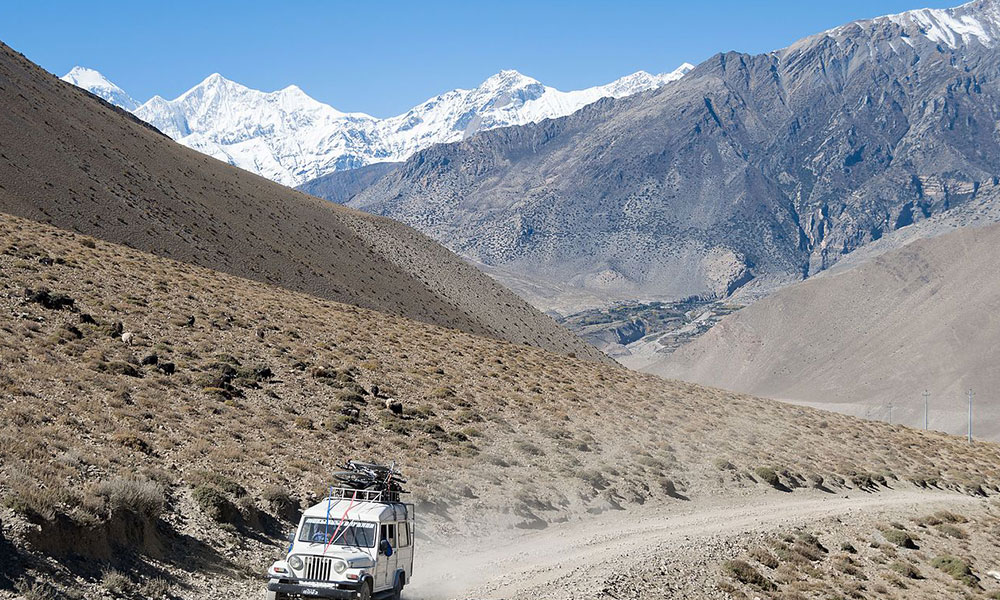
Muktinath - Marpha
Total distance: 22 km
Time duration: 8-10 hours
Muktinath to Mapha is the longest trek of our journey with a total distance of 22 km. Marpha is a scenic settlement ahead of Jomsom. The descending trail might be long but is quite enjoyable as we head from Muktinath to Kagbeni.
Furthermore, the trail then moves to Jomsom, passing along the banks of Kaligandaki river. The time duration to arrive at Jomsom is just 2-3 hours. From Jomsom, Marpha is another 1-2 hours away.
Marpha - Ghasa
Maximum altitude: 2,010m
Time duration: 6-8 hours
The trek from Marpha to Ghasa is 22 km long and takes around 6-8 hours to complete. Then, the descending trail passes through the banks of the Kali Gandaki river. We also pass through various suspension bridges to arrive at the settlement of Ghasa. This is another long duration trek covering a total distance of 22 km.
Ghasa - Tatopani
Maximum altitude: 1,190m
The trek distance from Ghasa to Tatopani is 13 km, and it takes around 4-5 hours to complete the trek. The trails pass through the forested area, overlooking the spectacular Annapurna massif.
Furthermore, the trails pass through the natural landscapes, terraced paddy fields, and Rupsi waterfall to arrive at the natural hot water springs of Tatopani. Dipping in the hot waters of Tatopani will relax your mind, muscles, and nerves.
Tatopani - Ghorepani
Maximum altitude: 2,874m
Total distance: 14 km
The total distance from Tatopani to Ghorepani is about 14 km and takes around 6-7 hours to complete. Ghorepani village is famous for its awe-inspiring views of sunrise and Annapurna mountain range.
There are several suspension bridges over the Kali Gandaki river. The uphill climb is steep for a few hours and then gets relatively easy. After 6-7 hours of trekking, we arrive at Ghorepani.
Ghorepani - Poon Hill - Pokhara
Maximum altitude: 3,210m
Total distance: 3 km & 35 km(drive)
Poon Hill viewpoint provides trekkers with an incredible fantastic panoramic sunrise view overlooking the entire Annapurna range. The uphill climb has a total distance of 3 km and takes around 1-2 hours to complete.
The trail leads us back to Ghorepani from where we drive back to the lake city of Pokhara. The scenic drive to Pokhara takes further 5-6 hours. Pokhara is a tourist city with many hotels, restaurants, cafes, pubs, etc.
Pokhara - Kathmandu
Maximum altitude: 1,400m
Total distance: 200 km
Time duration: 6-7 hours drive
Annapurna Circuit trek ends with a drive back to Kathmandu to Pokhara. The 6-7 hours drive covers around a distance of 200 km. The scenery provides you with green landscapes and the view of the snow-capped mountains.
You may also like to read:
- Annapurna Circuit Trek Cost
- Annapurna Circuit Vs Annapurna Base Camp Trek
- Annapurna Circuit Trek in September
Tips to Minimize the Distance Related Difficulties of the Annapurna Circuit Trek
Customize the trek.
The transportation used and the starting point of the trek also determines how long is the Annapurna Circuit. The Annapurna Circuit Trek starts with a drive from Kathmandu to Besi Sahar. You can customize the trek and take the jeep drive directly to Syange or Chame and reduce the trek itinerary by a few days.
There are some individual sections of the trek where you can take a jeep ride. These newly constructed roads are not in great condition but you can manage. So, taking a jeep or any vehicle available will reduce the total trekking days.
Moreover, you will also get to observe the beautiful scenarios of the hilly landscapes, terrace farms, charming villages, and magnificent mountain views, and others. Besides that, you can also take the flight from Jomsom to Pokhara. This will reduce the total distance and itinerary of the trek as your trip comes to an end at Jomsom.
Hire a Porter
Hiring a porter reduces the difficulty of the trek by a significant amount. It is incredibly hard to trek with heavy weight on your back. The porter can carry the weight of your clothing and gear.
So, if you are trekking in the high altitude region for the first time or are not comfortable trekking with a backpack, you should hire a porter. You can thus enjoy the trek and complete it with ease.
Trek in a Group
Trekking in a group will keep your mind occupied through fun interactions. Hence, you won’t feel the taxing length of the trail. Trekking along with friends, guides, and porters, will not only reduce the fatigue of the trek but will also make it exciting and memorable.
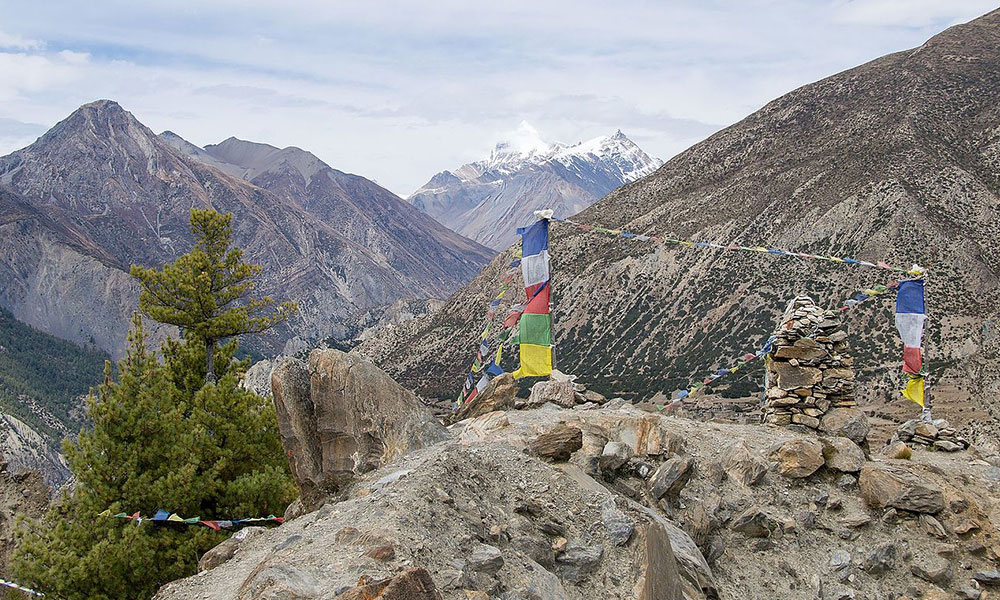
Comfortable Trekking shoes
The Annapurna Circuit trek is a long duration trek on the harsh terrain of the Annapurna region. Therefore, you will require a great pair of comfortable trekking shoes to trek in the region.
A pair of comfortable hiking shoes with sturdy soles will give you the extra push you need for the trek. It will also save you from any injuries, blisters, ankle pain, and others.
Get a Training Routine
The Annapurna circuit trek is a long duration trek through the most remote parts of Nepal. The trails are harsh and require immense strength and stamina to complete. Thus, a good training routine before the trek will help you immensely.
Moreover, the training should include cardiovascular activities like hiking, cycling, running, swimming, and others. These aerobic exercises will increase your stamina and boost your endurance. These training routines will also help you with altitude sickness.
Is Distance a Major Factor for Annapurna Circuit Trek Difficulty?
The Annapurna Circuit Trek is challenging, and the distance plays a significant role in determining the difficulty poolevel of the trek. The Thorong La pass is the highest point of the trek. There are several uphill and downhill climbs, along with steep and narrow ridges.
The altitude, weather, duration, and temperature are some of the factors that make the trek challenging. Besides that, the distance is another major factor that determines the difficulty of the Annapurna circuit trek. Longer distance means that the treks are longer and thus increase in the overall difficulty of the trek.
For the Annapurna Circuit Trek , you will have to walk 6-7 hours. Therefore the trekking distance and trekking duration are interdependent on each other. Beginner trekkers might find it challenging to trek continuously for long distances. Hence, trekking distance is a significant factor in the difficulty of the trek.
The Final Say
Annapurna Circuit Trek is one of the beautiful trekking destinations of the world. The diverse landscapes, lush forests and the majestic snow-capped mountains will make you fall in love with the place. The length of the trip is an important factor to consider before starting on any trekking adventure.
I hope this article answered the pertinent question of how long is the Annapurna circuit. You can customize the trek to either shorten or lengthen the trip. Overall, the Annapurna Circuit Trek is an ultimate trekking adventure in the pristine landscapes of the Annapurna region.
Send an Inquiry
Recent post.
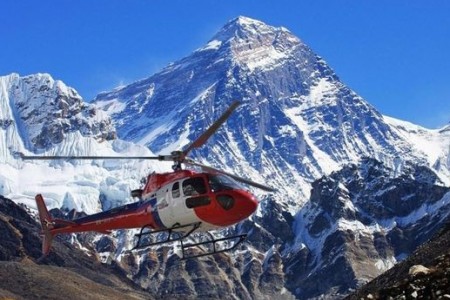
Why to choose EBC helicopter tour?
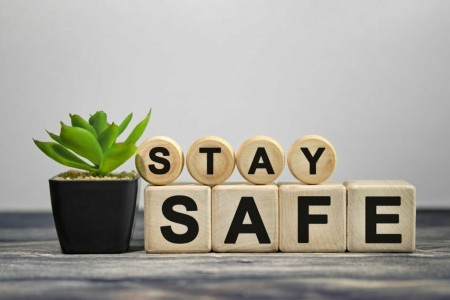
Safety tips for helicopter tour
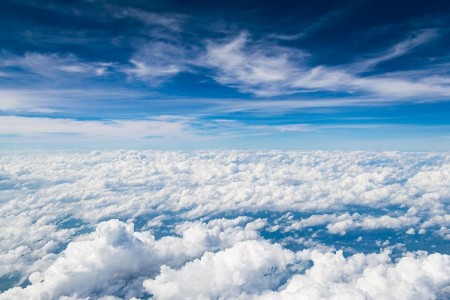
Flying to the top of the mount Everest
Related posts.
- Annapurna Circuit Trek Altitude Sickness Guide
- Annapurna Circuit Trek Weather and Temperature
- How to prepare for Annapurna Circuit Trek
- Annapurna Circuit Trek 15 Days
- Ghorepani Poon Hill Trek Weather
- Poon Hill Trek Cost
- Annapurna Helicopter Tour Cost - A Complete Guide
- Annapurna Base camp Trek 6 Days
- Adventure Activities
- Bhutan Tour Guide
- Everest Trek Guide
- Kanchenjunga Trek Guide
- Langtang Guide
- Manaslu Trek Guide
- Mardi Himal Trek
- Mustang Guide
- Peak Climbing
- Uncategorized
- Visit Nepal Year 2020
You May Also Like
Index Adventure Pvt. Ltd.
- Weekend +91 87 6262 3333
- Himalayan +91 9886 444 809
- International +91 84968 85968
- [email protected]
- One Day Treks
- Two Day Treks
- Himalayan Treks
- International Treks
- Private Treks
- Group Adventures
![Annapurna Circuit Trek [Premium] - Tour Annapurna Circuit Trek [Premium] - Tour](https://vl-prod-static.b-cdn.net/system/images/000/354/854/04b2d51a684a3a581028eca4b4f31f15/x600gt/Annapurna_Circuit_Trek.png?1615973657)
- Annapurna Circuit Trek [Premium]
- Secure & Easy Booking
- Best Price Guaranteed
- 1000+ Happy Customers
Annapurna Circuit Trek (ACT) is one of the classic trails in Nepal scenery and cultural diversity. Annapurna circuit trek length is approximately 100-mile plus. It is circumnavigation of the Annapurna Range offering the best natural scenery and indigenous cultures of Nepal. The trail takes you along the Marsyangdi Valley up to the North of the main Himalayan range. The trail then crosses a 5,416 m pass to descend into the dramatic desert-like, Tibetan-style scenery of the upper Kali Gandaki Valley.
Diversity in the Terrain:
The route of ACT brings varying sights, from about 100 waterfalls to pine forests. This lush landscape changes to arid slopes with shrubs, scattered here and there, just as you reach Manang. Now, Manang is an interesting place. Cliffs on one side of the Marsyangdi River are forested, while on the other, these are almost barren. From Manang, the terrain becomes a bit rough as you are required to make a somewhat steep ascent across grasslands and past juniper trees. You could utilize your acclimatization day in Manang with a trek to a glacial lake nearby.
Trek to Muktinath
This trek also gives you the opportunity to trek to the sacred Muktinath Temple. Located in the Muktinath Valley at the foot of the Thorong La mountain pass in Mustang, Nepal. It is one of the world's highest temples (altitude 3,800 m). The Muktinath temple is also considered to be one of the 108 Shakti Peetha.
Annapurna Range in full glory
The Annapurna Circuit trail is home to the Gurungs, Manangis, and Thakalis. It also offers spectacular mountain views of the numerous 7,000 m-plus Annapurna peaks and boasts some of the best trekking lodges in Nepal.
16-Days of Himalayan Bliss
During this incredible Annapurna circuit trek tour that lasts for 16-days, you traverse through isolated hamlets, mountain villages, lakes, Rhododendron forests, and beautiful stupas. The highest Annapurna circuit trek altitude is of 5,416 m (17,769 ft) at Thorung La pass. This challenging trek also introduces you to some of the most isolated monasteries of Nepal, temples, and breathtaking landscapes.
- Get far from the bustling city life into peaceful and pristine nature
- Witness stunning views of Annapurna, Lamjung Kailash, Dhaulagiri, Nilgiri and more
- Stay in teahouses of small villages
- Cross Thorong La Pass (5,416 m)
- Visit Muktinath, other holy temples, and monasteries
- Explore beautiful villages of Braga, Manang, Kagbeni, Jomsom, and Marpha
- Gaze at the breathtaking Annapurna range from Poon Hill
- Natural Hot spring at Tatopani
- Enjoy sightseeing in Pokhara
- Paragliding in Pokhara
Short Itinerary:
- Day 01: Arrive in Kathmandu and stay at a hotel
- Day 02: Drive to Besi Sahar (760 m) by van and stay at a lodge
- Day 03: Drive to Chame by 4WD jeep (2,670 m) and stay at a lodge
- Day 04: Trek to Pisang (3,190 m) and stay at a lodge
- Day 05: Trek to Manang (3,540 m) and stay at a lodge
- Day 06: Acclimatization day in Manang, continue staying in the lodge
- Day 07: Trek to Letdar (4,250 m) and stay at a lodge
- Day 08: Trek to Thorung Phedi (4,420 m), and stay at a lodge
- Day 09: Trek to Muktinath (3,800 m) via Thorong-La pass (5,416 m) and stay at a lodge
- Day 10: Drive to Tatopani (1,200 m) & visit natural hot spring water. Stay at a lodge
- Day 11: Trek to Ghorepani (2,850 m) and stay at a lodge
- Day 12: Early Morning Hike to Poon Hill and Trek down to Ulleri and drive to Pokhara by Jeep. Stay at a hotel
- Day 13: Exploration day in Pokhara visit Santi stupa and international mountain museum, paragliding etc. Stay at hotel
- Day 14: Fly back to Kathmandu from Pokhara. Stay at hotel.
- Day 15: Final Departure transfer to TIA airport 3 hours before your flight schedule
Detailed Itinerary:
Day 01: Arrive in Kathmandu
Annapurna circuit trek length is approximately 100+ miles and takes around 16 days to complete the trek. Arrive at the Tribhuwan International Airport & check in to the hotel. The rest of the afternoon is free until the evening when you'll enjoy a welcome drink with your guide and introduce each other. Overnight in Kathmandu.
Day 02: Drive to Besi Saha r / Chamje
Attitude: 760 m (2,493 ft) / 2,140 m (7,021 ft)
Travel Distance / Duration: 184 kms / 7 hours
We drive along the Kathmandu-Pokhara Highway to Dumre and then following the rough route by the Marsyangdi River, we pass through the low-lying villages and rice fields. If the annapurna circuit trek map is followed correctly, it will take 6 hours. After 6 hours long drive, we finally reach Besi Sahar, which is the capital of Lamjung District. Based on the time we reach Besi Sahar, we can further travel to Chame and stay overnight.
Day 03: Drive to Chame
Attitude: 2,670 m (8,759 ft)
Travel Distance / Duration: 70 kms / 6-7 hours
From Bagarchap the trail climbs through forest to Dhanakyu (2290m), crosses several landslides and travels uphill through the forest to Lattemarang (2360m). The trail climbs and then descends to Thanchok and to Kotho (2590m), a meadow surrounded by huge pine and spruce trees. Walking about half an hour you will reach to Chame, the administrative headquarters of the Manang district. From here you have an excellent view of Lamjung Himal, Annapurna II, and Annapurna IV on the annapurna trek. Overnight stay at Chame.
Day 04: Trek to Pisang (3190m)
Attitude: 3,190 m (10,465 ft)
Trek Distance / Duration: 13 kms / 6-7 hours
From Chame, you will reach Bhratang after walking through the pine forest and huge apple orchard which is surrounded by a stone wall. The Annapurna trek offers admirable views of Annapurna II, Pisang Peak, Mt.Himalchuli and Ngadi Chuli and reaches to Pisang, part of Manang Valley. Overnight stay at Pisang.
Day 05: Trek to Manang
Attitude: 3,540 m (11,614 ft)
Trek Distance / Duration: 17 kms / 8 hours
The trail makes a long climb with excellent views of the Manang valley and Tilicho peak (7,134 m), before reaching to the Manang airstrip at Humde (3,280 m). Crossing to the north bank of Marshyangdi on a bridge the trail reaches Mungji (3,360 m) and then climbs to Bryaga (3,550 m), a Tibetan-style village. Finally, after leaving Bryaga, you will reach Manang. Overnight stay at Manang.
Day 06: Acclimatization day in Manang
Trek Distance / Duration: 5-6 kms / 3-4 hours
After having breakfast you will climb the ridge to the north of the village for excellent views of Annapurna IV, Annapurna II and Tarke Kang (7,193 m). If you descend from the village, you will see the glacial lake at the base of the huge icefall that drops from Gangapurna (7,454 m). Back to Manang. Overnight stay at Manang
Day 07: Trek to Letdar (4250m)
Attitude: 4,250 m (13,943 ft)
Trek Distance / Duration: 12 kms / 5-6 hours
From Manang, the trail crosses a stream, climbs to Tengi, and then continues to climb out of the Marshyangdi valley before reaching the small village of Gunsang (3,930 m). The trail passes through a sparse forest of juniper, rose, and barberry and crosses a large stream to reach Yak Kharka (4,090 m). Walking about an hour further you will reach Letdar. Overnight stay at Letdar. If you wish to get access to a comprehensive Annapurna circuit trek guide, reach out to us today!
Day 08: Trek to Thorung Phedi
Attitude: 4,420 m (14,501 ft)
Trek Distance / Duration: 7 kms / 6-7 hours
From Letdar the trail continues to climb along the east bank of the Jar sang Khola then descends and crosses the stream on a bridge. Then making a short descent you will reach Thorung Phedi. Overnight stay at Throung Phedi.
Day 09: Trek to Muktinath
Attitude: 3,800 m (12,467 ft)
Trek Distance / Duration: 16 kms / 10-12 hours
From Thorung Phedi, the trail becomes steep; following rocky ridges you will reach Thorung La (5,416 m), which is the highest point of this trek. From here the views are outstanding. The trail descends steeply and during the decent there you can see sights of Mt.Dhaulagiri. You will reach Chabarbu (4,290 m). The trail crosses a meadow and leads to Muktinath where you can visit on the temple of Lord Vishnu, sacred to both Hindus and Buddhists. Overnight at Muktinath.
Day 10: Drive to Tatopani (1200 m)
Attitude: 1,200 m (3,937 ft)
Travel Distance / Duration: 85 kms / 5-6 hours
From Muktinath, the trail descends to Jharkot and ends at Khingar. Beyond Khingar you will meet the junction of two routes. The first one goes to Kagbeni (the entrance of upper Mustang) and another is to Jomsom. Then the trail proceeds to Eklebatti following the Kali Gandaki River. You will finally reach Jomsom where you can see the Annapurna Conservation Project check post, hospital, airport, and army camp. Then you drive down to Tatopani via Ghasa and Lele. The trail has ups and downs but most of the time we drive through a bumpy road through the riverside during the dry season. By the time you reach Tatopani, the Kaligandaki River has become a wide and wild stream. Tatopani has hot springs where you enjoy a bath after the exhausting days of the trip . Overnight stay at lodge. Annapurna circuit trek best time is considered to be from April to June.
Day 11: Trek to Ghorepani (2850 m)
Attitude: 2,850 m (9,350 ft)
Trek Distance / Duration: 17 kms / 7-8 hours
The trail follows through beautiful enchanting forests of rhododendrons, oaks, and pines with constant views of the Annapurna & Dhaulagiri mountain range. From Tatopani, you climb up to Ghorepani through wonderful misty forests. Literally, ‘Ghora’ means horse and ‘Pani’ means water, which translates to ‘a place where horses are stopped for rest’. You take an overnight stay at Ghorepani and enjoy the magnificent view of the mountains - Dhaulagiri, Annapurna, Nilgiri, Machhapurchhare and Tukuche peak.
Day 12: Early Morning Hike to Poon Hill Trek to Nayapul via Birethanti and drive back to Pokhara
Attitude: 1,040 m (3,412 ft)
Trek Distance / Duration: 20 kms / 7-8 hours
After an overnight stay in Ghandruk village, we trek down all the way to Nayapul via Birethanti. Nayapul is the ending point of the Annapurna Circuit Trek, and we drive back to Pokhara. Stay overnight at a hotel.
Day 13: Pokhara Sightseeing
Exploration day in Pokhara visit Santi stupa and international mountain museum, paragliding etc
Day 14: Fly back to Kathmandu
After breakfast, we fly back to Kathmandu from Pokhara. Drop to the hotel in Kathmandu. Leisure day at your convenience to explore the city.
Day 15: Departure
Final Departure transfer to TIA airport
Fitness Criteria:
This trek requires a good level of fitness.
To register for this trek you are required to complete any of the below-mentioned fitness criteria.
5K run in 35 minutes or Cycling 10kms in 40 mins or Swimming 1 km in 40 mins or Stair climbing 50 floors (10 floors up and down 5 times) in 30 mins.
Once you do register, please share the proof of fitness criteria with your Trek Captain anytime 30 days before departure.
If you're not already following a fitness regime, you would need to follow the regime that will be shared with you. The training routine is spread over four months and you would be expected to work out at least 4 times a week. The regime is designed to help you climb smarter even in higher altitudes. The regime consists of a good combination of exercises that works on all parts of your body including - Upper Body, Core, Endurance, Lower Body, Shoulder strength and improving your breathing pattern. When followed religiously, you can be assured that you will be ready for the trek. Not only does this regime help you with the trek, but it will also help you inculcate a sense of fitness in your day-to-day life.
Trekkers who have already trekked in the same route or have trekked at a similar altitude (highest altitude of this trek) or even higher, automatically get qualified. However, they would have to get both the Medical Certificate and Indemnity Bond singed as a mandate.
Trekkers who do not qualify the fitness criteria or fail to share the fitness criteria proof have to get both the Medical Certificate and Indemnity Bond singed with the same mentioned in the documents respectively.
Trekkers will not be allowed to join the group if the duly filled, signed and sealed copies of the Medical Certificate and Indemnity Bond are not shared.
Trek Insurance:
Trekking in the Himalayas comes with its own set of risks. While adventure is fun and can be extremely thrilling, nature can be unpredictable, and to help secure you during your trek, it is of utmost importance that you are covered with insurance.
We've gone a step ahead and made sure that you don't have to worry about scouting for the best insurance option out there. When you trek with us, your insurance comes as a part of your inclusions.
Risk and Liability:
We will endeavor to make your program smooth and as pleasant as possible. However, the entire course of trekking depends on the ranges of the mighty mountains, physical health, and environmental conditions. Therefore, TrekNomads shall not be responsible for any changes in the itineraries due to unavoidable circumstances and natural disasters such as landslide, road blockage, flood, snowing, cancellation of flight and delay, any type of sickness including altitude sickness.
What is included in the tour
- Arrival and departure transfer to the international and domestic airport in a private vehicle
- Pokhara to Kathmandu domestic airfares
- Land transportation Kathmandu - Beshisahar in a Jeep or TT or Bus
- Beshisaher to Chame travel via local 4WD jeep
- 02 Nights accommodation at Kathmandu at deluxe category hotel with breakfast on twin sharing basis
- 02 Nights accommodation at Pokhara at deluxe category hotel with breakfast on twin sharing basis
- 10 Nights accommodation in TeaHouses/Lodges during the trek on twin sharing basis
- Muktinath to Tatopani travel via local 4WD jeep
- Pick up from Ulleri / Nayapul and drive to Pokhara
- Annapurna Conservation Area Permit fee
- TIMS (Trekkers’ Information Management System) Fee
- Pokhara sightseeing in a van and with a guide
- Three meals in a day along with three times tea or coffee during the trekking period (open menu to choose any one item per meal from the menu)
- Three times tea or coffee in a day during the trekking period
- 2 litres of mineral water or hot water
- 10 days trekking with an experienced, English-speaking and government-licensed trek guide and assistant trek guide
- 1 porter for every 2 persons’ luggage (max 10-12 kgs per head allowed)
- Insurance, meals, transportation daily salary of guide & porter
- 3 litres oxygen cylinder with mask regulator for emergency
- All government, local taxes and service charges
- TrekNomads Fee, Trek Captain support and expertise
- 10% discount on Fast&Up products
- 25% discount on BMore products
- Personalized Dri-Fit T-shirt
- Expedition Grade Duffle Bag
- TrekNomads goodies
What is NOT included in the tour
- International airfare
- Nepal Visa fee
- Lunch and dinner at Kathmandu and Pokhara
- Any personal expense
- Personal Adventure Insurance
- Excess baggage charge(s), if it exceeds 15kg
- Insurance Fee
- Any type of soft drinks
- Boiled hot water, shower, etc, during the trek
- Extra meals apart from inclusions
- Tips to porters and guides (calculated per person at 10$ per day per person)
- Any other activity such as Bungee Jumping/River Rafting
- Helicopter fares
- Extra days at the hotel in Kathmandu apart from the schedule
- Any other expenses incurred apart from inclusions
- All personal, medical, evacuation and emergency expenses like extra day stay out of itinerary, helicopter services and vehicle charges due to delays, landslides, evacuation
- Expenses incurred for guide or porter during extra days stay, transport, flight, helicopter service, etc (divided amongst the group which utilises the services of guides/porters on extra days)
Altitude Map:
- Kathmandu: 1,400 m (4,593 ft)
- Besi Sahar: 760 m (2,493 ft)
- Chame: 2,670 m (8,759 ft)
- Pisang: 3,190 m (10,465 ft)
- Manang: 3,540 m (11,614 ft)
- Letdar: 4,250 m (13,943 ft)
- Thorung Phedi: 4,420 m (14,501 ft)
- Muktinath: 3,800 m (12,467 ft)
- Kalopani: 2,530 m (8,300 ft)
- Tatopani: 1,200 m (3,937 ft)
- Ghorepani: 2,850 m (9,350 ft)
- Thorung La: 5,416 m (17,769 ft)
Other Details:
- Trek Gradient: Difficult
- Trek Distance: 100+ Km
- Assembling Point: Kathmandu
- Trek Duration: 60 + hours
- Average Temperature: 20°C to -10°C
- Best Months to trek: April, May, October, November
Annapurna Circuit Trek FAQs
How long is the annapurna circuit trek.
Annapurna Circuit Trek is one of the most sought-after treks in Nepal that offers beautiful scenery and cultural diversity. ACT is a 108+ Km circumnavigation of the Annapurna Range offering the best natural scenery. With us, you will be completing the trek in 16 days. You also get to experience the indigenous cultures of Nepal. The trek starts from Pisang and ends in Ghorepani, followed by Pokhara sightseeing. We also do a sunrise trek to Poon Hill towards the end of the trek.
When is the best time to go for an Annapurna circuit trek?
Autumn (September to November) and summer (April to June) are the best seasons for trekking in the Annapurna region. The skies will be clear, and you can enjoy spectacular views of the Annapurna and Dhaulagiri peaks. Even though it is no longer the monsoon season, the lower regions (jungle) will be much warmer and more humid, and you may encounter an unexpected shower or two. It will also be much cooler above 3,500 m (11,482 ft). Even though it is not technically winter, you will need warm clothing along with you.
Check out our blog here .
Is the Annapurna Circuit trek difficult?
The Annapurna Circuit trek (ACT) is moderately difficult. It doesn't involve any technical climbing, but having some trekking experience would make the trek easier for you. The trail goes through various terrains, and the roads keep changing. You may encounter muddy roads after rainfall, rock steps, snow, steep ascents and descents full of loose rocks, and heavy water crossings on the trail in the most unexpected places. The higher you climb, the more difficult the trek will become due to altitude, so you must rest when necessary and remember to acclimatize properly. The only difficult part of the trek is the day we cross Thorung La pass as we will be starting the trek early in the morning and reaching by late evening. So easily it will be a good 10-12 hours of trek day.
Is there a risk of getting altitude sickness on the Annapurna circuit trek?
You will be trekking above 3,000 m (9,842 ft), so there is a risk because the oxygen levels will be low at high altitudes. The maximum altitude you will reach would be at Thorung La pass (5,416 m). Different people react differently to altitude regardless of their fitness level or mountaineering experience. That is why you should first learn about altitude sickness and its symptoms. You can speak to your doctor before embarking on the journey.
Some of the symptoms you can experience when you have AMS are:
Disturbed sleep
Loss of appetite/nausea
Shortness of breath
Swelling on the hands and face
What is the accommodation like on the Annapurna Circuit trek?
While on the Annapurna Circuit trek, you will stay in teahouses or guesthouses based on the package you choose. These guest houses/lodges are basic but well-maintained and come with a mix of both private and shared washrooms. Blankets/Quilts will be provided. There are no heating systems inside the guest houses, however, the common dining areas will have heaters in place. Some places may charge a fee for hot water showers, so take advantage of them while you can because, after Manang, you won't be able to shower until you reach Muktinath on the other side of the pass.
Where does the Annapurna circuit trek start, and where does it end? What is Annapurna circuit trek length?
The original route starts in Besisahar and ends in Nayapul. Even though this is the longest option, it allows you to acclimatize properly and enjoy plenty of different landscapes and climate zones. That's why the ACT is considered one of the world's most beautiful treks. With us the Annapurna circuit trek length is about 17 days.
At Treknomads, we start the Annapurna circuit trek by driving to Chame in a jeep. Next, we trek to Pisang, followed by an acclimatization day at Manang. We then proceed towards Thorung Phedi, Thorong La Pass (5,416 m), Muktinath, and jeep drive to Tatopani. Next, we trek down to Ulleri from Ghorepani/Poon Hill and drive to Pokhara by Jeep.
Should I hire a guide/porter on the Annapurna Circuit Trek?
The ACT can be completed without the assistance of a guide or porter, but you should be aware of your options. If you are entirely new to trekking or are travelling alone, having a guide may be beneficial. Porters can make the trek easy for you by carrying your luggage. If you have a medical condition like back problems, bad knees, etc., you should strongly consider hiring a porter.
As part of the TrekNomads package, we will provide a guide and porter to the group.
Is there Wi-Fi on the Annapurna circuit trek?
Internet/Mobile network/Satellite Wifi is available throughout the route up to Manang and then available again from Muktinath. Most guest houses will provide Wi-Fi for a fee. However, since you will be in the mountains, the wi-fi network will be intermittent. In any case, taking a break from the internet can be surprisingly beneficial!
Where is the Annapurna Circuit trail located?
The trail is located in Nepal's central region i.e in the major regions of Manang and Mustang. The Thorong La Pass, at 5,416 m (17,769 ft), is the highest point on this trek.
Are there ATMs on the trail of Annapurna Circuit Trek?
No, there are no ATMs on the trail. You must withdraw enough cash from Pokhara or Kathmandu before commencing the trek. You have to carry Nepali currency with you during the trek. Generally, cash may be required for personal expenditures, tips, medicines or evacuations. It is better to carry around Nepali Rs 16,000 (US$ 125) for any emergencies. Please make sure that you take proper care of your cash, personal belongings and valuables during the trek.
How long do we trek every day when doing Annapurna Circuit Trek?
On average, you have to walk around 6-8 hours daily. On some days, your walking hours can be as low as 4-6 hours a day as well. However, there would be days (especially while crossing Thorung La pass), you may be required to walk for up to 10-12 hours. The time taken is entirely dependent on many factors like walking distance, speed, injuries, weather conditions and such.
How fit do I need to be to do the Annapurna Circuit trek?
Annapurna Circuit Trek is a moderately difficult trek. Any healthy individual with good fitness can do this trek, and also you need to have prior trekking experience. You have to be mentally prepared to go on this trek. The most difficult part of this trek is when you will cross Thorong Phedi and Thorong La Pass.
What is the highest altitude reached in this Annapurna Circuit trek?
The highest altitude reached on the Annapurna circuit trek is 5,416m/17,769ft. This is the elevation of Thorong La Pass.
What about battery charging and hot shower facilities?
You can bring your charger and charge your batteries en route. There is a hot water facility but, you may have to pay an extra $1-$2. However, you can find hot water facility for free at a lower altitude.
What if I am a solo traveler? Is there a supplemental for singles?
No problem. Many of our Nomads travel solo. It may also be an option to join a small group or another solo traveler, let us know if this interest you. Yes, there is a supplemental cost if you are traveling alone, please contact us to find out more.
What is the weather like in May?
The temperature during this season is 15°C as lowest and with a maximum of 25°C during sunny days, a minimum of -10°C in the morning and at night normally for areas above 4,000 meters.
Do you have a Annapurna Circuit Trek guide?
Yes, we do have Annapurna circuit trek guide. To access Annapurna Circuit Trek Resources, visit here .
Loading the map...
- RAZORPAY EMI PAYMENT METHOD
- TREKNICAL DETAILS

Recognitions

OTHER POPULAR TOURS
![Valley of Flowers Trek and Hemkund Sahib [Premium] - Tour Valley of Flowers Trek and Hemkund Sahib [Premium] - Tour](https://vl-prod-static.b-cdn.net/system/images/000/326/464/f004eeac1383bb5aea2b18eb9400c343/x400gt/VOF_Banner.png?1684915067)
Valley of Flowers Trek and Hemkund Sahib [Premium]
![Everest Base Camp Trek [Premium] - Tour Everest Base Camp Trek [Premium] - Tour](https://vl-prod-static.b-cdn.net/system/images/000/352/493/2f06596a5543585d0f67bc5c9eabe2dd/x400gt/Everest_Base_Camp.png?1684317973)
Everest Base Camp Trek [Premium]
![Kashmir Great Lakes Trek [Premium] - Tour Kashmir Great Lakes Trek [Premium] - Tour](https://vl-prod-static.b-cdn.net/system/images/000/414/735/bed5a46f080cd0e89659ed19c0c6d7aa/x400gt/TrekNomads_Website_Banner__13_.png?1684931452)
Kashmir Great Lakes Trek [Premium]
OTHER ACTIVITIES

- Testimonials
- Customized Private Treks
- Corporate Outings
- Cancellation Policy
Online booking system by Vacation Labs | © 2024 TrekNomads

IMAGES
VIDEO
COMMENTS
Day 18: Trek from Tadapani (2,710 meters) to Naya Pul (1,070 meters) via Gandruk and then catch a short bus ride back to Pokhara. Please Note: From Muktinath onwards the classic Annapurna Circuit has been severely impacted by the road that joins Jomsom to Muktinath.
The Annapurna Circuit is a trek within the mountain ranges of central Nepal. The total length of the route varies between 160-230 km (100-145 mi), depending on where motor transportation is used and where the trek is ended. This trek crosses two different river valleys and encircles the Annapurna Massif. The path reaches its highest point at ...
The Annapurna Circuit Trek is undoubtedly one of the most extraordinary and unparalleled experiences a trekker can avail themselves of. With an extensive length of 160-230 km that covers four distinct districts, comprising Lamjung, Myagdi, Manang, and Mustang, this trekking route stands out as the most preferred circuit through the diverse natural vegetation, cultural beliefs, landscape ...
The Annapurna Circuit is a long-distance trekking route that circles the Annapurna mountains. Depending on what route you choose, it can take anywhere from 12-22 days, and span from 160km-230km. For example, you can detour to the Annapurna Sanctuary then rejoin the circuit, but it'll add days to your journey.
Annapurna Circuit trek in Nepal - a 2023 hiking guide. All you need to know for planning an independent trek in the Annapurna Region. ... I would compare the circuit to the Everest Base Camp trek itinerary. The length of the routes and the average altitude are about the same. The main challenges of the Annapurna Circuit are . High altitude;
The route length depends on where you start and end your trek so that it might be between 170 and 230 kilometers. You can accomplish it in as few as ten days or as many as 24 days if you go on a side trip. However, it usually takes 10 or 14 days to complete the shorter route and 18-21 days to complete the journey.
The Annapurna Circuit is a moderately difficult trek and is challenging for two main reasons. First, it's a relatively long trek. Most people cover up to 230km over 14-18 days or more. Second, it's a high altitude trek. There are a number of days spent at 3500m or higher, including a 5416m pass crossing.
From the Annapurna trek itinerary to packing guides, when to trek and fitness levels, trekking solo vs a group, plus responsible trekking tips, this is absolutely everything you need to know before you go! ... Trek length | Generally 16-20 days. Distance | this varies depending on route and whether you take optional side treks, but generally ...
Here is the basic outline of our Annapurna Circuit Trek Itinerary: Day 1: Bus from Pokhara to Besisahar - 5 hours. Besisahar to Bhulbhule - 9km/5.6 miles. Day 2: Bhulbhule to Jagat - 19km/11.8 miles. Day 3: Jagat to Dharapani - 17km/10.5 miles. Day 4: Dharapani to Chame - 17km/10.5 miles.
ANNAPURNA CIRCUIT TREK FACTS. Annapurna Circuit Trek is undoubtedly one of the most popular multi-day treks in the Himalayas. Before you start planning your trip, here are a few facts every traveler should know. The Annapurna Circuit's full length is 260 kilometers, but every itinerary is different depending on where you start and finish.
It's one of the world's classic long-distance hiking trails, and still one of Nepal's most popular treks. The Annapurna Circuit, a 12 to 21-day route that begins in the lush green villages of the Himalayan foothills. Taking trekkers over the 5,416m Thorong La Pass and down to the Tibetan-influenced temples and communities of the Mustang ...
Located in central Nepal, the Annapurna Circuit is a long-distance trekking route that begins in the town of Besisahar and ends in Birethanti, encircling much of the Annapurna Massif along the way. The trail's namesake mountain is amongst the tallest in the world, standing some 8091 meters (26,545 ft) in height.
The Annapurna Circuit is a trekking route in Nepal that circles the Annapurna Massif, located in the northwestern Himalayas of Nepal. The total length of the circuit is approximately 160-230 kilometers (99-143 mi), depending on where motor transportation is used and whether the side trip is included.
Trekking to Annapurna Circuit is not so expensive if you know how to manage your travel properly. It will cost you around 900-1400 USD per person to complete the whole Trek. These expenses include your accommodation, food, beverages, transport, and any additional expenses you make during your Trek. The above calculation is made based on 15 days ...
The Annapurna Circuit Trek has all the ingredients of a true classic Nepal trekking experience. In this blog we share our in-depth knowledge about this epic trek. ... In my experience, the Annapurna Circuit length also adds to the strenuous nature of the trek. The shortest version we offer involves 170 kilometers of trekking. On some days the ...
The total length covered by the Annapurna Circuit is somewhere between 225- 230 KM/100-145 miles). It depends where we are starting the trek; the length of the Annapurna Circuit will be shorter than this if we transfer to the Chame and start to trek from here, but as mentioned length above is based on the starting point from Besisahar.
The length of the Annapurna circuit route is between 160-230km. This length varies based on your choice of trek startpoint and endpoint and how much you use road transport. ... Annapurna Trek - 20 Days. Comparatively, this is a long Annapurna Circuit Trek, but it includes sightseeing in Kathmandu before the trek start. The trails start from ...
Annapurna Circuit Trek Facts. Length: 8-21 days (the grand loop from Besishar to Pokhara takes approximately 17-21 days). Difficulty: Moderate to challenging. Starting elevation: 760 meters (2,493 feet) at Besisahar up to 3,450 meters (11,319 feet) at Manang, depending on your starting point. Peak elevation: 5,416 meters (17,769 feet) at ...
The length of the Annapurna Circuit trek depends upon the use of transportation and the starting point of the trek. Moreover, the Annapurna Circuit Trek has a total length between 160-230 Kilometres and takes around 14 to 18 days to complete. For beginners, the Annapurna Circuit Trek is an excellent introduction to the natural landscapes of the ...
Overview. Annapurna Circuit Trek (ACT) is one of the classic trails in Nepal scenery and cultural diversity. Annapurna circuit trek length is approximately 100-mile plus. It is circumnavigation of the Annapurna Range offering the best natural scenery and indigenous cultures of Nepal. The trail takes you along the Marsyangdi Valley up to the ...
Depending on your trekking route and the mode of transportation, the Annapurna Circuit Trek distance varies accordingly. Thus, the total distance of the Annapurna Circuit trek ranges from 160 km to 260 KM. Some parts of the trekking trails have been turned into roads, resulting in short trekking distances in recent years.